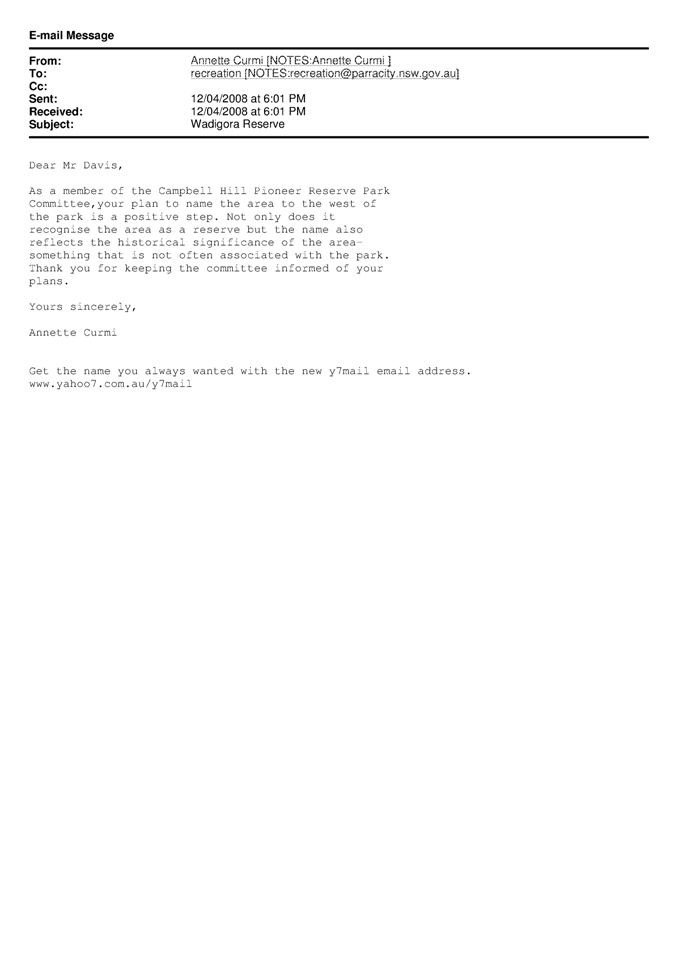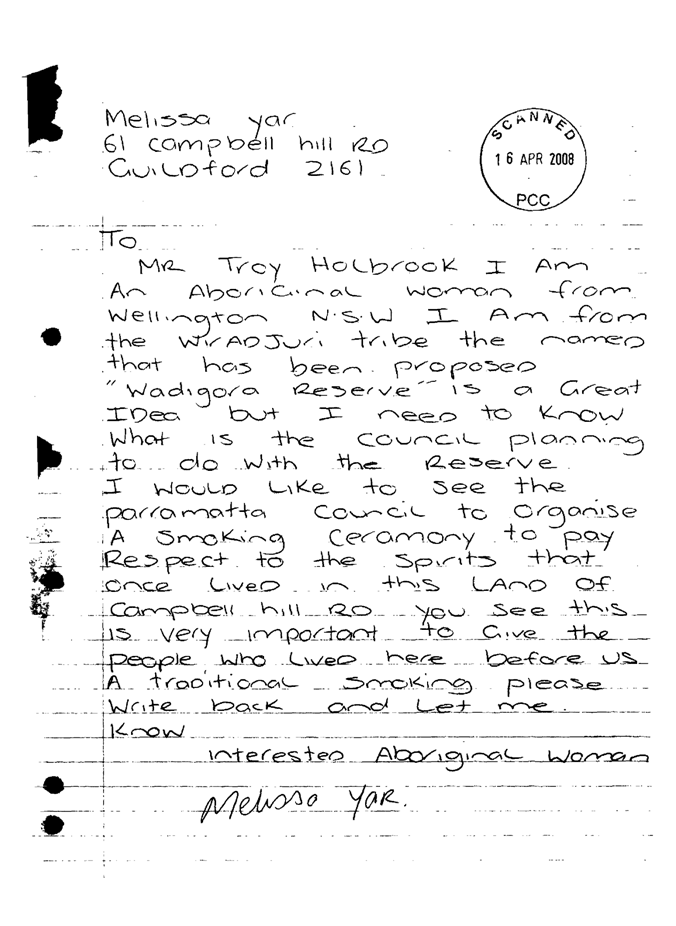
NOTICE OF Council MEETING
The Meeting of
Parramatta City Council will be held in the Council Chamber, Fourth Floor, 2
Civic Place, Parramatta on Monday, 26 May 2008 at 6:45 pm.
Sue Coleman
Acting General
Manager
Parramatta – the leading city at
the heart of Sydney
30 Darcy Street Parramatta NSW 2150
PO Box 32 Parramatta
Phone 02 9806 5050 Fax 02 9806 5917 DX 8279 Parramatta
ABN 49 907 174 773
www.parracity.nsw.gov.au
“Think Before You Print”
|
|
Clr Paul Barber, Lord Mayor – Caroline Chisholm Ward
|
Sue Coleman, Acting General Manager - Parramatta City Council
|
|
|
Sue Coleman – Group Manager City Services
|
|
|
Assistant Minutes Clerk – Michael Wearne
|
|
|
 Stephen Kerr –
Group Manager Corporate Stephen Kerr –
Group Manager Corporate
|
|
|
Minutes Clerk – Grant Davies
|
|
|
Marcelo Occhuizzi –Acting Group Manager Outcomes
& Development
|
|
|
|
|
|
|
|
|
|
|
|
Clr Omar Jamal – Arthur Philip Ward
|
|
|
Clr Lorraine Wearne - Lachlan Macquarie Ward
|
|
|
Clr Anita Brown – Elizabeth Macarthur Ward
|
|
|
Clr John Chedid – Elizabeth Macarthur Ward
|
|
|
Clr David Borger – Macarthur Ward Elizabeth
|
|
|
Clr Andrew Wilson – Lachlan Macquarie Ward
|
|
|
Clr Paul Garrard – Woodville Ward
|
|
|
Clr Tony Issa, OAM – Woodville Ward
|
|
|
Clr Julia Finn – Arthur Philip Ward
|
|
|
Clr Brian Prudames – Caroline Chisholm Ward
|
|
|
Clr Chris Worthington – Caroline Chisholm Ward
|
Clr Pierre Esber, Deputy Lord Mayor – Lachlan Macquarie Ward
|
Clr Maureen Walsh – Wooville Ward
|
Clr Chiang Lim
– Arthur Phillip Ward
|

|
GALLERY
|
Ordinary
Council
|
26 May 2008
|
|
|
|
TABLE OF
CONTENTS
1 CONFIRMATION OF MINUTES -
Ordinary Council
- 28 April 2008, Regulatory Council - 12 May 2008
2 APOLOGIES
3 DECLARATIONS
OF INTEREST
4 Minutes of Lord Mayor
5 PETITIONS
6 Rescission Motions
6.1 City
Services Restructure
7 COUNCIL MATTERS TO BE
ADOPTED WITHOUT DISCUSSION
8 Regulatory Reports
8.1 Footpath
Parking
8.2 Site
Meeting Process
9 City Development
9.1 St John's
Park Church Street Parramatta - Proposed Appointment Manager of Crown Reserve
9.2 Funding
of Heritage Assistance
9.3 Amendment
to Parramatta City Centre Local Environmental Plan (LEP) 2007 to correct a
misdescription
9.4 Nomination
of Councillors as Observers to the Project Management Team associated with the
Riverbank Block
9.5 2
Morton Street, Parramatta - Future Development Options
10 Environment
10.1 Parramatta River
Foreshore Plan Review 2008 - Public Exhibition
10.2 Parramatta
River Catchment Group
10.3 Fish
Ladder Interpretative Signage - Parramatta Park
11 Roads Paths Access and Flood Mitigation
11.1 Dedication
of land owned by Council as Public Road
11.2 Wharf
Road
Boat Ramp, Wharf Road, Ermington.
12 Culture and Leisure
12.1 International
Charter for Walking
12.2 Naming
of an Unnamed Public Reserve in Parramatta as Warrigal Wetland
12.3 Naming
of an Unnamed Public Reserve in Guildford as Wadigora
Reserve
13 Community Care
13.1 Parramatta Liquor Accord
13.2 Aboriginal
and Torres Strait Islander Advisory Committee
13.3 Arts
Advisory Committee Meeting 8 April 2008
13.4 Youth
Advisory Committee 9th April 2008
13.5 Access
Advisory Committee
14 City Leadership and Management
14.1 Regulation
& Enforcement of Brothels and Massage Parlours
14.2 Report
of Investigation into Compliance Section
14.3 Proposed
Suburb alignment between Winston Hills
and Northmead
14.4 Suburb
Boundary Alignment for 19 Pioneer Street Wentworthville/Pendle Hill
14.5 Prioritisation
of Councillor Workshops - July to September 2008
14.6 Program
Panels
14.7 Investments
Report for March 2008
14.8 2007/08
Management Plan - March 2008 Quarterly Review
14.9 Adoption
of the Draft Management Plan 2008/09 - 20011/12 for Public Exhibition
15 Notices of Motion
15.1 Food
and Beverage Purchased for Staff Functions and Meetings
15.2 Outdoor
Machinery and Fleet Vehicles
16 QUESTION TIME
17 DECISIONS FROM CLOSED SESSION
18 Closed Session
18.1 Tender
No.4/2008 Marion Street, Parramatta - Construction of Stormwater Drainage,
Reconstruction of Kerb & Gutter, Road Pavement and Associated Works.
This report is
confidential in accordance with section 10A (2) (d) of the Local Government act
1993 as the report contains commercial information of a confidential nature
that would, if disclosed (i) prejudice the commercial position of the person
who supplied it; or (ii) confer a commercial advantage on a competitor of the
Council; or (iii) reveal a trade secret.
18.2 21B Barangaroo Road Toongabbie - Proposed Disposal
This report is
confidential in accordance with section 10A (2) (d) of the Local Government act
1993 as the report contains commercial information of a confidential nature
that would, if disclosed (i) prejudice the commercial position of the person
who supplied it; or (ii) confer a commercial advantage on a competitor of the
Council; or (iii) reveal a trade secret.
18.3 Civic
Place Update May 2008
This report is
confidential in accordance with section 10A (2) (c) of the Local Government act
1993 as the report contains information that would, if disclosed, confer a
commercial advantage on a person with whom the Council is conducting (or proposes
to conduct) business.
|
Ordinary Council 26 May 2008
|
Item 6.1
|
ITEM NUMBER 6.1
SUBJECT City
Services Restructure
REFERENCE F2007/00732 - D00932546
REPORT OF Acting General Manager
|
To be moved by
Councillor J Chedid and seconded by Councillors A A Wilson and A Issa, OAM:-
|
|
RECOMMENDATION
“That the resolution of the Ordinary Council
Meeting held on 28 April 2008 regarding the City
Services Restructure, namely:-
That Council receive and note the report
of the Acting General Manager on implementation of the restructure of the
City Services Group.
be and is hereby rescinded.”
|
Attachments:
|
1View
|
Previous Report from the Council Meeting on 24 April 2008 regarding the City Services Restructure
|
3 Pages
|
|
|
Attachment 1
|
Previous Report from the Council Meeting on 24 April 2008 regarding the City Services Restructure
|
CITY LEADERSHIP AND MANAGEMENT
ITEM NUMBER 10.8
SUBJECT City
Services Restructure
REFERENCE F2007/00732 - D00917898
REPORT OF Acting General Manager
|
PURPOSE:
This report
provides Council with an update on implementation of the restructure of the
City Services Group.
|
|
RECOMMENDATION
That
Council receive and note the report of the Acting General Manager on
implementation of the restructure of the City Services Group.
|
BACKGROUND
1. In
consideration of a Notice of Motion by Councillor Worthington, Council resolved
at its meeting of 25
March 2008 to seek a further report on
implementation of the City Services Restructure.
2. On 23 July 2007, Council approved in
principle the restructuring of the City Services Group from seven to five
service units. Council determined that
further detailed consultation would be undertaken with staff prior to the final
proposed structure being presented for Council approval and implementation by
December 2007. At the same time, Council
approved in principle the transfer of Regulatory functions and Traffic and
Transport Services from City Services to the Outcomes and Development
Group.
3. On 29 October 2007, Council received a further report
advising of progress on the City Services restructure. All Level 3 Managers had been appointed and
in-depth staff consultation undertaken in each area to determine the best
possible structure for the Group to Level 5 management. Council approved the proposed structure
including the establishment of up to 5 new staff positions to be deployed in
outdoor front line services. Council further resolved that
the savings currently being utilised to support the Outcomes and Development
Review would support the appointment of two additional Tree Chipping team
members upon completion of this review in June 2008.
4. Following
these decisions of Council, the final structure of the Group was communicated
to staff and further consultation undertaken in the preparation of detailed
positions descriptions. The job
evaluation process was undertaken with the support of the Workplace Reform Committee
and the Joint Consultative Committee.
5. In December 2007, changes were made
to Council’s internal financial reporting to ensure that the relevant cost
areas supported the new structure. This
enabled the December Quarterly Review to be prepared in the new structure and
supported comparative analysis in the draft 2008/09 Budget which was commenced
at the same time.
6. On
25 February 2008, an
update on the City Services restructure was provided as part of the report to
Council on the December Quarterly Review.
Savings had been determined once the grading was completed for all new
or changed positions and Council was advised that these savings would be utilised to increase outdoor
front line services with 2 additional Grass Cutting team members and 1
additional Parks Infrastructure Maintenance team member. These positions have since been advertised
and are expected to be filled by the end of this month.
ISSUES/OPTIONS/CONSEQUENCES
7. The report to Council on 29 October 2007, confirmed that
since teams were aligned with the new service units, the majority of City
Services staff would experience no impact to their existing roles and
accountabilities other than changes to reporting lines once the Level 4 and 5
positions were filled.
8. By the end of 2007, many of the
changed positions had been drafted, graded, approved by Consultative Committee
and filled, and as outlined above, the budget had been recast to support the
new structure. Implementation of the City
Services restructure has continued, however, well beyond the December 2007
timeframe.
9. To date, thirty-four people have been
appointed to changed positions through the City Services restructure including
three which required external advertising.
A further six positions are currently advertised including four that
have now been promoted externally as they were unsuccessful in attracting
appropriate internal candidates.
10. With so many internal appointments, some
follow-on recruitment is inevitable and has since been completed or remains
underway for various vacated positions.
11. Where possible, sequencing of recruitment
has been arranged to enable newly appointed supervisory staff to participate in
the recruitment of their direct reports.
Sequencing has also been considered in some areas to enable the outcome
of selection for popular positions to be determined before staff are asked to
consider accepting less favoured positions.
12. A
number of staff matters have arisen throughout the implementation period which
have required careful consideration and prolonged the process. Council approved, for example, the
establishment of a graffiti removal service utilising existing resources within
the City Operations team, subject to approval from Workplace Reform and Joint
Consultative Committees. Consultation
with the two staff affected has been lengthy and it is envisaged that this
matter will now be considered by Workplace Reform Committee later this month.
CONSULTATION & TIMING
13. Since
Council adopted the City Services restructure in October 2007, detailed
consultation has been undertaken with affected staff, for example, in the
development of position descriptions.
14. The job
evaluation process has been completed with the support of the Workplace Reform
Committee and the Joint Consultative Committee has also received updates on
implementation of the City Services restructure to each subsequent meeting
including the most recent held on 8
April 2008.
15. It is
envisaged that consultation in regard to implementation of the City Services restructure,
including reports to Consultative Committee, will continue until it is
finalized with the expansion of the Tree Chipping service in July 2008.
Sue Coleman
Acting General Manager
17 April 2008
Attachments:
There are no
attachments for this report.
REFERENCE MATERIAL
|
Ordinary Council 26 May 2008
|
Item 8.1
|
ITEM NUMBER 8.1
SUBJECT Footpath
Parking
REFERENCE F2004/07072 - D00937247
REPORT OF Change Manager Regulatory Services
PREVIOUS ITEMS 12.2 - Footpath
Parking in the Parramatta LGA - Ordinary
Council - 17 December 2007
|
PURPOSE:
The purpose of
this report is to clarify Council’s approach to footpath parking.
|
|
RECOMMENDATION
That
Council write to residents in streets where the nature strip has been widened
reminding them that it is illegal to park on footpaths and nature strips.
|
BACKGROUND
1. At the meeting on
17 December 2007 Council
considered a report on footpath parking. Council had received a petition from
residents and Councillors reported complaints in regards to infringement
notices received by residents for illegally parking on footpaths / nature
strips.
The adopted
recommendations were:
(a) That Council write to the RTA as a matter of urgency and
seek approval for the erection of permissive parking signs or other methods for
areas where existing hard surface bays are located adjacent to roll-top kerbs,
and that any associated works be funded from the Urgent Ward Work Funds.
Action: (Response from RTA received on 13
March 2008).
(b) That the matter be referred to the Parramatta Local Traffic
Committee for their comment.
Action: (Response tabled at the Committee
meeting on 14 April 2008)
(c) That Council write to the RTA seeking advice on the use of
signage and footpath parking trials that are being carried out in other Local
Government Areas.
Action: (Refer to RTA letter – attached - signage
not required)
(d) That Council write to residents in areas where footpath
parking may occur due to the roll-back kerbs reminding them of the requirements
of the parking legislation.
Action: (Draft letter attached, can now be
distributed as Council has received a formal response from the RTA)
(e) That Council officers review the ‘Standard
Operating Procedures’ for Ranger
Services staff.
Action: (This item is explained in Point
10 below).
2. At the Council meeting held
on 28th April 2008 Councillors also
reported complaints from residents resulting from an illegal truck parking
operation conducted by Rangers Services staff on the evening of Saturday 26th April 2008. Infringement
notices were issued to illegally parked trucks and cars illegally parked on
footpaths / nature strips in streets in Granville,
Merrylands, Chester Hill and Guildford.
3. Generally the
complainants live in residential streets where the nature strip was widened by
Council in the mid 1990s – a minimum of 38 streets.
4. The report presented on 17 December 2007
tabled legal advice on the matter and provided details of practices at other
Councils. Subsequent to the Council meeting of 17 December 2007,
Council wrote to the Roads and Traffic Authority (RTA) requesting clarification
on the issue of footpath parking. A response letter from the RTA was received
on 15 March 2008, and
was tabled at the Parramatta Local Traffic Committee meeting held on 14th April 2008.
5. A
copy of this letter is attached to this report.
ISSUES/OPTIONS/CONSEQUENCES
6. It is clear that
parking on footpaths / nature strips was made illegal with the introduction of
the Australian Road Rules on 1 December 1999. The following
are listed as ‘penalty notice offences ‘ :
a. Stopping on a
path / nature trip in a built up area (rule 197/1)
b. Stopping on /
across a driveway / other access to / from land (rule 198/2
7. The new rules
came into operation after council constructed widened nature strips in some
streets.
8. Hard Surface / delineated parking bays
The letter from the RTA received by Council on 15 March 2008 states the following:
“The Roads and Traffic Authority (RTA) does not believe that existing
hard surface bays located adjacent to roll top kerb require any special
treatment.”
Council can infer that it is legal to park in hard surface bay areas
such as those in Crown Street Epping, Marion Street Harris Park and Railway
Parade Granville, and that signage is not required as the bays are clearly
delineated from the nature strip.
Rangers and
Parking Patrol Officers have been advised by management that Penalty
Infringement Notices are not to be issued to cars parked on hard surface bays
in the above mentioned streets. However, hard surface bays have not been
installed in the majority of streets with widened nature strips. Staff in City
Services have provided approximate estimates to:
· Restore these streets to
their original width, or
· Install hard surface
bays.
Restore the road to its original width
Costs
for this can be estimated using m2 rates. For example in Caroline
Street Granville there is 95 lineal metres of existing roll kerb extending the
footpath zone beyond the existing road carriageway alignment. The total
estimate of costs to reconstruct the kerb along the original alignment is $80
000.
Install hard surface bays
The m2 rate to replace soft surfaces with a variety of hard surfaces is
roughly as follows (estimates include site prelims, traffic control, sediment
control, and demolition):
Concrete $198/m2
Crushed Rock $225/m2
Permeable Pavement $223/m2
Asphalt on Concrete $207/m2
As an example, for Caroline Street Granville (approximately 247m2) the
following costs would apply:
Concrete $49
000
Crushed Rock $55
000
Permeable Pavement $55 000
Asphalt $51 000
Crushed Rock is an expensive system due to the concrete perimeter border
required.
One option is for Council to advise residents that with the approval of
Council and at their own expense, a hard surface bay may be constructed in the
nature strip in front of their property. A consequence of this would be that
the said parking would be on public land and therefore anyone could park their
vehicle in that space which may cause conflict between neighbours.
9. Issuing Warnings
Residents have suggested that Council officers should issue warnings to
the owners of vehicles parked illegally on footpaths. There is a strong
possibility that this will result in inconsistency and perceptions of unfair
application of the law, although it appears that some Councils (Ryde and
Holroyd) at times ask residents to move cars parked on footpaths / nature
strips in residential streets.
As far back at
February 2000 other Councils (Pittwater) have sought legal advice on this
matter, the advice received being that Council cannot instruct officers to use
discretion, further that while there appears to be an option for officers to
issue warnings this is limited as there is a risk of such behaviour being
viewed as unlawful, improper or even corrupt. As an example, Parramatta City
Council officers tasked on Saturday 26 April 10.00pm – 2.00am to investigate
illegal truck parking in residential streets also detected cars parking illegally
on footpaths. The officers on duty would need to consider why they would issue
a warning for one offence and not another, and how they might explain the
situation if one of the truck owners claimed that it was unfair for them to
receive and infringement notice when other illegally parked vehicles did not.
On the other
hand, Ryde Council does include in operating procedures an option for officers
to ask the owners of vehicles parked on footpaths to move their vehicles.
The
Ranger Services unit at Parramatta City Council does have ‘Standard Operating Procedures’. However, these procedures do not
currently refer to a warning system as a first step in the enforcement process
practice officers are not instructed to issue warnings to the owners of
vehicles illegally parked on footpaths / nature strips.
A
number of reasons not to issue warning emerged from discussions with management
and staff in the Ranger Services Unit:
· Inconsistent
practice with infringement notices issues without warning for other detected
offences,
· would be
difficult to monitor warnings and would take staff away from priority areas,
· officers may be
accused of favouritism,
· may give the
impression to residents that it is OK to park on the footpath / nature strip
when under the Australian Road Rules (1999) these are clearly penalty notice
offences.
A reminder letter
to all house households with widened nature strips would fill the purpose of
warning residents that is illegal to park on footpaths and nature strips (a
draft letter is attached to this report).
10. Local Orders Policy
Councillors
have previously asked whether a ‘Local Orders Policy’ or Operating Procedures
could be developed advising officers to issue ‘warnings’ to the owners of
vehicles illegally parked on footpaths / nature strips. The advice received from Council’s solicitors on 22 November
2007 conferred with the advice received by Pittwater Council that there is no
statutory basis for creating a local order in regards to footpath parking.
The Local Government Act, 1993
provides council enforcement staff with the regulatory tools to deal
with issues that have a detrimental impact on individuals or the community.
Section 159 allows for the preparation of draft local policy for orders;
Preparation of draft local policy for orders;
(1) A council may prepare a draft local orders policy.
(2) A draft local orders policy is to specify the criteria which (if the
policy were to be adopted) the council must take into consideration in
determining whether or not to give an order under section 124.
Sections 124
and 125 of the Act, give council authority to serve specific Orders, depending on the circumstances, and to whom they can be served.
Section 124 covers ‘Orders requiring or prohibiting the doing of things to or
on premises”. The orders listed deal primarily with environmental and health
issues. Section 125 refers to orders ‘To abate a public nuisance or order
a person to abate a public nuisance”. An order relating to the regulation of
parking on public land does not fit within the guidelines listed. A scan of
‘Local Orders Policies’ from other Councils has not revealed any reference to
footpath / nature strip parking.
The
enforcement of footpath parking in residential streets is not a high priority
for the Ranger Services unit. The majority of footpath and nature strip
offences are detected when officers are responding to other complaints raised
by Councillors and members of the community.
11. Implications for Council taking no action on
parking infringements which involved parking across driveway / on a footpath /
nature strip.
Advice from
Council’s solicitors dated 22 November indicated that, as parking on a footpath/
nature strip and across a driveway are penalty notice offences under the
Australian Road Rules (1999), there is no implication for Council in not informing residents about the Road
Rules, and that once an infringement is issued:
“the processes of law require the person
served either elect to have the matter come before the Court or to pay the
amount specified on the penalty notice”.
CONCLUDING
REMARKS
12. It is clear that
parking on footpaths / nature strips is an offence under Rule 197(1) of the
Australian Road Rules 1999. Sending a reminder to residents that this is the
case would clarify the issue on that point , but may not satisfy residents who
may have construed that parking on the nature strip was permissible in streets
where Council widened the nature strip. Given that most of the affected
residences have off-street parking and parking is also available on-street, it
would then not be necessary to pursue either returning the streets to their
original width or the installation of hard surface bays.
Kevin Brennan
Change Manager –
Regulatory Services
15 May 2008
Attachments:
|
1View
|
Streets with widened nature strips and roll kerbs
|
1 Page
|
|
|
2View
|
Draft letter to residents
|
1 Page
|
|
|
3View
|
Lette from the RTA regading footpath parking 13 March 08
|
1 Page
|
|
REFERENCE MATERIAL
|
Attachment 1
|
Streets with widened nature strips and roll kerbs
|
|
|
Street Name
|
Suburb
|
|
1.
|
Aubrey Street
|
Granville
|
|
2.
|
Badham Street
|
Granville
|
|
3.
|
Baker Street
|
Merrylands
|
|
4.
|
Brady Street
|
Merrylands
|
|
5.
|
Carhullen
Street
|
Merrylands
|
|
6.
|
Caroline
Street
|
Guildford
|
|
7.
|
Chamberlain
Street
|
Guildford
|
|
8.
|
Charles Street
|
Granville
|
|
9.
|
Cleone Street
|
Merrylands
|
|
10.
|
Earl Street
|
Granville
|
|
11.
|
Daniel Street
|
Granville
|
|
12.
|
Elizabeth
Street
|
Granville
|
|
13.
|
Garland Avenue
|
Epping
|
|
14.
|
Glenfern Road
|
Epping
|
|
15.
|
Crown Street
|
Epping
|
|
16.
|
Hewlett Street
|
Granville
|
|
17.
|
Grandview Parade
|
Epping
|
|
18.
|
Hillside
Crescent
|
Epping
|
|
19.
|
John Street
|
Granville
|
|
20.
|
Kimberly
Street
|
Merrylands
|
|
21.
|
Lansdowne
Street
|
Merrylands
|
|
22.
|
Linthorne
Street
|
Guildford
|
|
23.
|
Lewis Street
|
Epping
|
|
24.
|
Margret Street
|
Granville
|
|
25.
|
Melrose Street
|
Epping
|
|
26.
|
Milner Road
|
Guildford
|
|
27.
|
New York
Street
|
Granville
|
|
28.
|
Osgood Street
|
Merrylands
|
|
29.
|
Rosebery Road
|
Guildford
|
|
30.
|
Salisbury Road
|
Guildford
|
|
31.
|
Smith Street
|
Granville
|
|
32.
|
Station Street
|
Guildford
|
|
33.
|
Stuart Street
|
Granville
|
|
34.
|
Victoria
Street
|
Granville
|
|
35.
|
Walter Street
|
Granville
|
|
36.
|
Warrington
Avenue
|
Epping
|
|
37.
|
Wynyard Street
|
Granville
|
|
38.
|
Wyralla Street
|
Epping
|
|
|
|
|
|
|
|
|
|
|
|
|
Streets with Roll Kerb -
(Chicane Treatments)
|
Attachment 2
|
Draft letter to residents
|
Your Reference:
Our
Reference:
Contact: R Sutcliffe
Telephone: 9806 5361
Fax: 9806 5923
To the Resident
IMPORTANT NOTICE
PARKING on FOOTPATHS and NATURE STRIPS.
In December 1999 a new set of rules to govern Traffic Laws was
introduced across Australia. This legislation, the
Australian Road Rules 1999 was developed to provide consistency relating to
vehicle parking in each state and territory.
One of the new parking regulations introduced at this time was that it
is now an offence to stop or park a
vehicle on a nature strip or footpath. The
penalty amount for this offence is at present $79.00.
Authorised Officers of Council are responsible to administer the provisions of the
Australian Road Rules 1999 and any vehicle observed to be illegally parked may
result in a penalty notice to be issued.
To assist Council Officers in ensuring compliance with the current
regulations please do not park on nature strips or footpaths. Your assistance
in this matter is greatly appreciated.
Yours sincerely,
Rodney Sutcliffe
Service Manager, Ranger Services
|
Attachment 3
|
Lette from the RTA regading footpath parking 13
March 08
|

|
Ordinary Council 26 May 2008
|
Item 8.2
|
ITEM NUMBER 8.2
SUBJECT Site
Meeting Process
REFERENCE F2004/08629 - D00939449
REPORT OF Manager Development Services
PREVIOUS ITEMS 5.1 - Site Meeting
Process - Ordinary Council - 28 April 2008
|
PURPOSE:
To seek endorsement to amendments to the adopted site
meeting process and to provide additional information to assist Council in
consideration of the matter.
|
|
RECOMMENDATION
1. That site
meetings be held for the following types of applications:
· Development
applications where 7 or more submissions have been received.
· Masterplan
applications.
· Development applications which seek demolition of a
heritage item.
For applications that do not
meet the above criteria, site meetings can be arranged at the request of the
Ward Councillors and at the request of staff where it is considered that
there is merit in arranging a site meeting, the reasons of which must be
provided.
2. That a minimum of one Councillor be in
attendance to enable an on-site meeting to be held.
3. That all Councillors, relevant staff,
persons who made a submission (both objecting and support) and the applicant
be invited to attend the site meeting.
4. That the Development Support Team
Leader - Development Assessment Services schedule on-site meeting through the
corporate diary and attach a summary report of the proposal with each
invitation and that acceptance of attendance by Councillors be provided
within 3 working days. Residents and applicants will not be advised of the
site meeting until attendance at the site meeting is confirmed by at least 2
councillors.
5. That on-site meetings be arranged for
5pm on Tuesday or Thursday and
Saturday mornings.
6. That a strict protocol for the chairing of on-site meetings
be developed.
7. That Council’s notification letter
advises attendees of the purpose of the meeting and the level of behaviour
expected.
8. That all residents attending the
on-site meeting provide their details on the day and that this information be
recorded by Council
9. That Council staff provide a summary report of the
development proposal for
the on-site meeting and that a
map be supplied with each report which indicates both the number of residents
notified of the DA and the number of residents who made submissions (both
objections and supporters).
10. That a review of the revised operating
procedures for on-site meetings be carried out 6 months from commencement of
operation and a further report be prepared for Council’s consideration.
|
BACKGROUND
Council at its meeting of 28 April 2008 considered a report on site meeting
process and resolved:
‘That consideration of
this matter be deferred for 4 weeks pending the provisions of further
information on any matters raised via email by Councillors with staff within
the next 10 days together with the changes to the Manager Development Services’
recommendation as contained in the above motion.’
An email was sent on 1
May 2008 to all Councillors providing a reminder of the Council
resolution of 28 April 2008.
Councillors were requested to send any questions or issues that they wished to
have considered in the follow up report to the Manager Development Services by Friday 9 May 2008.
At the date of writing this report (15 May 2008) no further questions or comments
have been provided to staff by any Councillor.
REPORT
Whilst no questions or comments have been provided by
Councillors for inclusion in this report some commentary will be made on issues
raised by Councillors during the debate on 28 April 2008 and the proposed amendments as suggested
by Councillor Worthington:
Letter sent to
residents and applicants advising of site meeting
A copy of the standard letter which is currently sent to
residents and applicants inviting them to attend site meetings can be found in
Attachment 1. The letter clearly states:
· the
purpose of site meetings
· who
is invited to attend the site meeting
· the
time and date of the site meeting
It is proposed to retain this current standard letter, but
enhance the letter by outlining the standard of behaviour which is expected
from all persons attending site meetings.
Changes to the
‘trigger’ for on-site meetings
It has been suggested by some Councillors that the ‘trigger’
for holding on-site meetings should be amended to include:
· Development
applications where 8 or more submissions have been received
· Masterplan
applications
· Development
applications which seek demolition of a heritage item
· All
child care centres
· All
brothels and massage parlours
· Hotels
and licensed restaurants
The broadening of the ‘triggers’ which necessitate an
on-site meeting will result in an increase in the number of site meetings being
held. It is estimated that the number of additional on-site meetings which
would be required to be held will not be dissimilar to that which has occurred over
the past 6 months (i.e. 70 inspections in a 6 month period). As outlined in the
previous report to Council on this matter the issues which have been experienced
over the last 6 months due to the large number of inspections includes: timing,
budget, staffing and availability issues for Councillors. The further
broadening of applications to be referred to site meetings will not help to
address these existing issues.
There are widely differing views on the question ‘when is it appropriate to have a site
meeting?’ and there is no right answer. However, establishing ‘triggers’ based on
application types, rather than the ‘public interest’ in the application (which
is largely based on the number of submissions received from the community) is
not considered to be the most appropriate way for an application to ‘trigger’
an on site meeting as it does not show what ‘public interest’ there is in an
application.
For this reason, it is recommended that the ‘trigger’ for
the number of submissions received be reduced from the previously recommended
10 to 7, but that ‘triggers’ relating to land use types not be established as
it is not an accurate way in which to
establish ‘public interest’ in an application.
Number of Councillors
to be in attendance for site meetings to be held
It has been suggested that a minimum of 1 councillor be in
attendance to enable an on-site meeting to be held. This is supported and the
report recommendation has been amended.
Timing of Site
Inspections
The suggested change in starting time
for the Tuesday and Thursday evening site inspections to 5.00pm is supported and the report recommendation has
been amended.
Documentation
submitted with on-site summary report
It has been suggested that a map be supplied with each
on-site summary report which indicates both the number of properties which were
notified of the DA and the number of residents who have lodged submissions
(objectors and supporters).This is supported and the report recommendation has
been amended.
Louise Kerr
Manager Development Services
Attachments:
|
1View
|
Site Meeting Process - 28 April 2008 - Ordinary
Council Meeting
|
7 Pages
|
|
|
2View
|
Advise notified properties On-site Meeting Letter
|
2 Pages
|
|
|
Attachment 1
|
Site Meeting Process - 28 April 2008 - Ordinary Council Meeting
|
ITEM NUMBER 5.1
SUBJECT Site
Meeting Process
REFERENCE F2004/08629 - D00917709
REPORT OF Manager Development Services; Service Manager
Development Assessment
|
PURPOSE:
To provide Councillors within a 6 month review of the
implementation of the site meeting process that commenced in October 2007,
and to recommend some changes and enhancements to the existing process.
|
|
RECOMMENDATION
(a) That site meetings be held for the following types of
applications:
· Development applications where
10 or more submissions have been received.
· Masterplan applications.
· Development applications which
seek demolition of a heritage item.
For applications that do not meet the above criteria,
site meetings can be arranged at
the request of the Ward Councillors and at the request of staff where it is considered that there is
merit in arranging a site meeting, the reasons
of which must be provided.
(b) That a minimum of two Councillors be in attendance to enable
an on-site meeting to be held.
(c) That all Councillors, relevant staff, persons who made a
submission (both objecting and
support) and the applicant be invited to attend the site meeting.
(d) That the Development
Support Team Leader - Development Assessment Services schedule on-site
meeting through the corporate diary and attached a summary report of the
proposal with each invitation and that acceptance of attendance by
Councillors be provided within 3 working days. Residents and applicants will
not be advised of the site meeting until attendance at the site meeting is
confirmed by at least 2 Councillors.
(e) That on-site meetings be
arranged for 4.30pm on Tuesday or
Thursday and
Saturday mornings.
(f) That a strict protocol for the chairing of on-site meetings
be developed.
(g) That Council’s notification letter advises attendees of the
purpose of the meeting and the
level of behaviour expected.
(h) That all residents attending the on-site meeting provide their
details on the day and that this
information be recorded by Council
(i) That Council staff provide a summary report of the
development proposal for
the on-site meeting.
(j) That a review of the revised operating procedures for onsite
meetings be carried out 6 months
from commencement of operation and a further report be prepared for Council’s consideration.
|
BACKGROUND
Council at its meeting of 25 June 2007 considered a report
which sought to establish a formal site meeting process for development
applications and Masterplan applications.
At the meeting it was resolved that on-site meetings be held for certain
types of applications.
In addition to this Council
resolved that operational matters relating to site meetings (including what
stages should site meetings be held; who is to be invited to attend site
meetings; and what days and times site meetings are to be held) be prescribed
in an operating procedure manual.
The site meeting process as
adopted by Council on 25 June 2007
commenced operation in October 2007.
A Notice of Motion relating to
the on-site meeting process was put forward by Councillor Worthington at the
Council meeting of 25 March 2008.
The Notice of Motion proposed identified that the adopted on-site meeting
process could be improved.
A response to the Notice of
Motion was tabled at the Council meeting of 25 March 2008. The Notice of Motion was deferred to
enable staff to prepare a report for Council’s consideration on the
implementation of the site meeting process.
REPORT
The parliamentary nature of
Council meetings does not lend itself to objectors being heard at Council
meetings. For this reason Council has decided that in some cases site meetings
should be held prior to the determination of an application to provide
Councillors with an opportunity to listen to matters raised by both objectors
and applicants.
Council in June 2007 agreed to
the circumstances in which site meetings would be held and the time they should
be held. A review of the adopted process was to take place 12 months from the
date of commencement (ie October 2008), however it is considered appropriate
for a 6 month review to be conducted.
To date, this procedure has
highlighted the following areas of concern:
· an excessive number of meetings, many of which were for
development proposals that were of little if any interest to residents (as
evidenced by resident attendance) and raised no particular concern among
Councillors.
· the ‘triggers’ for on-site meetings being too broad and
this has lead to significant delays and complaints by applicants forced to wait
for the next available time.
· the current timetable for site meetings has caused
problems for Councillors and staff in terms of availability to attend.
· many of the on-site meetings have been compromised by
issues raised by residents that were not related to the development proposal.
· Councillors and staff have been verbally abused and
intimidated at on-site meetings.
· An inherent risk of undue pressures (perceived or
otherwise) being brought to bare on development assessment staff prior to their
assessment of the development proposal.
Large Number of Applications Requiring On-site Meetings
The following applications
currently require an on-site meeting:
· Development applications for Childcare Centres where one
or more submissions are received
· Section 82a reviews of determination
· Development applications which seek demolition of a
heritage item
· All development applications where five or more submissions
are received
· Masterplan applications
Since the commencement of the
on-site meeting process in October 2007 a total of 70 on site meetings have
been held using the above criteria including:
· 9 for s82a applications;
· 8 for Child Care Centre DAs;
· 3 for applications which sought to demolish heritage
items; and
· 50 for all other development applications.
It is obvious that the ‘triggers’
which necessitate an on-site meeting are broad and have resulted in a
significant number of meetings being held over the last 6 months. It is noted
that there is no discretion for Council not to hold a meeting once required in
accordance with the Council Resolution. Similarly, there is no discretion for
staff to recommend dispensing with an on-site meeting where it is apparent that
one is not required.
There are widely differing views
on the question ‘when is it appropriate to have a site meeting’ and there is no
right answer to the question. However, it is clear that the ‘triggers’ which
have been established are perhaps too broad and have resulted in timing,
budget, staffing and availability issues for Councillors.
Whilst setting a threshold for
the number of submissions that triggers a site meeting is not always a reliable
way of predicting which applications require a site meeting due to public
interest in the application, it is considered that the current threshold of 5
is too limited and that the number should increase to 10 or more. The trigger
for child care centres to have site meetings if only 1 submission is received
is also considered too broad, as is the requirement for all section 82A reviews
to have a site meeting.
It is noted that the number of
on-site meetings held in the last 6 months (70) is nearly double the number of
site inspections that were held in a 12 month period between April 2006 and
April 2007 (42).
Given the number of applications
requiring on-site meetings under the current criteria, significant delays have
occurred in scheduling an available meeting date. This has lead to extended
time frames for the determination of applications. Delays have often range from
4 to 8 weeks.
To address this issue the
following changes are recommended:
1. That site meetings be held for the following types of
applications:
· Development applications where 10 or more submissions
have been received.
· Masterplan applications.
· Development applications which
seek demolition of a heritage item.
2. For applications that
do not meet the above criteria, site meetings can be arranged at the request of
the Ward Councillors and at the request of staff where it is considered that
there is merit in arranging a site meeting, the reasons of which must be
provided.
3. That a minimum of two
Councillors be in attendance to enable an on-site meeting to be held.
Site Inspection Schedule
The Council Resolution of 25 June
2007 sets out the days and times on which on-site meeting can be held.
· Tuesday and Thursday evenings at 6pm and Saturday mornings during daylight saving period;
· 2 Saturdays per month outside of daylight saving period.
This schedule has created
problems, generated numerous complaints from Councillors and formed the basis
for the Notice of Motion put by Councillor Worthington at the March 25 Council
Meeting.
In particular, there have been
on-going issues of availability of Councillors and Council staff to attend
meetings. It is noted that to date there have been 8 on-site meetings where no
Councillors have been available to attend the scheduled meetings due to other
work or personal commitments. The absence of Councillors at these meetings has
been met by disappointment by the community
Likewise, Council staff have ongoing
family and private commitments which limits their availability for after hour
site meetings. It is noted that it is normal for up to four on-site meetings to
be held on Saturdays and that this means that Council staff are required for
the whole day as subsequent meeting notes are required to be prepared. Due to
the limited number of staff who are available to work after hours and on
weekends the burden falls on a small number of staff (mainly team leaders and
managers) to share responsibility of attending the large number of site
meetings.
There is a very real concern that
the current timetable compromises the staff work-life balance, which is an
espoused value of Parramatta City Council. It is noted that these senior
officers are already routinely working in excess of their contract hours to
meet deadlines and manage workloads and that weekend work extends their work
week to 6 days. There are also significant wage costs associated with after
hours employment. It is estimated that the cost of each site meeting including
administration costs is approximately $300 per inspection. If the number of
inspections were to continue at the current rate over a 12 month period the
overall cost of running the on-site meetings would be approximately $50,000 per
annum.
There are challenges in arranging
site meetings to suit the needs of staff, Councillors, applicants and
residents. For this reason it is suggested that some flexibility in meeting
times needs to be made. It is suggested that the current schedule for on-site
meetings be changed by allowing on-site meetings to be held at 4.30 pm on
weekday evenings (except Monday & Wednesdays which are days where there are
council workshops and meetings and Fridays) and on Saturday mornings if
required. If advance notice of these meetings is given it will allow members of
the public who have a genuine and relevant interest in the development proposal
to make arrangements to attend the meetings and will also ensure all relevant
staff can attend, such as traffic engineers and the development assessment
officers.
To address these issues the
following changes are recommended:
1. That the Development
Support Team Leader - Development Assessment Services schedule on-site meeting
through the corporate diary and attached a summary report of the proposal with
each invitation and that acceptance of attendance by Councillors be provided
within 3 working days. Residents and applicants will not be advised of the site
meeting until attendance at the site meeting is confirmed by at least 2
Councillors.
2. That on-site meetings
be arranged for 4.30pm on Tuesday or
Thursday and Saturday mornings.
Inappropriate behaviour at site meetings
Both Councillors and Council
staff have provided feedback on numerous occasions that they have been verbally
abused at on-site meetings and on several occasions felt physically intimidated
by residents. On one particular occasion, a Councillor was verbally abused and
had to leave the meeting. That event sparked media interest. Council staff have
also been the subject of unfounded and unwarranted allegations of corruption by
residents who often do not agree with planning decisions.
Unfortunately, inappropriate
behaviour on the part of residents is not always isolated and some individuals
utilise the on-site meeting process to raise issues unrelated to the proposed
development. These issues are often raised vociferously and Councillor and
staff efforts to explain the absence of a nexus between their concerns and the
subject development application are often met with contempt.
On-site meetings are scheduled
prior to assessment of the development proposal by Council staff. This means
that at the time of a site meeting, Council officers have not fully assessed
the proposal against the relevant legislation and Council controls and are yet
to form an objective opinion and recommendation in respect of the development.
This creates a risk that the
assessing officer may be placed under inappropriate pressure and/or perceived
to be under some form of duress as a result of the site meeting and thereby, to
have their professional opinion inappropriately influenced.
The Independent Commission
Against Corruption (ICAC) actively encourages avoidance of procedures of
potential risk. It is in the best interest of Council to consider procedures
that may have a degree of perceived or actual risk and to weigh this against
benefits afforded by the procedure.
To appropriately manage these
risks the following is recommended:
1. That a strict
protocol for the chairing of on-site meetings be developed.
2. That Council’s
notification letter advises attendees of the purpose of the meeting and the
level of behaviour expected.
3. That all
residents attending the on-site meeting provide their details on the day and
that this information be recorded by Council
4. That Council staff provide a summary report of the
development proposal for the on-site meeting.
Louise Kerr
Manager Development Services
17 April 2008
Attachments:
|
1View
|
Site Meeting Process Report from 25
June 2007 Council Meeting
|
5 Pages
|
|
|
2View
|
Resolution of Site Meeting Process Report from 25 June 2007
|
1 Page
|
|
|
Attachment 1
|
Site Meeting Process - 28 April 2008 - Ordinary Council Meeting
|
REFERENCE MATERIAL
|
Attachment 2
|
Advise notified properties On-site Meeting Letter
|
Your
Reference:
Our
Reference: DA/
Contact:
Telephone: 9806 5600
Fax: 9806 5901
1301012022301012200022312030122132213
23 April 2008
Dear Sir/Madam
|
Arrangements for an on site meeting at:-
|
|
Address, WESTMEAD
NSW 2145
|
|
Application No.:
|
DA
|
|
Proposal:
|
|
I refer to the above development application
and Council’s previous letter notifying you of the proposal. To provide you with
an opportunity to discuss any issues you may have with the application, an
onsite meeting has been arranged with the applicant and the Councillors prior
to the application being reported to a Council meeting for determination.
The on-site
meeting has been arranged for Saturday, May 2008 at a.m.
All persons who made a submission, all people
originally notified, the applicant, all Councillors and council staff, have
been invited to attend the meeting.
If you have any further enquiries please
contact the undersigned on 98065600.
Yours sincerely
Per 
Development Assessment
Officer
Development Assessment
Services
|
Ordinary Council 26 May 2008
|
Item 9.1
|
ITEM NUMBER 9.1
SUBJECT St John's Park
Church Street Parramatta - Proposed
Appointment Manager of Crown Reserve
REFERENCE F2004/09249 - D00939712
REPORT OF Property Program Manager
|
PURPOSE:
The
purpose of the report is seek Council`s agreement to accept a proposal from
the Department of Lands for Council to be appointed Manager of Crown Reserve
D1000494 known as St Johns Park Church Street Parramatta.
|
|
RECOMMENDATION
(a) That Council accept the proposal from
the Department of Lands for Council to be appointed Manager of Crown Reserve
D1000494 known as St
Johns Park Church Street Parramatta.
(b) That the Reserve be named St Johns
Park (D1000494) Reserve Trust.
(c) That Council
seal be applied, as necessary, to relevant documents necessary to effect the
appointment as Manager of Crown Reserve.
(d) Further, that the Department of Lands
be advised of Council`s decision.
|
BACKGROUND
1. By letter
dated 14 March 2008 the Department of Lands has suggested that Council accept
appointment as corporate reserve trust manager for St John`s Park in Church
Street Parramatta.
2. The
Department advises that “Council`s responsibility for maintenance and control
of the reserve is devolved pursuant to Section 48 of the Local Government Act,
1993.”
3. Section 48 states that:
“48 Responsibility for certain public reserves
(1) Except as provided by section 98A of the Crown Lands Act 1989 , a council has the control
of:
(a) public reserves that are not under the control of or vested in any
other body or persons and are not held by a person under lease from the Crown,
and
(b) public reserves that the Governor, by proclamation, places under the
control of the council.
(2) If any doubt arises as to whether any land comes within the
operation of this section, or as to the boundaries of a public reserve, the
Governor may, by proclamation, determine the matter.”
4. While this
devolution doesn`t empower Council to enter into lease/licence arrangements
“the Crown Lands Act 1989 provides for the appointment of a reserve trust to
administer the reserve and for local government authorities to be appointed as
a corporate trust manager.”
5. This would
enable Council as trust manager to enter into leases and licences with other
parties for use of the reserve and also to apply for financial assistance by
way of grants or loans for various works.
ISSUES/OPTIONS/CONSEQUENCES
6. Council has had use of the reserve for some
years and has effected improvements by way of playground equipment and the
reserve is seen as part of the Church Street Mall precinct.
7. While not a major issue the main advantages
seen in Council becoming the reserve manager are the ability to seek grants
plus having greater flexibility in permitting use of the reserve.
8. Council is reserve trust manager for a
number of reserves in the LGA.
9. There is no cost involved in establishing
the trust as the Department would appoint Council as a corporate trust manager
by Government Gazette. Council would operate as if it were the owner of the
land
10. Trusts are required to provide annual reports
and the Department will in the next year of so be implementing an online
reporting arrangement for trust reporting.
11. The Department has suggested that the reserve
trust be named the St John`s Park Reserve Trust. This aligns with the reserve
name and so is recommended.
CONSULTATION & TIMING
12. The Open Space & Natural Resources section
of the City Assets & Environment Unit and the
City Strategy Unit have been consulted and support the proposal.
Attachments:
|
1View
|
Attachment 1 - Detailed Submission
|
1 Page
|
|
|
2View
|
Attachment 2 - Location Plan
|
1 Page
|
|
REFERENCE MATERIAL
|
Attachment 1
|
Attachment 1 - Detailed Submission
|
DETAILED SUBMISSION
1. SUSTAINABILITY
1.1. Economic Implications –
Not applicable
1.2. Social Implications – Not applicable
1.3. Environmental Implications – Not
applicable
2. ORGANISATIONAL IMPLICATIONS
2.1. Financial
Potential for some small grants and perhaps other income.
2.2. Legal
Included in the generic Plan of Management for Parks.
Council will become the corporate trust reserve manager.
2.3. Human Resources (HR) – Not applicable
2.4. Information Technology – Not applicable
2.5. Risk Management – Not applicable
2.6. Policy – Not applicable
3. ALIGNMENT WITH CORPORATE
PRIORITIES
Will give increased control over popular asset.
4. CONCLUSION
NA
|
Attachment 2
|
Attachment 2 - Location Plan
|

|
Ordinary Council 26 May 2008
|
Item 9.2
|
ITEM NUMBER 9.2
SUBJECT Funding
of Heritage Assistance
REFERENCE F2008/00567 - D00936977
REPORT OF Acting Manager Land Use and Transport
Planning
|
PURPOSE:
To report results of investigations into the feasibility
of establishing a heritage fund for spending on heritage listed properties on
a needs basis as required by Council resolution dated 23 July 2007.
|
|
RECOMMENDATION
(a) That a proposal be submitted by staff through the management plan
project prioritisation process for the 2009/2010 budget to allocate a total
amount in the order of $50,000 to $100,000 to Council's Local Heritage Fund.
(b) That if the proposal in Recommendation (a) is successful, that the
current Local Heritage Fund guidelines be modified to allow grants up to;
1 50% of project costs, where costs are
not greater than $5,000, and
2 up to an additional 25% for project
costs in excess of $5,000 to a maximum of $10,000.
(c) That, as part of the
process of determining the amount of funding proposed to be allocated to the
Local Heritage Fund as referred to in (a) above, investigation take place
into the feasibility of obtaining contributions, donations and services from
the public, businesses and government agencies to assist with heritage
conservation in the Parramatta LGA.
(d) That a proposal be submitted by staff through the management plan
project prioritisation process for the 2009/2010 budget to allocate $20,000
for the preparation of a series of brochures on listed buildings within
historic precincts of Parramatta.
(e) That priority be given to be completion of heritage information
which is to be posted on Council's website and distributed to all owners of
heritage listed properties.
(f) Further that, the provisions of section 4.8 of draft Parramatta
DCP 2008 dealing with the maintenance of heritage buildings be modified to
include advice on the importance of heritage buildings being kept
structurally sound, habitable and weatherproofed.
|
BACKGROUND
1. Council
at its meeting of 23 July 2007 resolved to investigate potential financial
assistance for heritage listed properties, as follows:
“That Council produce a report by May
2008 advising the feasibility and options of developing and operating a Support
Parramatta's Heritage Fund to avert "demolition by neglect or
inability" whereby:
1 All rates collected
from heritage listed properties outside of the Parramatta CBD are marked as
the Support Parramatta's Heritage fund;
2 This Support Parramatta's
Heritage Fund is to be used annually for capital works and related maintenance
projects with the Parramatta Local Government Area but outside of the
Parramatta CBD under a minimum of 3 years rolling programme;
3 The rolling programme
for each year's capital works and related maintenance projects are determined,
prioritised and budgeted for in consultation with Council's Heritage Advisory
Committee, Heritage Office and any other appropriate authorities and experts;
4 The priorities for
funding are skewed towards those heritage listed properties that are on a needs
basis, as well as corresponding commitment demonstrated by the property owners
to jointly fund such proposed capital works and related maintenance; and
5 The agreed rolling
programme of projects and funding is published and regularly updated on the
Council's website, and an additional list of those projects that should be
funded despite the corresponding property owner not yet agreeing to or
committing to jointly fund the proposed capital works and related maintenance.”
Investigations
2. In response to the above resolution and to determine whether
alternative options may be available, the following investigations were
undertaken:
(a) consideration of the amount of money that would be raised
through rates on heritage listed properties and the ramifications of this
expenditure on Council’s budget;
(b) consideration of alternative funding proposals;
(c) an examination of practices being pursued elsewhere in Sydney, NSW, Australia and overseas;
(d) focus group discussions with a sample of resident panel members
owning heritage listed properties; and
(e) a general high level evaluation of the condition of heritage
listed properties within the Parramatta LGA.
3. Detailed results of the investigations are outlined more fully
in attachments to this report.
Issues
4. The direction of rates from heritage listed properties outside
the Parramatta City Centre would raise approximately $ 3.6 million to be used
for maintenance and conservation. This proposal
would have the advantage of providing substantial funds for heritage
conservation. However, the proposal is
not financially sustainable, particularly given the budgetary system within
which Council operates, with rates capping limiting Council's ability to raise
revenue, and the large demands over a wide range of Council services on its
limited funds. In addition, the administration of a capital works and
maintenance program, as proposed in the resolution, would not be possible
without substantial additional Council staff resources and finances, further
calling on recurring funding.
5. Council's present financial assistance under the local Heritage
fund is perceived as inadequate by some owners of heritage listed properties
and is substantially less than provided by other major Australian cities. In reviewing options for financial assistance
elsewhere in Australia and overseas including rates relief, loans
and grants, the latter is considered the most effective option for the
Parramatta LGA. Nevertheless, there is a
need for the allocation to the fund and for individual grants to be
substantially increased given the importance of heritage to Parramatta and its large number of heritage listed
properties.
6. It is recommended that a budget bid be made in the 2009/2010
year to increase the total allocation to the Local Heritage Fund by an amount
in the order of $50,000 to $100,000. In subsequent years the allocation would
be regarded as a rolling project in the management plan project
prioritisation process. It is also
recommended that subject to the fund increase the current Local Heritage Fund
Guidelines be modified to allow grants up to 50% of project costs, not greater
than $5,000 and up to 25% for project costs in excess of $5,000 to a maximum of
$10,000.
7. Alternatives to Council grant funding should also be explored.
A scheme, such as the City of Perth Heritage Appeal, or variation of it, may have merit and it
is recommended that the feasibility be investigated of obtaining contributions,
donations and services from the public, businesses and government agencies to
assist with heritage conservation in the Parramatta LGA. This is discussed in
more detail in Attachments 1 and 2.
8. From the focus group
discussions with owners of heritage listed properties a strong need emerged for
additional information on maintenance and upkeep and on measures of
assistance. The need for additional
information is supported and the Land Use and Transport Planning Unit will be,
as a matter of priority, completing the preparation of information on heritage
assistance which will be posted on Council's website and forwarded to all
owners of heritage listed properties. This information will include the
discounted loans offered by Bendigo Bank for heritage properties.
9. In addition, the Heritage Advisory Committee, in considering
the issue of heritage assistance, sought the preparation of a series of
brochures on listed buildings within historic precincts of Parramatta. This proposal has merit and would enhance
heritage owners’ understanding and appreciation of the heritage significance of
particular localities. It is recommended
that a budget bid be made to allocate $20,000 for this purpose in the 2009/2010
budget.
10. Consideration has been
given to the administration of the Local Heritage Fund and whether applications
should be made at any time of the year, or whether applications should be
called once a year. On balance, the
present approach is preferred as it is reasonably well known to the owners of
properties and there are perceived benefits in being able to be make an
application when works have been completed.
However, this matter will continue to be monitored.
11. Council has a limited
ability to address neglected heritage buildings under formal legal processes.
However, a more pro active approach could be taken by Council staff who, in the
course of their duties, are likely to become aware of neglected heritage
buildings. A more formal process could
be established to record reporting and follow up actions, which could include a
letter written to the owner requesting that remedial work be undertaken with
potential assistance of grant funds and with the services offered by Council’s
heritage adviser. For serious issues of
neglect, enforcement orders can be served under the Environmental Planning and
Assessment Act requiring works to be carried out. In addition, section 4.8 of draft Parramatta
DCP 2008 should be modified to include advice on the importance of heritage buildings
being kept structurally sound, habitable and weatherproofed.
12. Increased funding of the Local
Heritage Fund and the dissemination of increased heritage information, together
with more emphasis on identification of neglected heritage items and working
with owners to improve maintenance, should provide improved assistance for the
conservation of heritage listed properties in the Parramatta LGA and help
prevent demolition by neglect.
Paul Kennedy Sue
Stewart
Project Officer Acting
Manager, Land Use and
Land Use and Transport Planning Transport Planning
Attachments:
|
1View
|
Background Report on Heritage Assistance
|
10 Pages
|
|
|
2View
|
Outline of Options for Financial Assistance
|
6 Pages
|
|
|
3View
|
Heritage Assistance Consultation Report
|
15 Pages
|
|
REFERENCE MATERIAL
None.
|
Attachment 1
|
Background Report on Heritage Assistance
|
Background report
on heritage assistance
Council resolution
1. Council at its meeting of 23 July 2007 passed a
resolution regarding financial assistance for heritage listed properties, which
stated:
That Council produce a report by May 2008 advising the feasibility and
options of developing and operating a Support Parramatta's Heritage Fund to avert
"demolition by neglect or inability" whereby:
1 All
rates collected from heritage listed properties outside of the Parramatta CBD are marked as the Support Parramatta's Heritage fund;
2 This
Support Parramatta's Heritage Fund is to be used annually for capital works and
related maintenance projects with the Parramatta Local Government Area but
outside of the Parramatta CBD under a minimum of 3 years rolling programme;
3 The
rolling programme for each year's capital works and related maintenance
projects are determined, prioritised and budgeted for in consultation with
Council's Heritage Advisory Committee, Heritage Office and any other
appropriate authorities and experts;
4 The
priorities for funding are skewed towards those heritage listed properties that
are on a needs basis, as well as corresponding commitment demonstrated by the
property owners to jointly fund such proposed capital works and related
maintenance; and
5 The
agreed rolling programme of projects and funding is published and regularly
updated on the Council's website, and an additional list of those projects that
should be funded despite the corresponding property owner not yet agreeing to
or committing to jointly fund the proposed capital works and related
maintenance.
Investigations
2. In response to the above resolution and to
determine whether alternative options may be available, the following
investigations were undertaken:
· Consideration of
the amount that would be raised through rates on heritage listed properties and
the ramifications of this expenditure on Council’s budget
· An examination of
practices being pursued elsewhere in Sydney, NSW, Australia and overseas to
assist with the conservation of heritage properties
· An evaluation of
all measures including grants, loans, rates relief and other initiatives
· Consultation,
through Council's Community Engagement Unit, with a sample of resident panel
members who own heritage listed properties in the Parramatta LGA regarding
awareness of Council's Local Heritage Fund, perceived problems of the fund and
possible suggestions for improvement.
Consultation was undertaken in the form of focus group discussions
· Discussions with
the Heritage Advisory Committee of Council
· A general
evaluation of the condition of heritage listed properties within the Parramatta
LGA, mainly based on a survey undertaken by the Parramatta Regional Branch of
the National Trust in 2004.
3. Investigations also included a review of
several comprehensive studies dealing in whole or in part on heritage
assistance, these being:
· The Productivity Commission Enquiry Report,
Conservation of Australia's Historic
Heritage Places, April 2006
· A report, Making Heritage Happen by the
National Incentives Task Force for the Environmental Protection and Heritage
Council, April 2004, and
· A draft report, Investigation of Heritage
Mechanisms, produced by SGS Economics and Planning for NSW Heritage Office.
Need for
assistance
4. Generally government and heritage
agencies, both in Australia and overseas
advocate some measure of assistance for the maintenance and protection of
heritage listed properties.
5. The NSW Heritage office considers that
there are benefits of heritage funding, and that they encourage conservation of
items and promote a positive community attitude, encourage more work because
funding is on a contributory basis and provide a tool for more closely targeted
projects.
6. The Productivity Commission Enquiry
Report, Conservation of Australia's `Historic Heritage Places, April 2006
states that on the issue of assistance, ‘Taxpayer/ratepayer
funding should be seen as complementary to private expenditure and as a last
resort, rather than a first, as there is unlikely ever to be enough taxpayer/ratepayer
funding available to satisfy all conceivable requests for public funds -that is
priorities have to be set. Importantly,
public expenditures should not displace private funding sources, and should
only be used if the community benefits of conservation are assessed to be
greater than the costs of conserving the extra heritage value’.
Existing
assistance in Parramatta LGA
7. Currently, the assistance outlined in the
following paragraphs is provided for owners of heritage properties within the
Parramatta LGA.
8. Council makes grants of up to $2,500 per
person from its Local Heritage Fund to encourage appropriate conservation work to
privately owned properties which are heritage listed or in conservation areas
in the Parramatta LGA. Grants are limited as follows:
· $1,000 for works
up to $5,000 in value
· $2,000 for works
between $5,000 to 20,000 in value
· $2,500 for works
over 20,000 in value.
9. Council has a scheme in place, which as
stated in Section 2.4.2 of the Heritage DCP, offers assistance with DA fees in
2 ways:
· Rebate
of 10% on the cost of the DA fee may be paid when a Statement of Heritage
Impact is required
· An
amount equal to the entire DA fee may be reimbursed in cases where the
application is required only because the building or place is heritage listed.
The
DCP goes on to state that 'applicants may apply for the rebate' or 'applicants
may apply to be reimbursed for an amount equal to the entire DA fee'.
10. The Heritage DCP indicates that if a
property is listed as a heritage item or is within a conservation area, the
Valuer- General will automatically calculate an artificial reduction in the
value of the property. The land value of
properties that are heritage restricted by a planning instrument, such as a
local or regional environmental plan is determined in accordance with section
14G of the Valuation of Land Act 1916. The heritage restriction is considered
when determining the land value used for rating and taxing purposes. This will
have the effect of reducing Council rates for heritage properties, since the
calculation of those raised is based on the value of property as provided by
the Valuer-General.
11. Council provides a free advisory service for
the maintenance, repair and development of properties that are either heritage
listed or located in conservation areas.
Advice can be given as to whether proposals will enhance the heritage
value of a property, whether there are alternatives available and whether the
proposal would be likely to receive consent.
12. Under the Parramatta
Local Environmental Plan 1996 (LEP) (Heritage and Conservation) and also the
recently gazetted Parramatta City Centre LEP 2007, there are provisions for
conservation incentives to allow development that would not otherwise be
permitted if the retention of the heritage item depends on the granting of
consent. This flexibility may help in
the conservation and maintenance of heritage properties.
13. Council has
the power to serve enforcement orders under Section 121 of the Environmental
Planning and Assessment Act 1979 for badly neglected buildings which are a
safety or health risk to occupants or the public. A number of such enforcement orders have been
recently served in Parramatta City for
heritage listed buildings; often where such buildings are deceased estates or
fire damaged. To extend these powers, local government made representations in
the Heritage Act Review to impose minimum standards of maintenance and repair
for local heritage items, similar to powers that exist for state listed items. However, the independent panel of experts who
conducted a review of the NSW Heritage Act 1977 considered that such powers are
only justified for items of state significance, deliberate neglect of local
items was not believed to be widespread and the introduction of minimum
standards of maintenance and repair could impose considerable financial burdens
on owners of local heritage items.
Condition of
heritage listed properties
14. A general evaluation of the condition of
heritage listed properties in the Parramatta LGA was undertaken, mainly based
on a survey by the Parramatta Regional Branch of the National Trust in
2004. Selecting a sample of one quarter
of the properties surveyed, it was found (and accepting some inevitable degree
of subjectivity in the assessment) that 58% were identified as in good
condition, 24 % in fair condition and 6% in poor condition.
15. A recent general inspection of a large
number of heritage properties took place, where properties were viewed from the
road, which confirms that the majority of heritage listed properties are in a
good condition with only a small minority in a poor or neglected
condition. This information shows that
whilst problems of neglect do not appear to be significant, maintenance is an
issue for many properties, which is likely to create demands for assistance.
Consultation on
heritage assistance
16. Two focus group discussions on heritage
assistance were held on 2 and 5 April 2008 with 21 resident
panel members who are owners of heritage listed properties in the Parramatta
LGA, which was organised through Council's Community Engagement Unit. A summary of the views of the groups is
indicated below:
· Owners of
heritage buildings appreciated the building’s history and heritage and special
style and ambience
· Negative aspects
of heritage home ownership included maintenance problems, impact on property
value, restrictive heritage regulations and a lack of heritage information
· Future work
planned by owners was mostly plumbing, drainage and roofing with painting and
work on walls and windows being the next most mentioned
· The majority of
owners were aware of the Local Heritage Fund.
However, they considered the value of grants to be low in comparison to
the cost of work, or that they were uncertain of grant details, or that they
thought the obtaining of funding was too regulated
· A variety of
forms of increased financial assistance is sought (exemption from rates,
Council to pay for heritage works, owner to pay for materials only, exemption
from Council development application fees, Council purchase of heritage
properties and a heritage assessment of properties)
· The need for
additional information on heritage is almost as important as increased
financial assistance and includes information on local heritage, good tradesman
and for new property owners.
A full report on
the consultation undertaken is included as Attachment 3.
17. The issue of increased financial assistance
for the maintenance and conservation of heritage listed properties in the
Parramatta LGA was discussed on several occasions with Council's Heritage
Advisory Committee. The Committee welcomed the enthusiasm and willingness to
assist heritage owners shown by Council and raised the following points:
· There needs to be
increased promotion of the awareness of the fund and the benefits of heritage
listing
· The provision of
increased heritage information is important and the Committee specifically
seeks that Council give consideration to funding the preparation of a series of
simple language guides or pamphlets on heritage buildings within the historic
precincts of the LGA. This proposal has
the aim to raise awareness of heritage issues by property owners and the
community.
Rates from
heritage listed properties
18. The Council resolution of 23 July 2007
required investigation of an option that all rates collected from heritage
listed properties outside the Parramatta CBD would be added to a heritage fund
for spending on heritage listed properties on a needs basis. The option would specifically require
preparation, in consultation with the heritage groups and agencies, of a
three-year programme of conservation and works prepared, which would be
determined on a needs basis, with contributions sought from owners and would be
published on Council's website.
19. The approximate amount that could be raised
from rates collected from heritage listed properties outside the Parramatta CBD
has been estimated at $3.6 million. A
large proportion of this amount (one million plus) is from a small number of
sites where only a small part is of heritage significance (eg. foreshores of properties are shown as heritage wetlands). The use of rates from these properties for
heritage maintenance purposes may be considered unfair and unjustified.
20. The rate income from heritage listed
properties would provide substantial funds for heritage conservation. However, the proposal is not considered to be
financially sustainable, particularly having regard to the following:
· The budgetary
system within which Council operates, with rates capping, limiting Council's
ability to raise revenue, with large demands over a wide range of council
services on its limited funds. The increase in expenditure from the budget to
fund any increase for heritage work would require offset savings or reduction
in services.
· The use of $3.6
million for heritage conservation and maintenance could seriously affect
Council's ability to fund discretionary projects. Of note, in the proposed
2008/2009 budget the planned expenditure for non-discretionary services is $121
million, leaving a surplus of approximately $9.3 million for discretionary
projects. The amount of $ 3.6 million
represents a substantial proportion of $9.3 million and would mean that many
desirable projects could not be funded.
· In addition, the administration of a capital
works and maintenance program, as proposed in the resolution, would not be
possible without substantial additional Council staff resources and finances,
further calling on recurring funding.
Alternative options
21. Alternative options for providing financial
assistance for heritage properties were researched and are outlined more fully
in Attachment 2 to this report. Options
considered are rates relief, grants, loans and Section 94 contributions.
22. It is accepted that different options for
heritage assistance can be effective in various circumstances for achieving
heritage outcomes. In many cases, as for the City of Perth, a number of
options can be successfully pursued concurrently.
23. However, grants are the main preferred
approach for financial assistance to the owners of heritage listed properties
in the Parramatta LGA. Grants are
transparent, can be targeted to achieve satisfactory results and Council already
has a grant scheme in place.
24. Comments on the various options are briefly
outlined below:
· Rate relief would have the advantage of reducing the
burden on the owners of heritage listed properties. However, it would likely have a significant
impact on Council's rate income and would not necessarily achieve conservation
work to heritage properties
· Council administered loans could also
provide assistance but would require a significant outlay of financial and
staff resources with uncertain outcomes and at this stage are not
supported. However, as noted in
Attachment 2, Bendigo Bank
offers discounted loans of 0.50% off the variable rate for heritage properties. These can be publicised with little cost to
Council
· Developer contributions would be of
little use to heritage assistance as they cannot be used to fund works and
maintenance on privately owned buildings; they can only be used for the capital
costs of public buildings with a civic and community function.
25. In addition, a scheme such as the City of Perth Heritage
Appeal, where public donations are sought to fund
heritage grants and projects, may be of potential benefit to the Parramatta
LGA. It is recommended that investigations should take place into whether such
a scheme, or a variation of it, would be viable for the Parramatta LGA and
whether generally contributions, donations or services could be sought from the
public, businesses and government agencies to help fund heritage conservation
and projects. Investigations could include whether major retailers would give
discounts on materials (for example, timber and paint) to be used in undertaking
maintenance and conservation work to heritage properties.
Increased funding
for the Local Heritage Fund
26. Whilst grants are the preferred option for
assistance, the current level of funding for the existing Local Heritage Fund
for the Parramatta LGA is generally perceived as inadequate and is
substantially less than provided by a number of councils in Sydney and major
Australian cities. Therefore, the allocation to the fund and individual grants
should be increased. It is noted that better promotion of the grant scheme is
also required to make it more effective and additional funds are not the sole
solution.
27. It is considered that the following changes
should be made to the Local Heritage Fund:
· The annual
allocation to the fund should be increased by a total amount in the order of
$50,000 to $100,000 in the 2009/2010 financial year.
· Grants should be
limited to 50% of the project cost, or 50 cents in the dollar, where the
project cost is not greater than $5000.
· Where project
costs exceed $5000, grants would made on the basis of:
- 50%, or 50 cents in the dollar, of the
project cost, of that portion of the cost up to $5,000 and
- an additional 25%, or 25 cents in the
dollar, for that portion of the cost in excess of $5,000 and
- restricting grants to a
maximum of $10,000.
28. Examples of grants that
could be offered under the above guidelines are shown in the following table.
|
Value of work
|
50% of project
costs up to $5,000
|
An additional
25%
|
Grants offered
|
|
$3000
|
$1500
|
Nil
|
$1500
|
|
$9,000
|
$2500
|
$1000
|
$3500
|
|
$70,000
|
$2500
|
$16,250
|
Maximum grant of $10,000
|
29. The modifications reflect the general
practice of most other councils where grants are limited to 50% of the project
cost, with a number of councils reducing the proportion of assistance to 20% to
30%. In most cases, because the maximum
grant amount is capped at a comparatively low figure, only in a few cases will
applicants receive half of the project cost.
That is, if the maximum amount of grant is set at $3,000, then when the
cost of the work exceeds $6,000 the applicant will receive less than 50%.
30. Allowing grants up to 50% of the project
cost of up to $5,000 will preserve the benefits of the present Local Heritage
Fund. Currently, when the value of work
is up to $2000 fund applicants are entitled to a 50% rebate from Council. In addition, past analysis (of years 2003 to
2006) showed that 50% of the applicants for the Local Heritage Fund spent less
than $5,000.
31. From analysis of the value of conservation
works for grants applied for in the last two years it is considered that the
above changes to the fund should satisfy demand - at least in the short
term. The following table has taken the
value of past works, assumed a doubling of demand and shows the value of grants
that could be offered in the future. On this basis, future demand for grants
could be in the order of $60,000 annually.
2006/2007
financial year
|
Value of work
|
Assumed
doubling of demand
|
Grants offered
|
|
520
|
X 2x 50%
|
520
|
|
1155
|
X 2x 50%
|
1155
|
|
2500
|
X 2x 50%
|
2500
|
|
5600
|
X2 x 25%
|
5300
|
|
12,600
|
X2 x 25%
|
8800
|
|
14, 635
|
X2 x 25%
|
9842
|
|
14,950
|
X2 x 25%
|
9974
|
|
100,000
|
X2 x 25%
|
20,000
|
|
|
Total
|
58,0 91
|
2007/2008
financial year
|
Value of work
|
Assumed
doubling of demand
|
Grants offered
|
|
2387
|
X 2x 50%
|
2000
|
|
2700
|
X 2x 50%
|
2000
|
|
6184
|
X2 x 25%
|
5592
|
|
18,231
|
X2 x 25%
|
11615
|
|
72,000
|
X2 x 25%
|
20,000
|
|
105,000
|
X2 x 25%
|
20,000
|
|
|
Total
|
61,207
|
32. It is considered that by increasing
individual heritage grants and publicity on the Local Heritage Fund that an
increased demand should more closely match the annual allocation to the Fund.
Administration of
Local Heritage Fund
33. Currently, applications for grants under
Councils Local Heritage Fund can be made at any time of the year. However, the NSW Heritage office recommends
that applications be called on a once - a -year basis as this provides:
· the best overview
of needs in the area
· enables the
selection committee to prioritise applications and recommend funding
accordingly
· is equitable
because the program can be properly advertised and all applications dealt with
at the same time.
34. Most other funding schemes in NSW and
elsewhere in Australia, which
information was collected on, call for applications on an annual basis. In discussions with officers administering
funding schemes at Hornsby Shire Council and City of Sydney it was noted
that funds are always fully subscribed, in part because maximum publicity can
be given to the schemes under this arrangement.
35. Whilst the above advantages are acknowledged
it is considered that Council’s present system has the following advantages:
· That funding
processes are now reasonably well known to the owners of heritage listed
properties
· That there are
perceived benefits in being able to make an application when works have been
completed
· There is a
reasonable certainty that grants will be approved.
36. On balance, it is considered that the
present arrangements where grants can be applied for any time should be
retained. However, this matter should be
raised in further contact with the owners of heritage listed properties,
planned for later this year. If
necessary a recommendation could be made to Council to change the timing of
making applications.
Increased
heritage information
37. During consultation on heritage assistance a strong need emerged
for additional information on heritage issues.
The need for additional information is supported and the Land Use and
Transport Planning Unit will be as a matter of priority completing the preparation
of information on heritage assistance which will be posted on Council's website
and forwarded to all owners of heritage listed properties. Specifically, information is to be provided
on:
· the Local Heritage Fund
· Councils free heritage advisory service
· rebates for heritage development
applications
· the discounted loans offered by Bendigo Bank
· links to other website, such as the Heritage
Office website including information on firms and specialist trades providing a
range of heritage supplies and services across New South Wales
· the implications of heritage listing for
owners and development processes and procedures, and
· for the new owners of heritage properties.
38. As part of Council’s ongoing heritage program it is intended to
hold a further seminar (one was previously held in 2006) for the owners of
heritage properties on a range of issues generally concerned with the
maintenance of heritage properties. At
the seminar the possibility will be explored of setting up a heritage network
for the owners of heritage properties.
39. In addition, the suggestion of the Heritage Advisory Committee to
produce a series of brochures on listed buildings within historic precincts of Parramatta has merit and would enhance heritage
owners’ understanding and appreciation of the heritage significance of
particular localities. It is recommended
that a budget bid should be made to allocate $20,000 for this purpose in the
2009/2010 budget.
Improved Processes for Working with Owners
of Neglected Heritage Items
40. Council's current enforcement powers for
neglected heritage buildings, as noted in paragraph 14 of this background
report, are limited. However, there are
opportunities for Council officers, during the course of their duties in the
field, to become more aware of neglected heritage items. A more pro active
approach could be taken to facilitate a better reporting and action system, to
work with owners of these properties to encourage better care and maintenance.
41 Council’s Compliance officers, Environment and Health officers, Operational Liaison
officers and Heritage Adviser are the most likely staff engaged in their
usual duties, to become aware of neglected heritage items. A system of
preparing a service request report (such as already operates when matters are
raised by the public) on heritage buildings which are observed to be in a
neglected condition would enable a better tracking process for follow up
action. Enforcement orders are served
for heritage buildings under the Environmental Planning and Assessment Act
where buildings are badly neglected and in an unsafe condition. For properties whose condition is neglected,
but not unsafe, a letter could be forwarded to owners requesting that remedial
works be undertaken with potential assistance of grant funds and with the
assistance of the services of Council's Heritage Adviser.
42. In order to raise awareness amongst property
owners of Council’s expectations for the upkeep of heritage properties, it
would also be appropriate to strengthen the maintenance provisions dealing with
heritage buildings in draft Parramatta DCP 2008, carried over from Parramatta
Heritage DCP 2001. Existing provisions
indicate that: roofs should be kept waterproofed and in good repair, timber
walls should be kept well maintained with regular painting and original doors
and windows should be retained. These
provisions should be extended in scope to include advice emphasising the importance of heritage buildings being
kept
structurally sound, habitable and weatherproofed.
|
Attachment 2
|
Outline of Options for Financial Assistance
|
Outline of
options for financial assistance
There are a number of options for providing
financial assistance to the owners of heritage listed properties, which are
generally rates relief, grants, loans and also Section 94 Contributions. An
outline and discussion of the options, largely based on a report, Making
Heritage Happen by the National Incentives Task Force for the Environmental
Protection and Heritage Council, April 2004, is below:
1. Option/property tax abatements or rates
relief
How they work
This approach involves a full or partial
reduction, freezing or deferment of property taxes or rates. Access to property tax abatements schemes can
be based on requirement to undertake conservation work, or can be an automatic
entitlement for all eligible properties.
They are usually as of right incentives rather than fully discretionary
ones.
Examples
Such schemes are widely employed in North America, but also in
parts of Europe (West Germany and France) and Turkey (where heritage
properties are completely exempted from property taxes). In the Northern
Territory, all owners of heritage places are entitled
to rate rebates - 75% of rates for residential properties and 25% for
commercial properties.
Fairfield City Council in Sydney has a scheme where
it grants rates relief at a standard rebate of 30% of the General Ordinary Rate
to a maximum of $3000 per assessment.
A draft report, Investigation of Heritage
Mechanisms, produced by SGS Economics and Planning for NSW Heritage Office
suggests a scheme where owners of heritage properties would be allowed to
‘draw-down’ on property rates paid following heritage listing to undertake bona
fide heritage related protection
works. It is suggested: the amount would
only start accumulating once the property was listed (or from the moment the
scheme commenced for existing properties) and any single redraw could be capped
(at say $20,000).
Effectiveness
· Does not involve
positive expenditure and maintains an illusion of being costless
· An overt sign of
government commitment to heritage conservation
· Concern at
erosion of revenue base
· No certainty that
savings from rate relief will be used for maintenance and conservation of
heritage properties.
2. Grants
How they work
Grant schemes are the most common form of
financial assistance provided by governments.
They can be categorised into two main types: entitlement grants; and
discretionary/performance grants.
Entitlement grants are given to any owner
whose property meets preset eligibility criteria. Equal benefits are paid to all, not
discriminating between those managing their properties to a high standard and
those that simply meet the criteria.
Discretionary grants have flexible guidelines
and applicants must compete for selection.
Typically, a grant assessment committee or board determines the most
worthy projects to be funded.
The Parramatta Local Heritage Fund is
considered to have the general characteristics of entitlement grants. Grants are provided to owners whose
conservation works meet preset eligibility criteria and where there is no
competition for funds.
Examples
Entitlement grants and can be found in the Netherlands, Austria and Denmark.
Discretionary grants are offered by most Australian State government
heritage agencies. In addition, schemes
are offered in the United Kingdom many states in
the United States (at the state
and or local level).
In Sydney, a number of councils including
Strathfield, Mosman, Blacktown, Penrith, and
Ku-ring-gai offer grants ranging from $1000 to $4000. Hornsby Shire Council allocates $60,000
annually to its Local Heritage Assistance Fund and offers grants ranging from
$1000 to $12,000. The City of Sydney provides grants
of up to $10,000 from an annual allocation of $120,000 ($20,000 is for
administration).
Other major cities in Australia provide generous
grant schemes. The City of Perth makes grants of
up to $30,000 available for the conservation or restoration of culturally
significant buildings. Brisbane City
Council makes small grants available to a maximum of $3000, but not exceeding
30% of the total project cost. Large
grants can be allocated to a maximum of $15,000, but not exceeding 20% of the
total project cost. The City of Adelaide has operated
perhaps the most well known local grants scheme in Australia since the 1980s,
offering owners up to $1,000,000 a year in discretionary grants, with the
maximum individual grant capped at $10,000 or 20% of the cost of a restoration
project.
A variation of a grants scheme is the City of Perth Heritage Appeal. The City of Perth, in partnership with the National Trust of
Australia (WA), has set up an independent heritage fund that will make grants
to assist owners of heritage sites with conservation and interpretation. To ensure that the fund will have sufficient
money to make significant grants towards the maintenance, restoration and
interpretation of heritage throughout the city, a National Trust Tax Deductible
Appeal has been initiated. The appeal
was launched in June 2005 with a target of $5 million over five years.
The grants offered by councils; in Sydney, elsewhere in Australia and overseas are
summarised in the table at the end of this report.
Effectiveness
· Depends on the
quantity of grants provided in relation to the size of the total heritage stock
and level of demand
· In Australia
grant schemes are generally quite limited when compared with: the number of
places that the schemes target; the resulting scale of the demand; the level of
government assistance provided in the natural environment; and the level of
comparable assistance provided in other countries
· Entitlement
grants are not as effective as performance grants, as they are not targeted,
spread the available money thinly and may not oblige the recipient to spend the
grant directly on conservation works
· Conversely,
entitlement grants have advantages in giving greater certainty for owners;
compensating all owners for the universal imposts associated with heritage
listing; addressing the burden of ongoing maintenance as well as intermittent
restoration projects
· Performance
grants tend to be best suited to assisting major restoration projects that
arrive from time to time.
3. Loans
How they work
Subsidised finance can be provided to
property owners in the form of direct loans, or loan subsidies.
Direct loans are made to the property owner
at a lower interest rate that would be commercially available. Funds can be lent on a long-term or short-term
basis and may be secured against the property if necessary.
Loan subsidies provide essentially the same
effect as direct concessional loans, except that the loan finance is supplied
by a commercial lender, while the interest rate gap is funded by the heritage
organisation.
Examples
There are numerous examples of direct
loans. In the United States numerous states
provide concessional loans from loan funds.
In New South Wales and Victoria a number of
local governments provide concessional loans for heritage conservation work
including City of Broken Hill, City of Greater Geelong and the
Melbourne Restoration Fund.
Examples of loan subsidies are operated by
the Victorian Heritage Council the Western Australian local government
Association and a number of US local councils.
As a variation of the above examples, Bendigo
Bank offers a 0.50% pa discount on the standard variable rate for purchases and
renovators of properties heritage listed or in a conservation area. Where conservation work is proposed,
appropriate approvals must be obtained from a council or a qualified heritage
practitioner.
Effectiveness
· Dependent on the
quantity of loans or loan subsidies.
Most loans incentive schemes provided in Australia have been
limited by the very small amount of funds available
· Can be useful
tools in leveraging increased private investment
· The advantage of
loan subsidies approach over loans made directly by a heritage organisation is
that much of the administrative cost falls to the partnering financial
institution and no capital is required to be set aside (with the cost of the
subsidies met on a recurrent basis).
4. Section
94A as a Heritage Funding Mechanism
The draft report “Investigation of Heritage
Mechanisms” prepared by SGS Economics and Planning on behalf of the NSW
Heritage Office suggests that Councils investigate the inclusion of heritage
services in section 94 plans. The report
argues that:
“In
the same way as the purchase of land for parks in new release areas is part of
providing for the recreation services of a community, and can be the subject of
a section 94 plan, it could be argued that the protection or purchase of a
heritage item using section 94 contributions is justified by the ‘heritage
services’ provided by the item. The
‘heritage services’ add to the amenity, mix and character of the development
area. Of course arguing the ‘nexus’ test
(i.e. that new development creates the ‘need’ for the heritage item or
services) might be difficult from a benefits apportionment perspective, but it
could be successfully argued in an impact mitigation sense (i.e. that the
development will otherwise cause the loss of the heritage item).”
Effectiveness:
Council has in place, two relatively new
contributions plans being the Parramatta Civic Improvement Plan (city centre)
and the Parramatta Section 94A Development Contributions Plan (non-city
centre). Only the Civic Improvement Plan
includes works to heritage items including the Parramatta Town Hall, heritage walk, Lennox Bridge, Prince Alfred
Park and Lancer Barracks. However, it
should be noted that the Civic Improvement Plan was made by the Minister who is
not bound by the Regulations in making a contributions plan.
Contributions plans made by Council are
bound by the Regulations and in this sense, the SGS report does not entirely
acknowledge the fundamental principles and limitations of section 94 and
section 94A. Developer contributions
funds can only be used for the capital costs of amenities and services but not
for maintenance. As such, the funds can
be used for the acquisition of a building of heritage significance but not for
its ongoing maintenance.
The rules around section 94 and section 94A
are also undergoing changes in the near future under the recently released
Draft Exposure Bill. The Bill proposes
to limit the range of amenities and services that can be funded through section
94 and section 94A. Such works will be
required to meet the definition of “key community infrastructure” which, for
the purposes of heritage buildings are limited to local cultural, civic and
social services facilities. Examples of
this would be the acquisition of a heritage item for the purpose of a town hall
or child care centre.
In summary, developer contributions cannot
be used to fund works on privately-owned heritage buildings only on public
buildings which fulfil a civic or community function. The funds also can’t be used on maintenance,
only capital costs associated with the provision of that civic or community
function. Hence, the usefulness of
developer contributions for encouraging the conservation of heritage amongst
private property owners is quite limited.
Table: Heritage grant schemes in NSW, Australia
and overseas
|
Council's
|
Annual allocation
|
Individual grants
|
Number of heritage items
|
Limits
|
|
Sydney and NSW
|
|
|
|
|
|
Hornsby
|
60,000
|
Merit-based
|
800plus
|
50% of cost
|
|
Holroyd
|
10,000
|
1000
|
101
|
|
|
Blacktown
|
|
2000
|
202
|
Dollar for dollar
|
|
Penrith
|
|
3000
|
270
|
|
|
Mosman
|
20,000
|
3000
|
478
|
Dollar for dollar
|
|
City of Sydney
|
125,000
|
10,000
|
3700
|
|
|
Strathfield
|
|
300 -- 1000
|
226
|
|
|
Ku-ring-gai
|
22,000
|
4000 maximum
|
700
|
Dollar for dollar
|
|
Bathurst
|
37,500
|
300 -- 1000
|
131
|
50% of cost
|
|
Broken Hill
|
16,400
|
500 -- 1000
|
350
|
|
|
Other major Australian cities
|
|
|
|
|
|
City of Brisbane
|
150,000
|
Up to 3000 and up
to 15,000
|
2000 plus
|
30% of cost for
grants of 3000 and 20% of cost for grants of 15,000
|
|
City of Adelaide
|
800,000 approx
|
10,000
|
2000 plus
|
50% of cost
|
|
City of Melbourne
|
Approved grants
amounting to $427,000 since 2005
|
5000 -- 10,000
(in past some approved up to 40,000)
|
9,000 approx.
|
|
|
City of Perth
|
200,000
|
30,000
|
271
|
|
|
Overseas
|
|
|
|
|
|
Toronto
|
|
10,000 for
residential
|
|
50% of cost
|
|
Christchurch
|
|
5000
|
|
20 to 40% of cost
|
|
North
Shore City
|
50,000 and 15,000
from Telecom New Zealand
|
5000
|
|
|
|
Attachment 3
|
Heritage Assistance Consultation Report
|
Parramatta
City Council
Heritage Assistance
Consultation Report
April 2008
1. Background
Councillors of Parramatta City Council (the Council) made a
resolution on 23rd of July 2007 to produce a report by May 2008
advising on the feasibility and options of developing and operating a ‘Support
Parramatta's Heritage Fund’.
The intention was to avert community neglect of heritage
listed properties which could ultimately lead to demolition of these
properties.
There are over 1100 plus heritage listed properties
in the Parramatta Local Government Area.
Parramatta’s ratio of heritage properties to overall housing
stock is one of the largest in the country and is seen as a major asset to the
community.
The Council, realising this, has already
established heritage assistance in the form of:
· A local heritage fund for owners
of heritage listed properties, to encourage appropriate conservation work, and
· A designated heritage advisor
who is available to owners of heritage listed properties in the Parramatta
Local Government Area to provide advice on all matters relating to maintaining
a heritage listed property.
Whilst the Council is currently
making efforts to help owners maintain heritage listed properties, it was
deemed imperative to speak to owners to understand if they knew what the Council offered in the
form of assistance, perceived problems with the current assistance, and suggestions for
improvement.
The Residents Panel Team was
engaged by the Land Use and Transport Team to advise on the type of
consultation and assist with the delivery of it. It was decided that two focus
groups be run with members of the Parramatta City Council’s Residents’ Panel
(who owned heritage listed properties) and other owners of heritage listed
properties throughout the local government area.
The consultation required an
objective third party expert in land use and planning with a focus on
understanding heritage. Colin Johnston with some 30 years experience in these
areas as well as research was selected to assist with the development of this
report.
Before the consultation was
conducted, the Heritage Advisory Committee was consulted to understand information
gaps that currently exist, with a view of implementing this into the focus
group agenda.
The focus groups were held on 2nd
April (Wednesday) from 6pm to 7:30pm and on 5th April (Saturday) from 10.30am to 12.00noon.
The
following report provides a detailed analysis on the discussions from the focus
groups.
2. Executive Summary
The
aggregated views of the two focus groups (20 participants in total) are listed
below.
1. Selection of properties was from across the
older heritage suburbs in Parramatta LGA; owners represented buildings mainly
from around the 1890’s and to a lesser extent 1900’s, with a range from 1870s
to 1920’s.
2. Asked about the good points of heritage
buildings, owners mainly indicated their building’s history and heritage, then
its special style and ambience. Bad
points included maintenance problems, the heritage impact on property value,
more intensive regulation of heritage, and their need for access to heritage
information.
3. Issues about undertaking work on heritage
listed properties included the complexities of heritage work, including
presentation challenges, difficulties of finding good reliable tradesmen,
accessing materials and high costs.
4. Future work planned by owners was mostly
plumbing, drainage and roofing.
Painting, wall and window work, were next most mentioned.
5. Whilst eleven heritage listed property owners
indicated they were aware of Council’s local heritage fund four indicated that
they were not unaware of the fund. There were differing perceptions of what the
fund was and how it functions; some comments could be labelled as incorrect
perceptions fuelled by word of mouth.
6. Good heritage information via the internet,
development of a network of heritage property owners, and occasional
information exchange seminars on heritage listed properties was presented as
improvements; all of which were low cost. Organised walks could also help
address constraints.
3. Methodology
As consultation with owners of heritage listed
properties had not previously been completed and the input required was more of
a qualitative nature it was decided that focus groups should be conducted as
the main form of research.
It was decided that participants of the groups be
selected across different age groups (starting from around 25 years of age),
gender, country of origin, employment status and location. Ofcourse only
persons who own heritage listed properties in the Parramatta LGA were invited
to participate.
The
groups design was to be small and inclusive (maximum of 12 participants in
each), this allowed a good range of discussion, balancing individual
experiences and group reflection. This
also helped to build confidence, group empathy, and provide quality results.
Seven consistent questions were
asked of each group:
1. Your property’s suburb and age of property
2. Good and bad points about heritage listed
properties
3. Issues undertaking work to heritage listed
properties
4. Work planned for the future
5. Awareness of Council’s heritage fund
6. How heritage assistance could work better
in Parramatta
7. A final point
The
methodology applied an array of balanced, inclusive question techniques.
This
ensured that each person was invited to participate and respond individually to
each question, and then interact with others to develop perspective. Questions
had been carefully developed with Parramatta City Council staff (Paul Kennedy –
Project Officer LUTP and Wade Clark - Residents Panel Coordinator).
On this
premise two focus groups were formed; one on the Wednesday evening, 2 April and
one on the Saturday morning, 5 April 2008.
Time segmentation allowed residents, who kindly attended, to also respect their
work and other commitments.
The
intent of the study was to produce a good range of issues, complemented by a
depth of individual knowledge, from the two owner groups.
4. Findings
Question 1 – Heritage Property’s Suburb and
Age of Building
Age of building – this question asked about simple yet important aspects of
the residents’ buildings – each building’s location, and its age or approximate
year of construction. It was an
introductory question and a base for opening further discussion.

Age of building
Decade Buildings
1870's 1
1880's 2
1890's 6
1900's 3
1910's 2
1920's 1
Six
owned buildings represented from the 1890’s. Owners of three buildings from the
1900’s era contributed to the consultations.
The 1910’s and 1880’s buildings had two representatives each, and
1870’s, 1920’s one each.
Suburb -
Question 1 also sought the suburb in which the building was located.

Suburb of Building
Suburb Buildings
Granville 5
Not stated 3
Parramatta 3
Eastwood 2
Guildford 1
North Parramatta 1
The
suburb of Granville had the most numbers of heritage listed buildings at the
consultations, with some five represented.
Parramatta suburb had three, and Eastwood had two owners
attending. Guildford and
North Parramatta each had one heritage building represented.
Question 2 – Good & Bad Points about
Heritage Listed Properties
As with
Question 1, Question 2 comprised two parts, with all owners being given the
opportunity of responding individually to both parts. This question asked good points and bad
points about owning a heritage property.
It was an open and unconditional question that sought an ambit of issues
for consideration.

Good points Comments
History/ heritage 9
Style/ ambience 5
Council help 1
Good points about heritage buildings
A range
of points were made by owners – these fell into three broad areas:
History
/ heritage –owners expressed notable
pride at being custodian of a piece of local building history. Their comments included:
· …nice to own a piece of history
· Lots of history, how it was built and I like
the big block of land
· I know the history of the house. It is a real
story. It has a different feel and I have an appreciation of this
· I am a proud Australian and I am proud of the history of
heritage properties like the one I own.
Style /
ambience – owners referred to their
enjoyment of a lifestyle that brought another era into a present reality for
them. Comments included:
· It helps to retain the look and feel of the
local area.
· It is very peaceful; it gives me time to
reflect on what it was like yesteryear.
· I like the mystery of the house; it has a
feel, a relaxing feel.
Council
help – one owner noted appreciatively
the support that Council had given in the restoration of the building. Comment
was:
· I think that what Council is doing for
heritage assistance is terrific as it is important to retain heritage
properties.

Bad Points Comments
Maintenance 7
Value impact 4
Information 3
Regulation 2
Not a lot 1
Bad points about heritage buildings
A range
of points were made by owners – these fell into four key areas:
Maintenance – owners noted the relatively high cost of maintaining
their properties in terms of specialist trades and materials:
· Cost of renovating is expensive; the
assistance only provides for a small allocation.
· Cost of windows - $1100 per window! Very
expensive
· $80,000 to repair the wood on the house. When
it was heritage listed I found out that it was originally a hospital.
Interesting, but to get new lead lighting is very expensive....
· Council rebates are very small, being forced
to work on the property has hurt our bank balance. In other countries the
government pays for updates and maintenance … placing in a claim [for assistance here]
is a waste of time
· Look to Tripoli, they have good
policies!
Value
Impact – owners mentioned the loss of
site redevelopment opportunities compared to similar non-heritage properties
had a negative impact on the value of the property:
· Heritage listing has caused a decrease in
property value
· Another thing is that because it is an old
house it is expensive to maintain and you cannot develop it and there is no
compensation for that.
Information – owners referred to the need for good accessible
information on trades and materials, and the need for networking, displays and
other means of information exchange between and for owners:
· I did contact Parramatta staff, however no
one provided to me the correct material
· Dodgy work has also hampered our efforts. A
seminar is required.
Regulation – owners said that the (perceived) regulation of heritage
buildings through the maintenance and enhancement of heritage properties is a
constraint:
· Difficulty in processing paperwork
· There is an issue of Local Council
regulations vs. State Regulations, as there are inconsistencies, particularly
with what can and can not be developed.
Question 3 – Issues about undertaking work to
heritage listed properties
This
question developed from the above sought to focus on owners’ experience of
restoration and related work:

Heritage
work
Issues Comments
Complex/present 6
Tradesmen 5
Materials 2
Cost issues 2
Issues about undertaking work to heritage
listed properties
A range
of points were made by owners – these were in 4 areas:
Complexity
/ presentation – these ranged over
matters of separate ownerships of terrace properties, to locating good
information, to restoration complexity, and extent of modernisation:
· For commercial developments with multiple
stakeholders, it is difficult to have everyone on the same page
· There is currently an information issue –
where do I go to find out what I can do to my property, who should I use, what
should I pay?
· Property has been modernised, how do I go
back to the original?
Tradesmen – the lack of a good means of obtaining the services of
skilled trades to complete work was notable.
The need for networking, website, seminar or other means of sharing good
information was salient in owners’ comments:
· Tradesmen are hard to get and they are very
expensive – especially the one’s that are motivated.
· Roof man was good – group of 3 in Charles Street, did good job;
poor paint job; good plumber and tree person; path work.
· New tradies highlight faults and issues with
the property, and you don’t know whether to trust them, as I have been fleeced
before.
Materials – heritage materials and their sources were also
important:
· For my bull nose & weatherboard no real
issue. I find that changing like for like is fairly simple even if it is not
exactly the material that was originally used - but sometimes cost of the
renovation is an issue
Cost
issues – both of heritage restoration
work and foregone redevelopment opportunities were mentioned:
· The cost to the owner for non-development.
Question 4 – Work planned for the future
With
the discussion broadened by their experience of past issues, discussion was
then directed to work that owners planned for their properties in the future.

Future
work
Planned Comments
Plumb/drain 6
Roofing 5
Painting 4
Walls 4
Windows 3
Electrical 2
Landscape 2
Nothing 2
Additions 1
Fencing 1
Flooring 1
Subfloor 1
Whilst
plumbing and drainage were most frequently mentioned, roofing work proposed was
at a similar level. Painting, wall and
window work, were the next most frequently mentioned areas of intended work,
whilst electrical and landscaping were also mentioned. Additions, fencing,
flooring and sub-flooring work were planned by one owner each.
A
selection of comments across these areas provides the flavours of individual
experience and intentions:
· New roof from Legacy loan – just paying; need
new window sashes, painting weatherboard to keep in good condition.
· The piers need a
bit of work and there is a ventilation issue thus creating a moisture problem.
Also I am going to work on the weather boards as they are rotting. Lastly there
is a roofing issue adjoining an extension.
· I too am going to
work on the guttering and there is an aggravation of water issue I need to
address. I am looking to address a water drainage problem. Currently I have wallaby
jacks on the piers to straighten them.
· Not too much. 2C
re-zoning has taken place close to us; I find it is not fair as there is
opportunity for redevelopment and we cannot do this.
· Windows are
rotting, replacement of roof. Extension needs to be amended.
· I am attacking the
drainage issue and the corresponding pier problem (as they are skewed). Then I
am going to build a granny flat.
· Roofing starting to crack, looking to change
to tin, landscaping, polishing the floorboards some need to replaced because of
borers! All of this is very costly, electric work needs to be done also.
Question 5 – Awareness of Council’s local
heritage fund
From
the large range of work exposed in question 4, focus was then directed to
owners’ awareness of Council’s funding support for heritage.

Awareness
of
Heritage fund Comments
Yes 11
No 4
Aware – funding 5
Aware – uncertain 3
Aware- regulations 2
Aware 1
Unaware 2
No- interested 1
No - here 30yrs 1
Whilst
eleven responses indicated yes, that owners were aware of Council’s local
heritage fund, four indicated that they were not unaware of the fund.
Those
owners that were aware also indicated that they thought the dollar value of
support was low, in comparison with the cost of their work, or that they were
uncertain of grant details, or that they thought obtaining funding was heavily
regulated.
Some of
the owners also mentioned that having spoken to neighbours and other people
(who own a heritage listed property); they heard that the heritage grants
scheme was not worth the trouble.
There
was clearly a perception problem here created by incorrect word of mouth.
Owners
that were not aware included one that noted future interest in grants and
another that had lived some 30 years in Parramatta without knowing of the grants. Some of the comments made
by owner are listed below:
· Yes knew, too many
constraints
· Yes knew, but
didn’t think was worth it. Should be federal grants for this type of work. Why don’t we get Council to look into this?
· Unaware Council
had funds available
· Heard of it
through word of mouth
· Yes aware, but not
enough
· Yes aware, but
hesitant, wasn’t sure if I should put a grant forward
· I also was aware
that funds were available but others said it was insignificant, now that I know
of the assistance I will consider it
· Didn’t bother but
knew about it. Didn’t feel it was worth it.
· Ratio of grants,
didn’t know we could use for landscaping.
Question 6 – How heritage assistance could
work better in Parramatta
Drawing
from the shared array of understanding in question 5, owners were then asked to
indicate improvements for heritage assistance.

Improving
Assistance Comments
Funding 10
Information 7
Services 2
Funding
It is
notable that some broad ranging reform and augmentation of financial assistance
to owners of heritage properties was suggested.
These included:
1. Exemption from
Council rates
2. Council to pay
for heritage works
3. Owner to pay
for materials only
4. Exemption from
Council development application fees
5. Council should
start purchasing heritage properties
6. A free
heritage assessment of their properties
These
reflected real concerns that the special nature of ownership of heritage
protected properties. It was acknowledged that some financial costs would need
to be borne by the owner for heritage conservation but not all. Purchase by Council of significant built
environment would be similar to its purchase of open space, which often
preserved flora and fauna remnant habitat.
The
comments also recognised the current constraints on substantially improved
funding for heritage properties, and indicated a lower cost range of options to
assist owners.
Information
Provision
of quality information was nearly as important including:
1. An information base about local heritage
2. Either a network of owners or a means to
find good tradesmen
3. Information to new heritage property
owners
4. More use of Council web-site to have forms
& information accessible.
Of the
above, utilising the internet as a core communication medium was indicated as a
requirement, but communication strategy would need to take into account those
that did not have access to the internet.
Services
Other
tangible support suggested to owners would be an assessment of their property
by Council as a guide to work needed, and a need for other residents to better
appreciate heritage work undertaken by owners.
Development
of a network of interested property owners, and occasional information exchange
sessions/ seminars/historical walks are some of the low -cost ideas that could
dramatically help avert neglect, and empower local residents.
Question 7 – Final point…
As a
rounding-off means for the two sessions, owners were asked to provide a final
point from the discussion which they thought was important for them and Council
to take forward to action. The
discussions for both Wednesday and Saturday sessions had been very intensive,
constructive and broad-ranging, and as a result a few final points were made.
Whilst
the Wednesday evening session owners attending suggested no final points, the
Saturday morning session indicated three:
1. We are
custodians at the end of the day, and should be assisted accordingly.
2. Please place
good examples of heritage works and properties on the Council website
3. We should have
addresses of heritage properties around the area so that we can go and have a
look.
In some
respects these summarise the key factors of the sessions. There is a real need for notable funds for
heritage assistance, but given the large numbers of such properties in Parramatta, owners to an extent recognised Council’s implicit
financial constraints.
Assistance
to owners by way of expanded website materials, web-links to NSW government
heritage sites, and messages on quarterly rate notices about heritage property
owners’ seminars, and related initiatives would seem well justified, given the
1100+ heritage properties in Parramatta. Guest speakers in
the field, from NSW government, academia, or private practice would raise the
profile of heritage, and build good networks for informal exchange of good
information, including the much mentioned access to good tradesmen, and
materials supply.
Occasional,
say Spring and Autumn, heritage walks conducted by appropriate guides, could
highlight by precinct or suburb, many of the large numbers of heritage
properties in Parramatta. These should
comprise owners of heritage properties in recognition of their special interest
and financial commitment to the maintaining the history and heritage of Parramatta.
______________________
|
Ordinary Council 26 May 2008
|
Item 9.3
|
ITEM NUMBER 9.3
SUBJECT Amendment
to Parramatta City Centre Local Environmental Plan (LEP) 2007 to correct a
misdescription
REFERENCE F2006/00601 - D00937204
REPORT OF Project Officer - Land Use and Transport
Planning
|
PURPOSE:
This report seeks a resolution to prepare a
LEP amendment under Section 73A of the Environmental Planning &
Assessment Act 1979, to correct a misdescription in Schedule 1 of the
Parramatta City Centre LEP 2007.
|
|
RECOMMENDATION
(a) That
Council resolve to prepare an LEP amendment to correct a misdescription from
“Lots 204 & 206” to “Lots 204 & 205” contained within Schedule 1 (3)
of Parramatta City Centre Local Environmental Plan 2007.
(b) Further,
that Council
endorse the pro-forma Section 73A submission required to accompany the
amendment request in Attachment 3.
|
BACKGROUND
1. On 5 May 2006, Development Application No. 104/06
for the subdivision of Lot 102 DP 1083102 for land at the Parramatta Transport
Interchange in Argyle Street was approved. On 10 September 2007, a Section 96 modification to DA.
No 104/06 was approved. A copy of the
approved plan of subdivision is attached (Attachment 4).
2. On 21 December 2007 Parramatta City Centre Local
Environmental Plan 2008 was gazetted. An
extract of Schedule 1 (Additional permitted uses) of this plan is attached to
this report (Attachment 1), circling the misdescription.
3. Since the gazettal of the LEP, the
Department of Planning and Parramatta Council have been contacted by the
current owners and prospective purchasers of the land to advise that the lot
description in the LEP as gazetted, is incorrect and should be proposed Lots
204 & 205 not 206 as contained in the LEP.
There is no proposed Lot 206 in the approved plans.
ISSUES
4. The information, including proposed Lot numbers supplied to the Department
of Planning by Council was correct, however, an error has occurred in the
subsequent drafting of the document that was not detected prior to gazettal of
the LEP. The wrong Lot description is causing a delay in a
possible transfer of property and lodgment of a development application on the
site.
5. Section 73A of the Environmental Planning
and Assessment Act 1979, may be used to correct a misdescription of a planning
instrument without the normal 28 day exhibition and reporting processes, only
where the amendment will not have any material effect ‘on-the-ground’. The Department has advised that the
correction of this error should fall within the scope of a minor amendment and
is able to be dealt with under Section 73A. A letter from the Department of
Planning is attached confirming this. (Attachment 2)
CONSULTATION
6. As the amendment is only an error
involving a misdescription, no formal notification of the Director General of
Council’s decision to make the LEP amendment under Section 54 of the Act or
public exhibition of the amendment under Section 65 is required.
TIMING
7. Upon receipt of Council’s resolution and
the attached pro-forma submission, the proposed amendment will be referred to
the LEP Review Panel within the Department.
The Department has set a benchmark of 15 days for formally responding to
confirm that the matter can be dealt with under Section 73A of the Act. If
agreed, the amendment would then be sent to the Department’s Legal Services
Branch and Parliamentary Counsel. The
amendment would then be endorsed by the Minister for Planning and public
notification would occur through the Government Gazette.
CONCLUSION
8. The amending LEP will simply be the
correction of an incorrect Lot
number in Schedule 1 of Parramatta City Centre LEP 2008. The amendment will not have any material
effect on the ground and does not have any broader strategic or policy
implications.
Neal McCarry
Project Officer
Land Use and Transport
Planning
Attachments:
|
1View
|
Extract of Schedule 1 of Parramatta City Centre LEP 2008
|
1 Page
|
|
|
2View
|
Letter from the Department of Planning
|
1 Page
|
|
|
3View
|
Pro-forma-Section 73A EP & A Act submission
|
2 Pages
|
|
|
4View
|
Approved plan of subdivision
|
1 Page
|
|
REFERENCE MATERIAL
|
Attachment 1
|
Extract of Schedule 1 of Parramatta City Centre LEP 2008
|

|
Attachment 2
|
Letter from the Department of Planning
|

|
Attachment 3
|
Pro-forma-Section 73A EP & A Act submission
|
|
Part A. Council to complete
|
|
Subject:
Parramatta City Centre Local Environmental Plan 2007
Report requesting the making of amending local environmental plan
under section 70 and section 73A.
|
|
Background:
Parramatta City Council resolved on 26
May 2008, to
amend Parramatta City Centre Local Environmental Plan 2007 and to request
that the Minister for Planning make the plan under section 70 and section 73A
of the Environmental Planning and
Assessment Act 1979.
The draft amending plan is attached. (Attach copy of resolution.)
The land to which this amendment applies is Pt Lot 102, DP 1083102
(shown as proposed lots 204 and 205 within approved subdivision - Development
Application No. 104/2006/B). Approved plan of subdivision is attached.
|
|
Why there is a need for the
amendment:
An amendment is required in order to correct a misdescription
(incorrect Lot No) contained within Schedule 1 of the Parramatta City Centre
LEP 2007. Schedule 1 contains Additional Permitted uses. The incorrect
description is preventing the owner/applicant from lodging a development
application on the site for the permitted use.
|
|
What the amendment does:
The amendment corrects a misdescription of a parcel of land and will
allow an owner/applicant to lodge a development application for the intended
permitted use on the site.
|
|
Why the amending plan is
suitable to be made in accordance with section 73A:
The amending plan is suitable to be made in
accordance with Section 73A of the Act as the amendment is simply a
correction of an incorrect Lot number. The
lot No’s provided during the preparation of the LEP were proposed lots 204
& 205 not 206 as was printed in the gazetted LEP. The error appears to
have occurred during the final drafting process. There is no proposed Lot 206 in approved
Devleopment Application No. 104/2006/B.
The
amending application falls within the guidance and criteria contained wihtin
Department of Planning Circular PS 06-14.
|
|
The Council requests that the Minister agree to make draft Parramatta
City Centre Local Environmental Plan 2007 Amendment No.1
|
|
Signed: …………………………………………………………………… Date:
…………………..……………………………………..…
Name:
……………………………………………………………………. Position: …………………..……………………………………
On behalf of: Parramatta City Council
|
|
Part B.
Department of Planning use only
|
|
Date of referral to LEP
Review Panel: …………...….…………….. (Insert date)
|
|
Department position:
The draft LEP amendment has been considered by the Department and it
is satisfied that the amendment can be considered as a minor amendment under
section 73A (see advice tagged ‘A’).
|
|
Parliamentary Counsel opinion:
The Parliamentary Counsel has provided an opinion indicating that the
plan may legally be made (tagged ‘B’).
|
|
Recommendation:
It is recommended that the
Minister:
(a) under sections 70(1)(a) and (8) and section
73A of the Environmental Planning and
Assessment Act 1979 make …………...….…………………………………………………………..tagged ‘B’)
(Name of LEP)
(b) authorise
the Department to advise council of the Minister’s decision.
|
|
Date: …………………………………………………………………
Signed: …………………………………………………………………
Name: …………………..……………….………………………
Position: …………………………………………………………………
for
Director-General
|
|
Attachment 4
|
Approved plan of subdivision
|

|
Ordinary Council 26 May 2008
|
Item 9.4
|
ITEM NUMBER 9.4
SUBJECT Nomination
of Councillors as Observers to the Project Management Team associated with the
Riverbank Block
REFERENCE F2007/02194 - D00939049
REPORT OF Team Leader Council Support
|
PURPOSE:
This report is
placed before Council to seek the nomination of 3 Councillors as observers
for the Project Management Team for the Riverbank Block.
|
|
RECOMMENDATION
That Council nominate 3
Councillors to act as observers for the Project Management Team for the
Riverbank Block.
|
BACKGROUND
1. Council
at its meeting held on 28
April 2008 gave consideration to a report
prepared by the Manager Place Strategy regarding the guiding of the future
development of the Riverbank block bounded by Church, Phillip and Smith Streets
and the Foreshore.
2. Council
resolved (Minute No. 9838), in part, to endorse the Draft Urban Design
Framework for exhibition and also:-
“(f) That 3 Councillors be
nominated as an Order of the Day as observers for the Project Management Team
and such Councillors be bound by the confidentiality agreement for that Team.”
ISSUES/OPTIONS/CONSEQUENCES
3. As
Council agendas no longer contain “Orders of the Day”, this matter is placed
before Council for the nomination of the requested 3 Councillors.
Graeme Riddell
Service Manager – Council Support
14 May 2008
Attachments:
There are no
attachments for this report.
REFERENCE MATERIAL
|
Ordinary Council 26 May 2008
|
Item 9.5
|
ITEM NUMBER 9.5
SUBJECT 2 Morton Street, Parramatta - Future
Development Options
REFERENCE F2005/01017 - D00939407
REPORT OF Manager Land Use and Transport Planning
|
PURPOSE:
To recommend a
direction for the potential future development of the site at 2 Morton Street, Parramatta.
|
|
RECOMMENDATION
1. That Council endorse the
Minister for Planning being the consent authority for a concept plan for the
development of the site at 2
Morton Street, Parramatta,
pursuant to Part 3A of the EP&A Act, subject to:
§ Development
being consistent with the draft planning controls contained in the draft LEP
and DCP most recently adopted by Council in 2007.
§ The
assessment of the application being delegated to Council and appropriate development
fees being paid to Council.
§ The
draft voluntary planning agreement previously prepared by Fraser’s, being
re-negotiated prior to the lodgement of a Concept Plan to ensure that it is
as contemporary as possible. This
should be in accordance with Council’s adopted Voluntary Planning Agreements
(VPA) Policy and consistent with the legal advice that has been sought but
not yet received for this draft agreement.
§ A
traffic management plan being prepared prior to the lodgement of the Concept
Plan to test impacts on the local street network and identify any additional
measures which may ameliorate impacts. This work may identify matters to be
addressed in the VPA including the potential to recommend lower than required
carparking numbers per unit given the proximity of the site to the Parramatta
CBD.
2. That Parramatta
City Council requires that the development of the site is to be characterised
by the highest possible standards of architecture and urban design.
3. In
addition, at the time of lodgement of a Concept Plan, all the usual issues
that are addressed at DA stage be addressed including but not limited to
flooding, views, heritage impact, ecological sustainability solar access,
social plan and public art.
|
BACKGROUND
1. Consideration of development of the site at 2 Morton Street commenced in March 2002 with
the owners of the time approaching Council about the potential to rezone the
site from an industrial to a residential zone.
Since that time Council has considered various reports into the matter
and in 2007 resolved to rezone the site in the context of the city wide draft
LEP along with draft DCP controls for the precinct. In addition, Council endorsed in principle, a
draft voluntary planning agreement for the site.
2. In mid 2007, Council requested that the draft LEP which
included the zoning of the Morton Street precinct, be certified for
public exhibition. In October 2007, the
Department of Planning advised Council that it would not be prepared to certify
the draft LEP for various drafting and policy reasons. These issues are still being addressed by
Council staff.
ISSUES/OPTIONS/CONSEQUENCES
3. On 23 March 2008, a workshop was conducted
between Council and the landowner (Fraser’s Development Group) to discuss
options for considering the future development of the site.
4. At that workshop the landowner expressed a strong desire to
see the development of the site come to fruition. To the landowners’ credit, they have
continued to collaborate with Council and provide the information requested at
various stages of the process. This
willingness to work with Council has occurred since 2004. The options available to the landowner at
present are:
§ Finalise the development of the site as a warehouse/industrial use
for which substantial commencement exists on previous approval by the Land and Environment Court, or
§ Sell the site, or
§ Request that the Minister assume consent authority status for the
site under Part 3A of the EP &A Act.
5. Fraser’s presented examples of their work around Australia and the world to demonstrate
their commitment to design quality and environmental performance. Their preference is to continue with the
residential development of the site.
6. The timing of the finalisation of the LEP is difficult to
predict in the current environment of rapid change related to the State
Government’s planning reform agenda.
However, it is likely to be late 2009 or early 2010, Frasers submit that
there are opportunities to maintain Council’s adopted position/controls for the
site and achieve a more immediate resolution of the future development of the
site through a Part 3A process to assess a concept plan for the development of
the site.
7. At the time of writing, the draft exposure draft Bill of
amendments to planning legislation indicates that development such as this,
will be dealt with by Planning Assessment Commissions. The precise implications of this are unclear
except that the consent role may well be taken out of Council’s hands in this
scenario. It should be note that Council
staff were scheduled to meet with Departmental staff over this issue and
general Part 3A issues on 19 May 2008. Further clarification may arise form this
meeting.
Marcelo Occhiuzzi
Acting Group Manager
Outcomes and Development Group
Attachments:
|
1View
|
Detailed Report
|
3 Pages
|
|
|
2View
|
Draft Development Agreement
|
9 Pages
|
|
|
3View
|
Draft Planning Controls
|
3 Pages
|
|
REFERENCE MATERIAL
|
Attachment 1
|
Detailed Report
|
Attachment 1
Detailed Report
THE SITE
The site at 2 Morton Street, Parramatta is located on the northern shore of the Parramatta River in close proximity to the Parramatta CBD. The site has an area of 4.92 ha and is
currently zoned Employment 4. The
southern portion of the site is flood prone.
The site is currently occupied by industrial buildings.
BACKGROUND
Consideration of residential
development of the site at 2 Morton Street commenced in March 2002 with the
owners of the time approaching Council about the potential to rezone the site
from an industrial to residential use.
Since that time:
§ In
February 2003, Council considered a report into the rezoning and resolved to
conduct a Councillor workshop to discuss details associated with the rezoning
of the site. This was conducted on 27 August 2003.
§ A
further report was considered by Council on 21 June 2004 which resolved to defer the matter to
be considered as part of Council’s residential development strategy (RDS)
preparation in addition to considering the wider precinct as the area for
future consideration. The RDS process
indicated that this precinct would be investigated for future development.
§ A
further report was considered by Council on 23 May 2005 at which time Council
reinforced its position that the rezoning of the land should not be considered
ahead of the RDS process in addition to the request that the applicant prepare
design guidelines for the precinct and identification of public benefit to be
gained as part of this rezoning.
§ On 29 August 2005,
Council endorsed the RDS centres mapping which identified the Morton
Street precinct as an area for
potential future residential development.
Further to this, a workshop was conducted on 18 September 2006,
part of the purpose of which was to enable the landowners to present their
intentions for the site.
§ On 23 July 2007,
Council adopted the planning controls for the precinct which resulted from the
urban design analysis of the precinct.
§ On 27 August 2007,
Council adopted the DCP for the precinct.
§ On 29 October, Council adopted in principle, a
draft development agreement for the site which was to be exhibited for public
comment concurrent with the rezoning of the land as part of the wider draft
LEP.
§ Various workshops over the last three years have
included discussion about the suite accommodating residential development.
In September 2007, Council requested that the draft
LEP which included the zoning of the Morton
Street precinct, be certified for
public exhibition. It should be noted
that this was the culmination of a long period of close consultation with
Departmental staff which included the release of mapping and other documentation
over the previous 12 months or so. On 12 October 2007, the
Department of Planning advised Council that it would not be prepared to certify
the draft LEP for various drafting and policy reasons. These issues are being worked through by
staff and it is noted that there were two workshops during April 2008 which
were intended to update Councillors on this progress.
APPLICANTS REQUEST
The landowner has made an
informal representation to Council to consider the future development of the
site. At a workshop on 23 April 2008, a representative of the landowner (Frasers
Property Group) presented the options to develop the site. He outlined the following options:
§ Finalise
the development of the site as a warehouse/industrial use for which substantial
commencement exists on previous approval by the Land and Environment
Court, or
§ Sell
the site, or
§ Request that the Minister assume
consent authority status for the site under Part 3A of the EP &A Act
The landowner clearly would
prefer to see the development site being developed generally in the manner as
has previously been considered and determined by Council. The landowner has had the opportunity to have
this development considered under Part 3A of the Environmental Planning and
Assessment (EP&A) Act in the past but has chosen rather to collaborate with
Council to achieve an outcome that was mutually beneficial. Under Part 3A, the Minster becomes the
consent authority but may delegate the assessment of an application to Council.
The applicant has requested
that Council consider endorsing that the Minister for Planning determine a
concept plan for the site under the provisions of Part 3A of the Act. This would enable consideration of the
residential development of the site, which Council has already taken
in-principle decisions on through the draft LEP preparation process.
DELAYS WITH THE DRAFT LEP
The draft LEP was planned to be publicly exhibited at the end of
2007. This did not occur because the
Department of Planning refused to issue a section 65 certificate citing
drafting issues and matters of policy that in its opinion did not warrant
certification. At present, Council staff
are working on the drafting issues identified by the Department, however, it
should be noted that the standard LEP template has been amended several times,
which makes this exercise difficult to finalise. In addition, to this, Parliamentary Counsel
will need to review that draft in detail.
In all, whilst it is very difficult to estimate the exact time that the
draft Plan may be gazetted, particularly at a time of such rapid change with
the State Government’s reform agenda, it is unlikely that the draft Plan will
be gazetted within less than 18 months or so.
The draft LEP includes the zoning, height and other controls for the
site that the landowner is keen to utilize for the development of the
site. Given the timelines, however, a
Part 3A process with the right checks and balances, would seem a reasonable
proposition.
CHECKS
AND BALANCES
If Council were to endorse the position that a concept plan should be
determined by the Minister under Part 3A of the Act, various measures should be
guaranteed in order that Council can work towards a positive outcome for the
site and surroundings.
Any application under Part 3A should include delegation of the
assessment functions to Council with the appropriate development fees being
paid to Council. This will ensure that
the detailed negotiations on the outcomes on the site are dealt with locally.
There should be a re-negotiation of the VPA to ensure that it is as
contemporary as possible. This should
include timelines for delivery of infrastructure and dedication of land.
A traffic management plan
should be prepared prior to lodgement of any concept plan to test impacts on
the local street network and identify any additional measures which may
ameliorate impacts. A traffic management
plan has not been prepared for the site and Council should be appraised of the
exact impacts prior to development occurring.
This may identify matters to be addressed in the VPA including the
potential to recommend lower than required carparking numbers per unit given
the proximity of the site to the Parramatta CBD.
Flooding is a significant
issue for the site and a comprehensive analysis of the flooding regime should
be lodged at the time of the concept plan being lodged.
All the usual matters to
be addressed in a DA should also be lodged with any future concept plan. In addition, Council should insist on the
highest possible design and architectural standards being incorporated into the
design of future development of the site.
NEW DRAFT LEGISLATION
As reported to Council on
21
April 2008, the State
Government has prepared a draft exposure Bill relating to amendments to various
planning legislation. One new initiative
is to create a Planning Assessment Commission. The intent is to conduct the
determination of large applications including those that currently may fall
within the gambit of Part 3A of the Act.
Given the draft status of
the legislation and uncertainty relating to its introduction, it is difficult
to be definitive about its implications to this site. Council should note that Council staff will
be attending a meeting scheduled for 19 May 2008 to discuss issues relating to this and matters
relating to the site. Further
clarification may arise form this meeting.
|
Attachment 2
|
Draft Development Agreement
|
Attachment 2
Draft Development Agreement
PLANNING AGREEMENT FOR THE DEVELOPMENT OF NO.2 MORTON ST PARRAMATTA
We attach:
A draft of
suggested "operative" provisions of a proposed Planning Agreement to
be made under Section 93F of the Environmental Planning and Assessment Act 1979
(EPA Act).
A short note on
the operation of Section 93F of the EPA Act and, in particular, how the
relevant parts of the proposed Planning Agreement will comply with the various
requirements of that section.
The subject
land at No.2 Morton
St Parramatta is owned by Frasers Morton Pty Ltd (Frasers).
The purpose of
the proposed Planning Agreement is to provide certainty as to the public
facilities which will be provided by Frasers Morton Pty Limited if the land is
rezoned and approval is given to a development which achieves the yields and
other objectives for blocks F, G and J of the Structure Plan (September 2006)
for the Elizabeth Precinct.
Frasers is of
the view that a Planning Agreement has a number of advantages. It will greatly
facilitate the redevelopment of not only our site but also the other parts of the
Precinct.
This is
particularly so having regards to the regional significance of the proposed
foreshore dedication, pedestrian bridge, cycle/pedestrian paths, landscaping
and public art works.
Frasers is
prepared to enter into an agreement as we are of the view that the timely
provision of the foreshore reserve, as envisaged in the Structure Plan, will
add to the desired amenity of this part of Parramatta. This is to be contrasted with what could be
achieved under Section 94 contributions. It would take some time to finish the
works and Council would most likely have to fund a substantial proportion of
the cost.
Council, and
the people of Parramatta, will benefit in that the implementation of these
public policy objectives will be achieved in a more timely manner than would
otherwise be the case. Indeed, without the agreement there must be some
question as to whether they would be achieved to the extent proposed.
To ensure the
urban design outcomes envisaged in the Structure Plan are achieved in the development
of the site, Frasers will commit to an Architectural Design Competition for the
site masterplan. The details of the competition process will be agreed with
Council.
The attached
draft Planning Agreement is provided for the consideration of the Elizabeth
Precinct Project Control Group. When agreed, it is proposed that a formal draft
of the Voluntary Planning Agreement will be prepared by Frasers on behalf of
Council for public exhibition in conjunction with the Structure Plan
Appendix
"A"
Draft clauses
of proposed Planning Agreement
The following is an initial draft of some of the
"operative" provisions of the proposed planning agreement.
This draft is not in its final form. Other more
“mechanical” provisions are required and it is subject to the outcome of
negotiations with Council.
1 The planning agreement applies to:
(a) No 2 Morton Street [a full title description will be inserted here];
and
(b) the development proposed to be carried out on No 2
Morton Street, where that development is in conformity with the criteria set
out in the next clause.
(c) Development undertaken in two Stages, Stage 1 being
development of the vacant developable land and warehouse unit 5, and Stage 2
being re-development of the land currently occupied by warehouse units 1, 2, 3
and 11 (see attached sketch).
2 The proposed development is the construction, use
and subdivision of residential and commercial buildings:
(a) generally in accordance with the Structure Plan for
the Elizabeth Precinct (dated September 2006), as it relates to Blocks No F, G
and J; and
(b) where the yields, net floor area and building
envelopes for those blocks set out at pages 47, 48 and 49 of the Structure Plan
are achieved when calculated over the site in its entirety, and
(c) that the quantum of developer contributions may be
adjusted proportional to the actual yield achieved.
3 The planning agreement will:
(a) become operational when it is signed by the
developer and Council;
(b) cease to be operational if the current LEP is not
amended, within[a time to be agreed] to allow the proposed development to take
place;
(c) provide that the dedications, other public
facilities and contributions are to be provided as set out in Schedule 1 below.
4 The public facilities which must be provided by the
developer following the granting of a development consent meeting the criteria
set out in clause 2 above are:
(a) the developer will dedicate land along the
Parramatta River foreshore, having a width of approximately 30 metres, to
Council for public reserve (see attached sketch);
(b) the developer will construct (complete) the
pedestrian and cycle pathway along the river foreshore between the western side
of Gasworks Bridge to the western side of James Ruse Drive;
(c) the developer is to undertake landscaping works and
install public artworks along the length of this "bridge to bridge"
link;
(d) the developer is to construct two mangrove viewing
platforms and a mangrove boardwalk, if such is permitted following an
appropriate study;
(e) the developer is to construct a foreshore road from
the southern end of Morton Street to link with new road as shown on page 44 of
the September 2006 Structure Plan (see attached sketch);
(f) the developer is to construct an active recreation
area on the existing hardstand (car park), including hard surface playing
courts for sports such as basketball, a family picnic area, children's
playground and car parking area (see attached sketch);
(g) the developer will contribute $1.5million towards
the construction of a pedestrian bridge as shown in concept form in the
September 2006 Structure Plan;
(h) the developer is to supply, plant and maintain,
until one year after the site redevelopment, the road reserve tree planting as
shown on the plan on page 44 of the September 2006 Structure Plan.
(i) The developer will construct (complete) the
proposed turning circle/extension to Pemberton Street within the existing road reserve.
5 The timing in which the above dedications, work and
contributions are to be made (and the circumstances in which they are to be
made are set out in Schedule 1.
6 The parties agree that the indicative cost of the
land and other facilities to be provided is as set out in Schedule 1.
7 The parties agree that the application of Section
94A of the EPA Act is excluded.
Note:
The Planning
Agreement will also either:
(i) Specify the boundaries of the areas to be
dedicated and the details of the works
to be undertaken; or
(ii) Provide a mechanism for determining those
boundaries and other details
It is expected
that:
(iii) the works to be undertaken under clause 4 will be
to a design approved by Council, where that design reflects the indicative cost
of the works as set out in Schedule 1; and
(iv) The boundaries of the land to be dedicated will be
in accordance with approved subdivision plans.
Appendix “B”
Section 93F of
the EPA Act
1 A planning agreement under Section 93F of the EPA
Act is a voluntary agreement.
2 It is entered into between a person described as
the developer, and, in this case, the Council.
3 It can be entered into where:
(a) an environmental planning instrument is to be
amended; or
(b) the
developer wishes to lodge a development application.
4 The agreement is one where the developer agrees to
dedicate land free of cost, pay a monetary contribution, or provide any other
material public benefit, or any combination of them, to be used for or applied
towards a public purpose.
5 Under Section 93F, a planning agreement must
provide for the following:
(a) a description of the land to which the agreement
applies;
(b) a description of:
(i) the required change to the environmental planning
instrument;
(ii) the development to which the agreement applies;
(iii) the nature and extent of the public facilities to
be provided by the developer;
(c) (i) the
time or times on which the provision is to be made;
(ii) the
manner by which it is to be made;
(d) whether
the agreement excludes (wholly or in part) the application of Section 94 or
Section 94A of the EPA Act to the development;
(e) if
it does not exclude Section 94, whether benefits under the agreement are to be
taken into consideration in determining a development contribution under
Section 94;
(g) a
mechanism for the resolution of disputes;
(h) the
enforcement of the agreement by suitable means, such as the provision of a bond
or guarantee.
Other sections
of the act provide for the public exhibition of planning agreements.
In this regard
one of the objectives of Section 93F is to ensure appropriate transparency as
to what is proposed.
|
Attachment 2
|
Draft Development Agreement
|
Schedule 1
|
|
Schedule 2
|
Indicative Value/Cost
|
Timing/Circumstances
|
|
(a)
|
The developer will dedicate land
along the Parramatta River
foreshore, having a width of 30 metres, to Council, for public reserve
(approx area 6,600m2)
|
Actual
land cost at $450/m2: $2,970,000
Council
Valuation $2,000,000 (2004), which represents $300/m2
|
Within
three months of completing development of Area G (refer Structure Plan p 45)
and registration of the subdivision plan
|
|
(b)
|
The developer will construct
(complete) the pedestrian and cycle pathway along the river foreshore between
the western side of Gasworks Bridge
to the western side of James Ruse Drive
|
$300,000
plus design fees
|
Within three years of the later
of:
· commencing
development; or
Council giving approval to the
design of that part of the pathway through Council Reserve
|
|
(c)
|
The developer is to undertake
landscaping works and install public artworks along the length of this
"bridge to bridge" link
|
$100,000
plus design fees
|
As
above
|
|
(d)
|
The developer is to construct
three mangrove boardwalk/viewing platforms
Study & Report & Design
Fees
Eastern reserve boardwalk
River Platform 1
River Platform 2
|
$40,000
$75,000
$45,000
$23,000
|
As
above
|
|
(e)
|
The developer is to construct a
foreshore road from the southern end of Morton Street to link with a new road
as shown on page 44 of the September 2006 Structure Plan
|
$260,000
plus design fees
|
· To
be completed with Stage 2. To be
dedicated on completion of construction
|
|
(f)
|
The developer is to construct an
active recreation area on the existing hardstand (car park), including hard
surface playing courts for sports such as basketball, a family picnic area,
car parking area, children's playground.
|
Land
value for approx 6000m2 @ $450/m2: $2,700,000 actual cost
Council
valuation @ $300/m2: $1,800,000
plus
$350,000
(cost of works) plus design fees
|
The works are to be fully completed
concurrent with the completion of Stage 2. The land dedication will occur in
conjunction with registration of the Subdivision and Strata Plans for the
Stage 2 development
|
|
(g)
|
The developer will contribute $1.5
million towards the construction of a pedestrian bridge as shown in concept
form in the September 2006 Structure Plan
|
$1.5
million
|
To
be paid into a trust fund established for this specific purpose, on
commencement of Stage 2 (see Notes 1 & 2 below)
|
|
(h)
|
The developer is to supply, plant
and maintain, until one year after the site redevelopment, the road reserve
tree planting as shown on the plan on page 44 of the September 2006 Structure
Plan
|
$50,000
plus design fees
|
To
be undertaken in conjunction with Stage 1 for available road areas (see Note
3 below)
|
|
(g)
|
New vehicle turning point at end
of Pemberton
St
|
$30,000
plus design fees
|
To
be undertaken in conjunction with Stage 1
|
Note 1: It
is suggested that Council design and gain approvals for the bridge with a view
to construct the bridge concurrently with Stage 2, so as to achieve cost
savings in completion of the roadworks, pathways, landscaping and recreation
area.
Note 2: In the event that Council is granted
additional funds sufficient to undertake construction of the bridge prior to
commencement of Stage 2, Frasers will undertake to bring forward their
contribution to ensure that the construction can be undertaken within the
earlier timeframe.
Note 3: If
Council's work depot redevelopment lags behind Stage 2, Council will assume
responsibility for this element of the precinct landscaping within their site
and associated road works.
Note 3: The
amount of money to be provided by the developer into a Trust Account for the
construction of the pedestrian bridge shall be subject to escalation in
accordance with CPI. The calculation of the escalation amount will commence
from the date of gazettal of the LEP until the developer commences Stage 2 and
makes the payment.
Contribution Summary
Land
contribution: Actual
Cost: $5,670,000 for approx 12,600m2 (1.26 ha, representing 25.6% of the total
site).
Council
Valuation: approx $3,800,000.
Works
Contribution: $1,273,000
plus design fees (say) $227,000 = $1,500,000
Cash
Contribution; $1,500,000
Per
Dwelling: $16,057
per dwelling based on actual cost
$12,833
per dwelling based on Council land valuation
Section
94 Current S94 plan equates to
$5,589 per dwelling
Note: these figures are based on a yield of 580
dwellings
|
Attachment 3
|
Draft Planning Controls
|
Attachment 3
Draft Zoning,
Building Height, and FSR maps previously adopted in draft Parramatta LEP 2008


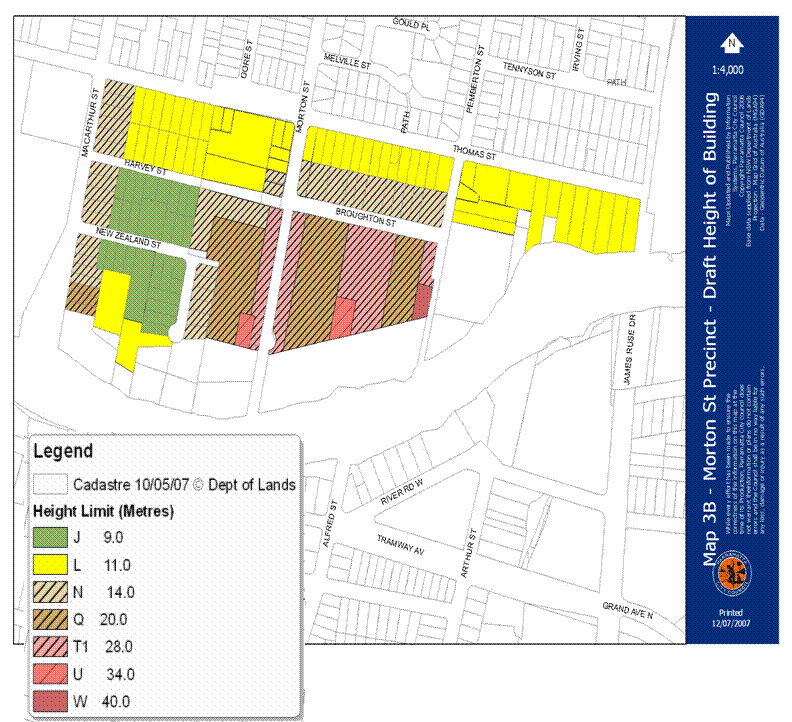
|
Ordinary Council 26 May 2008
|
Item 10.1
|
ITEM NUMBER 10.1
SUBJECT Parramatta River Foreshore Plan
Review 2008 - Public Exhibition
REFERENCE F2006/00560 - D00936445
REPORT OF Waterways Systems Manager
|
PURPOSE:
This report informs Council of the draft
Parramatta River Foreshore Plan Review 2008 and recommends the document be
placed on public exhibition for information and comment.
|
|
RECOMMENDATION
(a) That the draft Parramatta River
Foreshore Plan Review 2008 be placed on exhibition for 28 days in the
Parramatta City (central) Library, branch libraries, the Customer Service
Centre and on Council’s website.
(b) Further, that a report be
brought back to Council with consideration of public submissions and
recommendations for adoption.
|
BACKGROUND
1. The original
Parramatta River Foreshore Reserve Concept Plan and Management Strategy was prepared by Clouston Consulting in December 1994. The 1994 Plan
covered an area extending from Parramatta Park to Ermington Bay. In late 2006,
Council officers identified the need to review the plan in order to confirm
ongoing directions relevant to current and future issues.
2. The 2008
Foreshore Plan has extended the original scope to include the full extent of
the Parramatta River foreshores
within the Parramatta Local Government Area, from Lake Parramatta Reserve to Ermington Bay divided into
nine (9) geographic precincts.
3. Environmental
Partnership were commissioned in February 2007 (at a cost of $63,000) to
prepare the Foreshore Plan Review for the Parramatta River. The primary aim of the 2008 Foreshore Plan Review is: To revise the current Parramatta River Foreshores
Reserves Concept Plan and Management
Strategy and develop a prioritised action / implementation plan to consistently guide the future management and development of the Parramatta River Foreshore over the next 20 years.
ISSUES/OPTIONS/CONSEQUENCES
4. The
preparation of the revised Plan incorporates linkages to existing Council
strategic documents including Parramatta Twenty25 and the Revitalising
Parramatta City Centre Plan / Vision. With the Plan now extending upstream of
the CBD, a number of other strategic documents were also considered including
the Parramatta Park Plan of Management and Masterplan, the North Parramatta
Mixed Use Zone Masterplan, the Westmead Precinct Implementation Plan and the
Lake Parramatta Plan of Management.
5. While the Parramatta River foreshore plan
focuses on the land based activities, Council is involved in the preparation of
the Parramatta River Estuary Management Plan which will target
the management of tidal waters from Charles Street Weir to Cockatoo Island (confluence with
the Lane Cove River). This will be a
staged process over the next 18 months commencing with a data compilation or
literature review report, an estuary processes study (examining data gaps) and
the management plan itself. Council officers will ensure that the two Plans
have appropriate linkages, synergies and integration during their respective
implementation phases.
6. The
draft Foreshore Plan includes: implementation of key management areas to date;
a vision for the river foreshore and each specific precinct; foreshore values,
issues and objectives; an updated implementation action plan for both the river
corridor and each precinct; a checklist for future foreshore development;
funding options and prioritisation of actions; proposed monitoring and
evaluation of the plan; and consultation to date.
7. The
revised Plan incorporates a number values which identify the qualities of the
foreshore open spaces that are seen to be important and that should
be conserved and optimised. These include habitat, water management, landscape
and visual quality, future urban form, landuse and ownership, access and
transport, recreation, visitation and special events, cultural heritage, and
planning, policy and management.
8. Sources
of funding have been identified within the Plan including existing capital
works planned within Programs supported by Special Rates for Open Space, City
Centre, Suburban Infrastructure (Environment, Roads and Neighbourhoods), the
Stormwater Charge, the Section 94A Development Contributions Plan, as well as
numerous State and Federal government grant opportunities.
9. It
should be noted that an Executive Summary will be developed along with
promotional material (eg. posters, fact sheets) for the exhibition period. Due
to the large number of precinct maps (18 in total) that accompany the Plan,
only 2 examples have been attached to this report for ease of reference and
file size. A full set of maps will be available for the exhibition period and
the return report to council.
CONSULTATION & TIMING
10. In
July 2007, Council officers conducted three separate workshops involving
internal staff, authorities, key stakeholders, and community representatives
selected and organised through the Residents Panel. In addition two Councillor
workshops were conducted in August 2007 and May 2008, as well as a Councillor
River Cruise which occurred in late September 2007.
11. It is
recommended that the draft Parramatta River Foreshore Plan Review 2008 be
placed on public exhibition for 28 days in the Parramatta City
(central) Library, branch libraries, the Customer Service Centre and on
Council’s website.
12. A further report be brought back to Council with
consideration of public submissions and recommendations for adoption.
Anthony Collins
Waterways Systems Manager
City Strategy Unit
Attachments:
|
1View
|
Draft Foreshore Plan (text only)
|
166 Pages
|
|
|
2View
|
Example Precinct Map - Actions
|
1 Page
|
|
|
3View
|
Example Precinct Map - Principles
|
1 Page
|
|
REFERENCE MATERIAL
|
Attachment 1
|
Draft Foreshore Plan (text only)
|






















































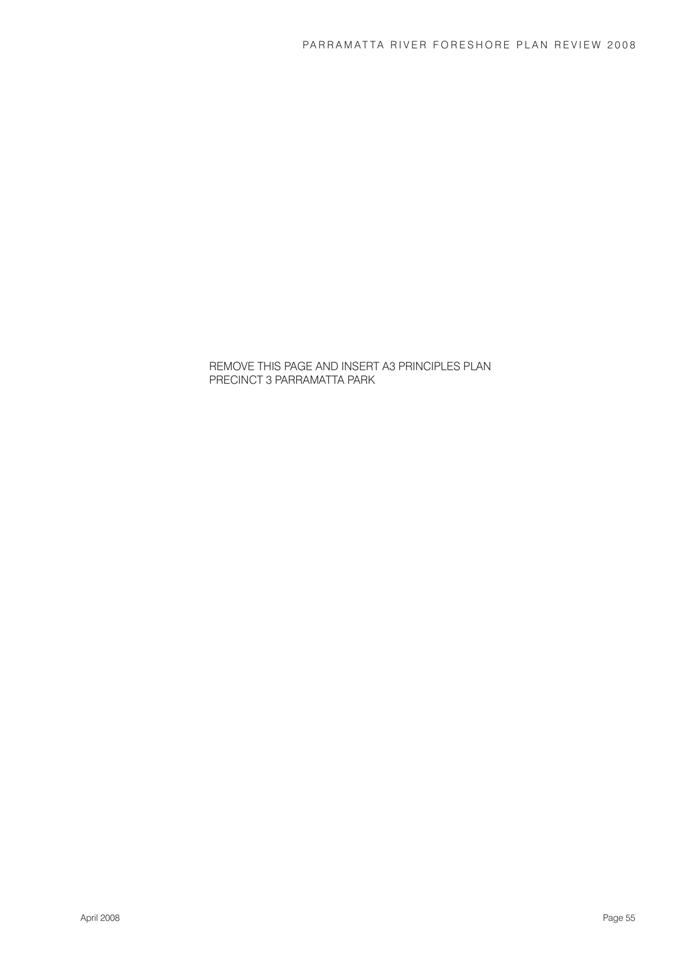





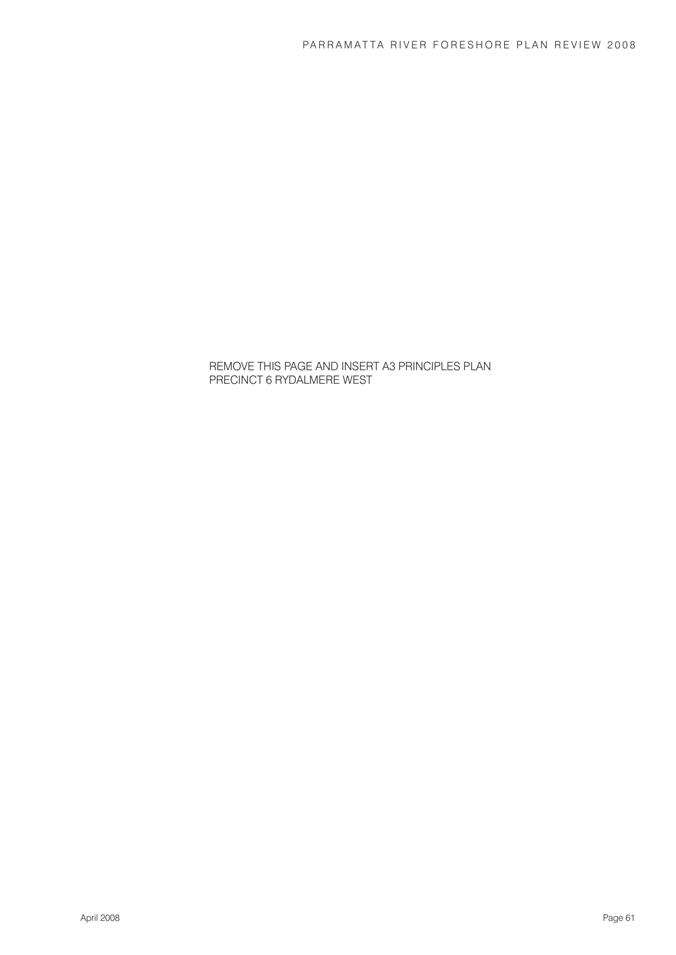





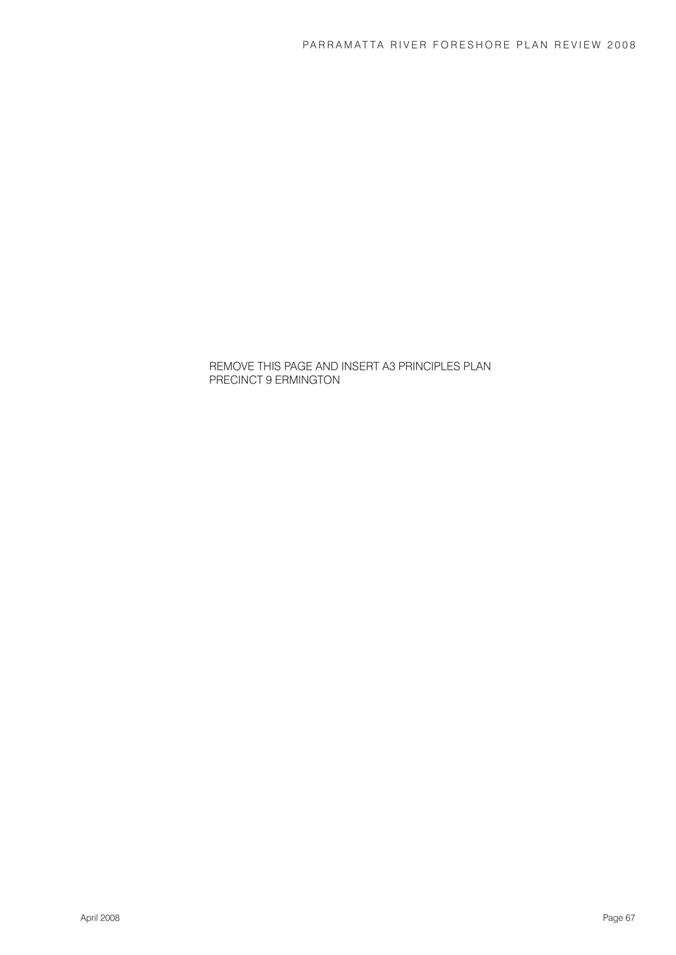

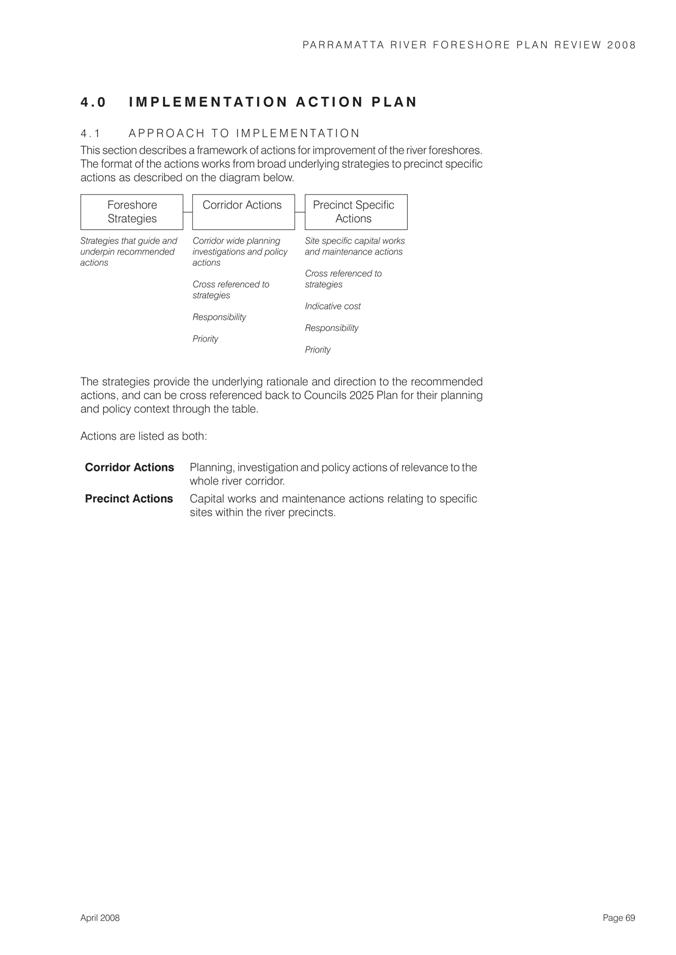
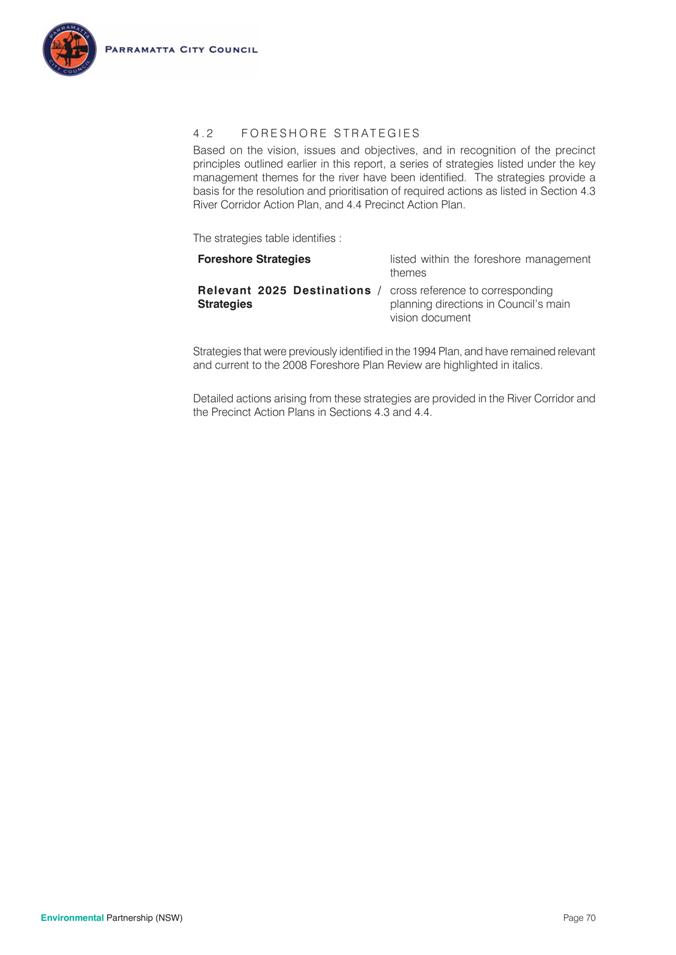
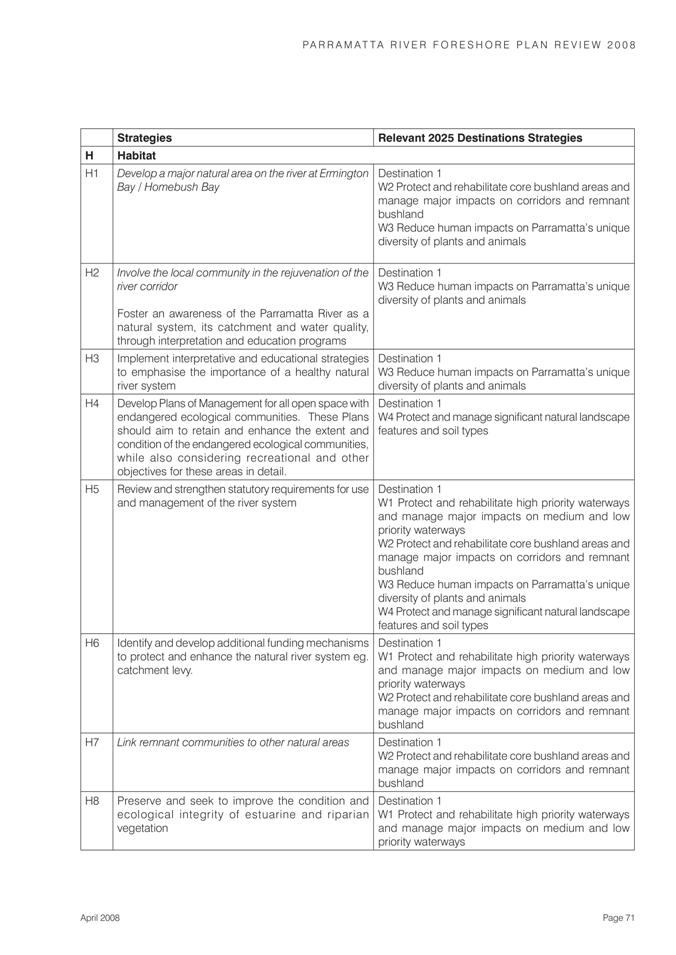
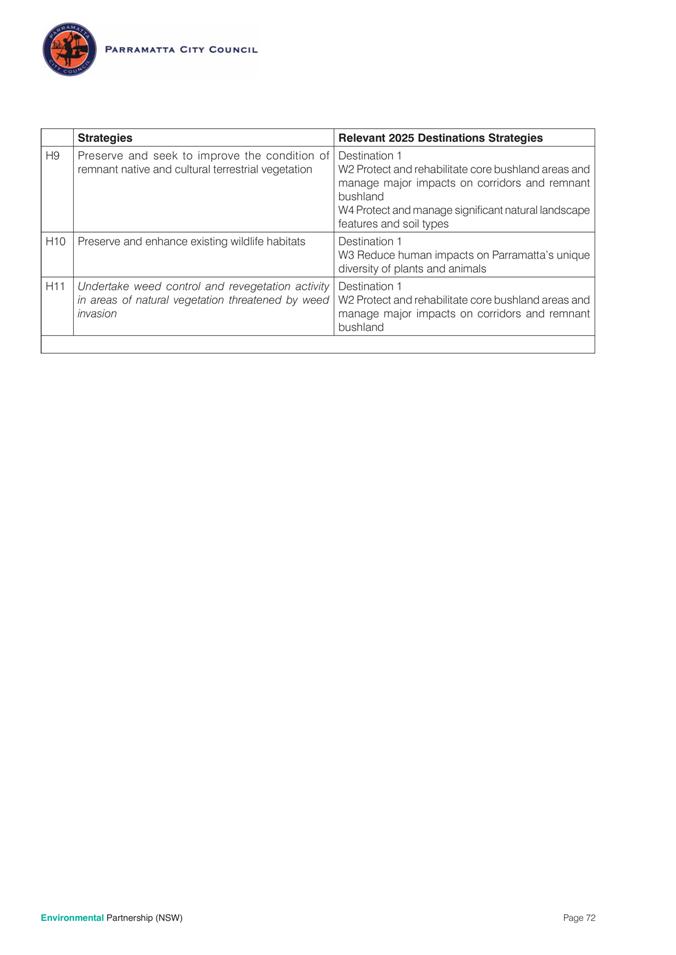
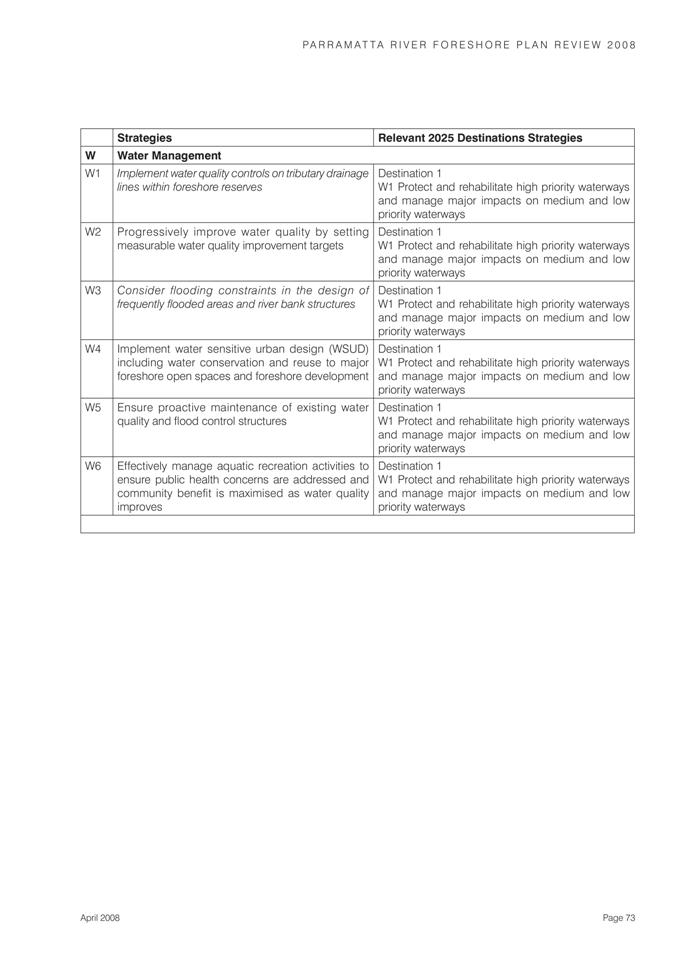
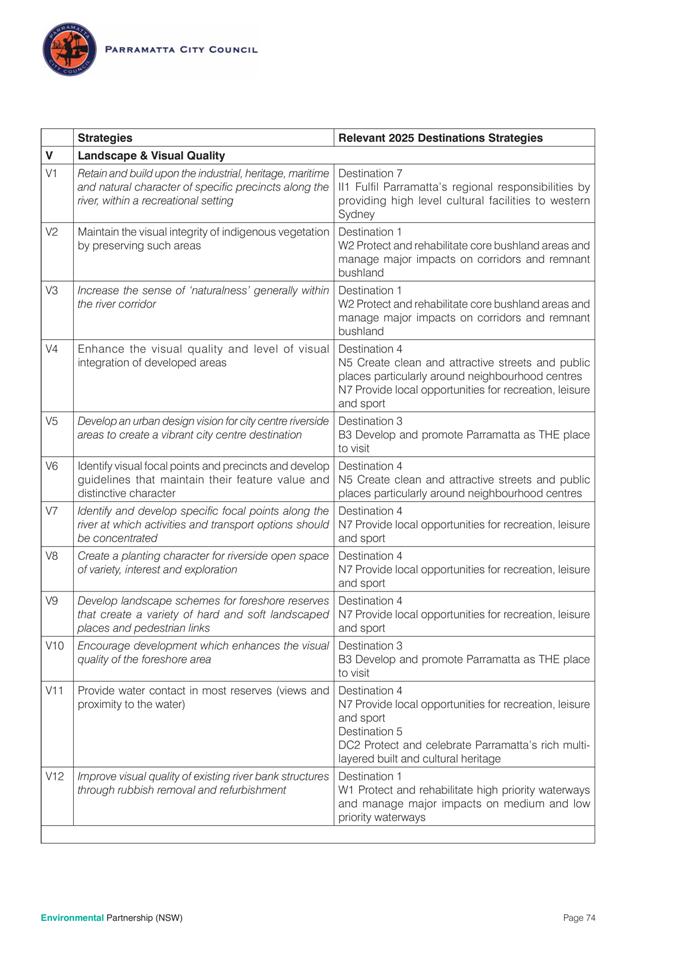
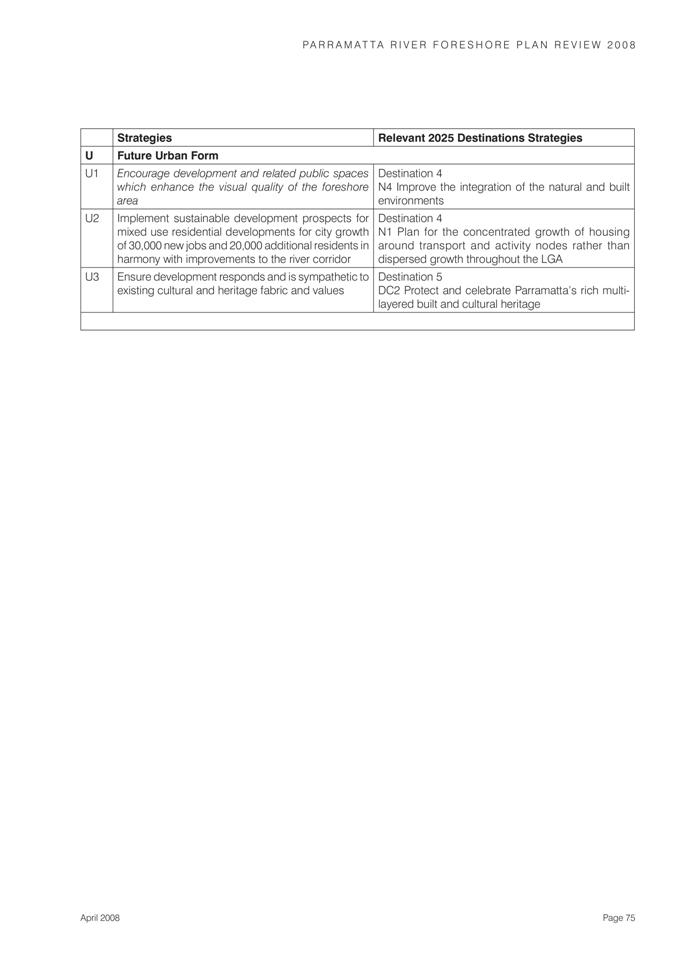
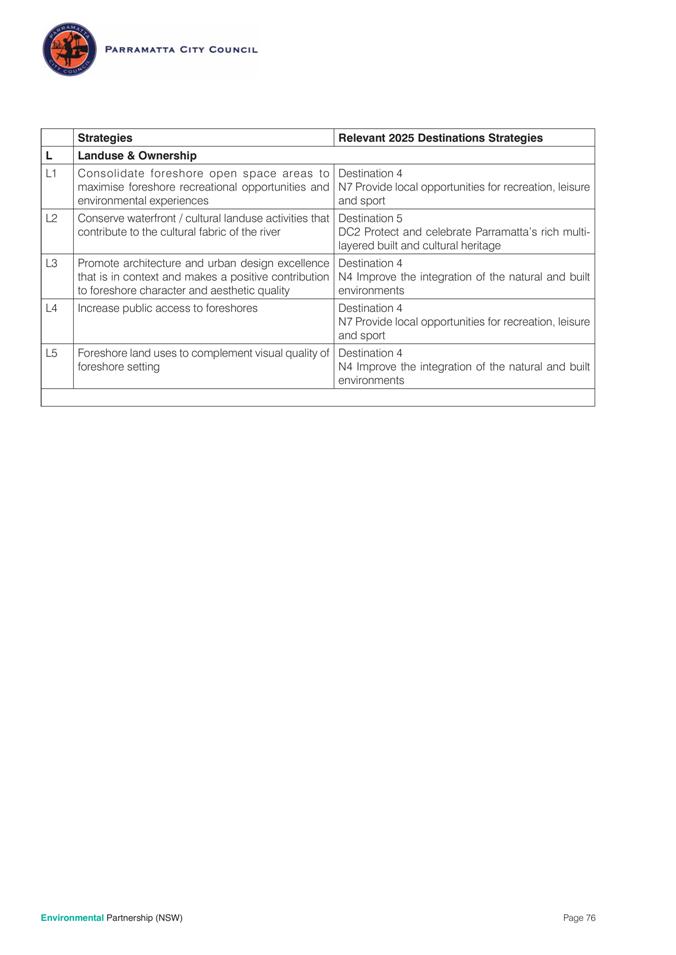
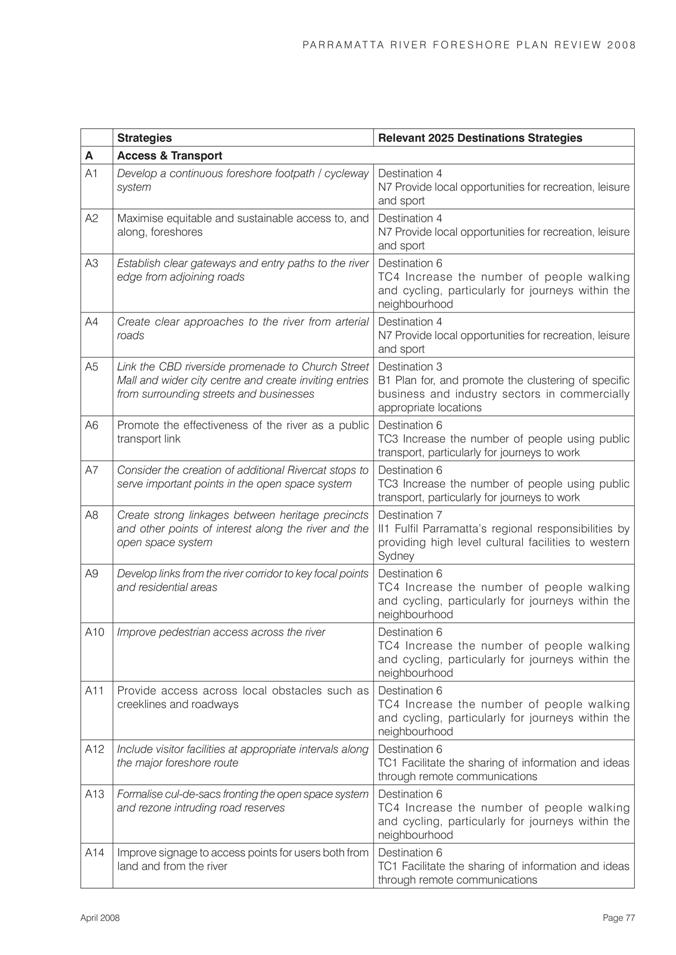
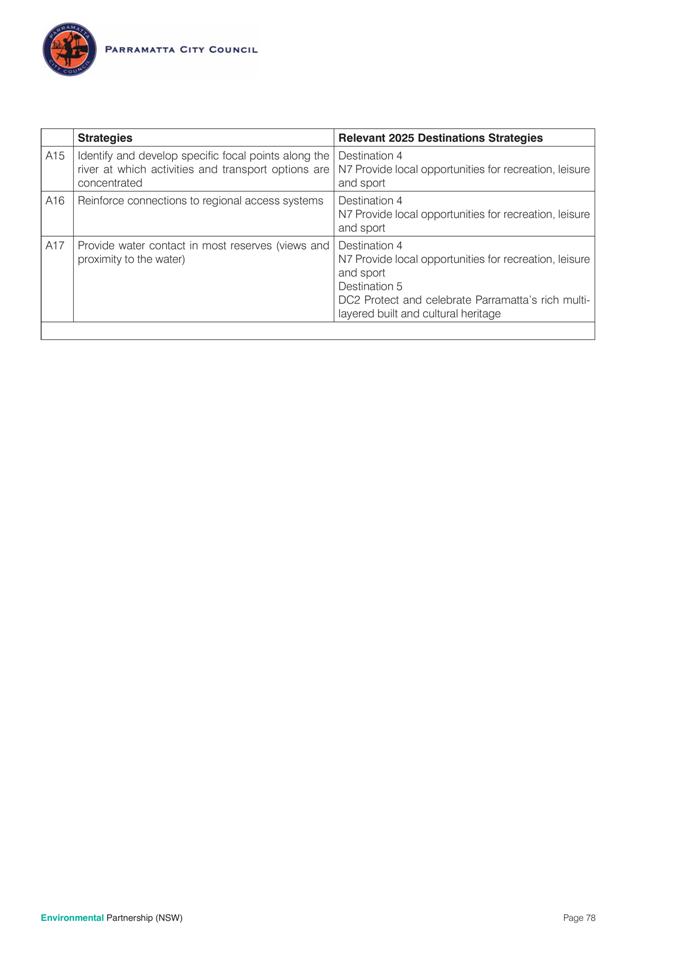
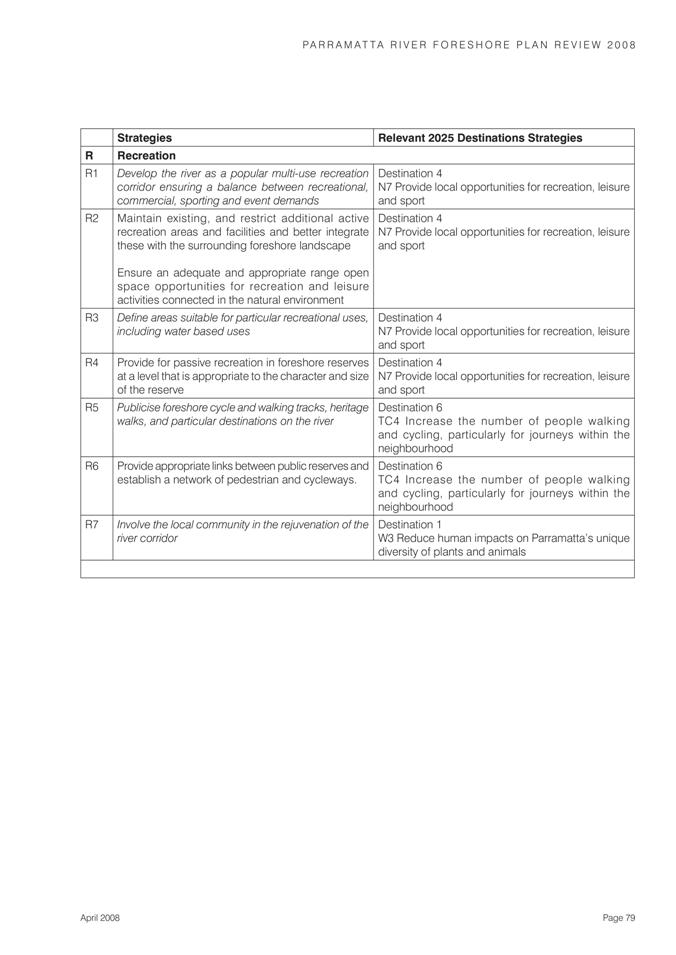
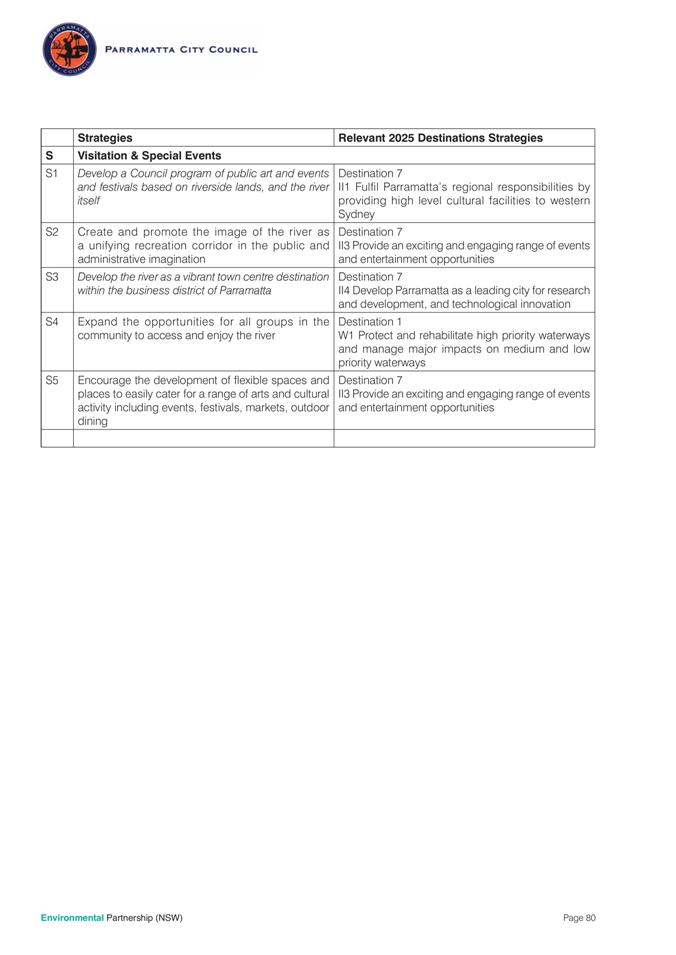
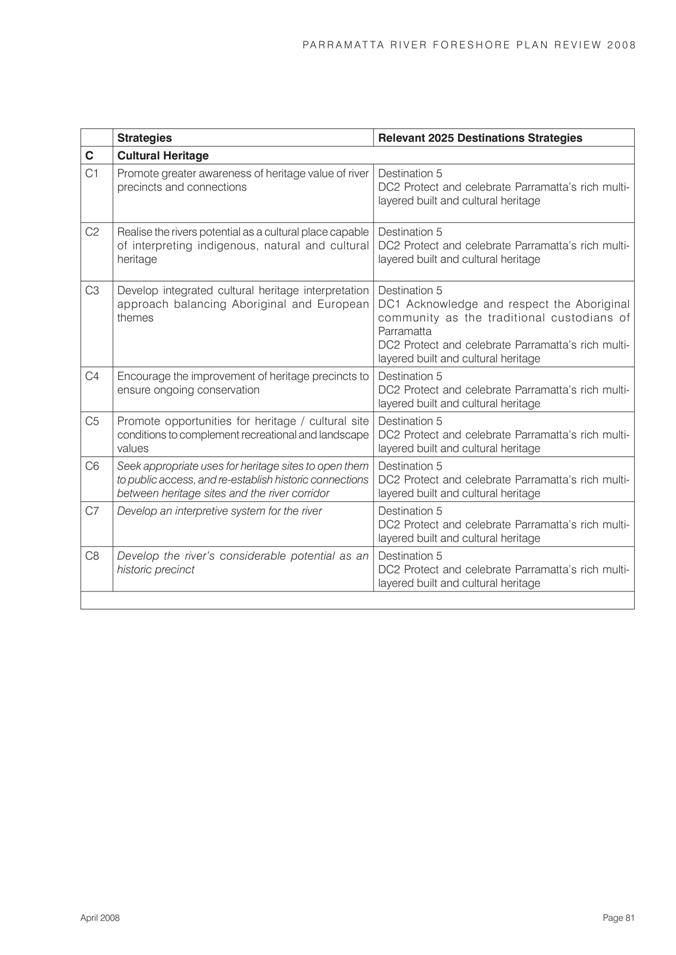
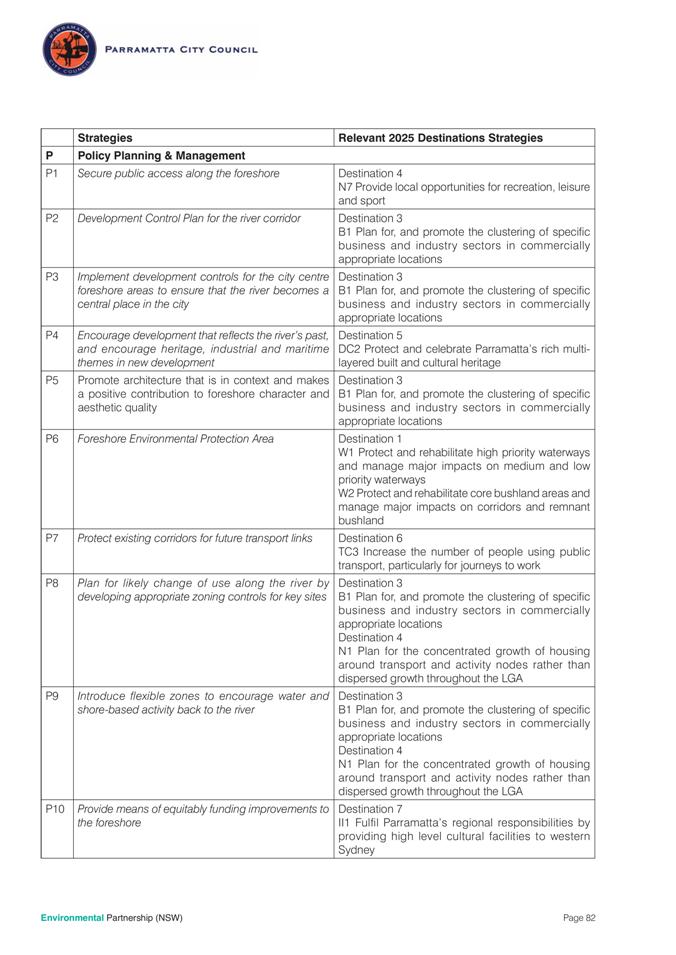
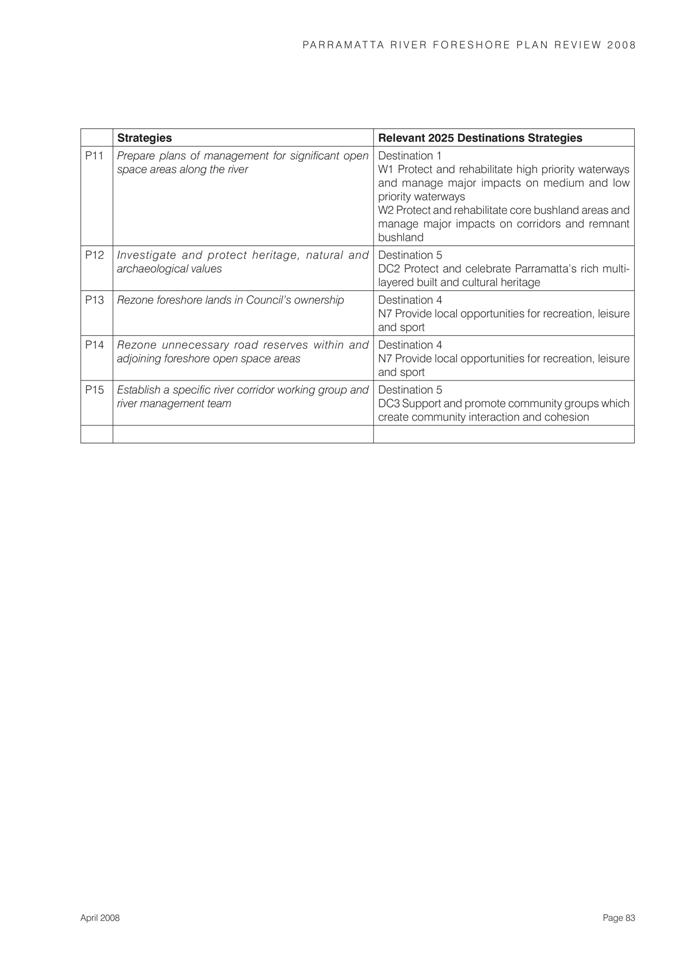
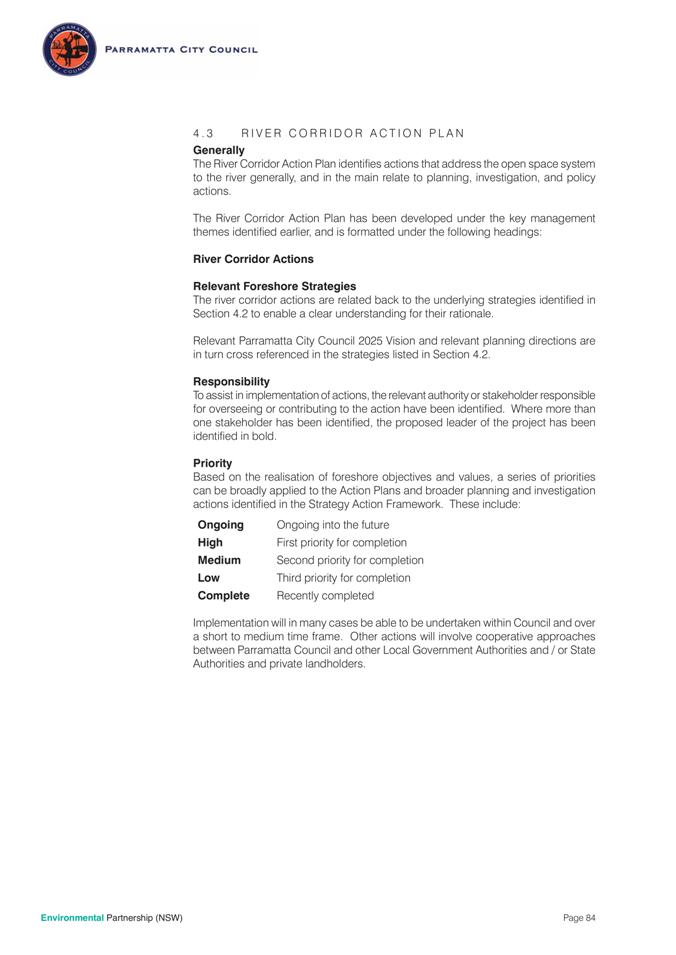
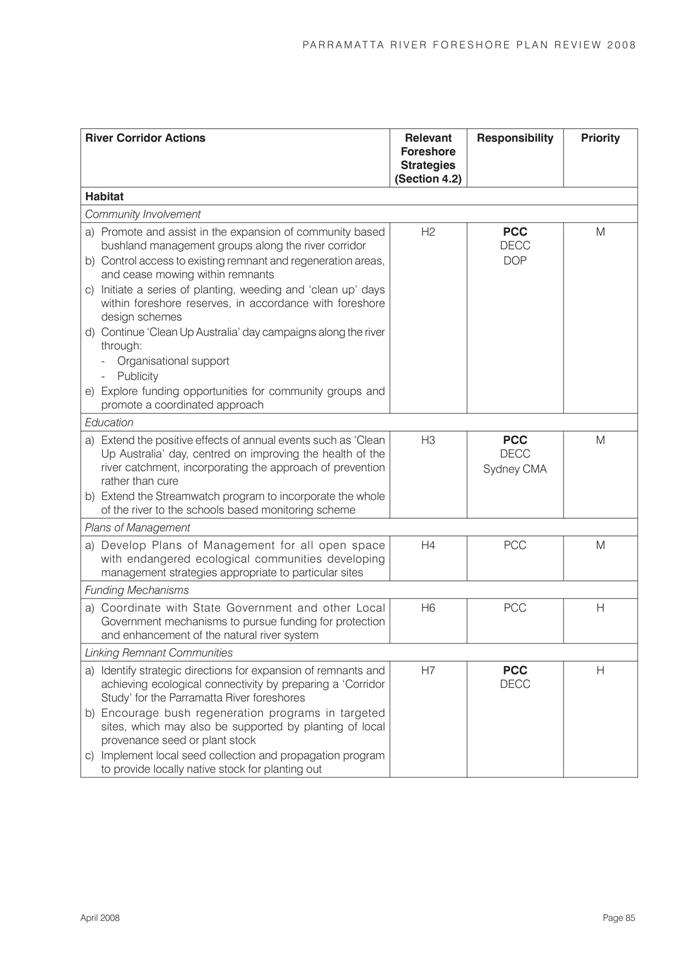
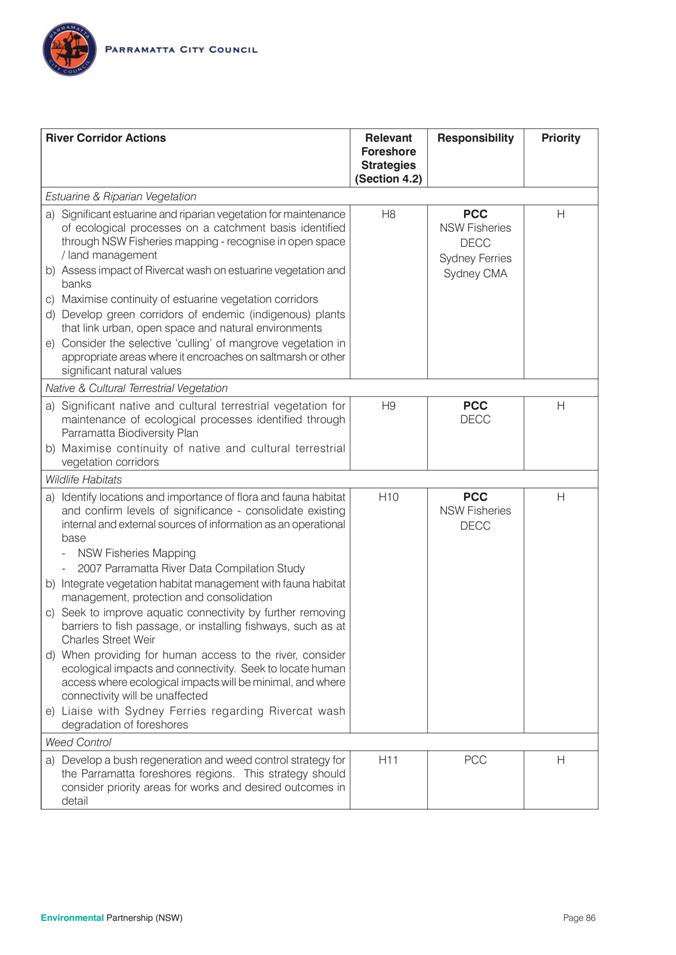
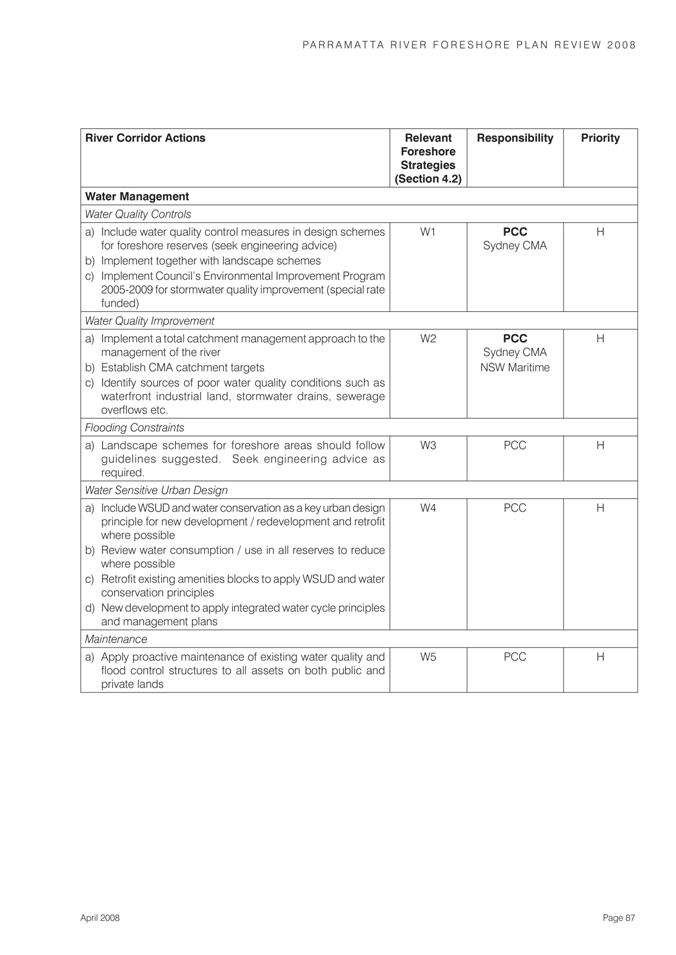
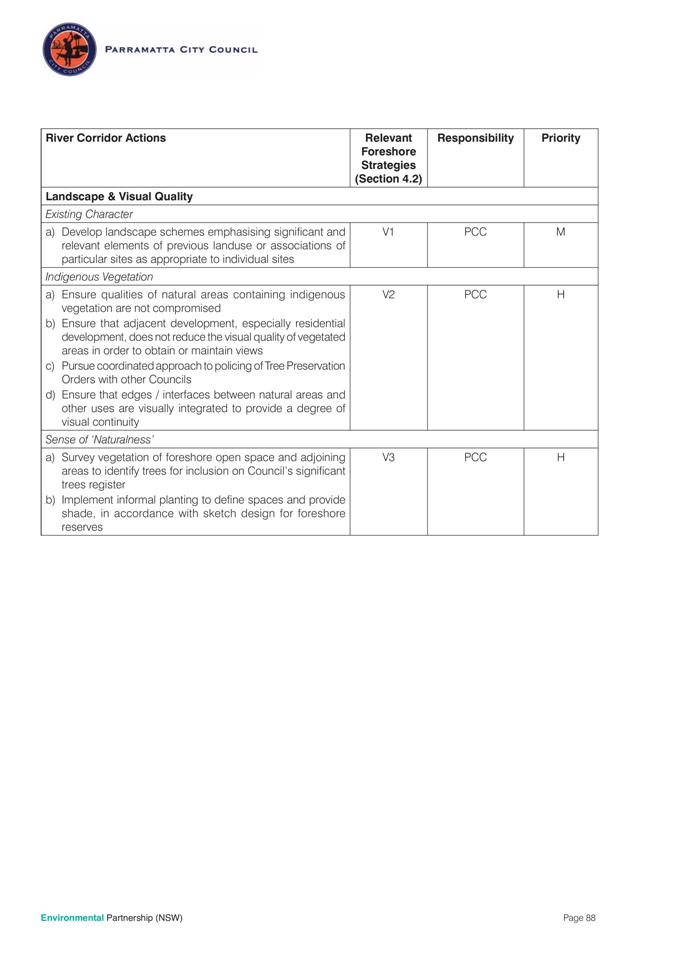
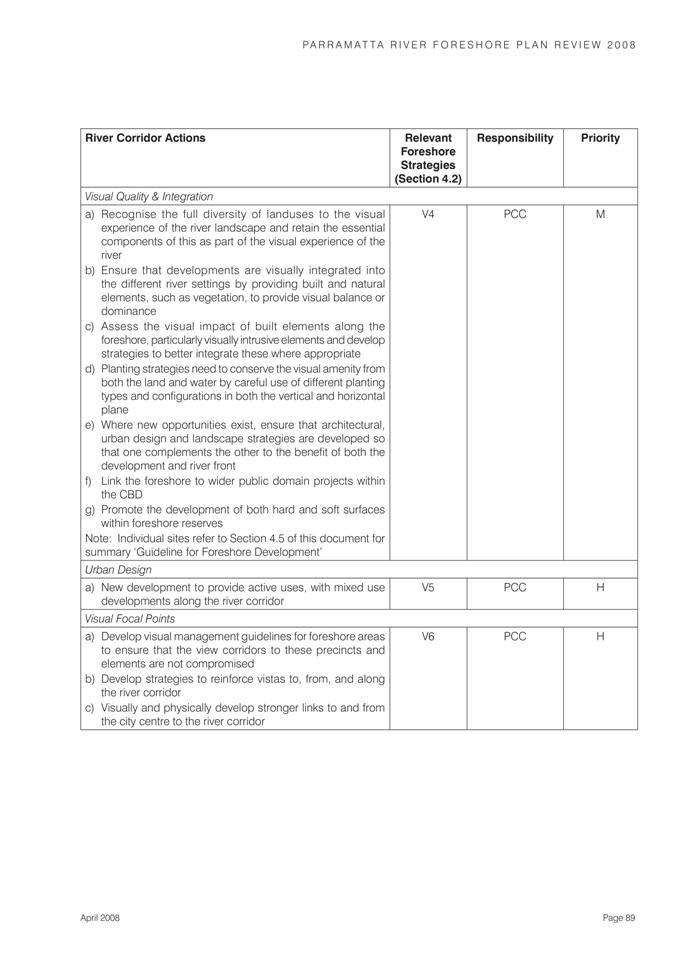
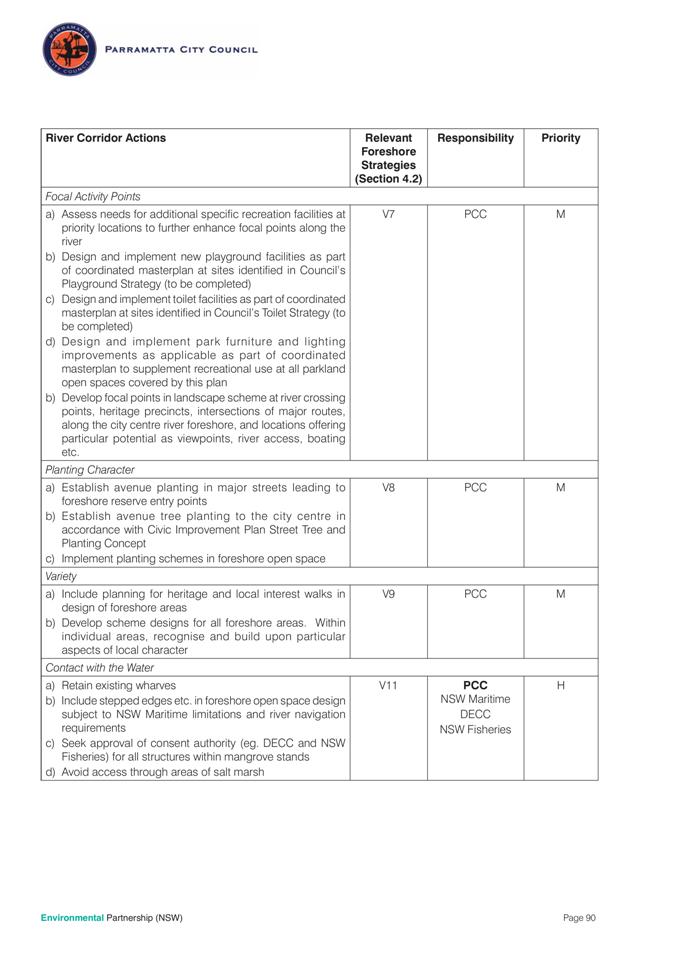
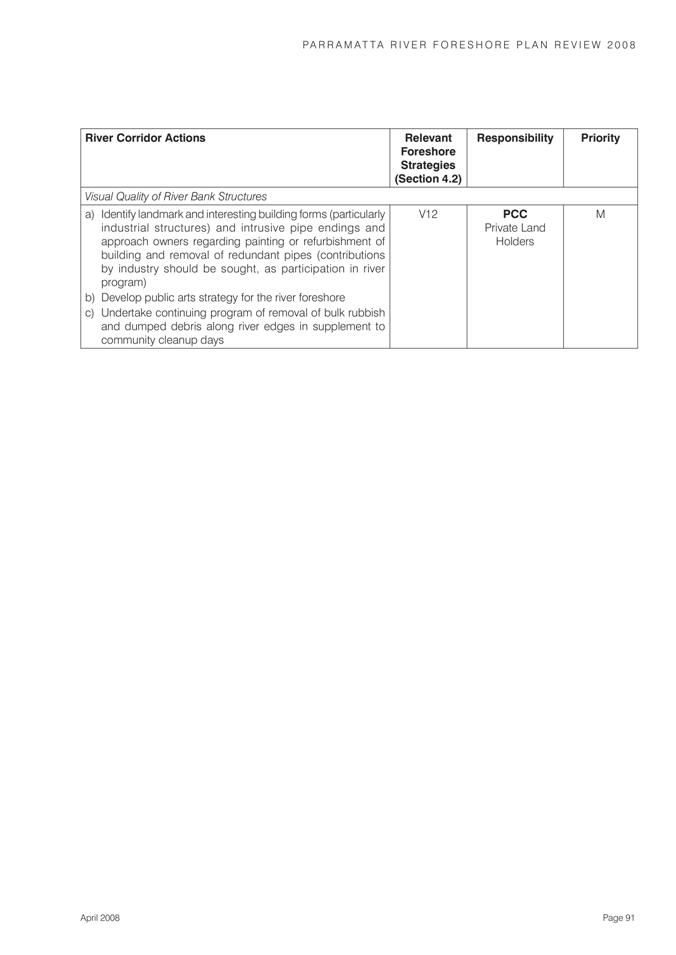
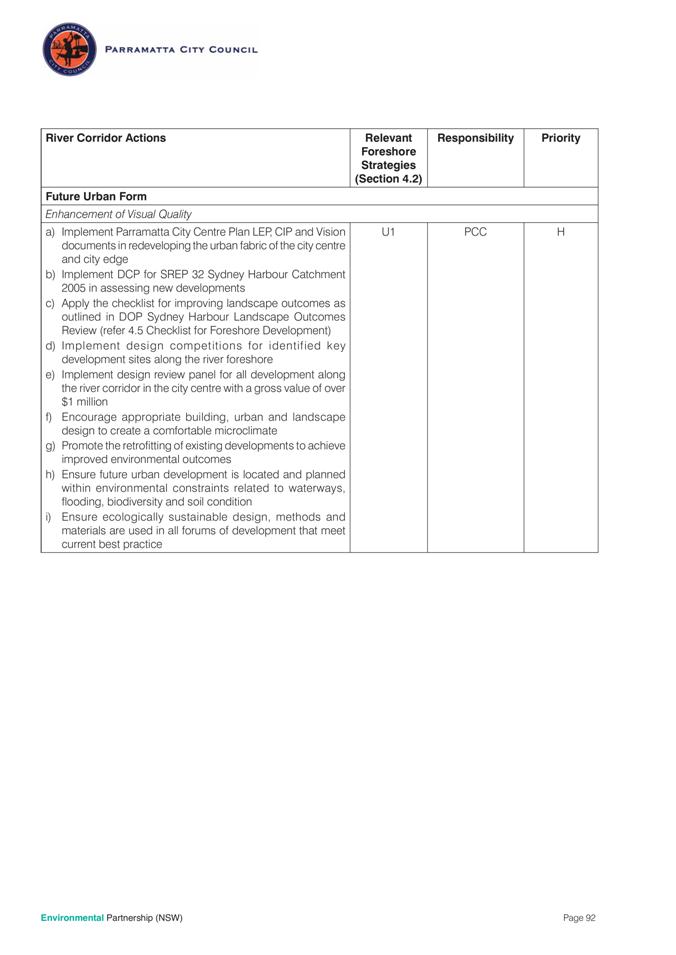
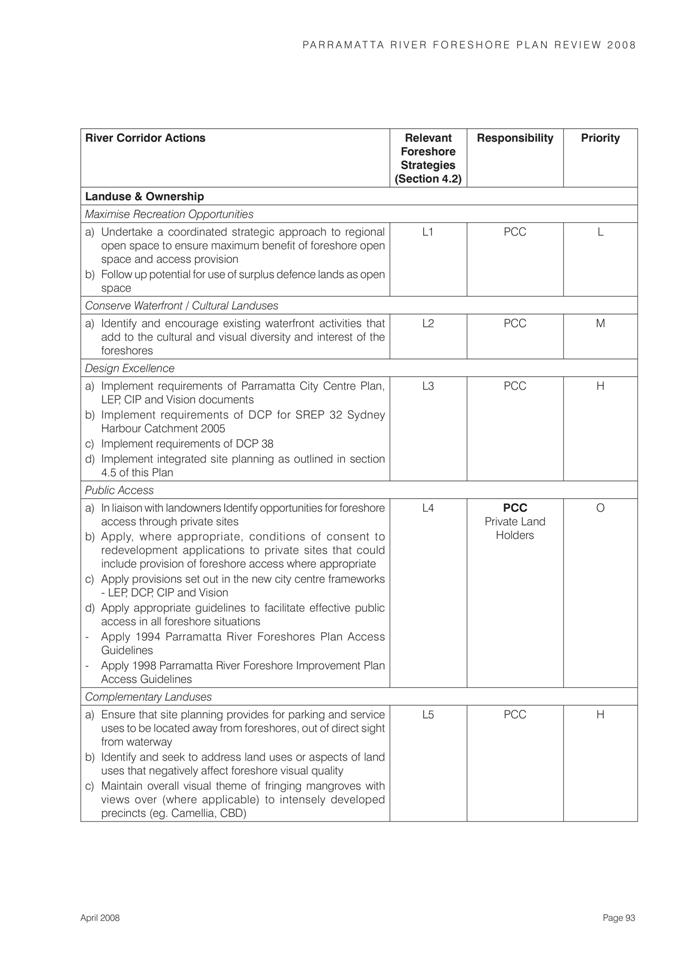
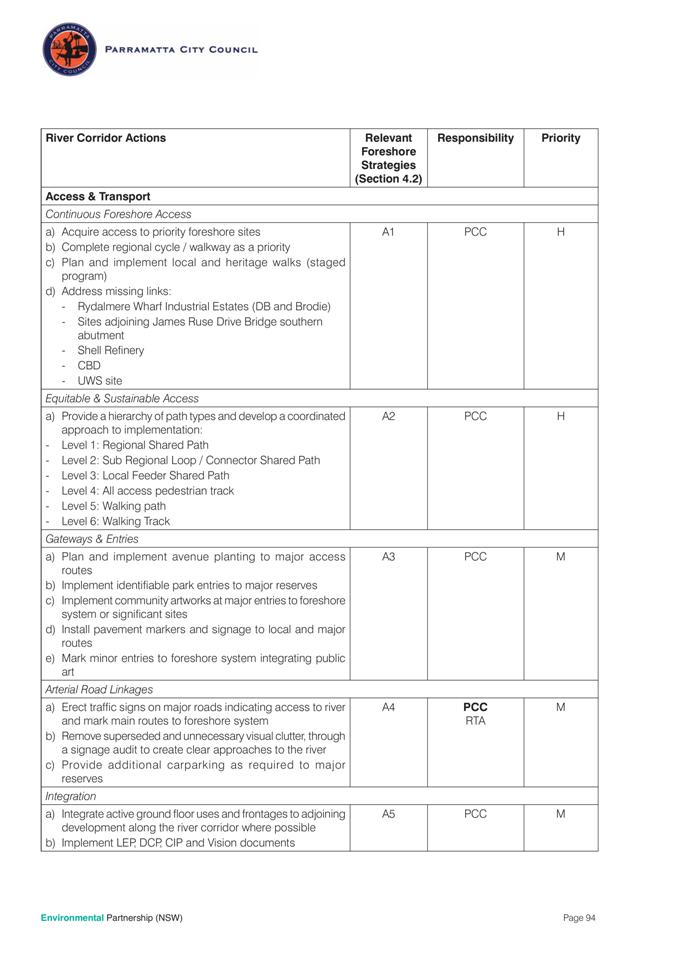
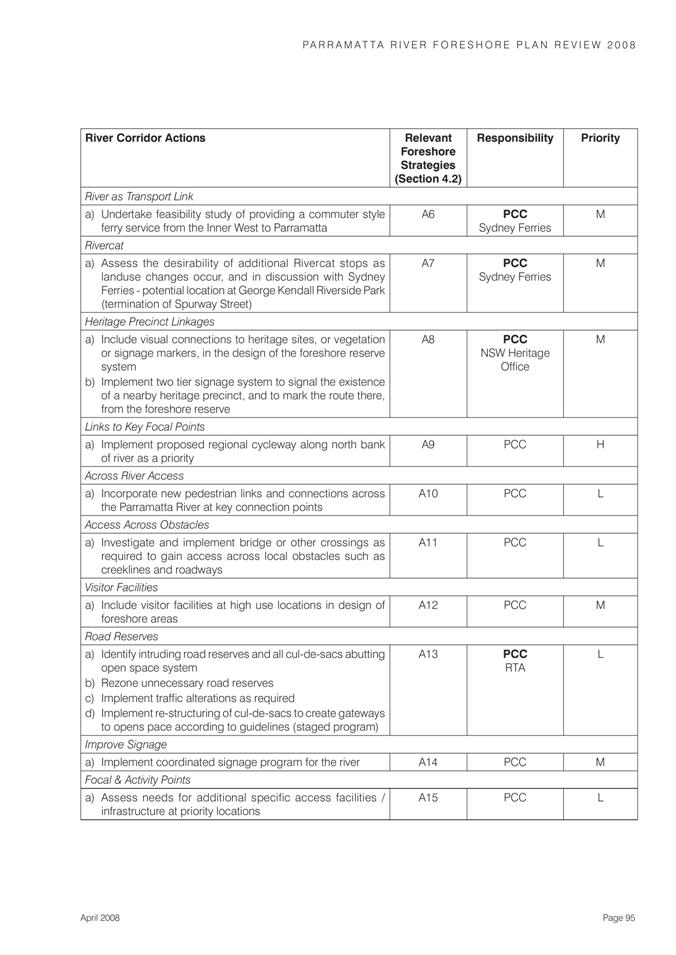
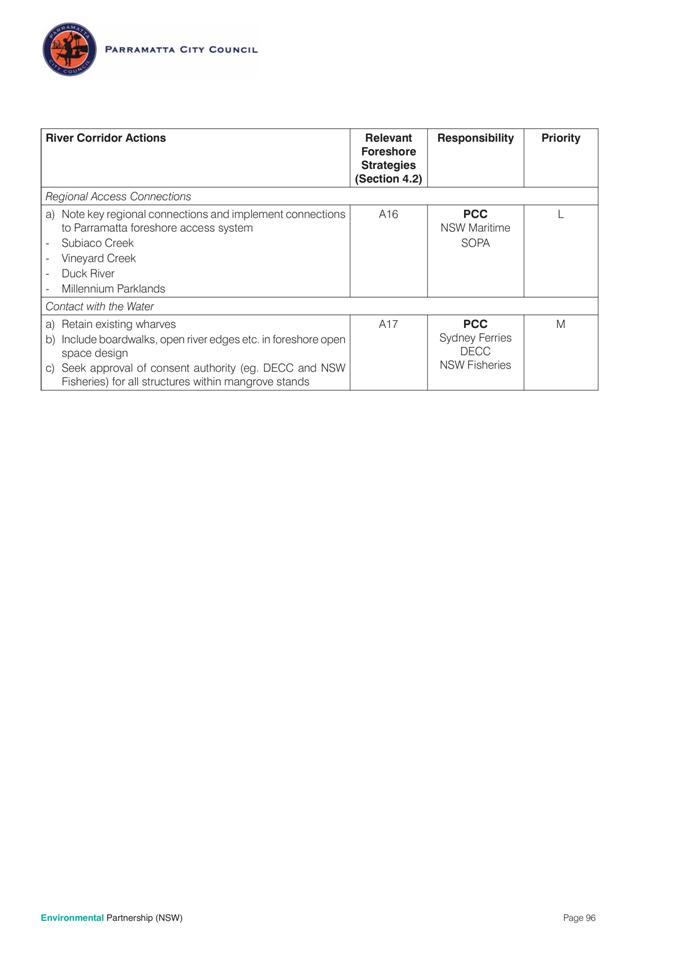
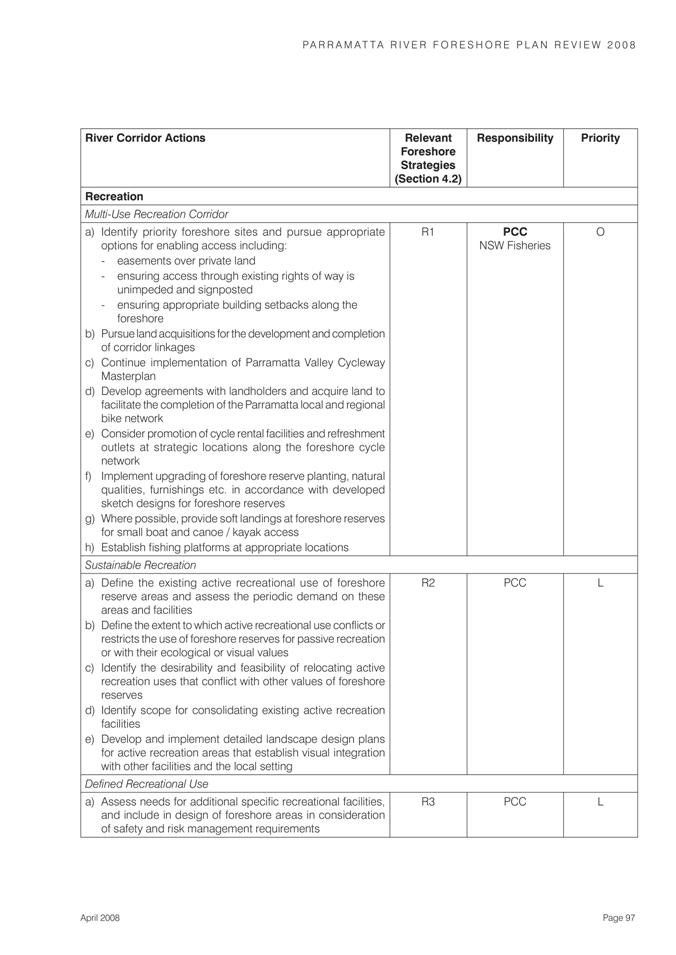
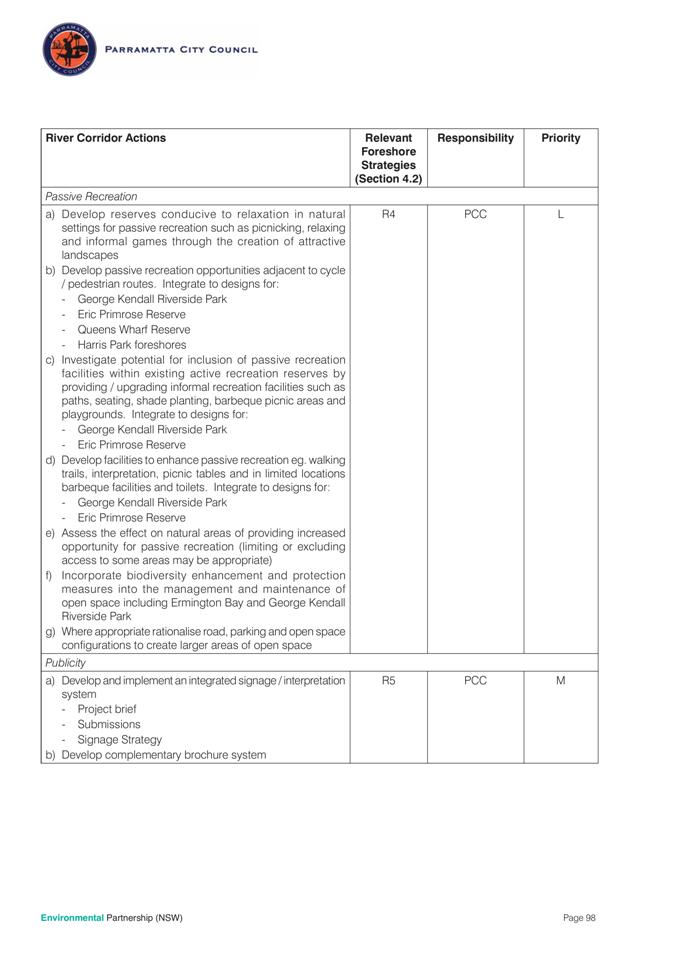
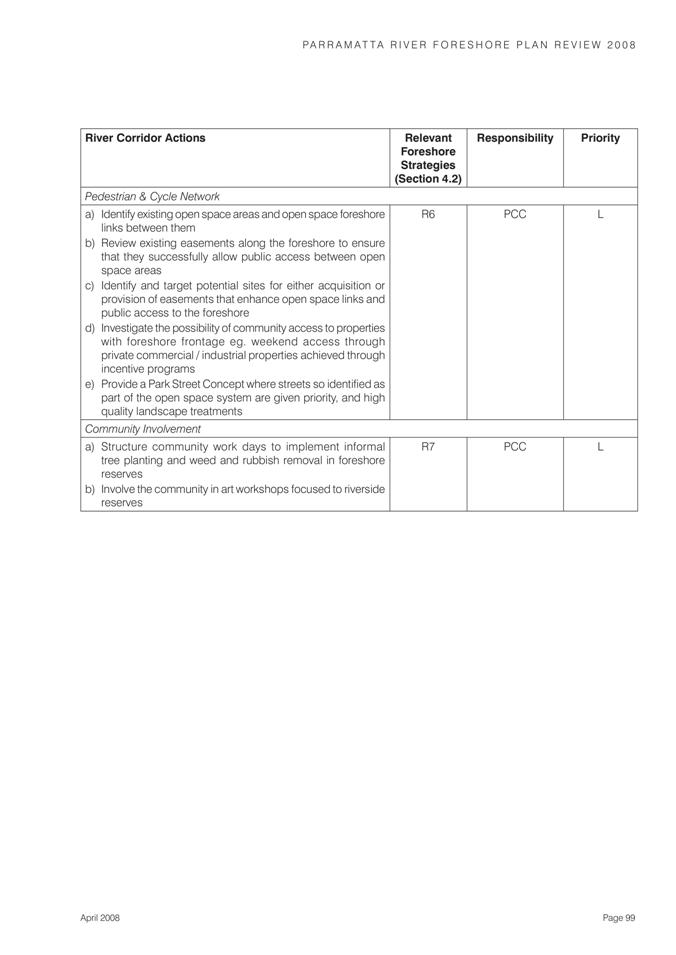
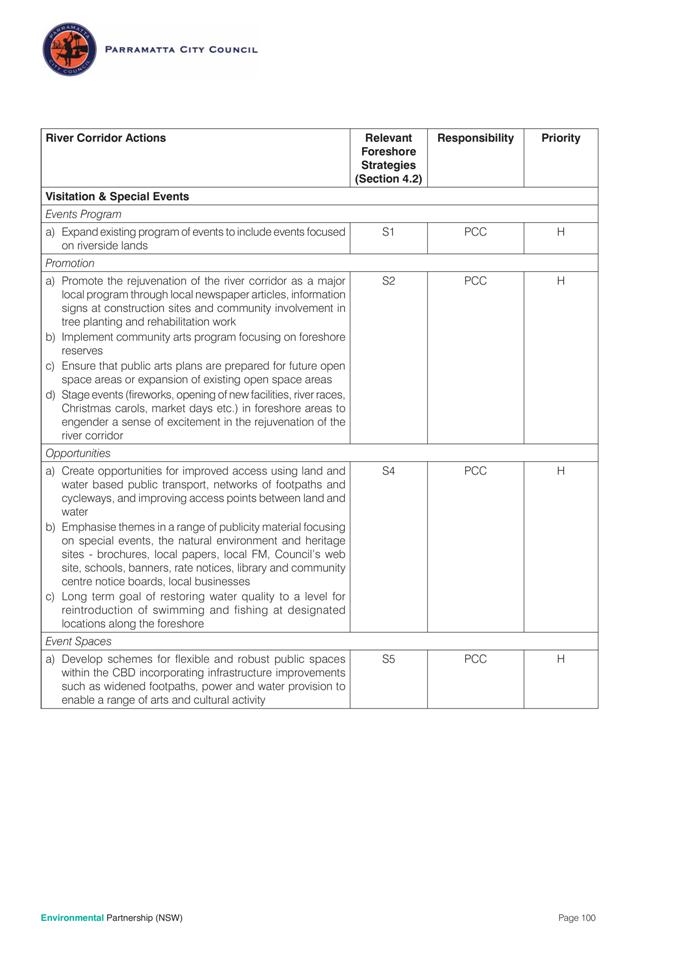
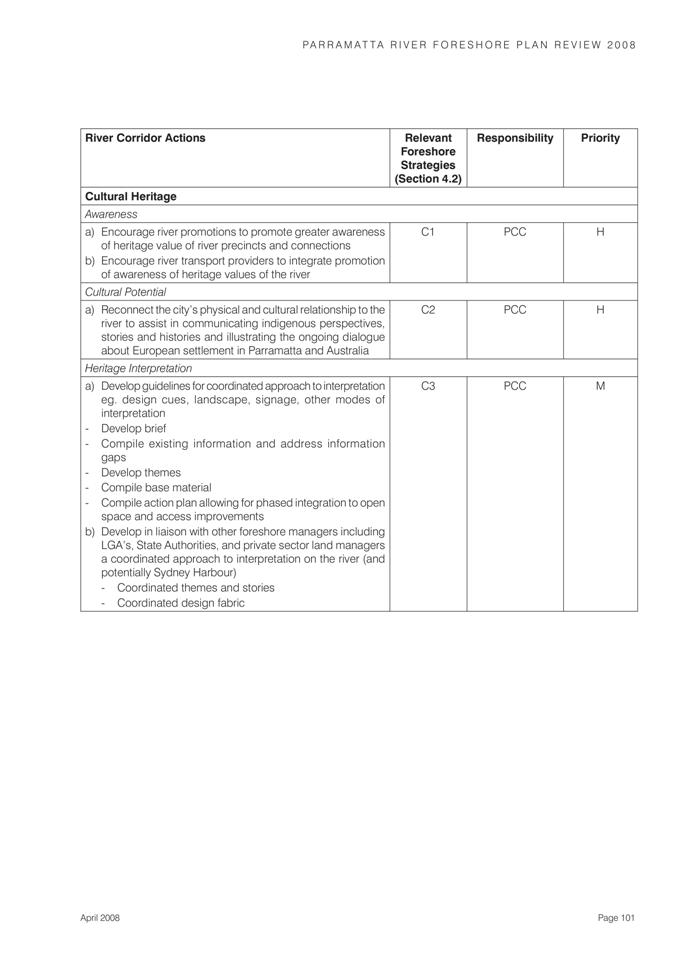
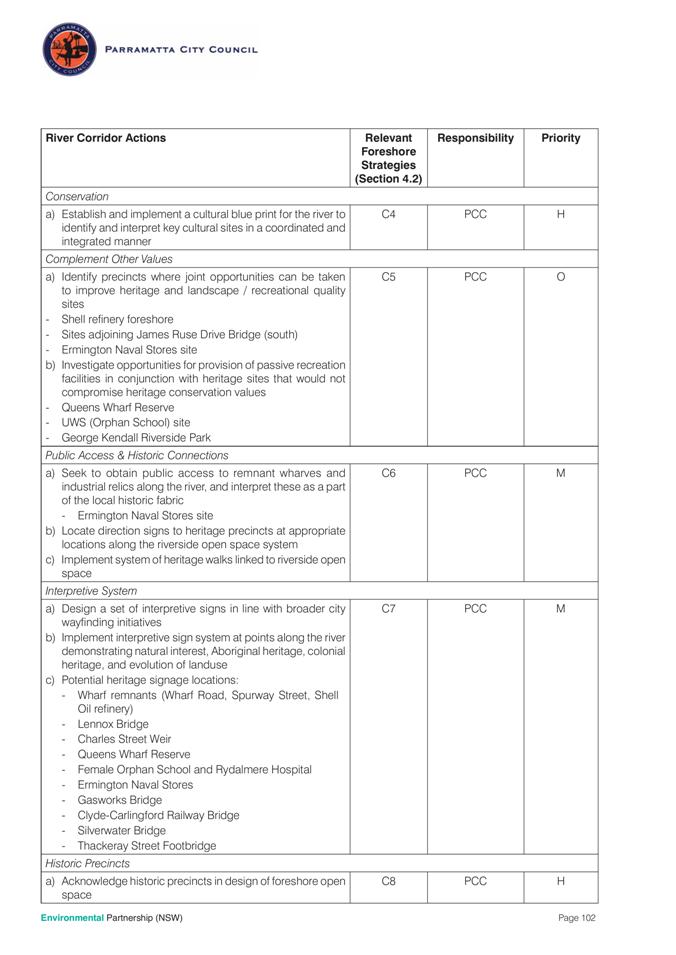
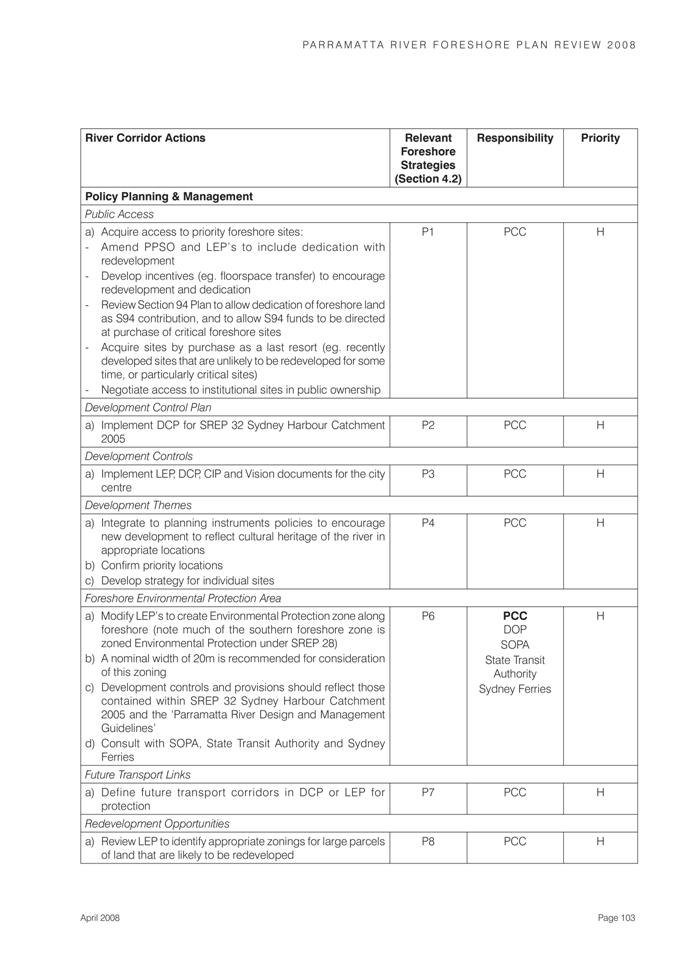
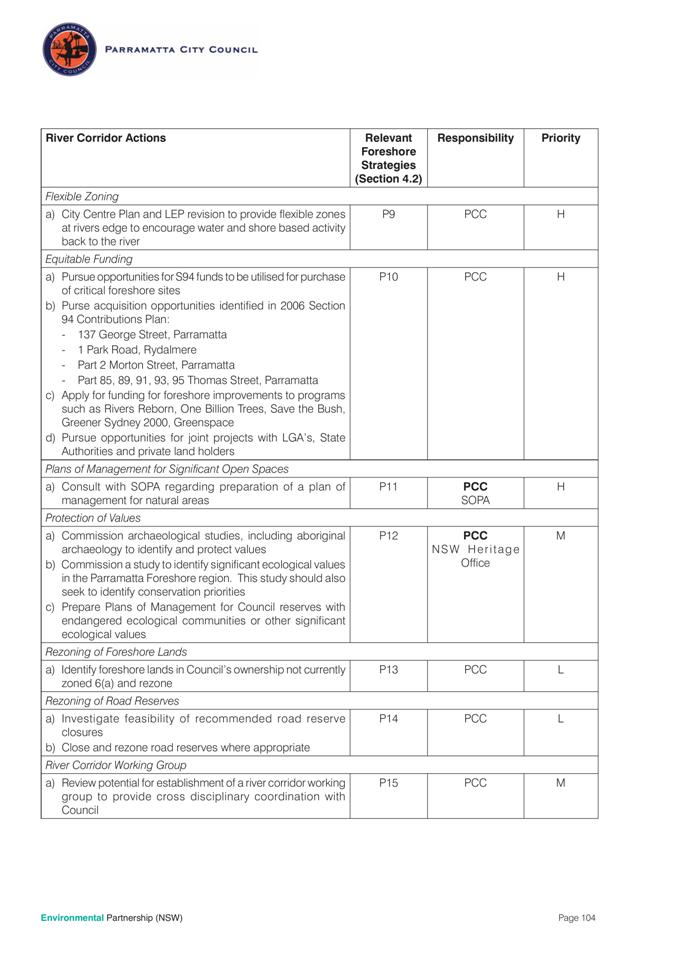
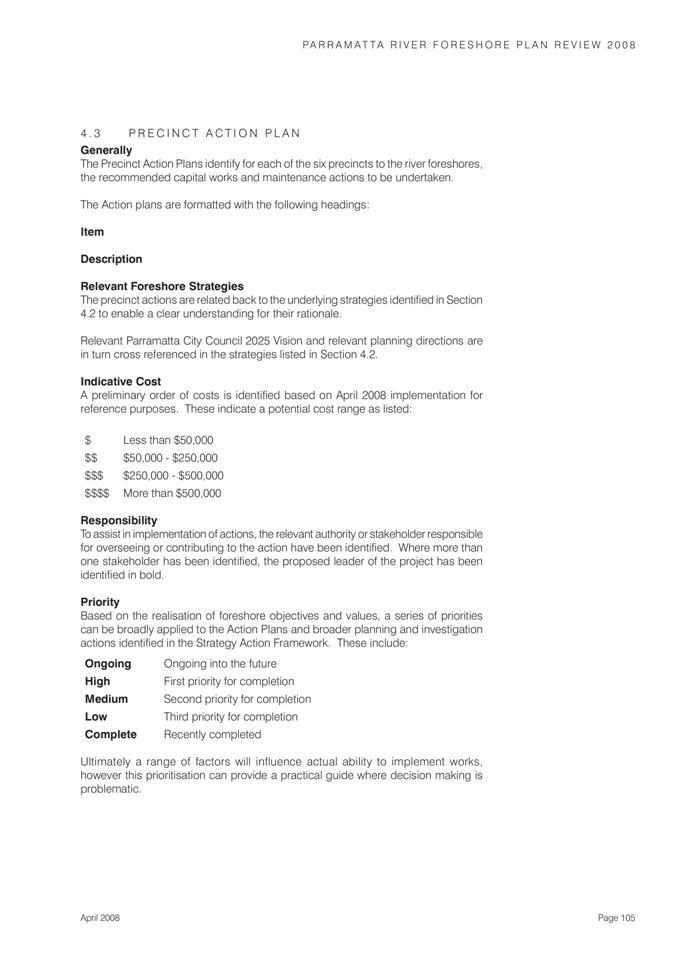

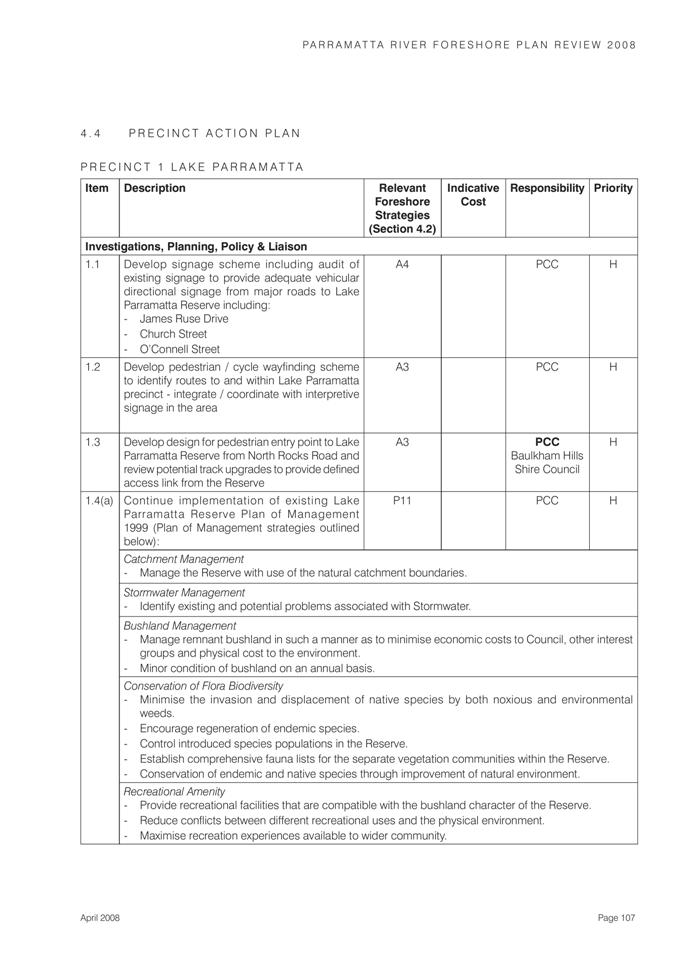
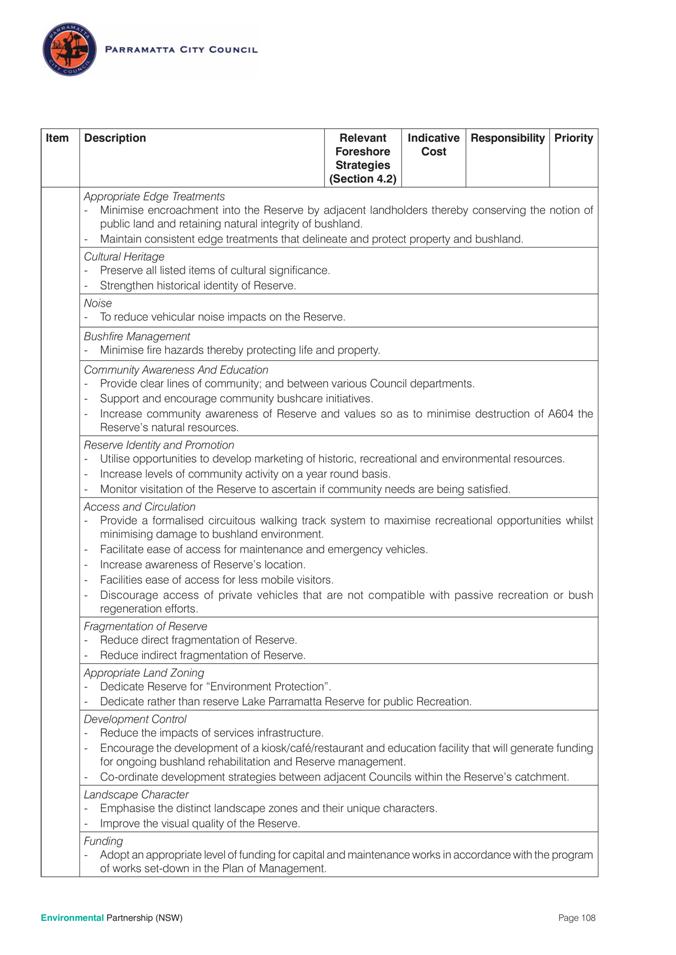
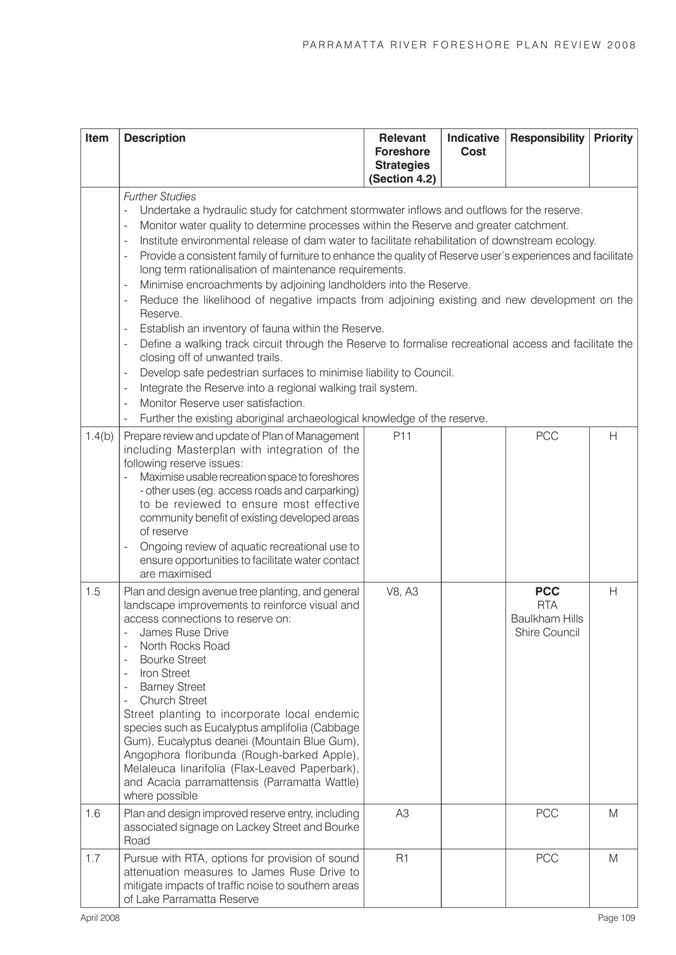
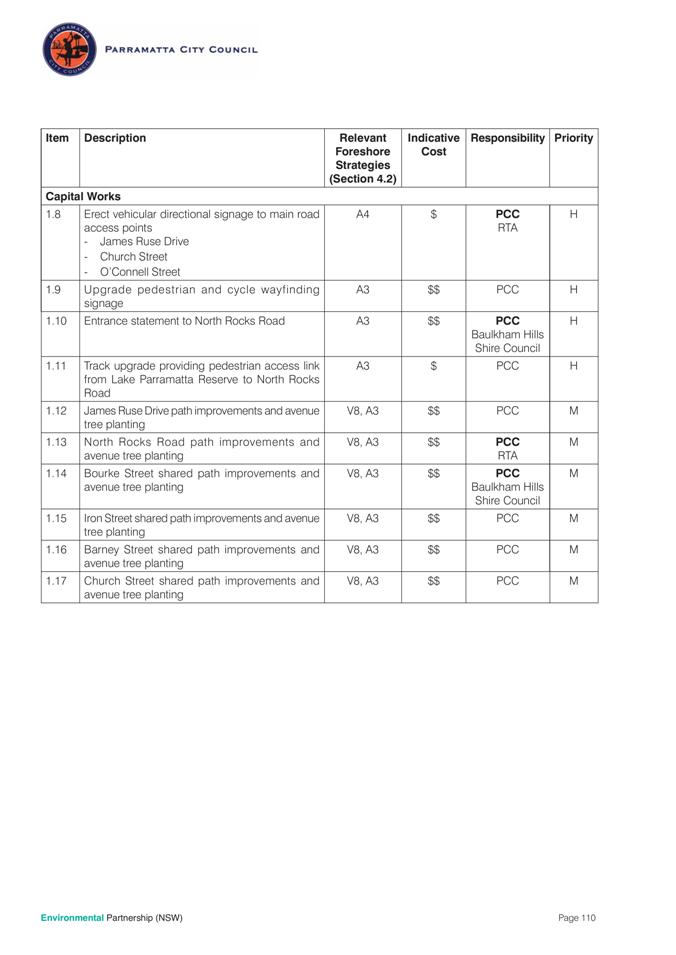
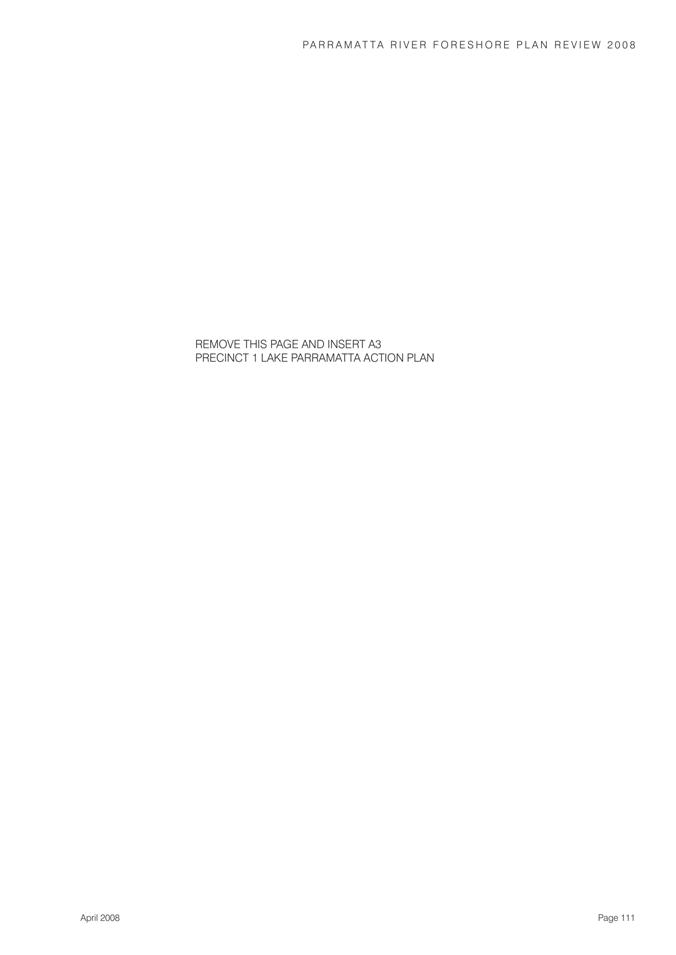

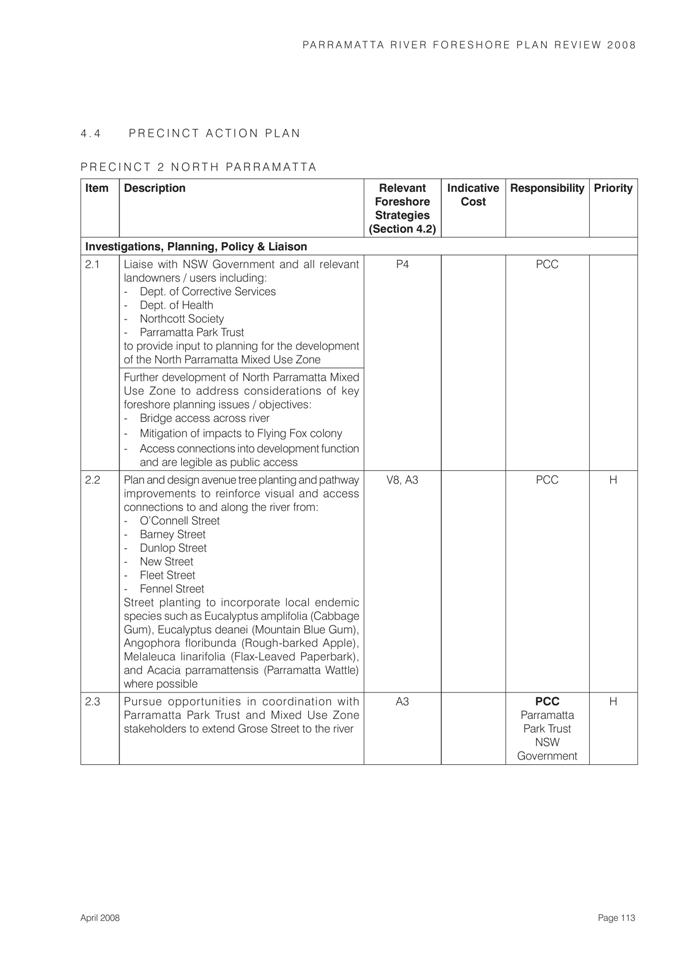
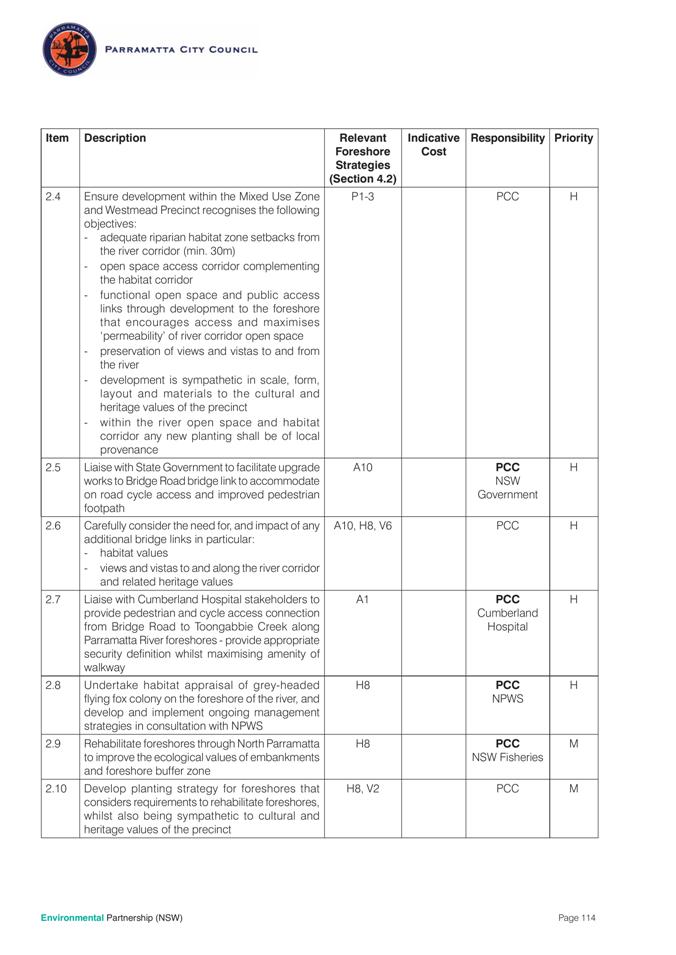
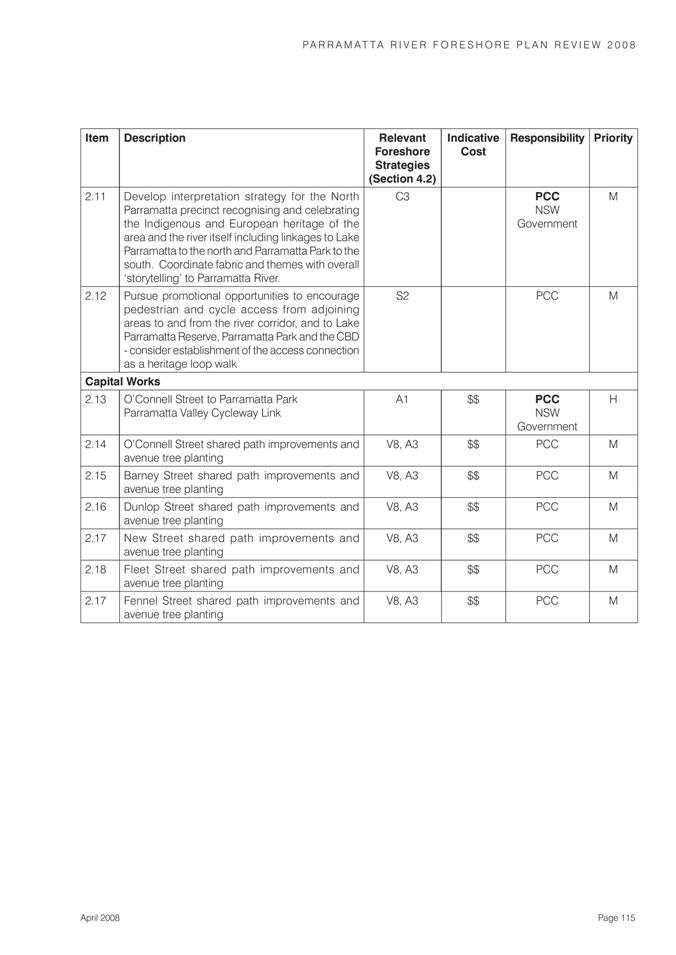

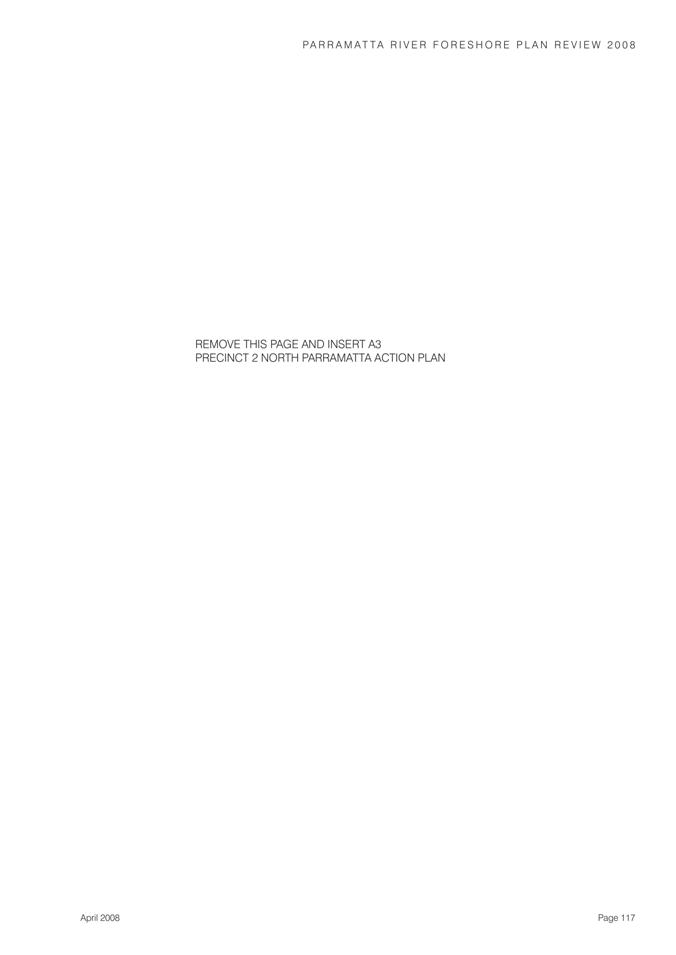

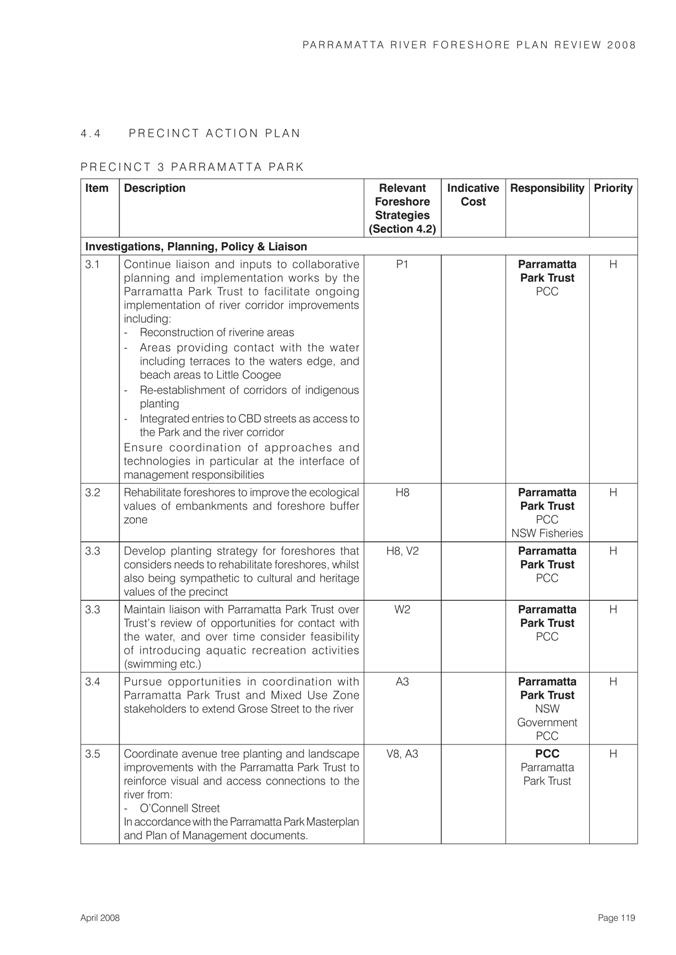
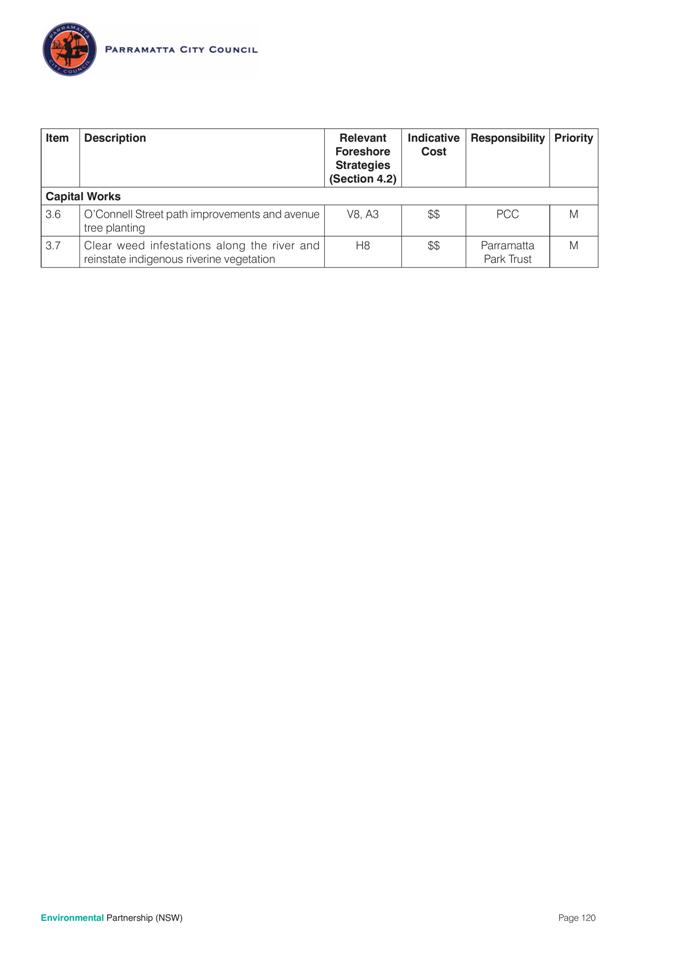
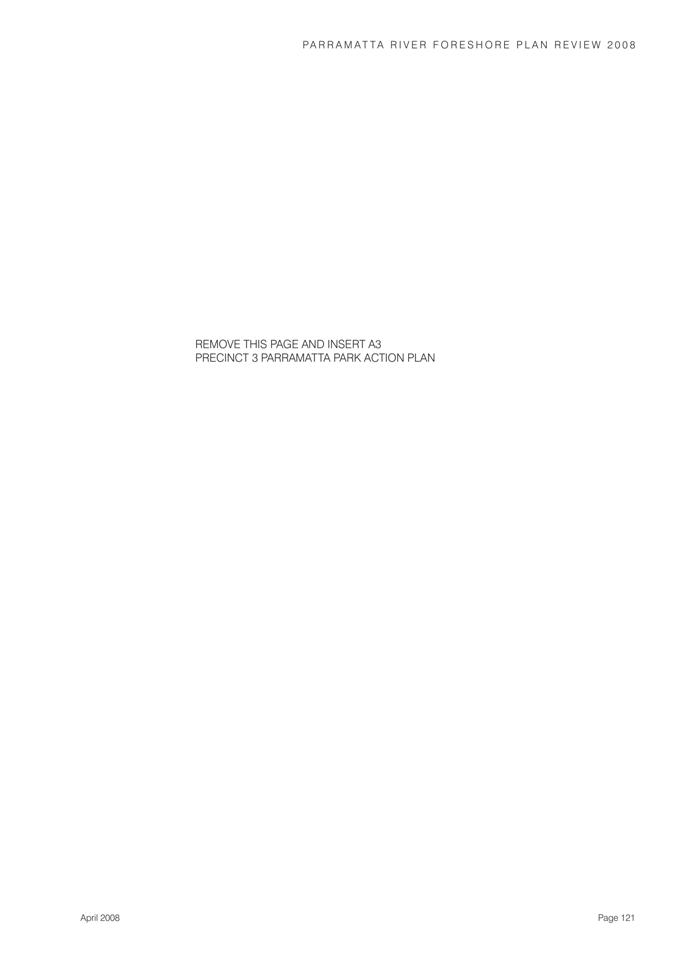

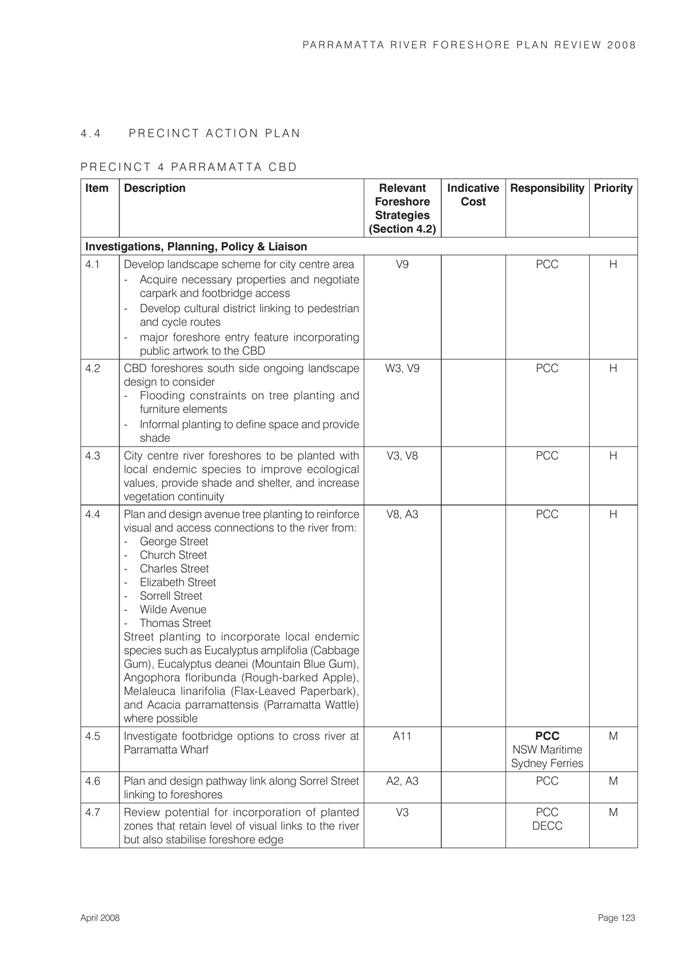
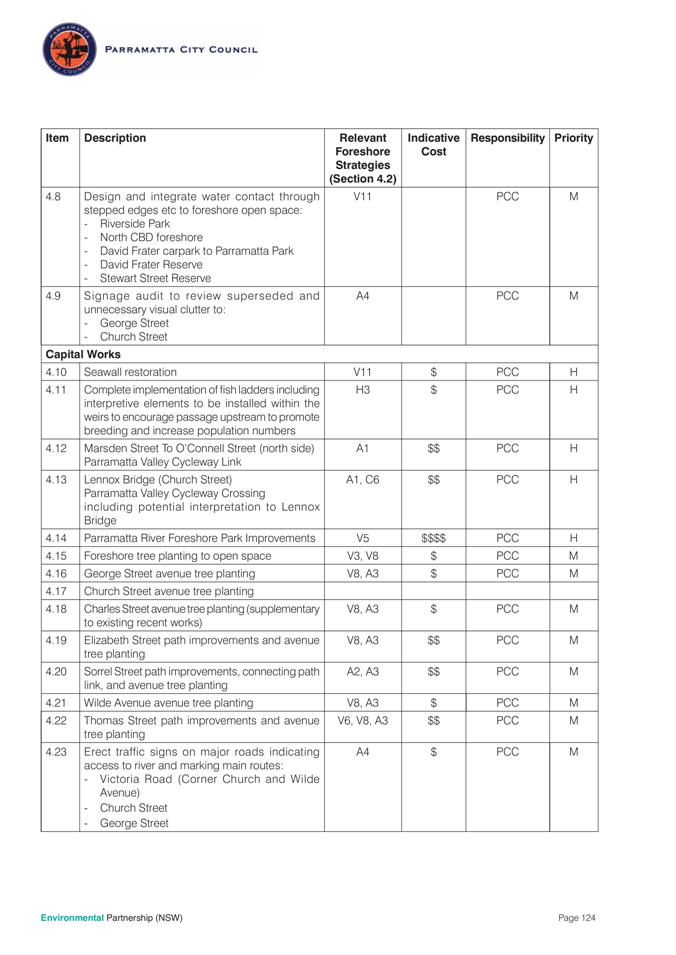
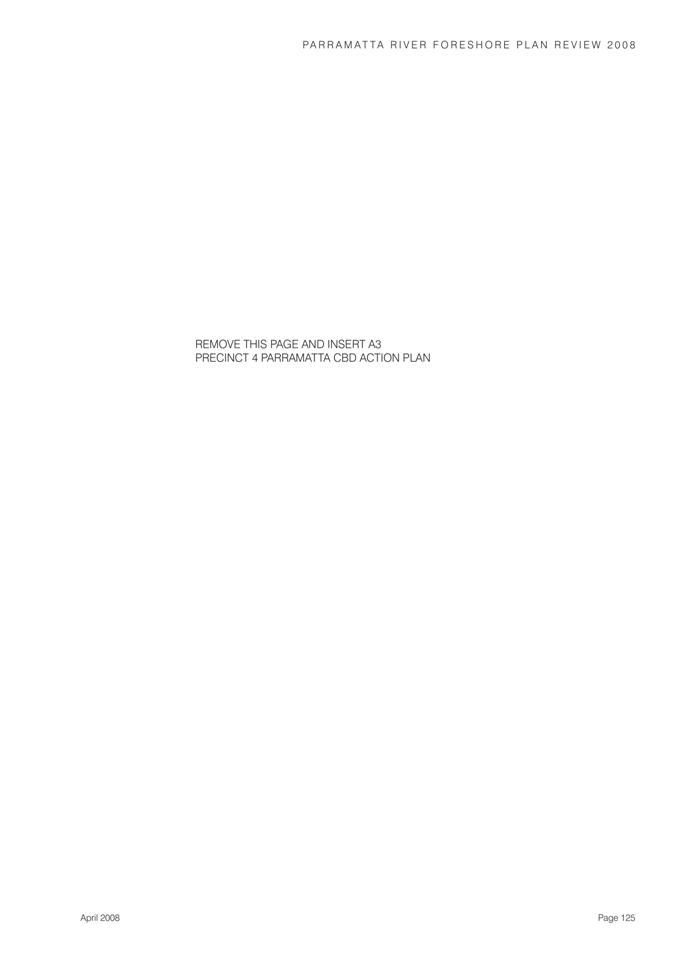

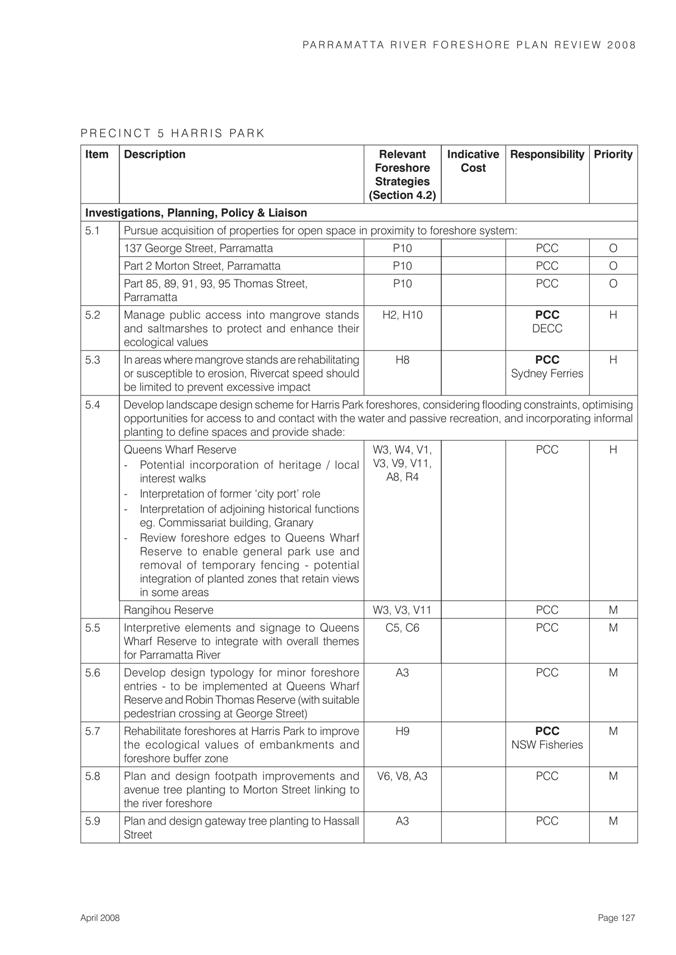
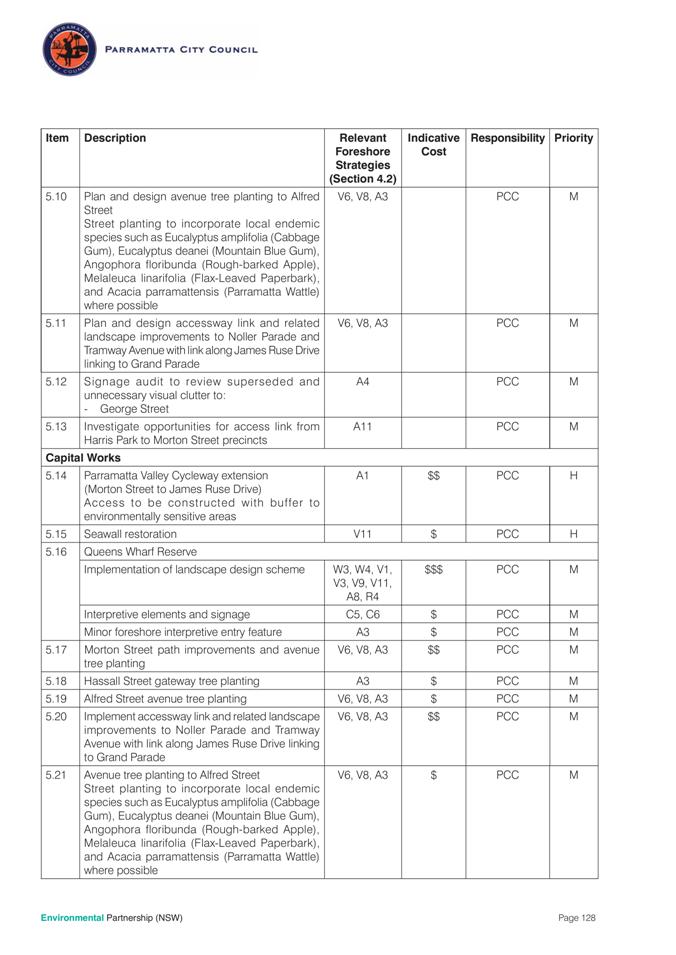
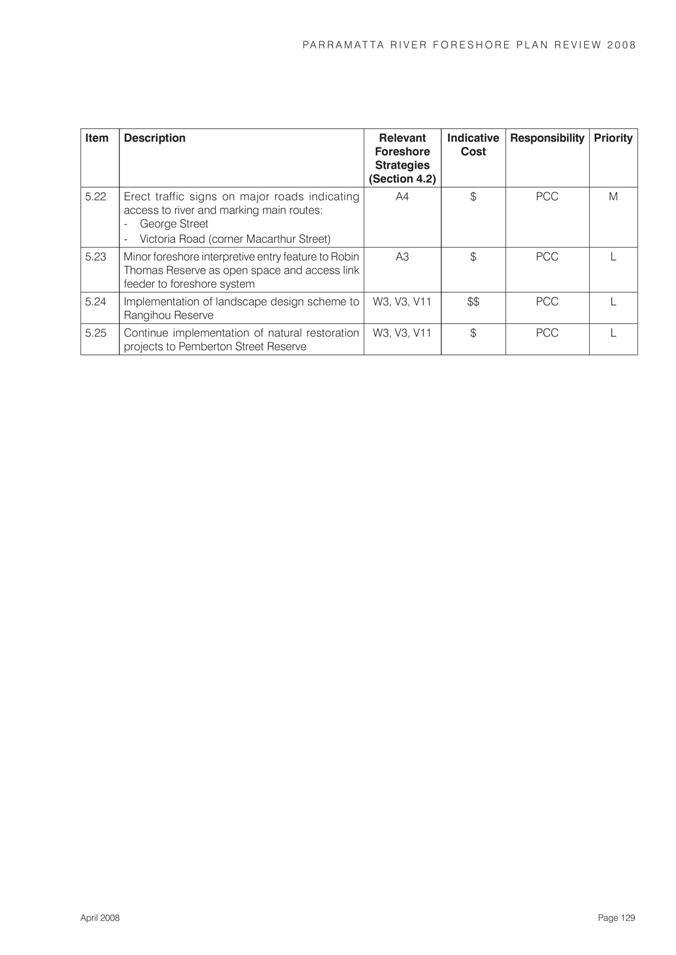

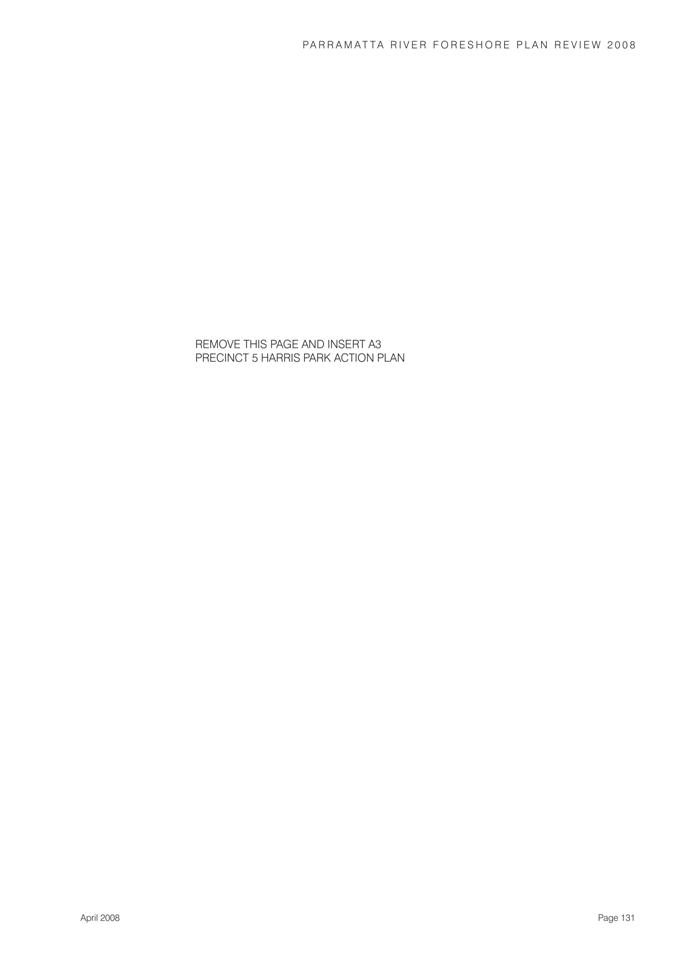

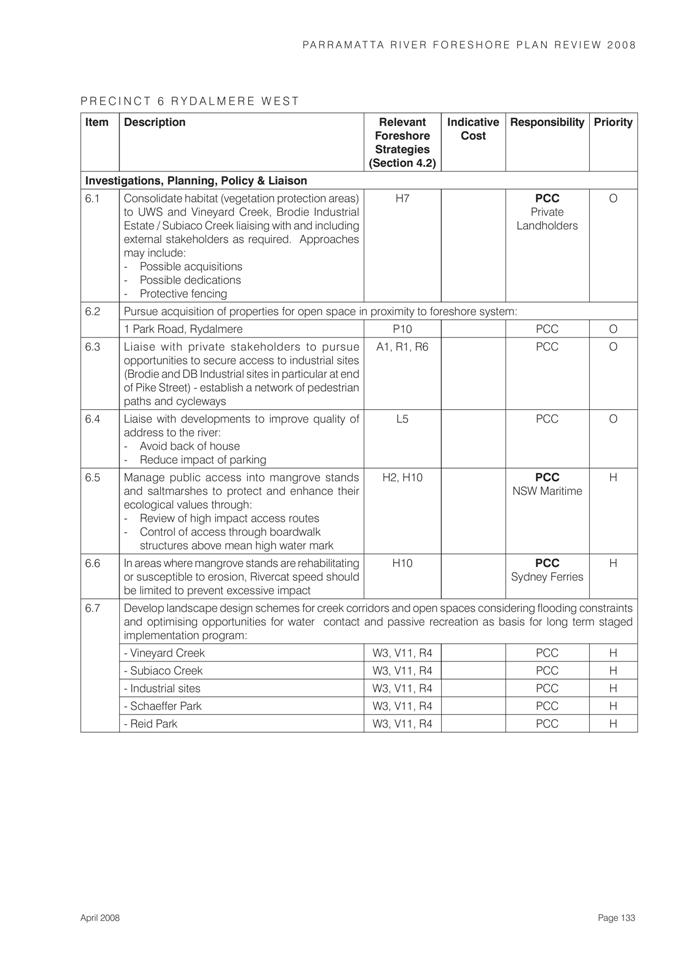
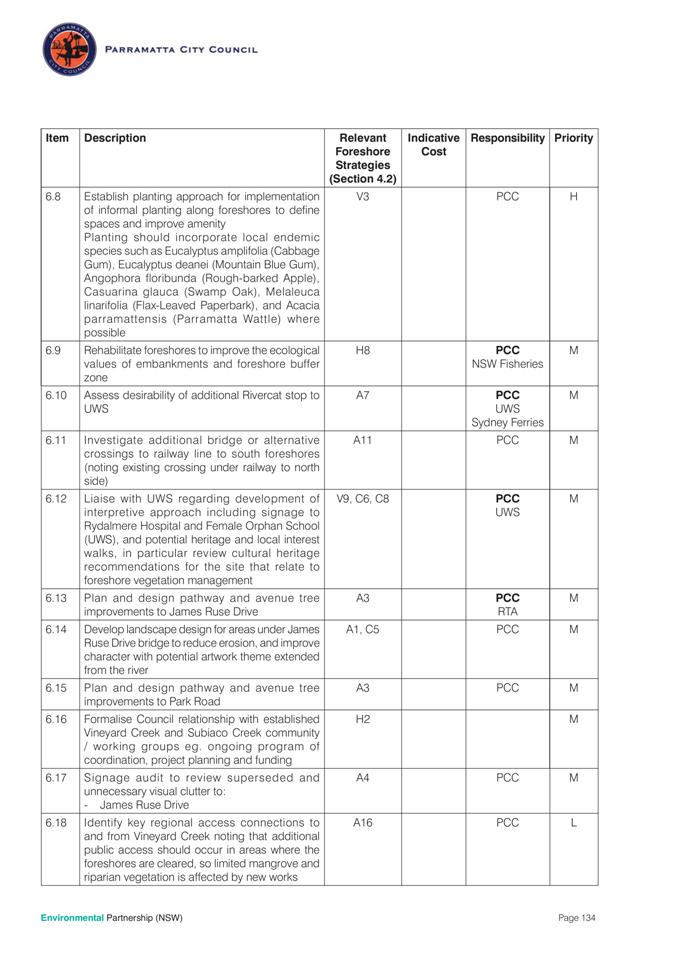
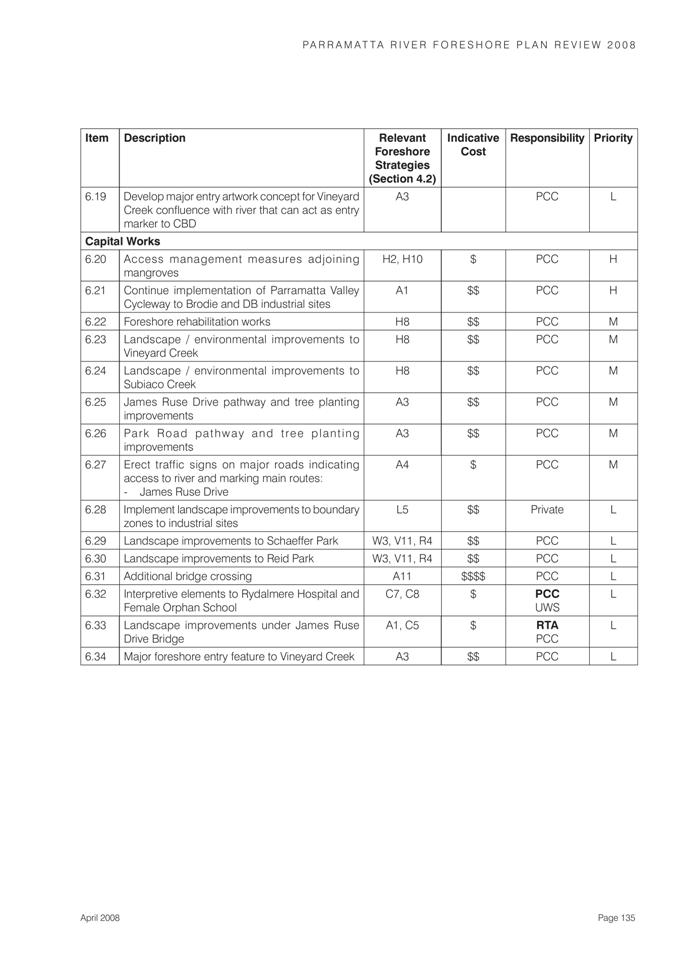

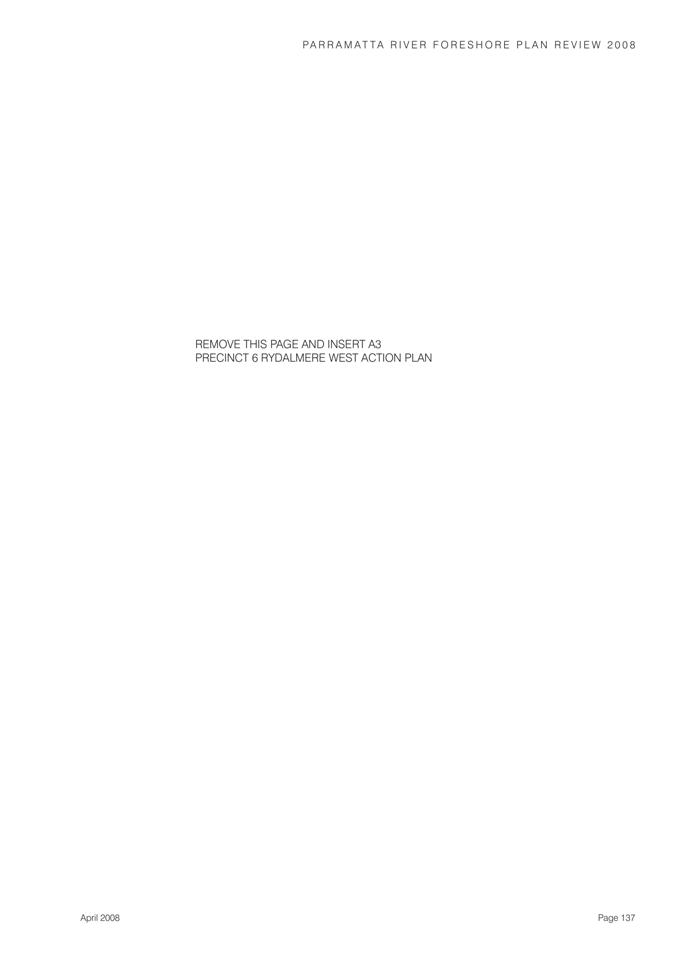

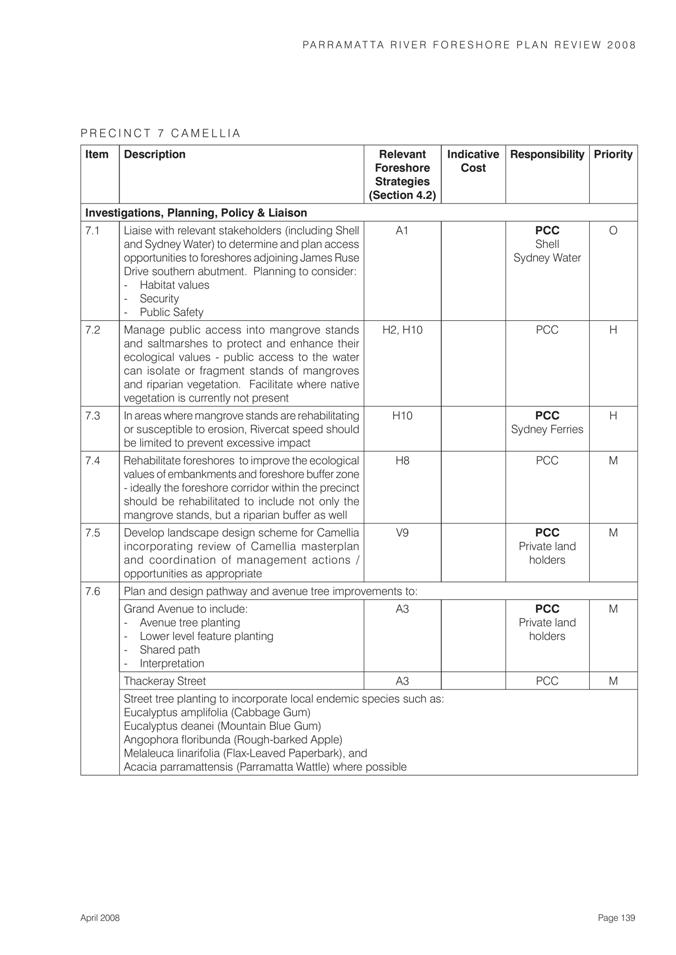
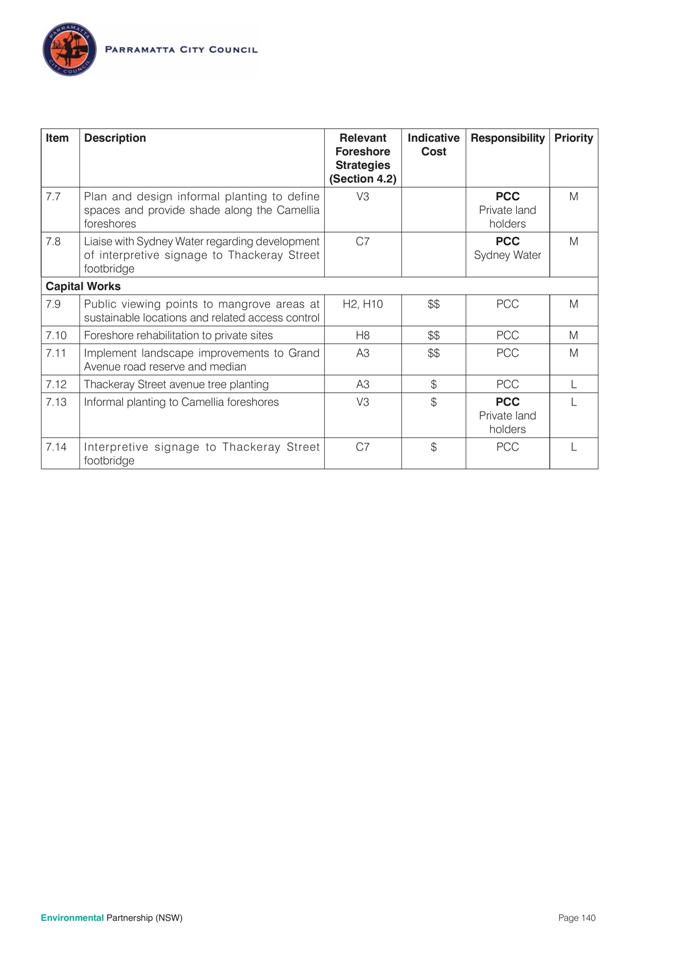
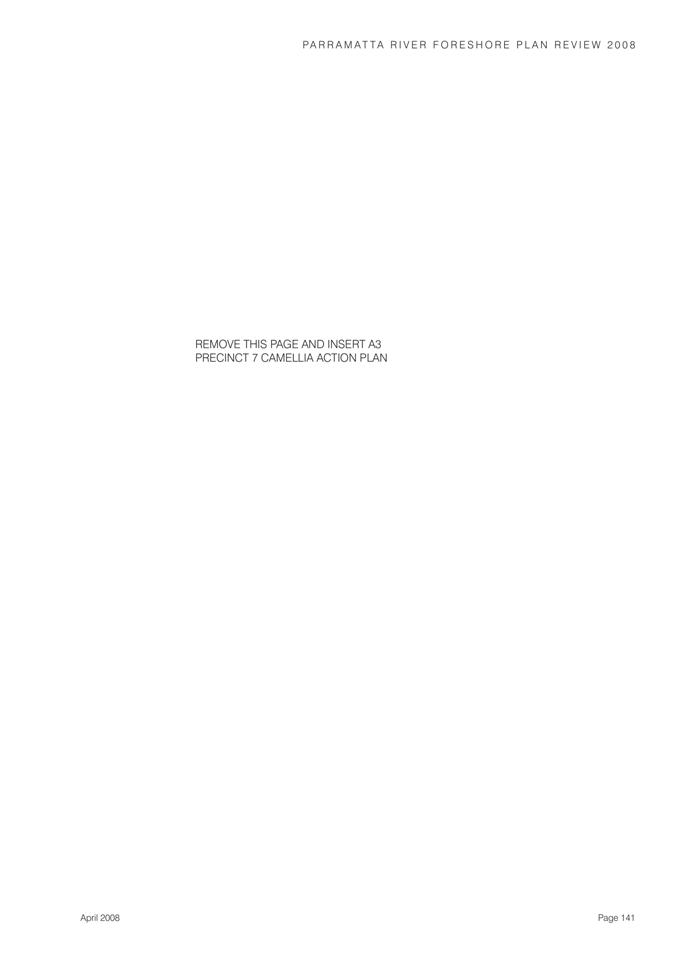

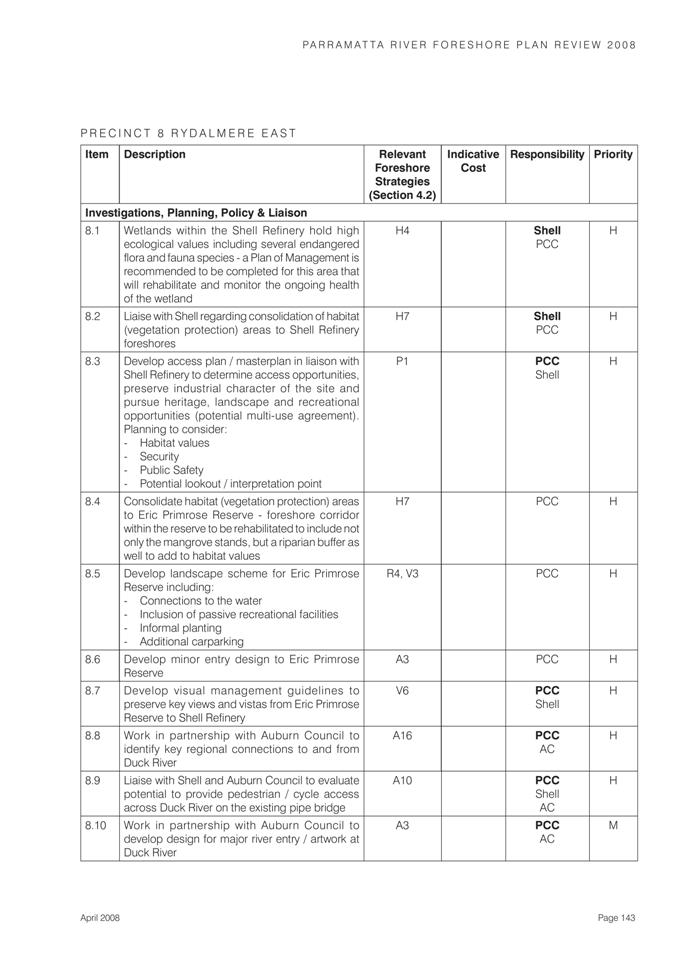
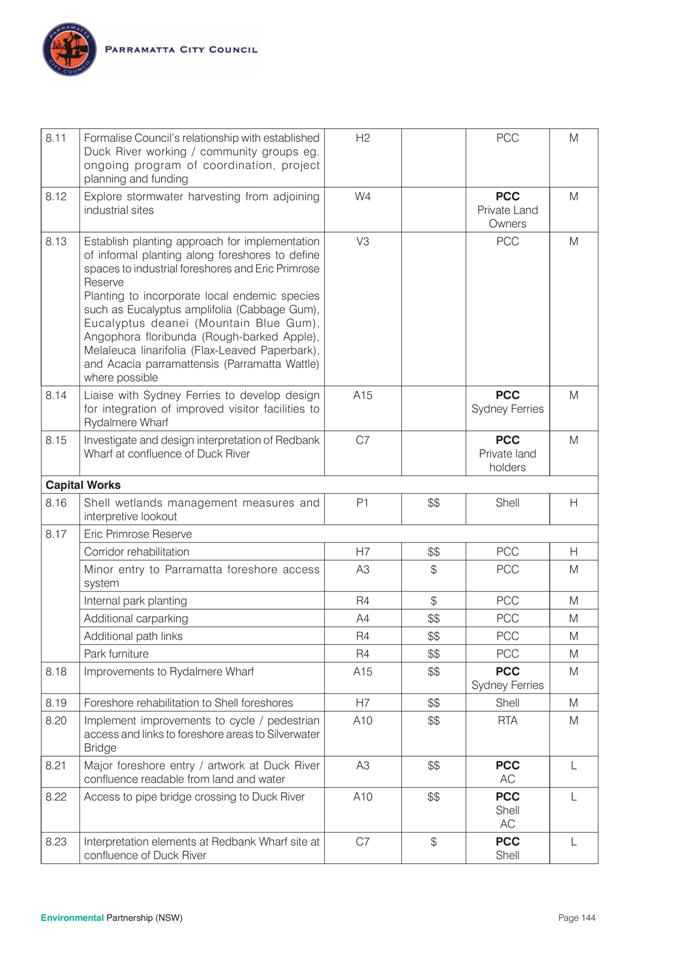
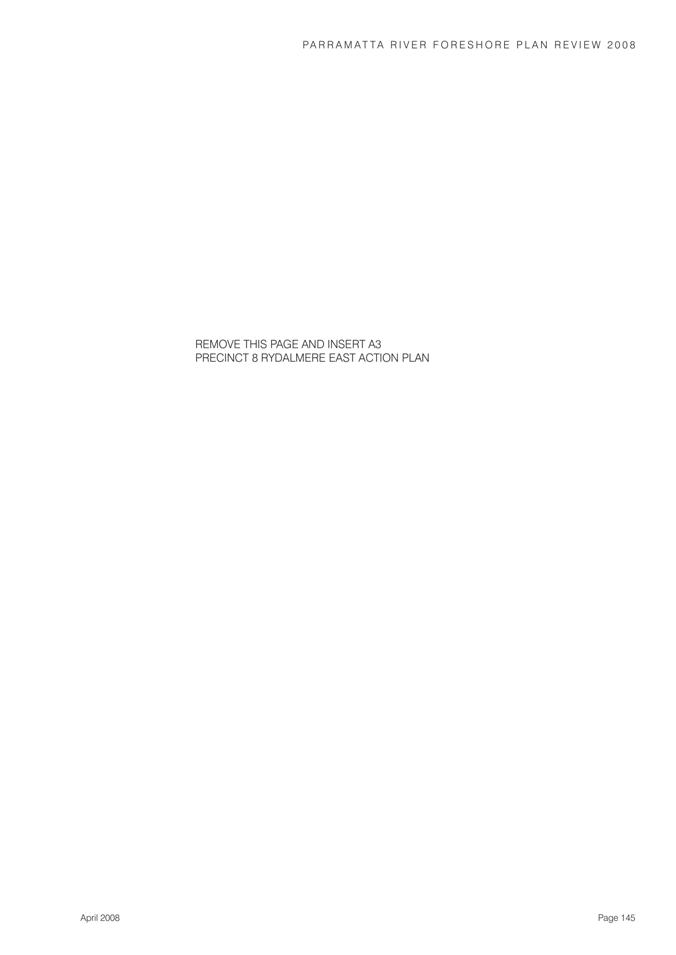


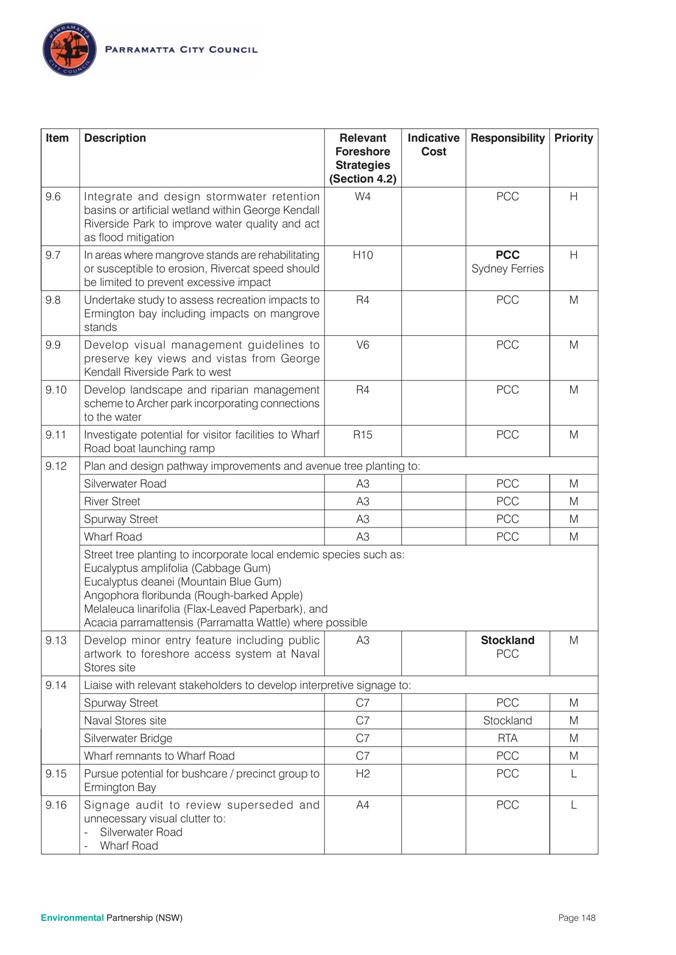
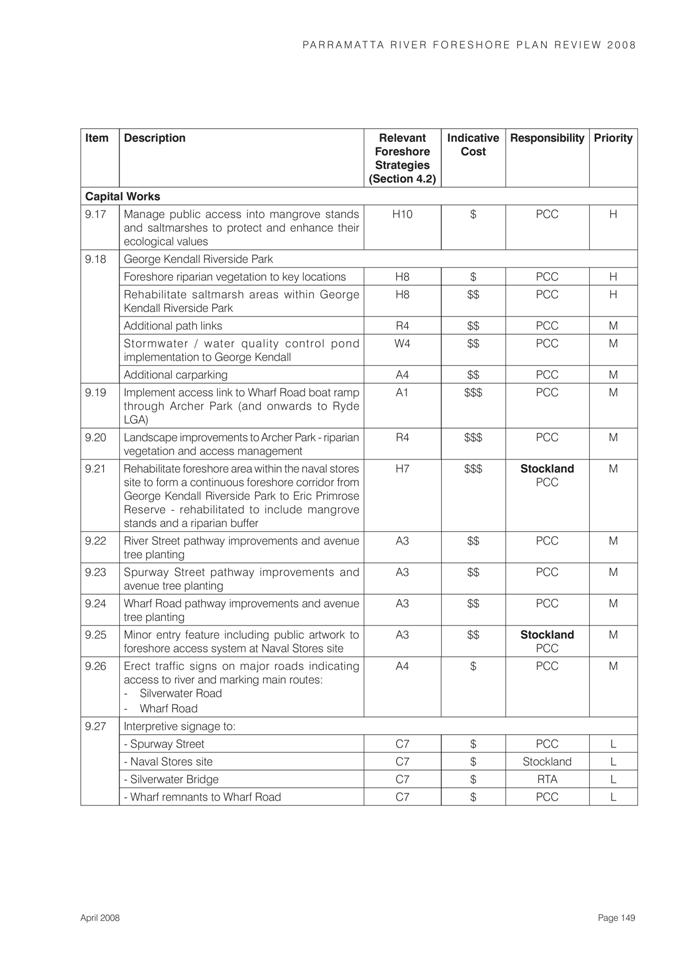

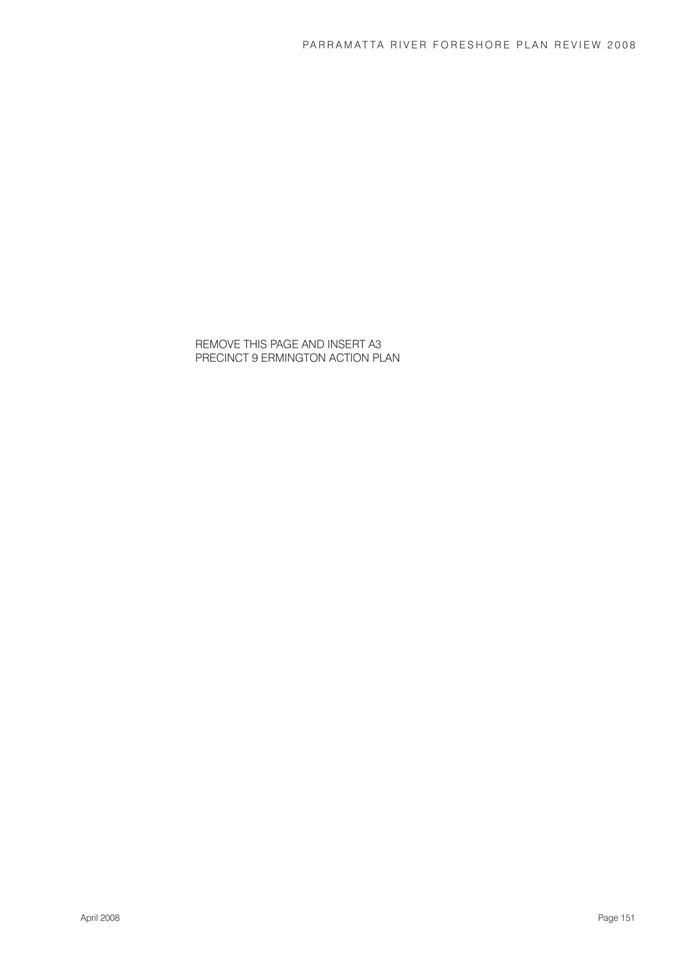

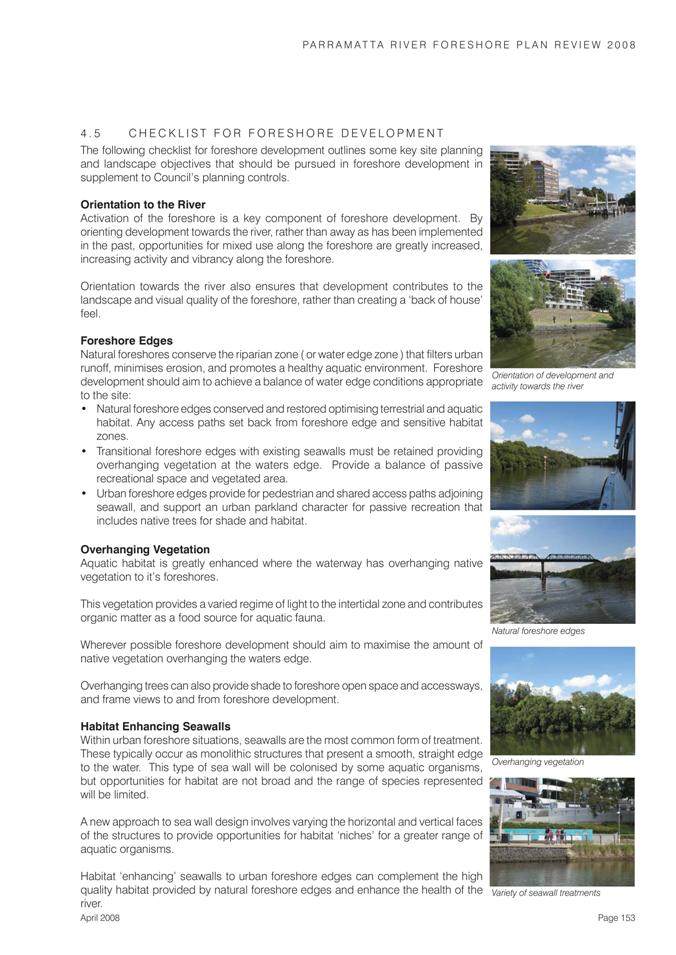
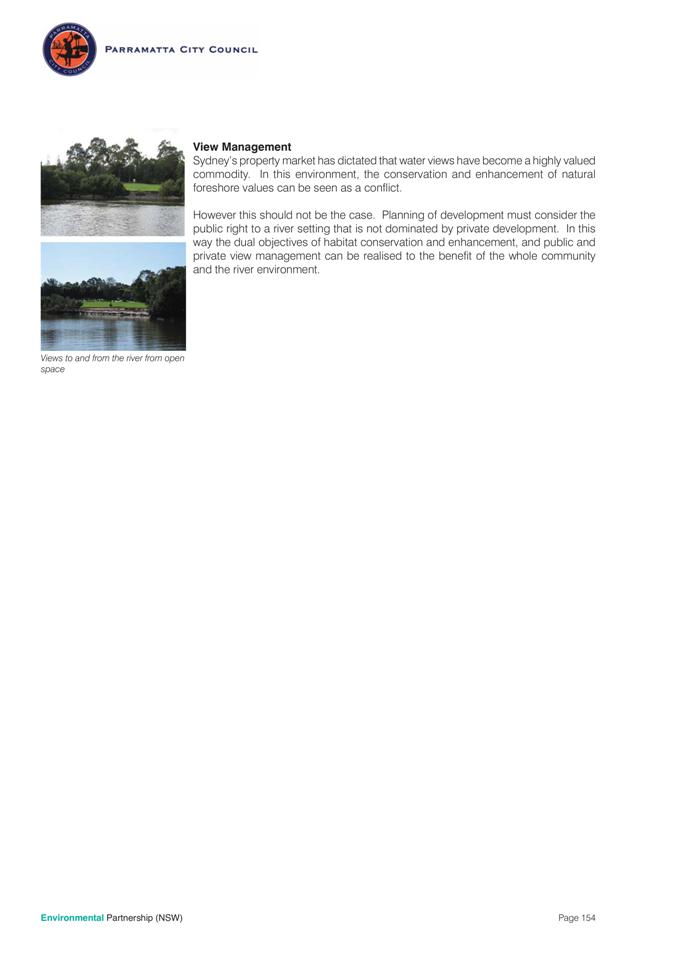
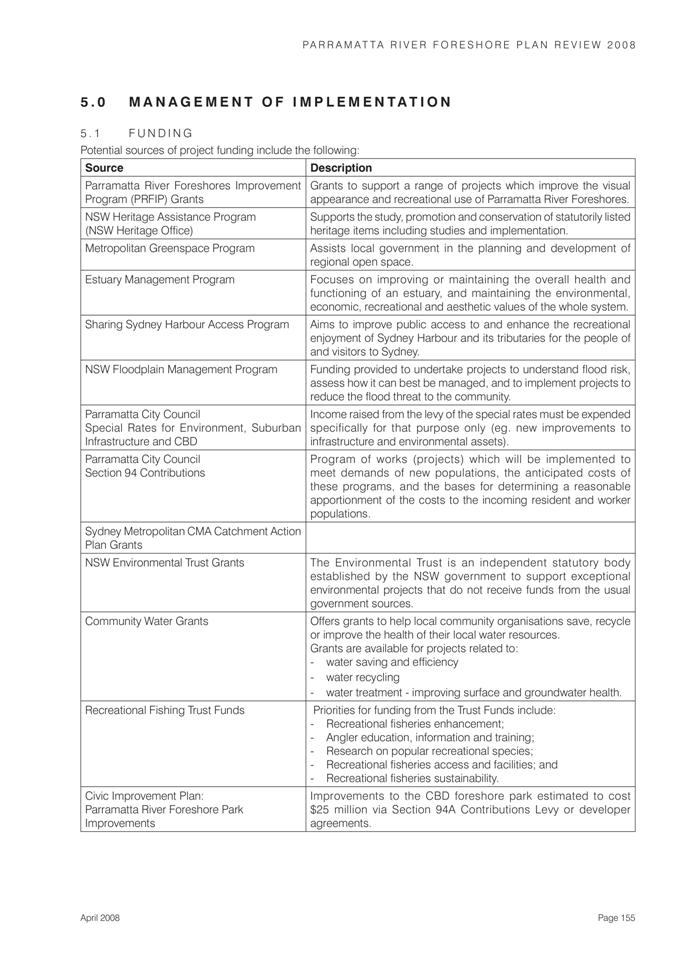
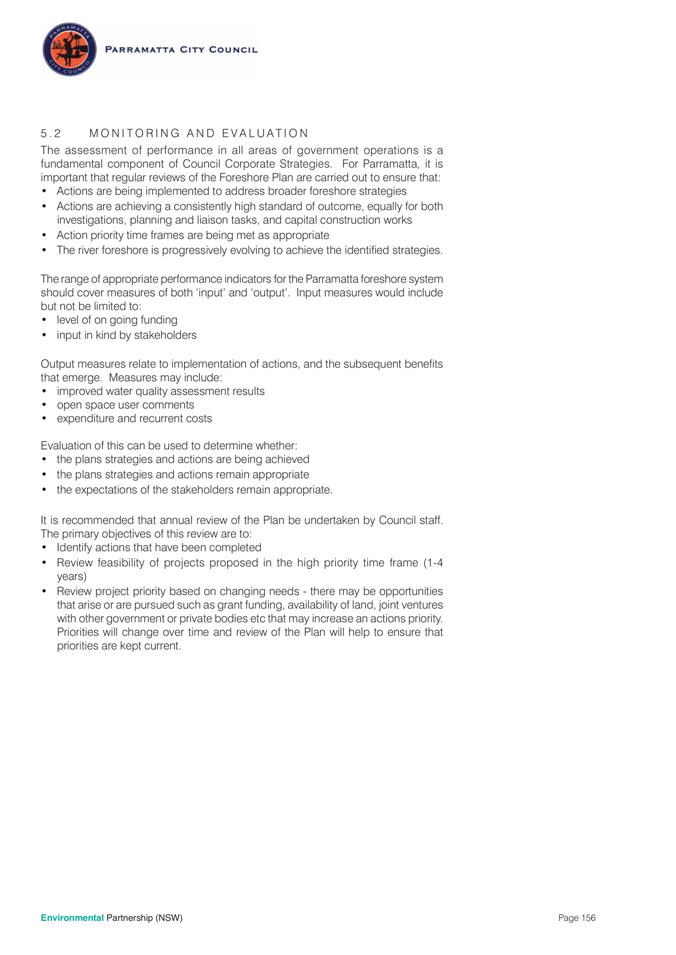
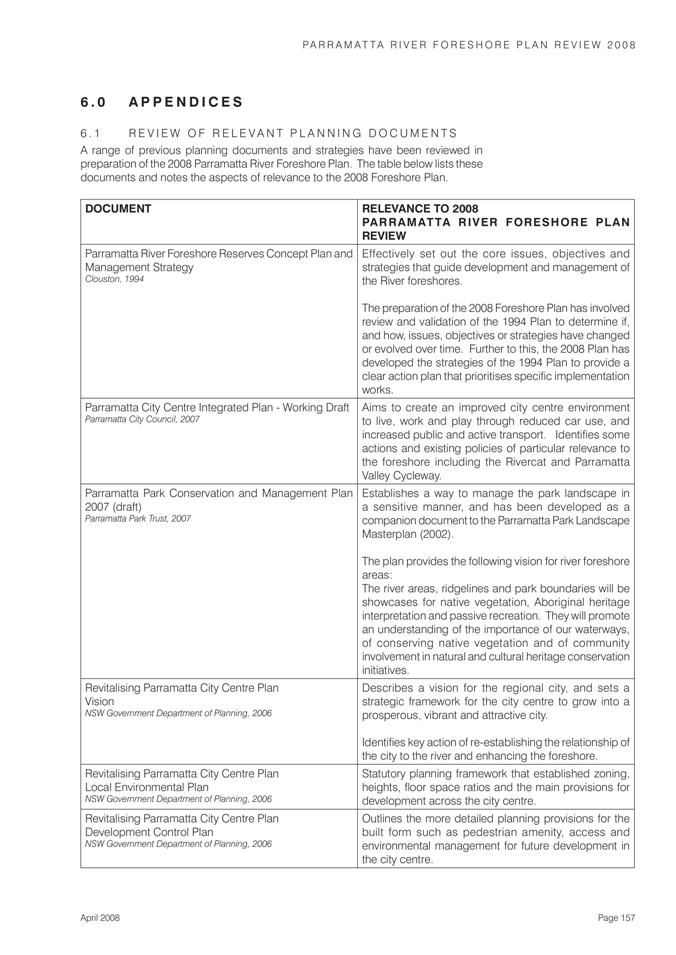
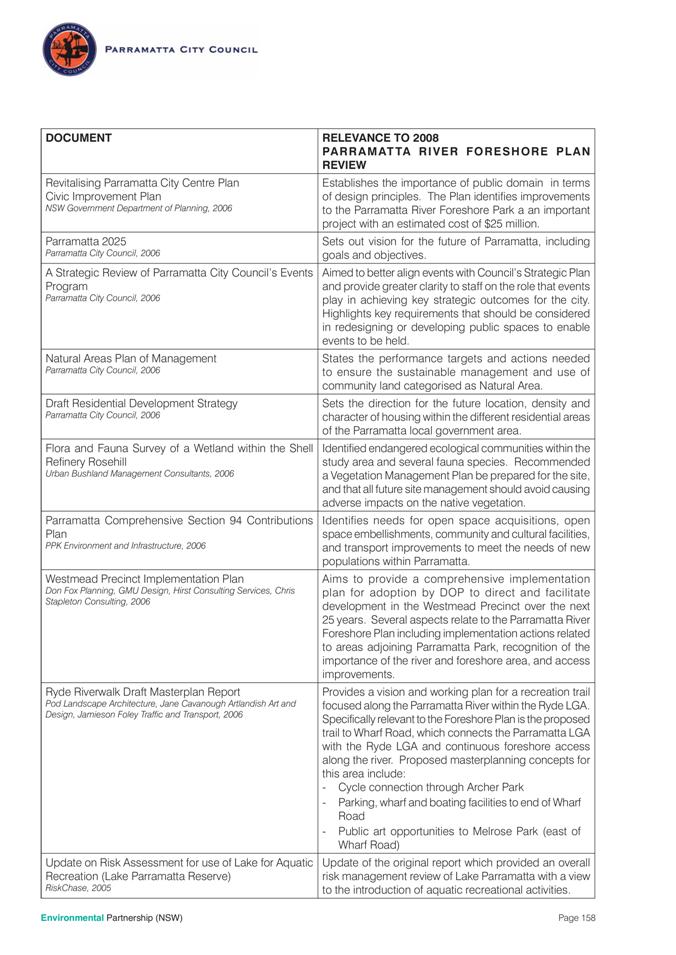
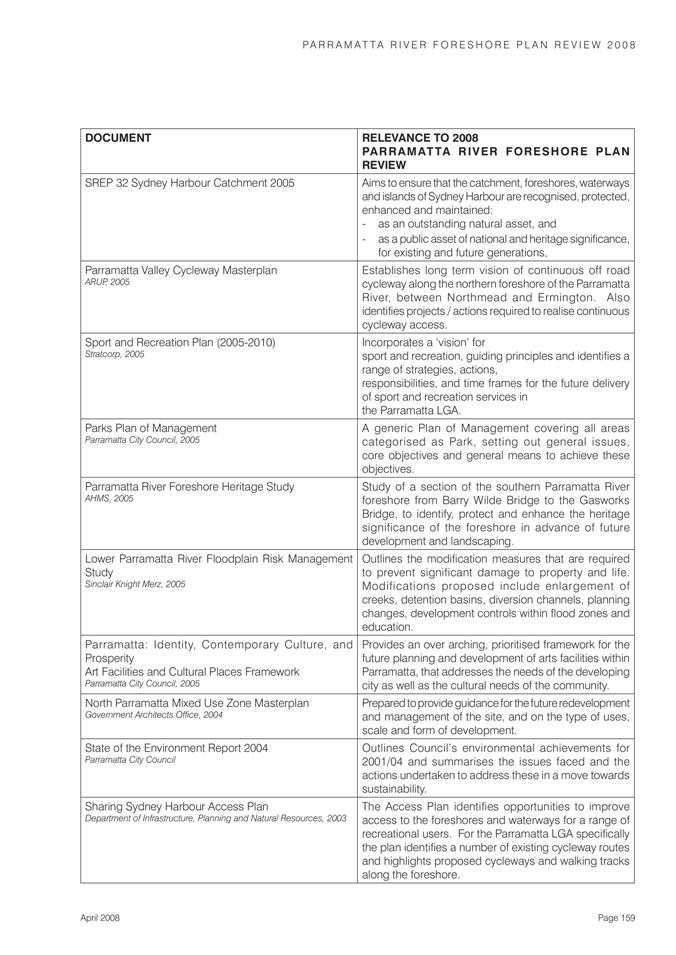
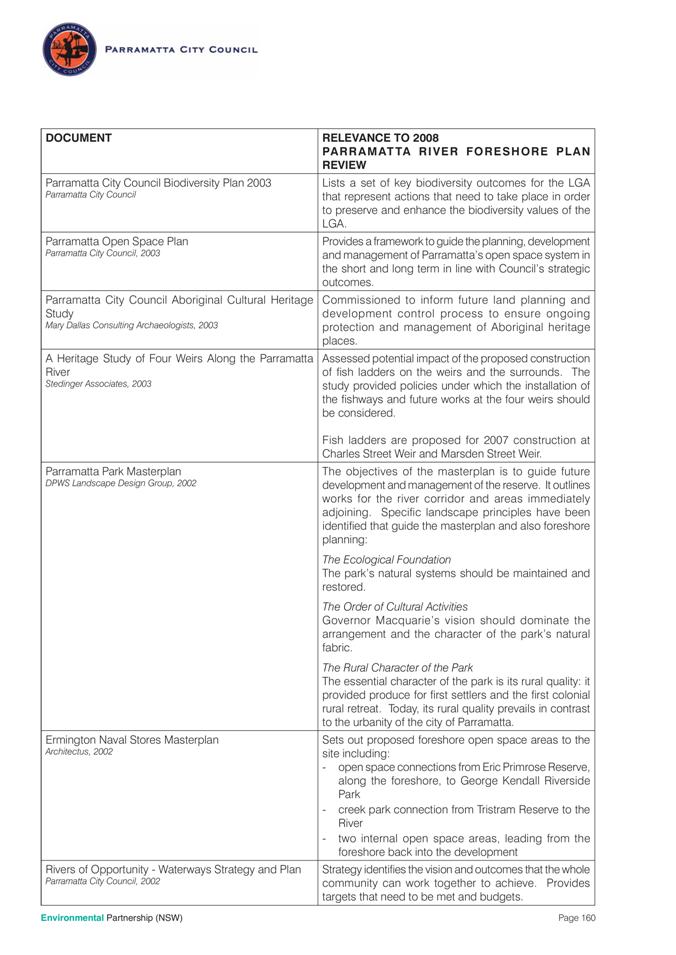
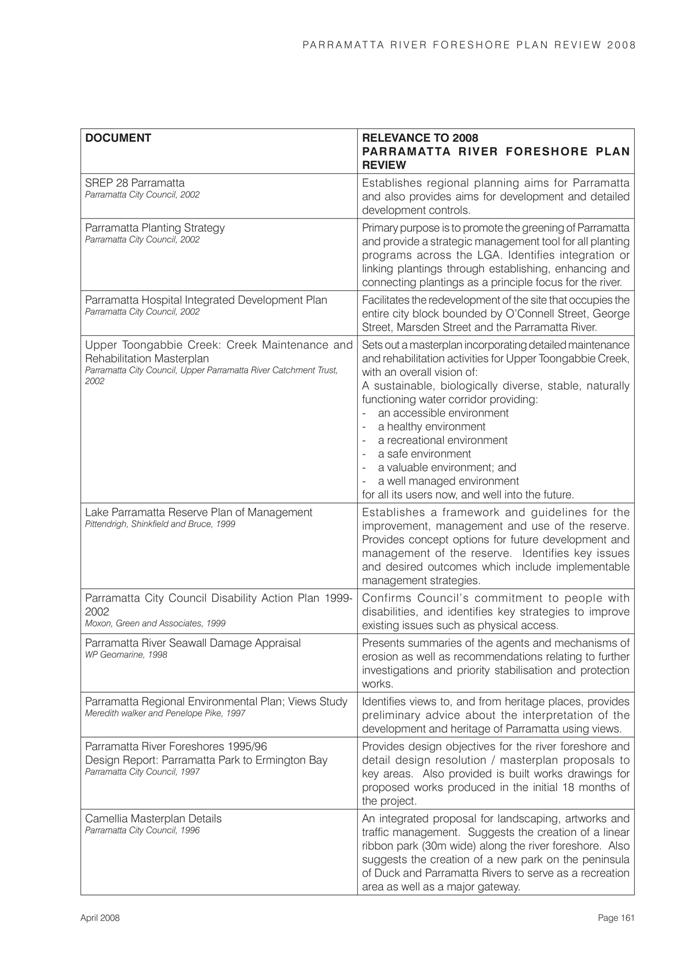
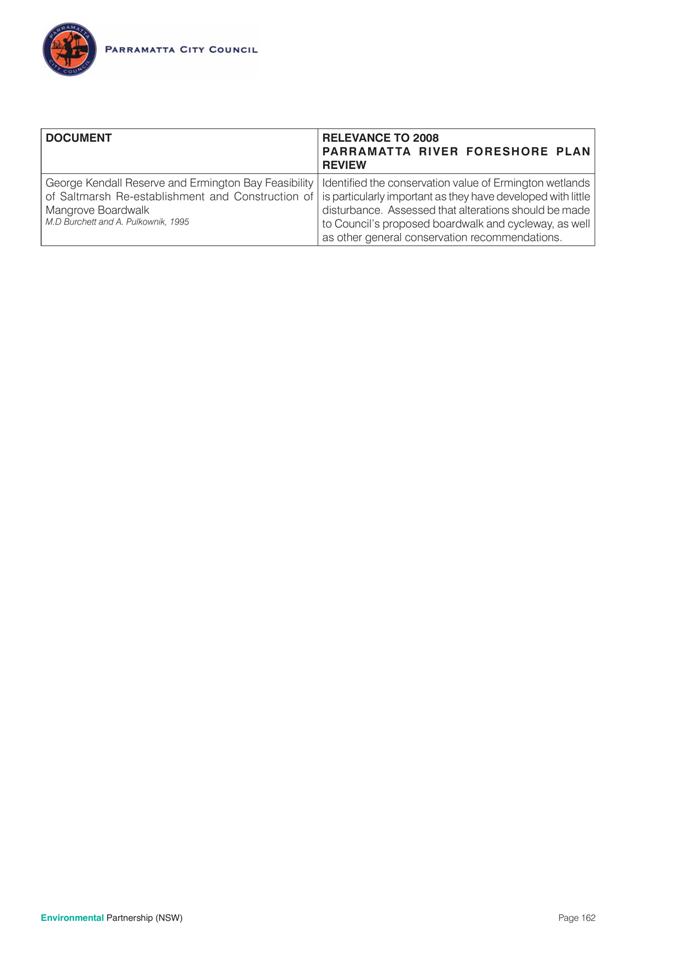
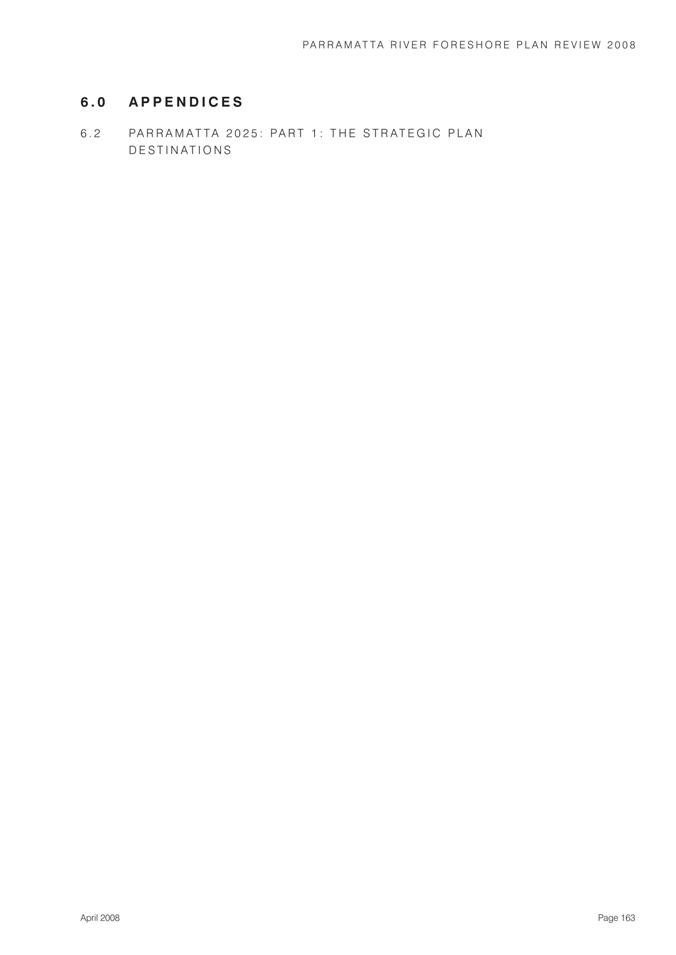



|
Attachment 2
|
Example Precinct Map - Actions
|
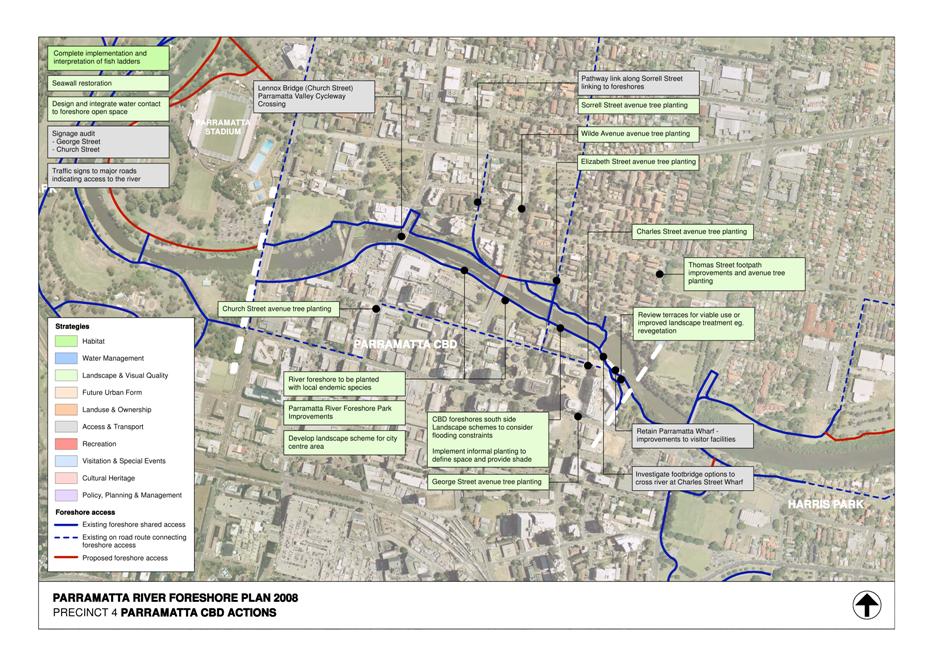
|
Attachment 3
|
Example Precinct Map - Principles
|
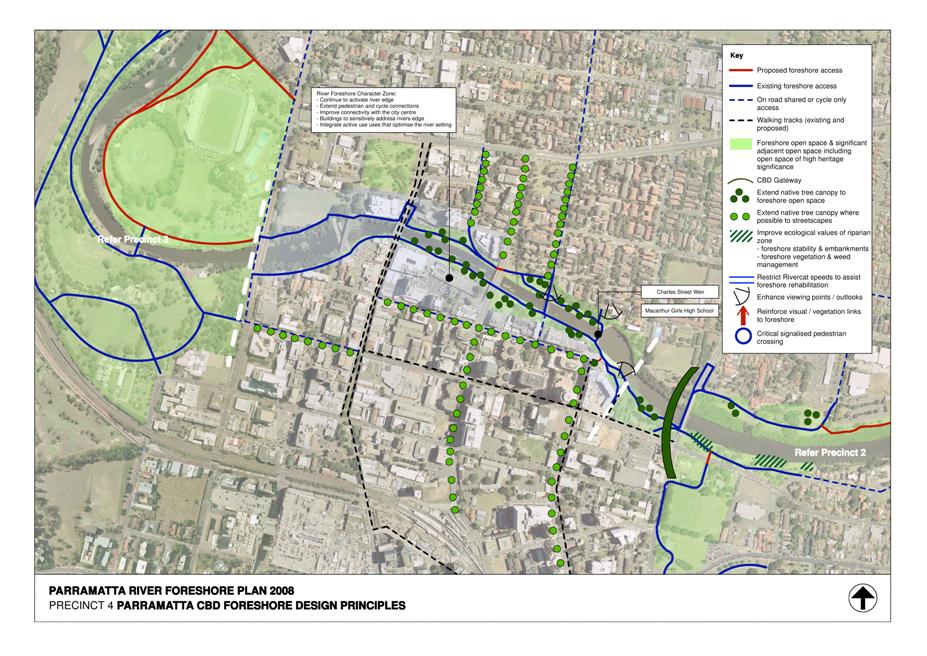
|
Ordinary Council 26 May 2008
|
Item 10.2
|
ITEM NUMBER 10.2
SUBJECT Parramatta
River Catchment Group
REFERENCE F2004/06098 - D00937979
REPORT OF Waterways Systems Manager
|
PURPOSE:
This report seeks
Council’s endorsement of a Memorandum of Understanding, Terms of Reference
and funding commitment to the Parramatta River Catchment Group.
|
|
RECOMMENDATION
(a) That Council endorse the
attached Memorandum of Understanding (MOU) and Terms of Reference for the Parramatta River Catchment Group and
delegate the General Manager to sign the MOU.
(b) That Council endorse a
contribution of $5,000 per year commencing 2008/09, towards the employment of
a part-time Group coordinator and implementation of prioritised initiatives
as determined by the Group. These funds to be sourced from existing budgets
within the Waterways Improvement Program (Rolling Projects).
(c) Further, that the Lord Mayor (or
their nominated representative) and Councillor Maureen Walsh be confirmed as
the Councillor representatives on the committee.
|
BACKGROUND
1. In
2006, Council’s officers made representations to the Sydney Metropolitan
Catchment Management Authority (CMA) requesting their help to form a
cooperative group of councils and NSW Government agencies to improve the health
of the Parramatta River. As a result of this initiative, Bob Junor, the Chairman of the CMA wrote
to the Lord Mayor advising of the formation of the Parramatta River Catchment
Group.
2. The
Parramatta River Catchment Group, comprising of eleven councils within the
catchment (including the Parramatta and Duck Rivers),
has been formed to facilitate a cooperative venture between councils, the CMA
and relevant State government agencies to improve the health of the Parramatta River.
3. The
Parramatta River Catchment Group aims to lead efforts to improve the condition
and ecological function of the Parramatta
River, its tributaries and
catchment lands by improving and coordinating effort in natural resource
management in the Local Government Areas (LGA) of Ashfield, Auburn,
Bankstown, Blacktown,
Burwood, Canada
Bay, Holroyd, Hunter’s Hill, Parramatta,
Ryde and Strathfield.
4. Parramatta
River Catchment Group is a positive step for cooperation between the key
councils and agencies to improving the health of this important River.
ISSUES/OPTIONS/CONSEQUENCES
5. As
a result of several officer meetings to date, the Group has produced an agreed
Memorandum of Understanding (MOU) or regional natural resource management
partnership agreement between Councils and agencies within the Parramatta River
Catchment. A Terms of Reference for the Group was also prepared noting the
aims, composition, structure and role of the committee. Both of these documents
are attached for endorsement.
6. The
Group has a two-tiered structure. The
first tier is comprised of technical officers from the councils and CMA, who
will meet at least twice yearly. Councillors meetings will also be held twice
yearly in the early evening, either in conjunction with or after the officer’s
meetings. At least one officer from each council will also attend these
meetings. If a need is identified by the Catchment Group, special interest
groups shall form a second tier of sub-committees within the Group. These shall
form on an as-needs basis to oversee projects or investigate specific issues.
The Parramatta River Estuary Management Committee has been adopted as a
sub-committee.
7. In
accordance with the Terms of Reference, a Coordinator shall be employed
three days per week from council and agency contributions to coordinate
meetings of the complete Group, actively seek to help members identify issues,
seek funding for regional projects, work as a link between State and Local
Government, and undertake other tasks as identified by the Catchment Group. An
independent Chair shall be engaged to Chair the meetings of the complete Group
to allow meetings to be run without bias.
8. The Sydney
Metro CMA shall accommodate the Coordinator and provide supervision, advice and
support to ensure actions of the PRCG that are consistent with the Catchment
Action Plan (CAP). Any remaining funds are to be spent on items determined by
the PRCG, for example promotional material. Voting rights for major issues,
such as the direction of the PRCG, will be limited to contributing councils and
agencies. A contribution of $5,000 per annum will be sourced from existing
budgets within Council’s Waterways Improvement Program (Rolling Projects).
CONSULTATION & TIMING
9. The
attached MOU and Terms of Reference have been prepared by council officers and
agency staff. Officers of all 11 councils have supported the Group initiative
and funding commitment in principle. Following Council endorsement, the
documents will be collectively signed-off by General Managers of all eleven
councils and nominated key agencies. Employment of the coordinator and
independent chair will commence in the 2008/09 financial year through the agreed
funding contributions.
Anthony Collins
Waterways Systems Manager
City Strategy Unit
Attachments:
|
1View
|
Memorandum of Understanding
|
6 Pages
|
|
|
2View
|
Terms of Reference
|
3 Pages
|
|
REFERENCE MATERIAL
|
Attachment 1
|
Memorandum of Understanding
|
Memorandum of Understanding
Regional
NRM Partnership Agreement
between the
Councils and agencies within the Parramatta River Catchment Group
2008
1. BACKGROUND
The Parramatta River
Catchment Group (PRCG) has evolved from:
· The Duck River Steering Committee (Auburn, Bankstown, Holroyd and Parramatta Councils).
· The Upper Parramatta
River Catchment and Waterways Management Task Force (Baulkham Hills, Blacktown,
Holroyd and Parramatta Councils, Parramatta Park Trust, Sydney Water,
Department of Environment and Conservation, Upper Parramatta River Catchment
Trust and the Roads and Traffic Authority).
· The Lower Parramatta
River Group (Ashfield, Burwood,
Canada
Bay, Hunter’s Hill, Leichhardt, Ryde and Marrickville Councils).
Many natural
resource management (NRM) issues exist across the catchment or across a region
and therefore working solely within Local Government boundaries will have
limited achievements. A collaborative approach between councils and the
relevant government agencies is essential to ensure the holistic management of NRM
issues. For example: biodiversity corridors need to allow for movement of
species into and beyond local government areas, particularly with climate
change implications; weed species need to be managed in adjoining and
upstream/downstream council areas; water quality needs to be managed for
receiving waters and downstream areas.
Working together on
catchment-wide or regional NRM issues has a synergistic effect, allowing for
cost-efficiencies, pooling of resources such as staff time and technical expertise,
providing a stronger collective voice, providing a stronger basis for grant
applications, allowing closer links with agencies, opening up additional
opportunities such as research outcomes, and contributing to local council and
agency obligations to achieve state-wide targets for NRM as outlined in the
State Plan.
2. MEMBERS
2.1 Member Councils: Ashfield Council, Auburn City Council, Bankstown
City Council, Blacktown City Council, Burwood Council, City of Canada Bay
Council, Holroyd City Council, Hunter’s Hill Council, Parramatta City Council,
Ryde City Council and Strathfield Municipal Council.
2.2 Member Agencies: Sydney Metropolitan Catchment Management Authority
(SMCMA), Sydney Water (SW), Department of Environment and Climate Change
(DECC), NSW Maritime, Sydney Olympic Park Authority (SOPA), Department of Water
and Energy (DWE), Parramatta Park Trust (PPT), NSW Department of Primary
Industries (DPI), Western Sydney Regional Organisation of Councils (WSROC),
Sydney Ferries, NSW Fire Brigade and others, on an as needs basis, as
identified by the Catchment Group.
3. GENERAL PRINCIPLES
3.1 The PRCG wish to coordinate
and improve Natural Resource Management in the catchment through a formal
agreement in accordance with this MoU.
3.2 This MoU has been developed
under the PRCG's Terms of Reference (2008). It is consistent with the Aims of
the PRCG outlined in its Terms of Reference.
3.3 This Memorandum of
Understanding (MoU) sets out specific working arrangements between the council
members and agencies concerning coordination, sharing of information,
investment in NRM, and the partnership arrangements.
3.4 The MoU acknowledges the
substantial investment in NRM by Councils, agencies and the SMCMA, and their
willingness to work together to achieve sustainable outcomes for a healthy and
diverse catchment and river system.
3.5 The MoU also acknowledges
that sustainable outcomes in NRM can be achieved through a collaborative
process to attain strategic management targets identified in Councils’ and
agencies’ Strategic NRM plans and the SMCMA’s Catchment Action Plan (CAP).
3.6 This MoU will not prevent the
members from fulfilling their core functions.
4. INTENT
This MoU forms the
principal working agreement between PRCG members to:
4.1. Establish a partnership based
on cooperation and value-adding between members.
4.2. Build on the commitment and
understanding of each other’s values, priorities and capabilities to deliver
mutual outcomes.
4.3. Coordinate and facilitate
catchment management planning and implementation outcomes within the
constraints of each other’s operating environments including budget.
4.4. Explain the capabilities and
operations of the partnership.
4.5. Develop an inclusive process
to deal with all member NRM and CAP issues.
4.6. Identify within the PRCG
Implementation Plan the key NRM actions for the PRCG and what each organisation
will deliver.
5. THE AGREEMENT
5.1 The PRCG members agree to:
a. Fulfil
the PRCG’s role as stipulated in its Terms of Reference (2008).
b. Respect
the independence, statutory responsibilities and reputation of the other
parties.
c. Agree
to meet at least twice per year to discuss and provide advice on how to resolve
NRM issues raised by members.
d. Appoint
a nominated Councillor/General Manager or Board member or Senior Agency
Officer, as relevant, and technical officer to attend PRCG meetings.
e. Allocate
other technical staff and/or elected representatives and the resources required
to participate and work in a collaborative process on the PRCG and other
sub-committees as required.
f. Recognise
that officers will be required to prepare for Catchment Group meetings and
sub-committee meetings and follow-up with work and projects out of meetings.
g. Provide
copies of reports, protocols, collated data, GIS layers and other NRM material
that is considered to be relevant to the PRCG to allow for the collective
benefit of this information.
h. Recognise
that each member council or agency has knowledge, technical skills and
experience that may assist decision-making and execution of actions by the
PRCG, and shall therefore strive to share such knowledge and skills.
i. Provide
advice on their role in catchment management, communicate their objectives, and
update the PRCG on the delivery of management actions at PRCG meetings.
j. Refer
issues that require PRCG input, or response, to the Coordinator as soon as
practical. The Coordinator will circulate as necessary.
k. Respond
in a timely manner to requests from the Coordinator or Chair or on behalf of
the Coordinator or Chair.
l. Make
available council/agency reports that document the annual allocation of
resources to NRM actions and outline how these address State targets and
targets within the CAP. This includes funds from environmental special rates and
charges.
m. Recognise
that Councils and the SMCMA have statutory reporting responsibilities (State of
Environment,
catchment targets and state-wide targets) that may be modified over time.
Councils and the SMCMA commit to aligning monitoring and reporting programs
over time to reduce any duplication of effort.
5.2 The SMCMA agrees to:
a. Provide
advice as to the management priorities and actions that need to be implemented
on a catchment and regional basis within the CAP framework.
b. Advance
the PRCG’s knowledge and understanding of the SMCMA’s core functions, role and
responsibilities under the Act within the context of State statutes relating to
environmental management in the PRCG area.
c. Assist
where appropriate with contacts, networks and training.
d. Provide
advice and assistance on regional grant applications that are consistent with
the CAP.
e. Provide
technical advice where possible on projects that are consistent with the CAP.
f. Consider
PRCG actions and projects for inclusion in investment strategies, in
consultation with PRCG members.
g. Provide
supervision, advice and support to the Coordinator of the PRCG.
6. REVIEW AND TERMINATION
6.1 This MoU will be reviewed
with each new term of council by the members of the PRCG to ensure that the
conditions outlined in this document are relevant and applicable.
6.2 This MoU is not a legally
binding document and may be terminated provided one month's written notice is
given to the representatives involved.
|
Signed:_______________________
General Manager
Ashfield Council
Dated:_______________
|
|
Signed:______________________General Manager
Auburn City Council
Dated:______________
|
|
Signed:_______________________General Manager
Bankstown City Council
Dated:______________
|
|
Signed:______________________
General Manager
Blacktown City Council
Dated:_______________
|
|
Signed:______________________GGeneral Manager
Burwood Council
Dated:_______________
|
|
Signed:______________________
General Manager
City of Canada Bay Council
Dated:_______________
|
|
Signed:______________________GGeneral Manager
Holroyd City Council
Dated:_______________
|
|
Signed:______________________General Manager
Hunter’s Hill Council
Dated:______________
|
|
Signed:_______________________General Manager
Parramatta City Council
Dated:_______________
|
|
Signed:______________________General Manager
City of Ryde Council
Dated:______________
|
|
Signed:______________________
General Manager
Strathfield Municipal Council
Dated:______________
|
|
Signed:______________________
General Manager
Sydney Metropolitan Catchment Management Authority
Dated:______________
|
|
Signed:______________________
Sydney Olympic Park Authority
Dated:______________
|
|
Signed:______________________
Sydney Water
Dated:______________
|
|
Signed:______________________
NSW Maritime
Dated:______________
|
|
Signed:______________________
Department of Environment and Climate Change
Dated:______________
|
|
Signed:______________________
Parramatta Park Trust
Dated:______________
|
|
|
|
Other agencies as
appropriate
|
|
|
|
Attachment 2
|
Terms of Reference
|
PARRAMATTA
RIVER CATCHMENT GROUP
Terms
of Reference
2008
Aims of the Parramatta River
Catchment Group
The Parramatta River Catchment Group aims to lead
efforts to improve the condition and ecological function of the Parramatta River, its tributaries and
catchment lands by improving and coordinating effort in natural resource
management in the Local Government Areas (LGA) of Ashfield, Auburn, Bankstown, Blacktown, Burwood, Canada Bay, Holroyd, Hunter’s
Hill, Parramatta, Ryde and Strathfield.
Area of Interest of the
Parramatta River Catchment Group
The Group’s area of
interest shall be the Parramatta River Catchment from Blacktown
in the west; to the confluence of the Lane
Cove
River
in the east. It shall include the Parramatta
River,
all its tributaries and catchment lands.
Parramatta River Catchment Group
Composition
The Parramatta River
Catchment Group shall be made up of representatives from the following
categories:
· Council
Staff Representatives
Staff representatives shall
be nominated by each of the eleven catchment councils: Ashfield Council, Auburn
City Council, Bankstown City Council, Blacktown City Council, Burwood Council,
City of Canada Bay Council, Holroyd City Council,
Hunter’s Hill Council, Parramatta City Council, Ryde City Council and
Strathfield Municipal Council.
· Council Elected Representatives
One
Councillor from each of the above Councils shall be nominated to the Catchment
Group. The elected representative shall preferably be the Mayor or the Deputy
Mayor. Councillors will be asked to represent the interests of the Catchment
Group in Council meetings.
· Agency Representatives
Representative(s)
from the following Agencies shall be nominated to attend meetings and/or
receive minutes of the meetings: Sydney Metropolitan Catchment Management
Authority (SMCMA), Sydney Water (SW), Department of Environment and Climate
Change (DECC), NSW Maritime, Sydney Olympic Park Authority (SOPA), Department
of Water and Energy (DWE), Parramatta Park Trust (PPT), NSW Department of
Primary Industries (DPI), Western Sydney Regional Organisation of Councils
(WSROC), Sydney Ferries, NSW Fire Brigade and others, on an as needs basis, as
identified by the Catchment Group.
Council and agency staff
shall be able to speak for the whole-of-council/agency, and be at a level
within the organisation, to either make decisions in relation to Group
outcomes, or have ease of access to senior management. Depending on the issues
to be addressed by the Catchment Group, additional Council and Agency staff,
with areas of expertise specific to identified issues, may be requested to
attend meetings.
· Community Representatives
Community representatives
shall be invited from the community and environmental groups, including
Non-Government Organisations (NGOs) active in the catchment for sub-committees
on an as-needs basis. It is recognised that Councillors also represent the
community.
Community members shall
actively participate and liaise between relevant stakeholder groups,
participate in relevant projects and share information on regional activities
with other community groups where possible.
· Landuser/Landholder Representatives
Major landuser/landholder
representatives not listed above, shall be invited onto the Catchment Group or
sub-committee or invited to attend group meetings on an as needs basis.
Role of the Parramatta River
Catchment Group
Issues confronting councils and agencies will be
dealt with on a strategic basis. Within this coordinated approach, a number of
functions can be undertaken by the Catchment Group, including:
· identify remedial measures and improvements,
· set priorities;
· develop, initiate and oversight waterway and catchment health projects;
· arrange technical help from other Government
agencies and universities;
· seek and obtain Federal and State Government grants;
· address threats to waterway health from the surrounding catchments;
· build community support and involvement;
· help develop the technical capacities of councils and council staff; and
· facilitate information exchange and mutual support.
Additionally, the Group will work with the SMCMA to
help determine where funds should be allocated in the catchment to best achieve
the outcomes identified in the SMCMA’s Catchment Action Plan* and other
management plans for the region. The SMCMA is a recognised regional body for
the distribution of Federal and State investment funds for natural resource
management,
*The
Catchment Action Plan is a strategy which sets targets for the health of the
Sydney Metropolitan region by 2016. This Plan is supported by an Investment
Strategy
Structure of the Parramatta River Catchment Group
The structure of the Group will be a two-tiered
structure:
· Officer Meetings
Technical and natural systems officers from
councils and agencies will meet on a regular basis, at least twice per year,
unless an alternative timeframe is identified and agreed upon by the Catchment
Group.
Each Council shall commit to follow up and
report on the requests of the Catchment Group, the Coordinator and the Chair.
They shall also, from time to time, agree to take the lead role on various
projects, administer funds and support sub-committees as required.
· Councillor Meetings
Councillor Meetings will be held twice per year
in the early evening, either in conjunction with or after the Officers’
meetings. At least one officer from each council will also attend these
meetings to report on the activities of the Officers’ Group and receive feed
back from Councillors.
· Sub-committees
If a need is identified by the Catchment Group,
special interest groups shall form as sub-committees of the Parramatta River
Catchment Group; for example a Communications Group or a Spills Response Group.
Additionally special project groups may need to form on a temporary basis to
oversight projects or investigate specific issues. Sub-groups shall consist of
the relevant interested parties, meet as required and report back to the full
Catchment Group.
Hosting and Administration
Each council and/or land manager shall take it in
turns to host the Parramatta River Catchment Group meetings. The rotation of
meeting venues will be undertaken in alphabetical order of member organisations.
The Coordinator and the Chair, dependent on the funding outlined below, are
responsible for setting the agenda, and taking and distributing the minutes of
the Officers’ and Councillors’ meetings. Each council and/or agency may also be
requested to assist with additional administrative tasks on an as needs basis.
Sub-committees may need to be run and administered by council and/or agency
officers.
Refreshments will need to be provided for each meeting
of the full Catchment Group.
Co-ordination of the Group and Chairing of meetings
A Coordinator shall be employed three days per week
from council and agency contributions to coordinate meetings of the complete
Group, actively seek to help members identify issues, seek funding for regional
projects, work as a link between State and Local Government, and undertake
other tasks as identified by the Catchment Group.
An independent Chair shall be engaged to Chair the
meetings of the complete Group to allow meetings to be run without bias.
The SMCMA shall accommodate the Coordinator and
provide advice and support. The Sydney Harbour Place Manager
position, funded by the SMCMA, shall provide supervision for the Coordinator
and assist to coordinate and implement actions of the PRCG that are consistent
with the Catchment Action Plan (CAP). A key role for the Place Manager is
continued involvement with the PRCG.
Funding and Voting
Funding for the Coordinator, the independent Chair and
cost to run meetings is to be provided by a contribution from the eleven
Catchment Councils, and Agencies where relevant. The remaining funds are to be
spent on items determined by the PRCG, for example promotional material.
Voting rights for major issues, such as the direction
of the PRCG, will be limited to contributing councils and agencies.
|
Ordinary Council 26 May 2008
|
Item 10.3
|
ITEM NUMBER 10.3
SUBJECT Fish
Ladder Interpretative Signage - Parramatta Park
REFERENCE F2004/06121 - D00938635
REPORT OF Waterways Systems Manager
|
PURPOSE:
To seek Council’s
endorsement of the Deed of Grant of Licence for the installation and
maintenance of interpretative signage within Parramatta Park.
|
|
RECOMMENDATION
(a) That Council endorse the Deed of Grant of License for interpretative
signage and artwork associated with the Fish Ladder in Parramatta Park.
(b) Further, that the Lord Mayor and General Manager be given delegated Authority to
execute and affix the Common Seal of Council to the necessary Deed.
|
BACKGROUND
1. The Parramatta Fishways
Project aims to unlock native fish migration routes that have long been blocked
by Parramatta’s weir
network. Improved fish migration will restore natural breeding cycles, increase
native fish populations and biodiversity, and ultimately assist in the
rehabilitation of the Parramatta River for the
benefit of future generations.
2. Stage 1 of the Fish Ladders project
has already commenced with the construction of the Charles Street and Kiosk (Ross Street) weirs completed. Stage 2 will
involve the construction of the remaining two fish ladders at the Marsden Street weir (Tender advertised) and the
Upstream weir (design complete). This work is being jointly funded by
Parramatta City Council, NSW Fisheries, the Department of Agriculture,
Fisheries and Forestry (DAFF) and the Upper Parramatta River Catchment Trust.
3. Council
has also embarked on a project to install a series of interpretive signs and
artwork in close proximity to the fish ladder sites. Three locations have been
chosen with the installation of signage at the Charles and Marsden
Street sites completed in April 2008. Progression of
the third and final site within Parramatta Park is the
subject of this report.
ISSUES/OPTIONS/CONSEQUENCES
4. The
position of the third and final sign and artwork interpreting both the Kiosk (Ross Street) and Upstream
Weirs was determined following discussion and site inspection between Council
officers and design consultants. The most suitable location in terms of
prominence, views and vista was within Parramatta Park.
5. The
Director of Parramatta Park Trust advised Council officers that in order for the signage to
proceed, a Deed of Grant of Licence (or Deed of Agreement) was required. A
draft Deed was prepared in consultation with Council’s Commercial and Risk
Manager and solicitors representing the Parramatta Park Trust. The resulting
document is attached.
6. The
Deed grants a licence for the access, construction and ongoing maintenance of
the structure by Council (or its nominated contractors) for a period of 30
years, whilst the Trust remains responsible for the maintenance of the surrounding
ground surface (mowing and weed control). Council will be responsible for
public risk insurance associated with the structure/s and any personnel
servicing the structures. Funding for the ongoing maintenance of the signage
will be sourced from existing operational budgets.
CONSULTATION & TIMING
7. The
drafting of this Deed has had input and approval from Council’s City Strategy,
Commercial and Risk and Strategic Asset Management Units.
8. Following
the execution of the Common Seal of Council, the Deed will
be forwarded to the Parramatta Park Trust for relevant Ministerial approval.
Once signed by both parties, Council contractors will commence the preparation
of footings and installation of the interpretative signage.
Anthony Collins
Waterways Systems Manager
City Strategy Unit
Attachments:
|
1View
|
Deed of Agreement
|
6 Pages
|
|
|
2View
|
Signage Specifications
|
5 Pages
|
|
REFERENCE MATERIAL
|
Parramatta Park Trust (Trust)
Parramatta City Council (Council)
|
|
|
|
Deed of Grant of Licence
|
|
Attachment 1
|
Deed of Agreement
|
Contents
1....... Parties bound by this
Deed. 1
2....... Grant of Licence for
Access, Construction and Maintenance. 1
3....... Costs. 3
4....... Governing Law.. 3
5....... Counterparts. 3
|
Attachment 1
|
Deed of Agreement
|
Deed of Grant of Licence
Parties
Parramatta Park Trust
("Trust")
Parramatta City Council
("Council")
Background
A. The land comprising of Parramatta Park, Parramatta being the lands described
in Schedule A (the Property) is
vested in Parramatta Park Trust.
B. Council wishes to erect a collection of three (3)
interpretative sign structures and all improvements associated with the
structures relating to the fish ladder near Ross Street Weir at the location
shown on the plan attached as Schedule B ("the Structure").
C. The Trust has agreed to the signage design and content as
outlined at Schedule C as attached hereto.
D. The Trust has agreed to the erection by Council of the
signs referred to in Recital B above (subject to council securing the site
during the construction period).
E. The Trust and the Council have agreed to enter this Deed
to confirm the terms of the Deed reached between them relating to the erection
and ongoing maintenance of the signs on the property.
This Deed witnesses in consideration of, among other things, the mutual
promises contained in this Deed, the parties agree:
1. Parties bound by this Deed
For the purposes of this
Deed, the rights, liabilities and obligations imposed on the Council shall be
deemed to be binding on the Council's agents, assigns, invitees, contractors,
employees and any person authorised by it.
2. Grant of Licence for Access, Construction and Maintenance
2.1 The structure and all
improvements associated with the structure are subject to final approval by the
Trust.
2.2 This Deed between Council
and the Trust binds both parties and provides for the construction and ongoing
maintenance of the structure.
2.3 The Trust agrees to grant to
the Council a right of entry onto the Trust's land for the purposes of planning
for a non-exclusive licence to erect and maintain the structure to an
acceptable standard on the Trust land identified in the plan attached in
Schedule B. Continuing responsibility
for maintenance of the structure shall always be the obligation of Parramatta
City Council (or its nominated contractors).
The Trust shall remain responsible for the maintenance of the surrounding
ground surface including regular mowing and weed control.
2.4 The Council agrees to make
good any damage caused to the Trust's property and to otherwise indemnify the
Trust in respect of any liability arising from the Council's use of the Trust's
property pursuant to the rights granted under this clause.
2.5 Council will at all times
maintain a policy of public risk insurance associated with any act or omission
on the part of Council or its staff and those persons referred to in clause 1
associated with the structure together with such other insurances as the trust
may reasonably require that the Council have in place during the term of this
Deed.
2.6 If Council or the Trust are
in dispute regarding any matter arising out of the Deed and this dispute cannot
be resolved between the parties or through an agreed mediation process, then
either party may by notice in writing served on the other, require that such
dispute be resolved by the determination of an independent third party
acceptable to both parties. Any costs of
the independent expert shall be equally shared between the Council and the
Trust.
2.7 Arrangements for replacement
or removal of the signage shall be agreed to by both parties.
2.8 This Deed will be for a term
of thirty (30) years, unless earlier terminated as a result of Council (or
contractors) failing to carry out regular maintenance with due diligence and
competence, or if either party commits a substantial breach of this Deed. The Trust agrees to enter into negotiations
with the Council to extend the operation of this agreement in the event that
the Fishway operation is still in place at that time. In the event that the Fishway operation
ceases to be in place during the term of this Licence Agreement the parties
agree that the provisions of this Deed shall automatically cease upon the
termination of the Fishway operation.
2.9 Termination will be by
notice in writing served on either party for breach of the term/s of this Deed
whereby the breach has not been remedied within twenty eight (28) days of the
first recorded (in writing) breach notification to the respective party.
2.10 Termination will not release
the Council (or its nominated contractors) from liability in respect of any
breach of, nor non-performance of any obligation by Council pursuant to, this
Deed.
2.11 Termination of this Deed by
either party is without prejudice to any accrued rights or remedies of each
party.
2.12 Upon termination of this
Deed the structure is to be removed by the Council at the expense of the
Council. All such work should be carried
out in a proper and workmanlike manner and the grounds returned to as close a
condition as possible to the surrounding land vested in the Trust at the cost
of the Council.
2.13 The structure shall not be
used for any other signage or purpose except for the purpose of explaining the
operation of the Fishway. In the event
that the Council wishes to display any other signage then the Council must
obtain the prior written consent of the trust.
3. Costs
The Council must pay all
reasonable costs and expenses in connection with the preparation and execution
of this Deed.
4. Governing Law
This Deed and the
transactions contemplated by this Deed are governed by the law in force in New South Wales from time to time.
5. Counterparts
This Deed may be executed in
counterparts, each of which shall be deemed an original but all of which
together shall constitute one and the same Deed.
Executed as a deed on 2008
|
THE
Seal of Parramatta City Council was hereunto affixed in the
presence of authorised officers of the council in the presence of:
|
Signature: ...................................................
|
|
Signature of Authorised
Officer:....................
|
|
|
Name of Authorised
Officer:..........................
|
|
|
Position of Authorised
Officer:.......................
|
|
|
PLEASE PRINT
|
|
|
Signed
by the
Minister for Sport and Recreation for and on behalf of the Parramatta Park
Trust in the presence of:
|
Signature: ……………………………………..
|
|
Name of Authorised
Officer:..........................
|
|
|
PLEASE PRINT
Position
of Authorised Officer: ………………...
|
|
|
Attachment 1
|
Deed of Agreement
|
SCHEDULE A
Parramatta Park is Crown Land, reserved for the purpose
of public recreation. The land which is
the subject of this deed is vested in the Parramatta Park Trust and the Trust
is responsible for the management of the land upon which the signage is to be
constructed.
SCHEDULE B
Plan showing locations of
signage
Drawing 1c , Location 3
(attached)
SCHEDULE C
Construction drawings and
specifications of the Signage
Drawings 4c, 7c, 8c and 11c
(attached)
|
Attachment 2
|
Signage Specifications
|
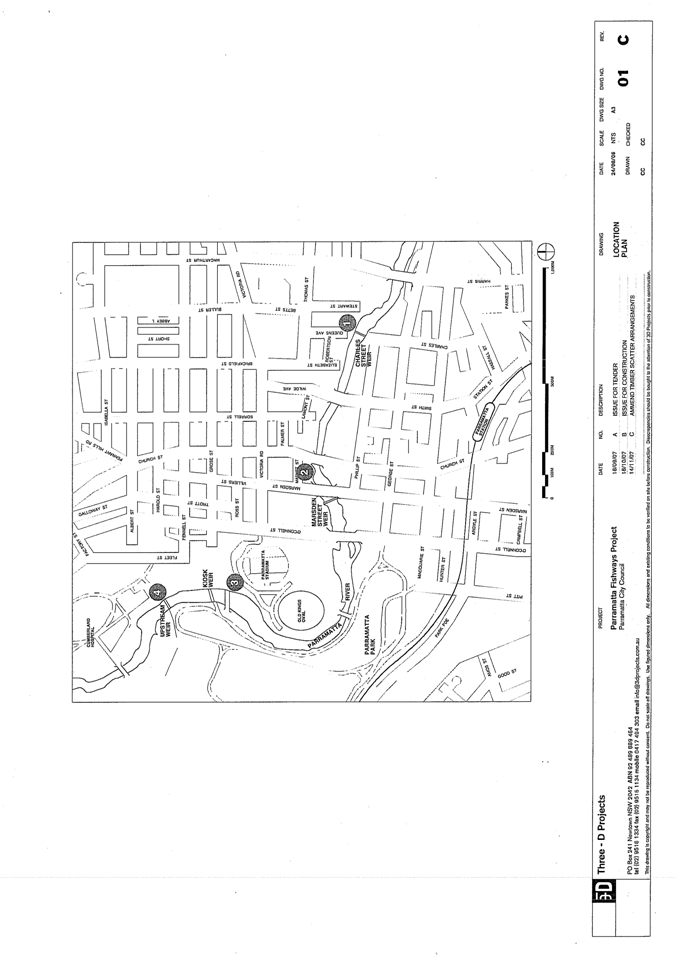
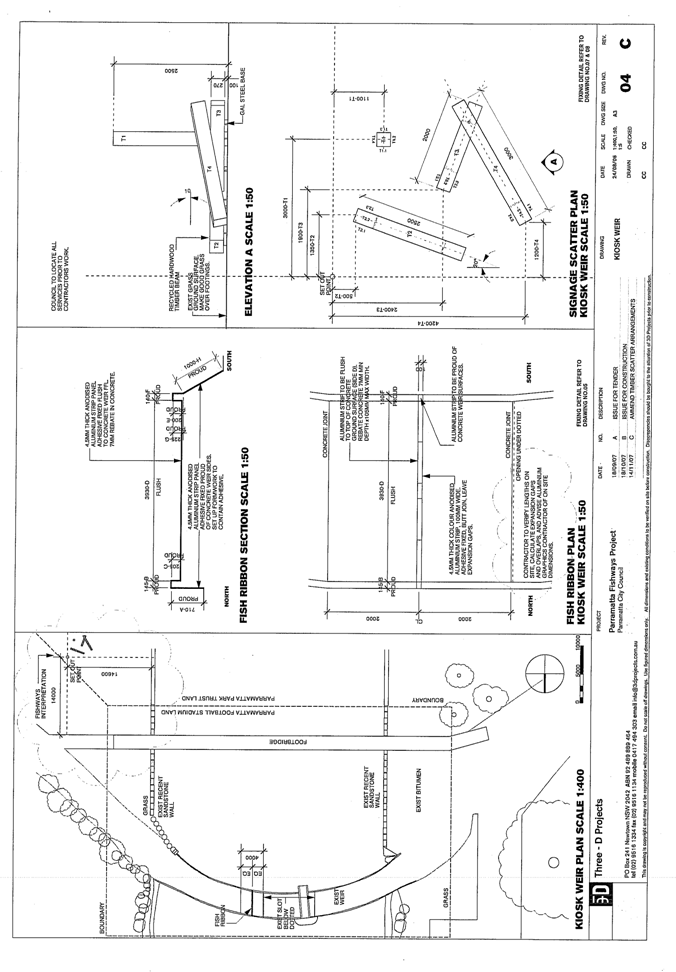
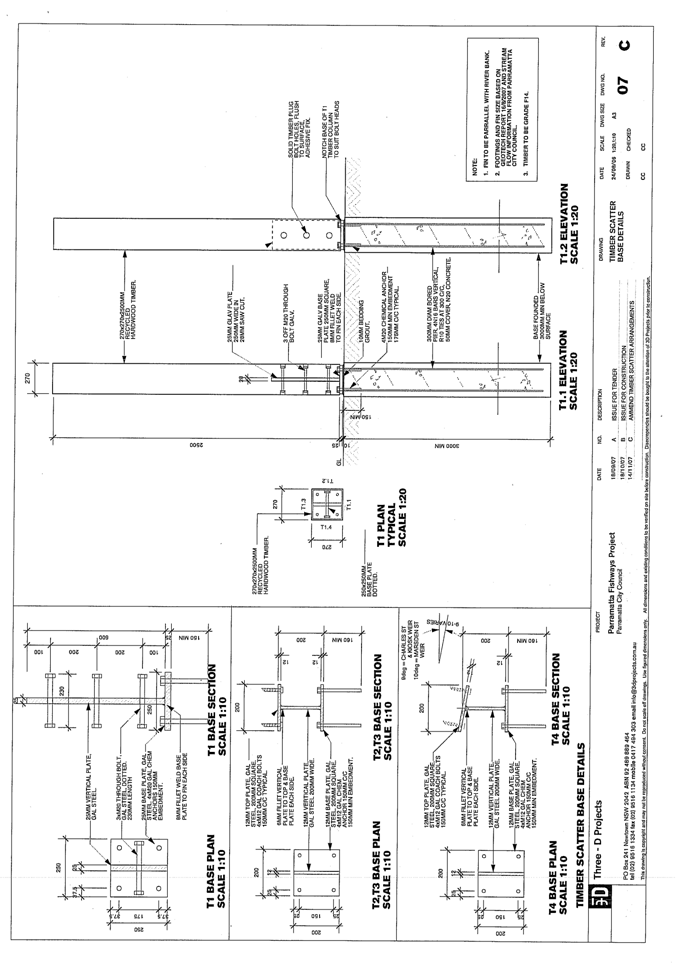
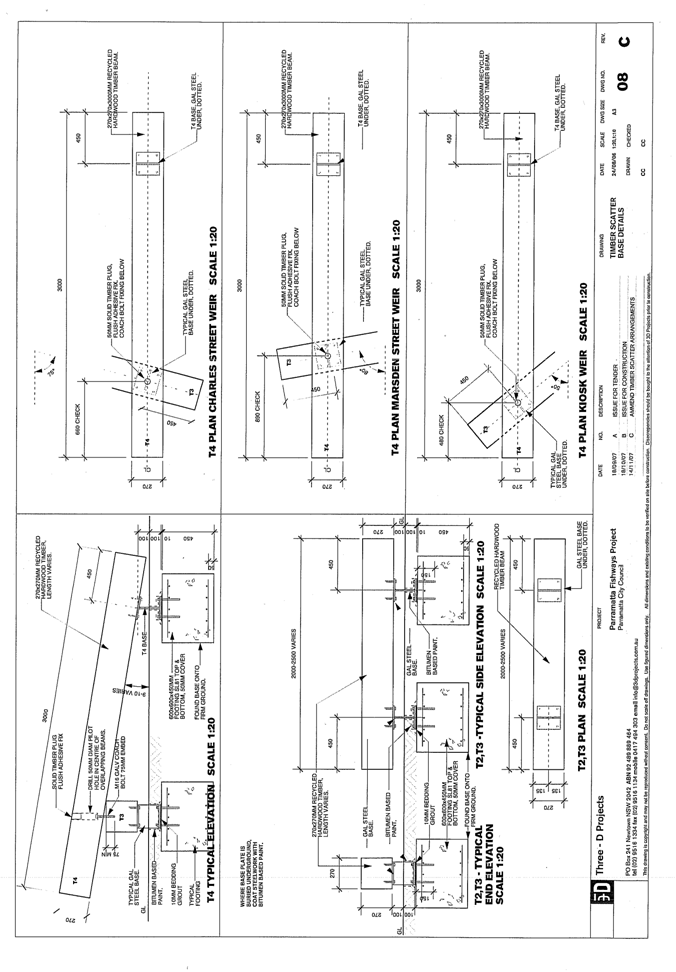
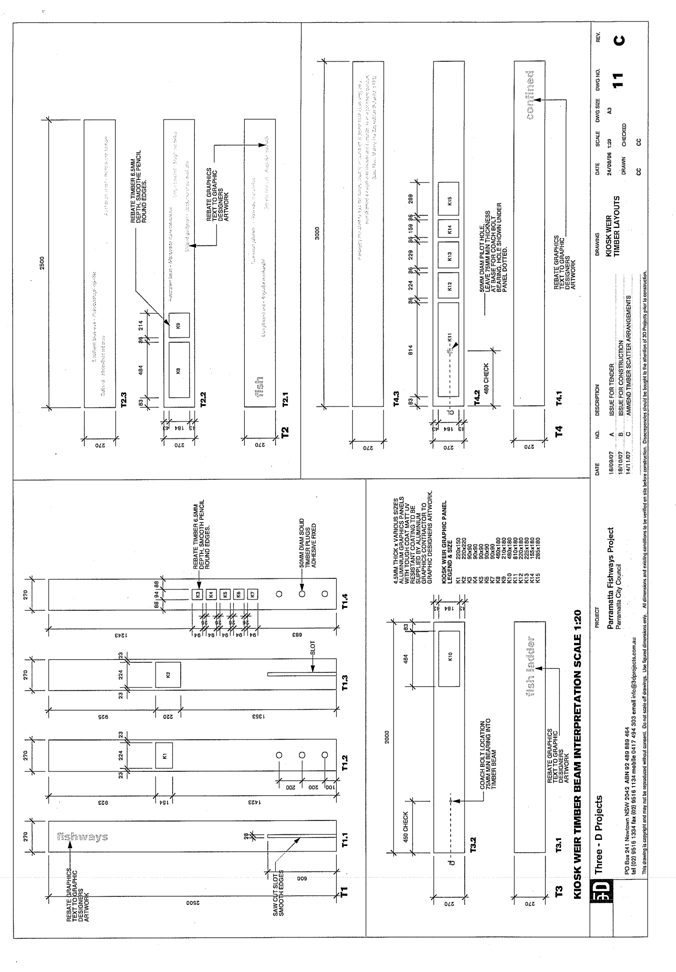
|
Ordinary Council 26 May 2008
|
Item 11.1
|
ROADS PATHS ACCESS AND FLOOD MITIGATION
ITEM NUMBER 11.1
SUBJECT Dedication
of land owned by Council as Public Road
REFERENCE F2008/02414 - D00933935
REPORT OF Service Manager - GIS/LIS
|
PURPOSE:
This report seeks
a resolution to dedicate the land detailed below as Public Road.
|
|
RECOMMENDATION
(a) That Council resolves to dedicate by notification in the Government Gazette
the land described below as public road in accordance with the Roads Act
1993.
|
BACKGROUND
1. During
a validation process for all land owned by Parramatta City Council it became
apparent that land existed within the Local Government Area that was being used
as public road but was not as yet formally defined as public road.
2. The
land identified as being owned by Parramatta City Council that is currently
being used as road to be dedicated as public road includes:
Lot 1
DP 723953, Lot 2 DP 731018, Lot 2 DP 580646, Lot A DP 153464,
Lot 14 DP 548233, Lot 53 DP 1346, Lot 1 DP 601591, Lot 4 DP 575528,
Lot 5 DP 574406, Lot 6 DP 540450, Lot 4 DP 529723, Lot 2 DP 524788,
Lot 15 DP 539448, Lot 1 DP 604304, Lot 2 DP 517284, Lot 2 DP 221394,
Lot 8 DP 227138, Lot 13 DP 547024, Lot 14 DP 547024, Lot 1 DP 207864,
Lot 3 DP 207864, Lot 4 DP 207864, Lot 1 DP 591454, Lot 1 DP 442837,
Lot 8 DP 207864, Lot 9 DP 207864, Lot 10 DP 207864, Lot 11 DP 207864,
Lot 12 DP 207864, Lot 2 DP 575003, Lot 5 DP 605051, Lot 6 DP 617776,
Lot 8 DP 599376, Lot 1 DP176267, Lot 2 DP176267
3. Detailed
location maps are attached.
4. On
the publication of the notice in the Government Gazette, the land is dedicated
as a public road.
ISSUES/OPTIONS/CONSEQUENCES
5. Currently
viewing this information on the Geographical Information System maps it is not
clear that the land is road which can cause confusion for internal and external
customers.
6. This
administrative task of dedicating the land as road will assist the strategic asset
management project for providing clarity for the recording of land within
Councils land register.
CONSULTATION & TIMING
7. Civil
Infrastructure, Capital Projects, and SAM are supportive to dedicate the land
as public road.
Kim Menzel
Service Manager – GIS/LIS
Attachments:
|
1View
|
Map - Clarke Street Granville Lot 1
DP723953
|
1 Page
|
|
|
2View
|
Map - Hunts Lane Epping Lot 2
DP731018
|
1 Page
|
|
|
3View
|
Map - Parkes Street Parramatta Lot 2 DP580646 Lot A DP153464
|
1 Page
|
|
|
4
|
Map - Mary Street Granville Lot
14 DP548233
|
1 Page
|
|
|
5
|
Map - Robertson Street Parramatta Lot 53 DP1346
|
1 Page
|
|
|
6
|
Map - Parkes Street Harris Park
|
1 Page
|
|
|
7
|
Map - Parkes Street Harris Park
|
1 Page
|
|
|
8
|
Map - Hunts Lane Epping
|
1 Page
|
|
|
9
|
Map - Russell Street Granville
|
1 Page
|
|
|
10View
|
Map - Houison Place Parramatta
|
1 Page
|
|
|
11View
|
Map - United Lane Parramatta Lot 8 9 10 DP207864
|
1 Page
|
|
|
12View
|
Map - United Lane Parramatta Lot 11 12 DP207864
|
1 Page
|
|
|
13View
|
Map - Guildford Road Guildford
|
1 Page
|
|
|
14View
|
Map - Rawson Street Epping - Lot 1 and 2
DP176267
|
1 Page
|
|
REFERENCE MATERIAL
|
Attachment 1
|
Map - Clarke Street Granville Lot 1 DP723953
|
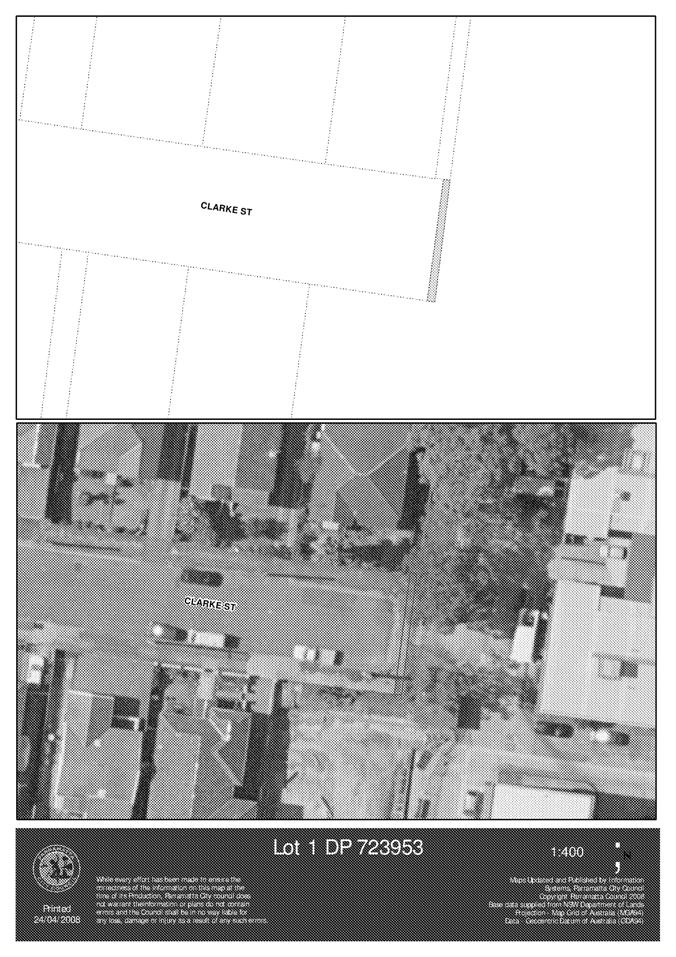
|
Attachment 2
|
Map - Hunts Lane Epping Lot 2 DP731018
|
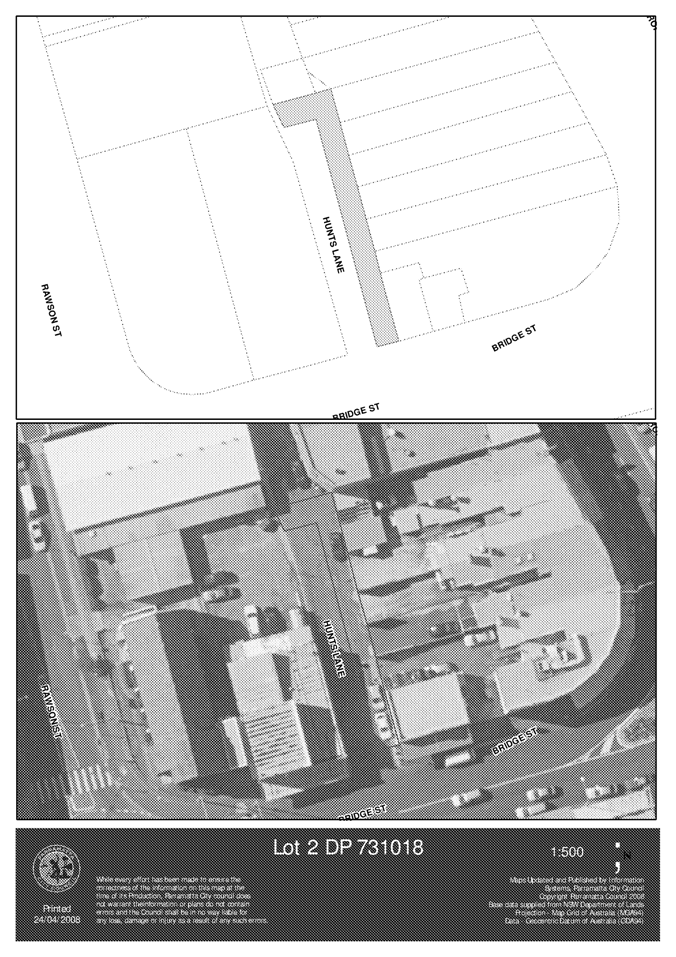
|
Attachment 3
|
Map - Parkes Street Parramatta Lot 2 DP580646 Lot
A DP153464
|
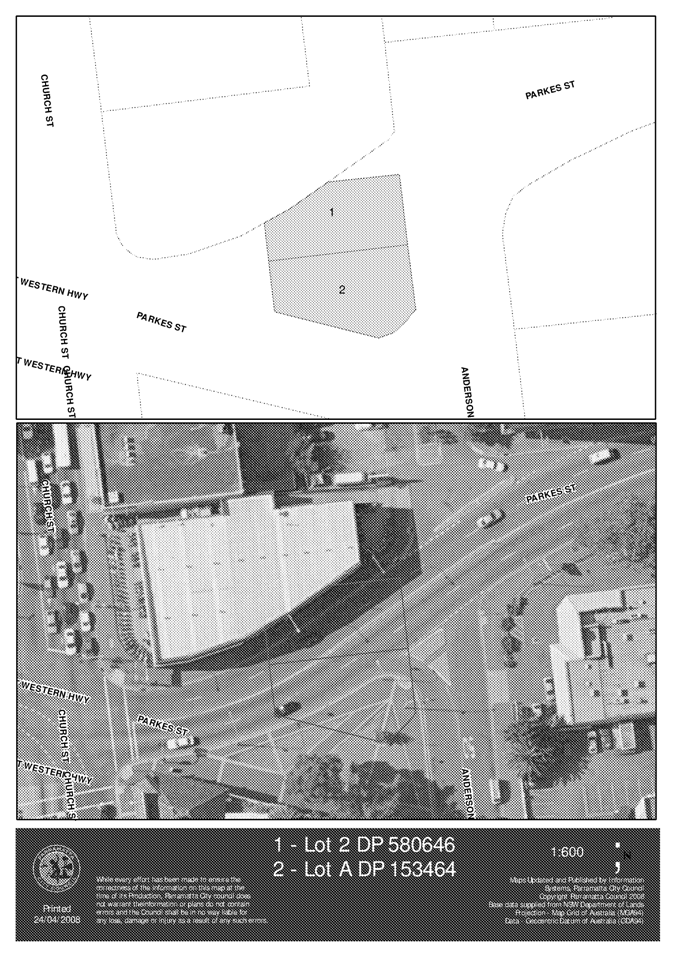
|
Attachment 4
|
Map - Mary Street Granville Lot 14 DP548233
|
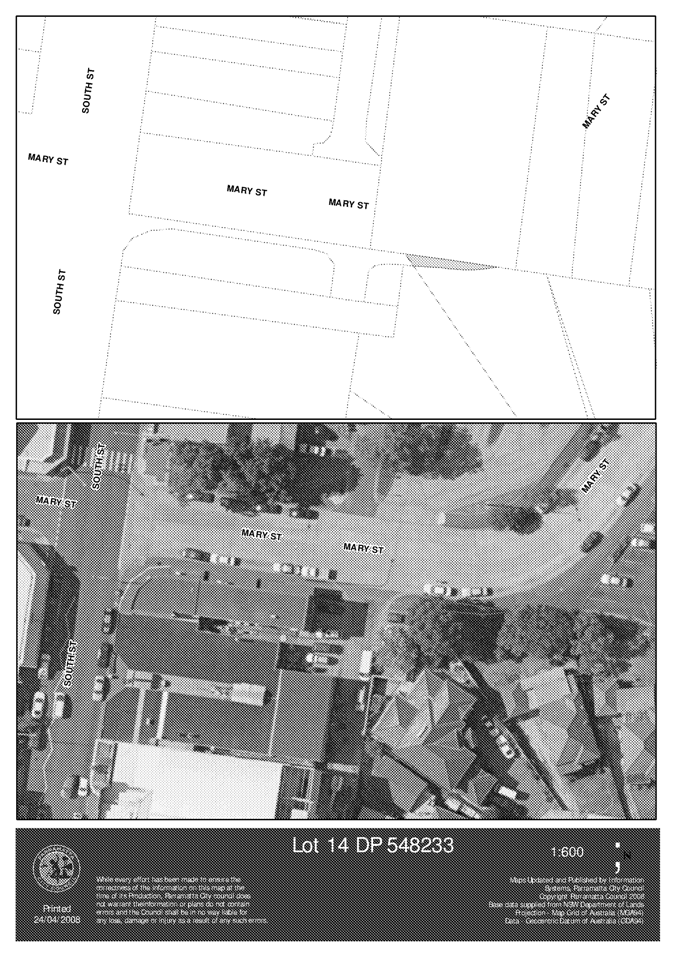
|
Attachment 5
|
Map - Robertson Street Parramatta Lot 53 DP1346
|
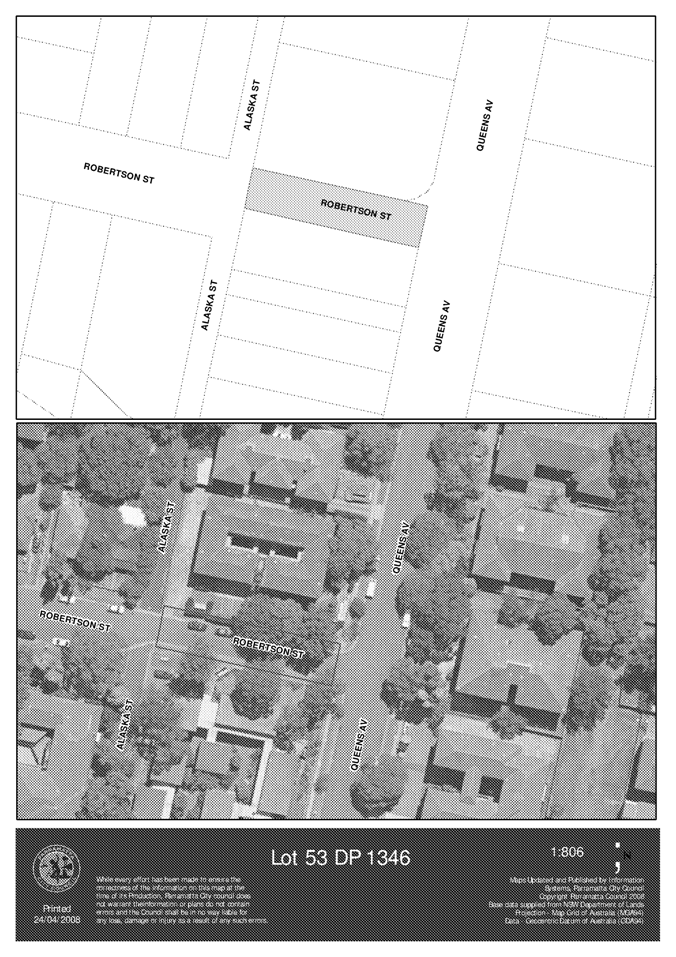
|
Attachment 6
|
Map - Parkes Street Harris Park
|
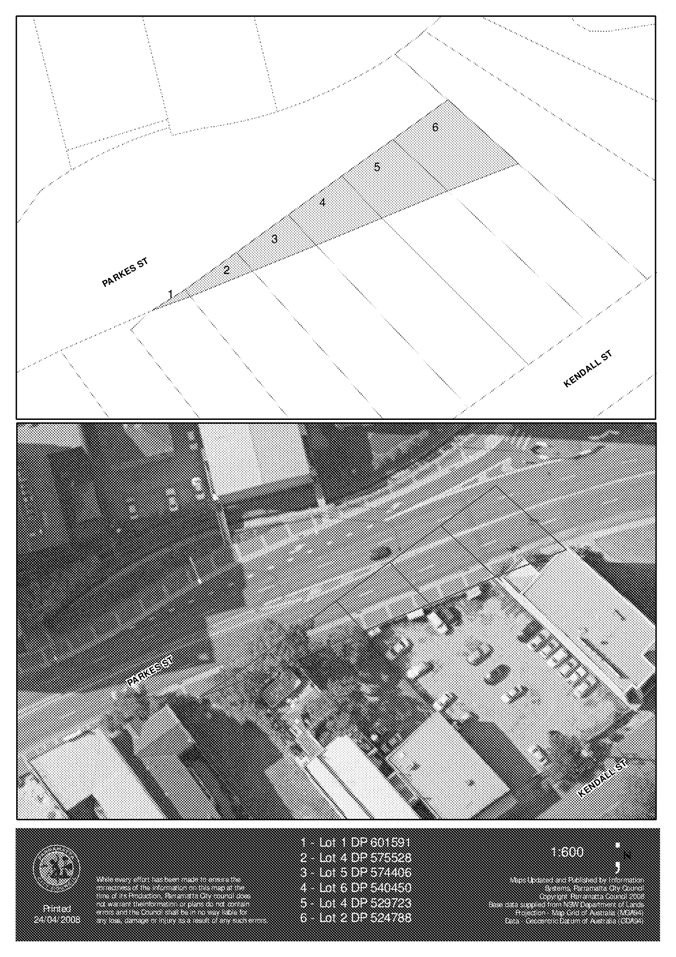
|
Attachment 7
|
Map - Parkes Street Harris Park
|
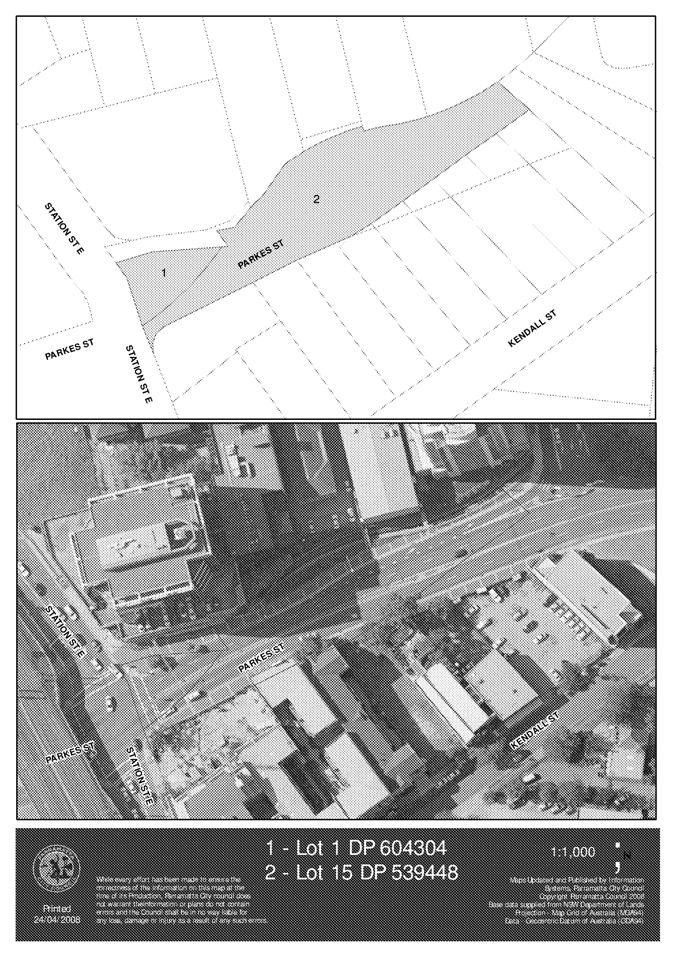
|
Attachment 8
|
Map - Hunts Lane Epping
|
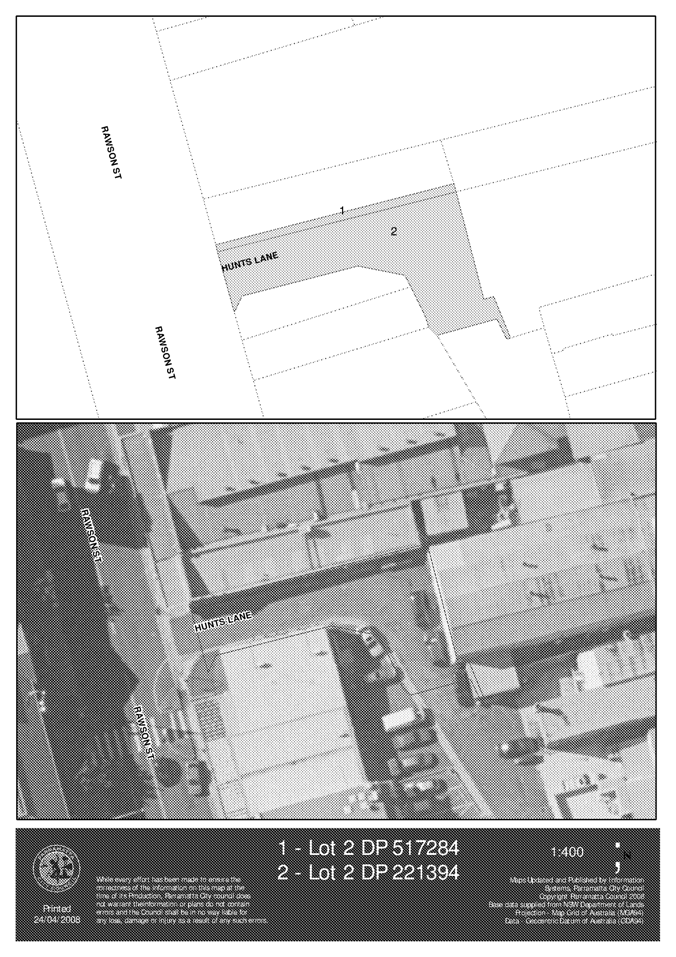
|
Attachment 9
|
Map - Russell Street Granville
|
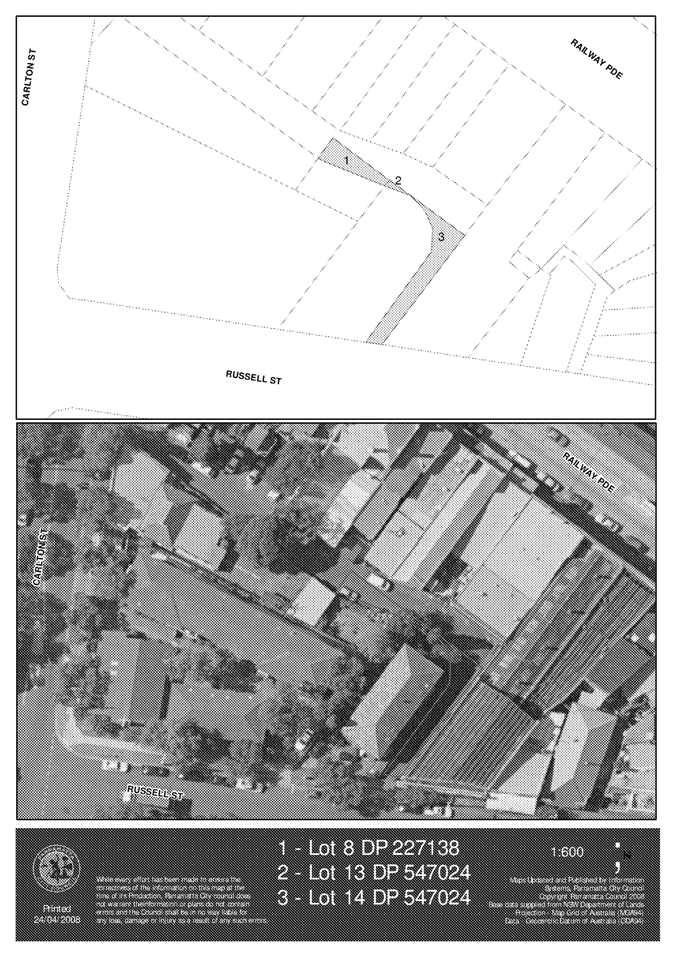
|
Attachment 10
|
Map - Houison Place Parramatta
|
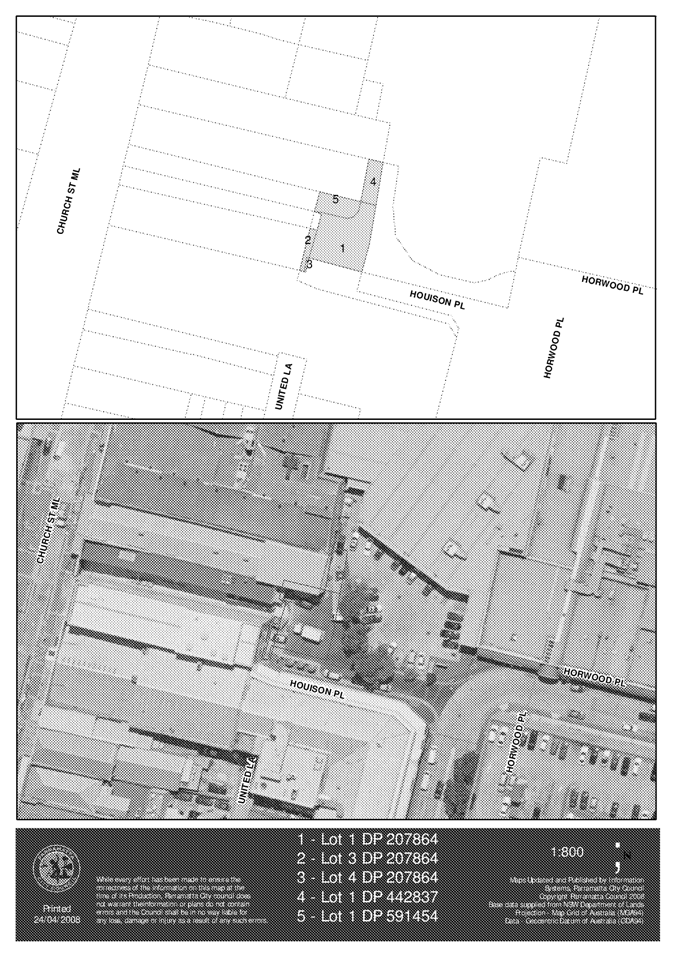
|
Attachment 11
|
Map - United Lane Parramatta Lot 8 9 10 DP207864
|
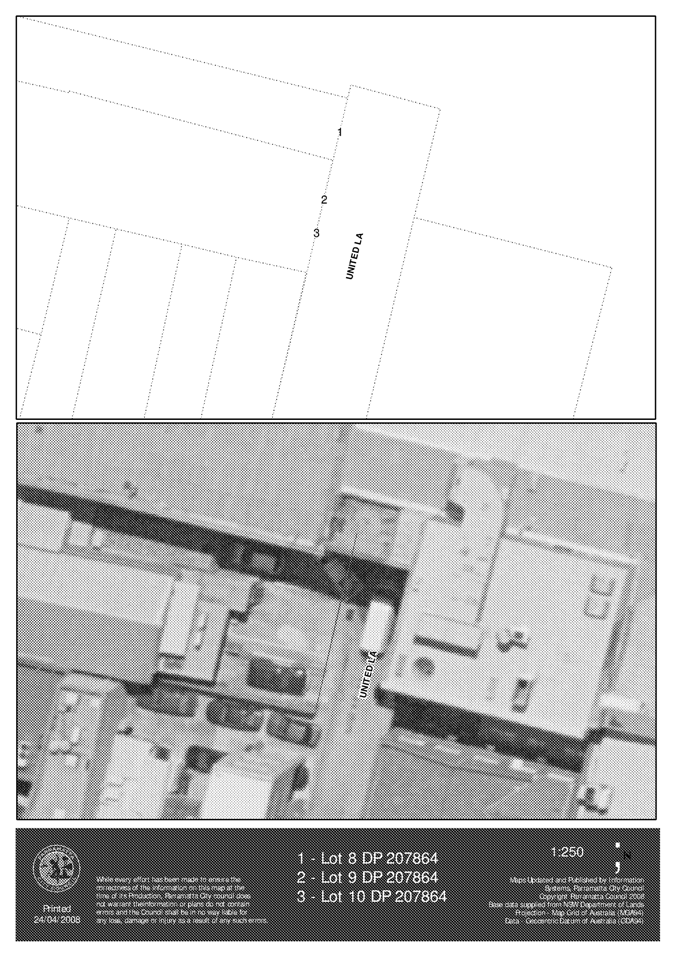
|
Attachment 12
|
Map - United Lane Parramatta Lot 11 12 DP207864
|
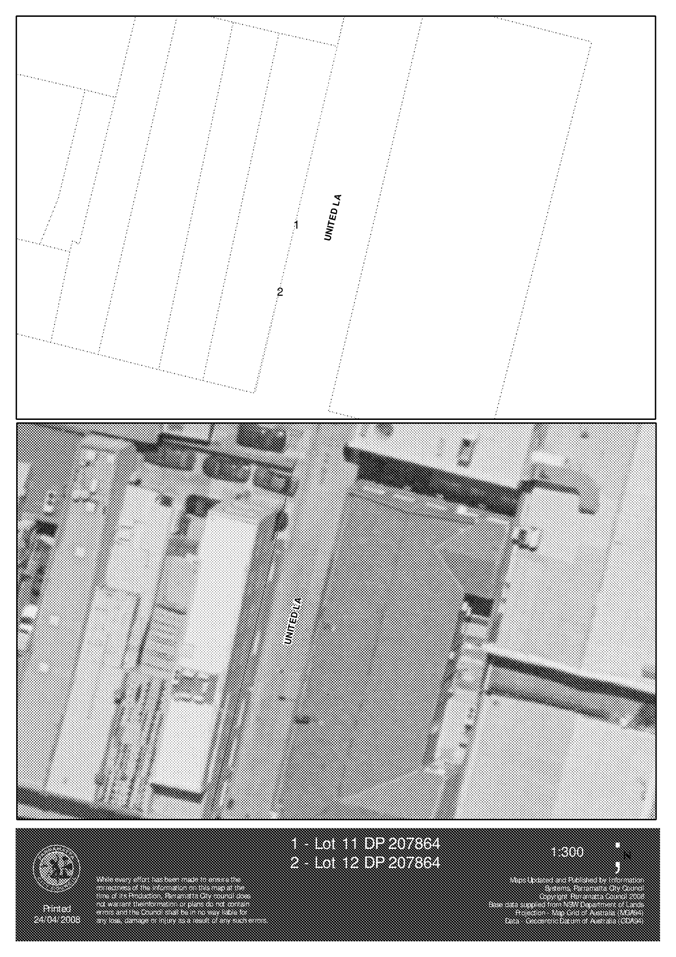
|
Attachment 13
|
Map - Guildford Road Guildford
|
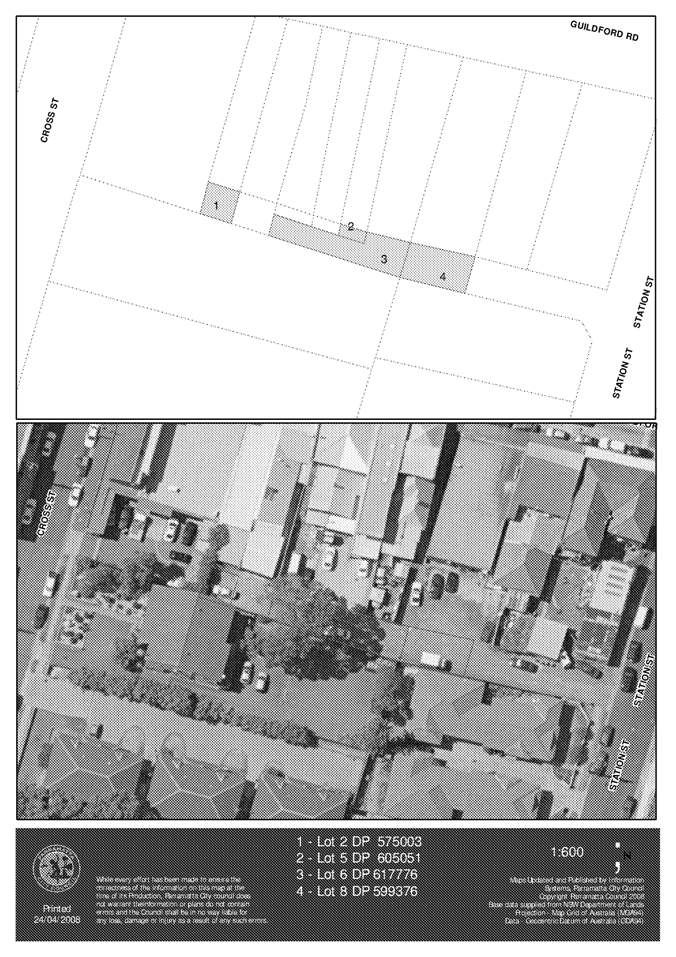
|
Attachment 14
|
Map - Rawson Street Epping - Lot 1 and 2 DP176267
|
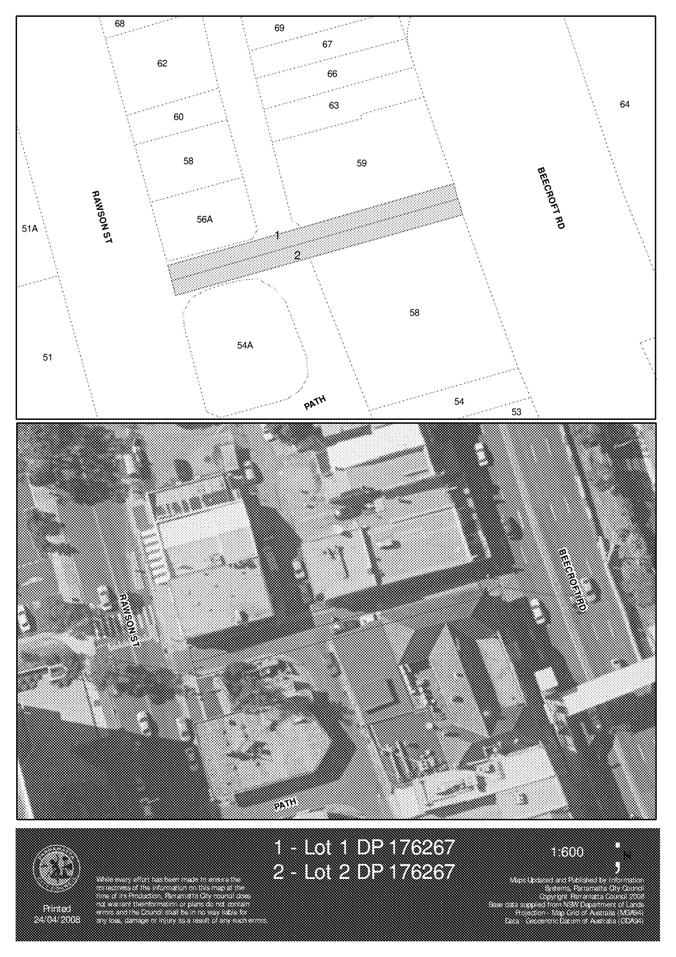
|
Ordinary Council 26 May 2008
|
Item 11.2
|
ROADS PATHS ACCESS AND FLOOD MITIGATION
ITEM NUMBER 11.2
SUBJECT Wharf Road Boat Ramp, Wharf Road, Ermington.
REFERENCE F2005/01517 - D00935424
REPORT OF Service Manager Capital Projects
|
PURPOSE:
Parramatta City Council and Ryde City Council submitted a
joint application to the NSW Maritime Authority under its 2007/08 Better
Boating Program. The joint application
was successful in receiving a $455,000 fully funded grant from the NSW
Maritime Authority to upgrade Wharf Road Boat Ramp, Ermington.
|
|
RECOMMENDATION
(a) That
Council accepts the $455,000 fully funded grant from the NSW Maritime
Authority to upgrade the Wharf Road Boat Ramp, Ermington and delegate
authority to Council’s General Manager to execute the agreement.
(b) That
Council endorses that Parramatta City Council officers administer and manage
the project.
(c) Further,
that Council includes this project as part of its proposed 2008/09
Management Plan.
|
BACKGROUND
1. Wharf Road
Boat Ramp lies adjacent to the Parramatta
River at Ermington with a shared
common city boundary with Ryde City Council running generally through the
centre of the access road to the site.
The maintenance of the ramp is currently carried out by Ryde City
Council. The boat ramp is functional for
medium size trailer boats, however, does become congested during the summer
months and would benefit users by the addition of another launching ramp and
improved roadwork facilities. The ramp
services users from the western areas of Sydney
and is the western most useable facility on the Parramatta
River.
2. During October 2007 the NSW Maritime
Authority announced the availability of funding under its Better Boating
Program and approached Ryde City Council and Parramatta City Council to lodge a
joint application for upgrade work to the Wharf Road Boat Ramp at Wharf
Road, Ermington.
3. Conceptual plans and estimates for the
work were prepared by Parramatta City Council’s Capital Projects team, which
included the following improvements to the value of approximately $1.3 million:
· Widening
of the existing two lane boat ramp to create an additional ramp;
· deepening
of the river and extension of the ramps;
· road
widening works and ramp to car park linkage;
· replacement
of degraded floating pontoon;
· protection
of historical ferry infrastructure;
· existing
car park improvements to include flood-lighting and line marking;
· reconstruction
and formalising of Waratah Street
from the western end of the car park to Wharf Road;
· construction
of a cycleway from the western end of the car park to Hope
Street; and
· associated
boating facilities to include showers, boat washing and fish cleaning tables.
4. Council received notification from the
NSW Maritime Authority, in March 2008, advising of its success in its
application, as follows:
“NSW Maritime is pleased to offer the joint application a BBP grant of
$455,000 to be used solely in relation to the above project as described in
your application. The grant amount is
based on 100% support of the items listed in the Project Cost breakdown as
follows:
· Survey, Design, DA (50,000)
· New jetty/pontoon ($250,000)
· Widen ramp by 3m ($80,000)
· Extend ramp – planks ($10,000)
· Road from ramp to carpark ($50,000)
· Project Management ($15,000)
Additionally, NSW Maritime wishes to confirm in principle support for
the remainder of the project. Funding
for works in addition to the components listed above will be subject to
finalisation of the design, including concurrence of NSW Maritime and confirmed
cost estimates, except that funding of the cycleway has not been approved as
eligible under BBP. The cycleway may be
eligible for 50% funding under SSHAP.
I understand that Parramatta City Council will be the project manager for the
works and subsequently will be making the claims for funding. Unless otherwise advised, the BBP grant will
be subject to conditions as detailed in the Better Boating Program Grant
Conditions, a copy of which is attached for your information.”
ISSUES/OPTIONS/CONSEQUENCES
5. Users from western Sydney
will benefit by having an uncongested launching facility giving water access to
Sydney Harbour.
6. The amenity of the facility will
improve with future lighting upgrades increasing safety and deterring
unsociable night activities.
7. An opportunity exists for Council to
achieve a total upgrade of the boat ramp facility with all funding being
provided by the NSW Maritime Authority.
Based on the advice received, funding for further stages may be possible
in future years.
8. A maintenance agreement is currently
being negotiated with Ryde City Council officers to include, in particular, the
management of the new facility.
CONSULTATION & TIMING
9. Consultation has taken place
on-site with several users of the boat ramp, together with input received from
Ryde City Council’s officers. Also, the
requests from officers of the NSW Maritime Authority, have been incorporated in
the concept design (see attachments).
10. The
NSW Maritime Authority has verbally agreed to a 12-18 month timeframe for
completion, although, it is anticipated that final design and construction, for
this stage of the works, will be undertaken and completed within the 2008/09
financial year.
Jim Stefan
Service Manager – Capital
Projects
15 May 2008
Attachments:
|
1View
|
Concept Plan
|
1 Page
|
|
|
2View
|
Artist's Impression
|
1 Page
|
|
REFERENCE MATERIAL
|
Attachment 1
|
Concept Plan
|
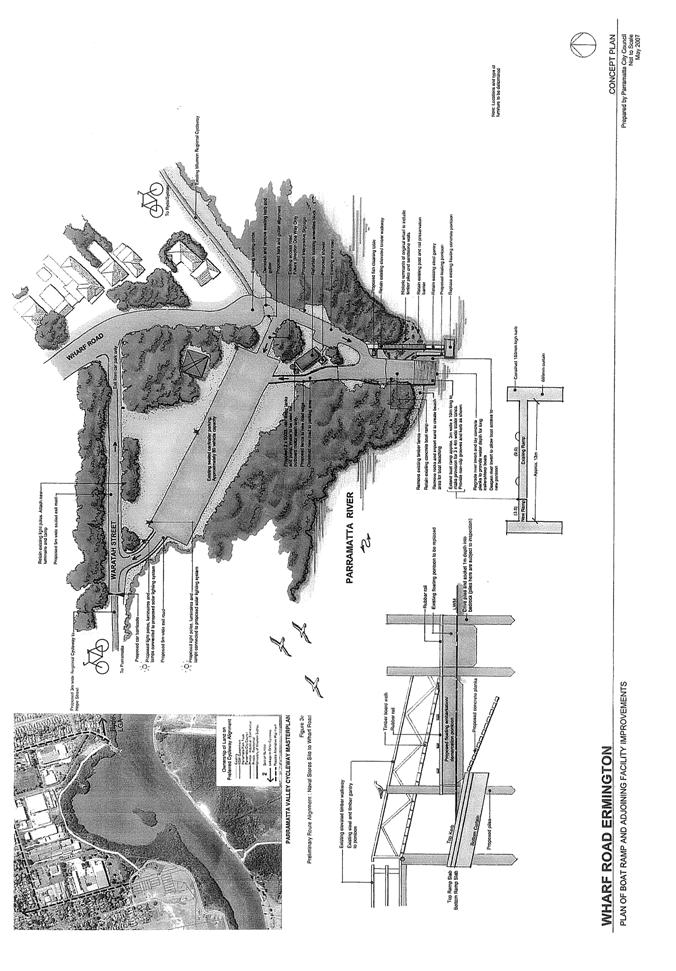
|
Attachment 2
|
Artist's Impression
|
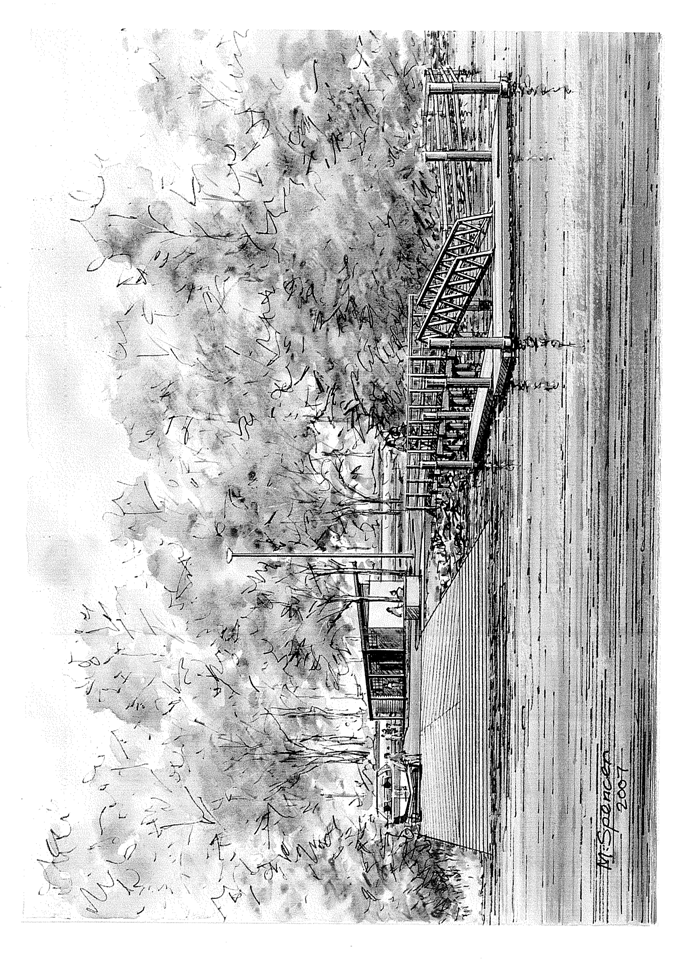
|
Ordinary Council 26 May 2008
|
Item 12.1
|
ITEM NUMBER 12.1
SUBJECT International
Charter for Walking
REFERENCE F2008/01449 - D00919513
REPORT OF Recreation Planner
|
PURPOSE:
To seek Council’s endorsement
of the strategic principles of the ‘International Charter for Walking’.
|
|
RECOMMENDATION
(a) That Council adopt the
International Charter for Walking in recognition of the benefits of walking
as a key indicator of a healthy, efficient, socially inclusive and
sustainable community.
(b) That Council acknowledge
the universal rights of all people to be able to walk safely and the need to
reduce the physical, social and institutional barriers that limit walking.
(c) That the Lord Mayor sign the
International Charter for Walking on behalf of Council.
(d) Further, that Council
work with State and Federal Governments, local businesses and the community
to implement the principles of the International Charter for Walking.
|
BACKGROUND
1. Walking is a fundamental and universal right,
whatever our ability or motivation, and continues to be a major part of our
lives. However, in many countries including Australia,
people have been increasingly walking less and less. Walking Forward in the 21st
Century, known as Walk21, was created to champion the development of healthy,
sustainable and efficient communities which provide an environment where people
choose to walk more often.
2. The International Charter for Walking was developed by the
International Walk21 Committee, and was presented to the Walk21 Conference in Melbourne in 2006 for adoption by
individuals, organisations and governments. It identifies the needs of
pedestrians and provides a common framework to help authorities refocus their
existing policies, activities and relationships to create an environment and
culture that encourages people to walk. (Attachment
1)
3. Many cities throughout the
world are recognising the importance of providing walkable environments and
have committed to the principles of the International Charter for Walking. The
Charter has been signed, for example, by both the Lord Mayor of London and the Lord
Mayor of Sydney.
4. The principles and actions identified in the
Charter to encourage and promote walking supports Council’s existing investment
in cycleways, pathways and public domain improvements. It is consistent with
Parramatta Twenty25 which identifies a priority strategy (TC4) “to increase the
number of people walking and cycling, particularly for journeys within the
neighbourhood”. The Charter also supports actions and strategies in the Sydney
Metropolitan Strategy, Parramatta City Centre Plan (2007), Parramatta Sport and
Recreation Plan (2005), and Parramatta Open Space Plan (2004).
ISSUES/OPTIONS/CONSEQUENCES
5. Walking as a way of getting between destinations has decreased
dramatically during the 20th century in many parts of the world,
particularly in Australia. We have developed an
increasing reliance on motorised forms of transport, which has severely
decreased our physical activity levels.
The NSW Health Population Health Survey Report on Adult Health,
published in 2006 found that over 77% of people commuted to work by car or
motorbike compared to only 7.7% who walked and 1.2% who travelled by bicycle.
The Report further found that this has contributed to significant increases
depression, heart disease, road rage, anxiety, social isolation and record
obesity levels, with 50.4% of Australians now classified as overweight or
obese. This is particularly evident in Western Sydney where 55.7% of the community
are overweight or obese.
6. From an environmental perspective our streets are now congested
with large volumes of traffic and the air is becoming increasingly polluted,
resulting in an increasingly unattractive and unsafe environment for pedestrians.
7. A walkable neighbourhood is one that provides and encourages a
safe and attractive environment where people are within a reasonable walking distance to most
of the places they want to visit, such a local shops, schools and other
services. Walkable
neighbourhoods provide significant environmental, economic and social benefits
to the community, including improved health, reduction in pollution, increased
local business activity and social capital.
8. Evidence
from other cities has shown that improving the pedestrian and cycling
environment creates a livelier and attractive city where more people desire to
walk, cycle and spend time. For example, in Copenhagen (where use of non-motorised transport is
measured annually), 100,000m2 once devoted to motorised traffic has been
converted into vehicle-free city space exclusively for pedestrians and
cyclists. This has resulted in 80% of the movement through the city centre
being foot-traffic and 36% of people travelling to work by bicycle. More
locally, according to the 2004 Melbourne: Places for People report, the
Melbourne CBD has increased the space devoted to pedestrians by over 70% in the last
ten years, resulting in a 39% (daytime) and 98% (evening) increase in
pedestrian traffic.
9. Parramatta City Council has already implemented some significant
improvements to the pedestrian
environments through both increased funding for footpaths, cycleways and other
public domain improvements under the Better Neighbourhood program.
10. In signing the Charter, Council would be
acknowledging that it understands the value of walking and the desire to create
a supportive environment. However, it does not commit Council to any specific
actions or budgetary implications.
11. Economic, Social, Environmental and Organisational
implications are detailed in Attachment 2.
CONSULTATION & TIMING
12. Consultation regarding the Charter has been
undertaken with various stakeholders within Council to ensure that the Charter
is consistent with Councils strategic directions. No specific formal
consultation has been undertaken with the community. However, walking is
actively encouraged and promoted in various Council plans and strategies.
Troy
Holbrook
Recreation
Planner
12
May 2008
Attachments:
|
1View
|
International Charter for Walking
|
8 Pages
|
|
|
2View
|
Detailed Submission
|
3 Pages
|
|
REFERENCE MATERIAL
|
Attachment 1
|
International Charter for Walking
|
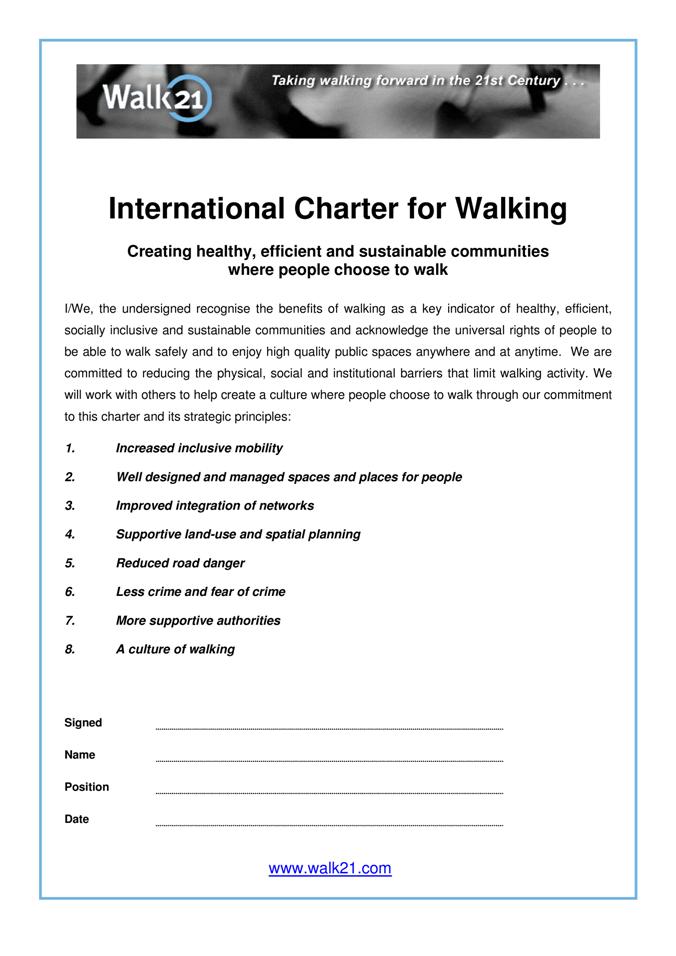
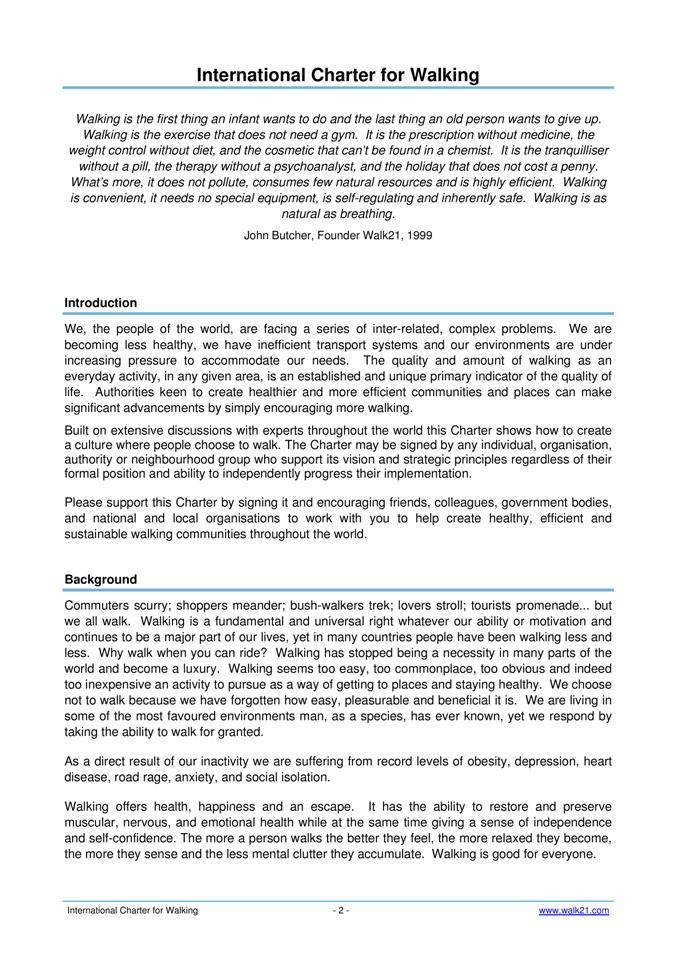
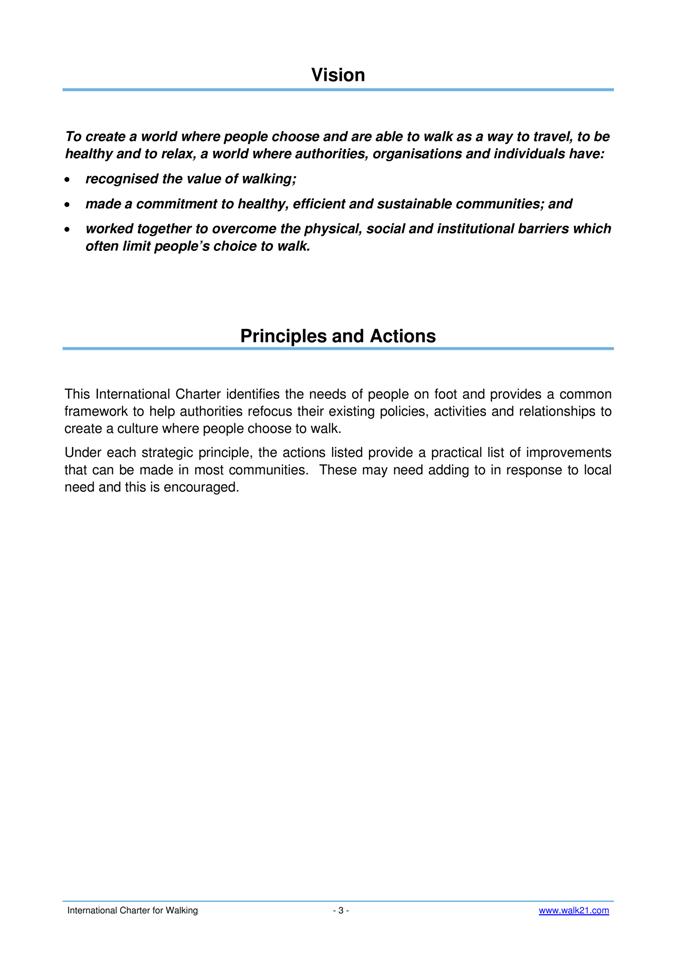
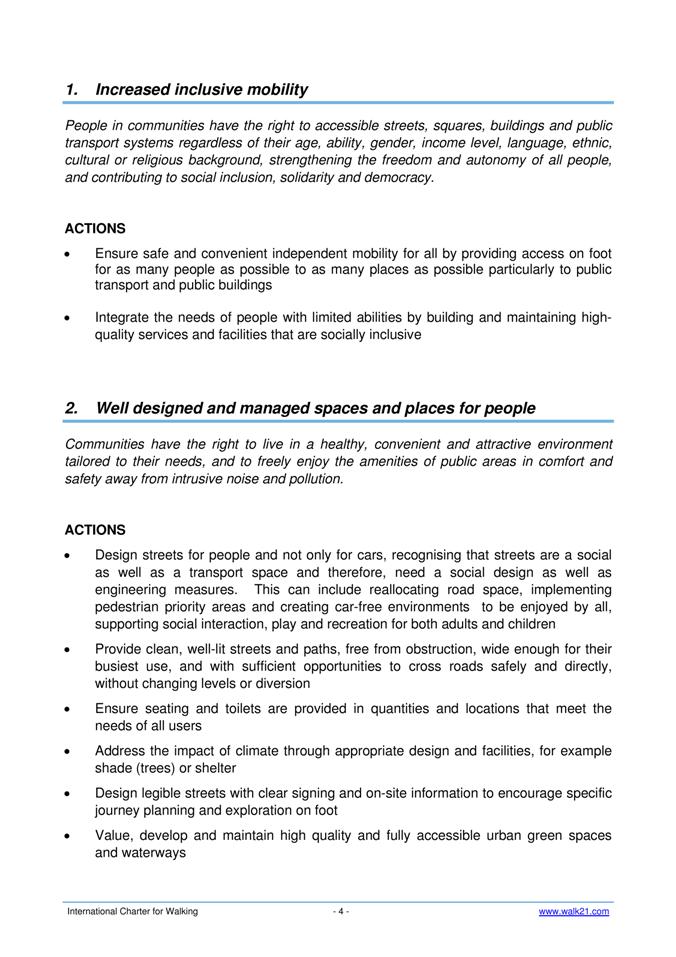
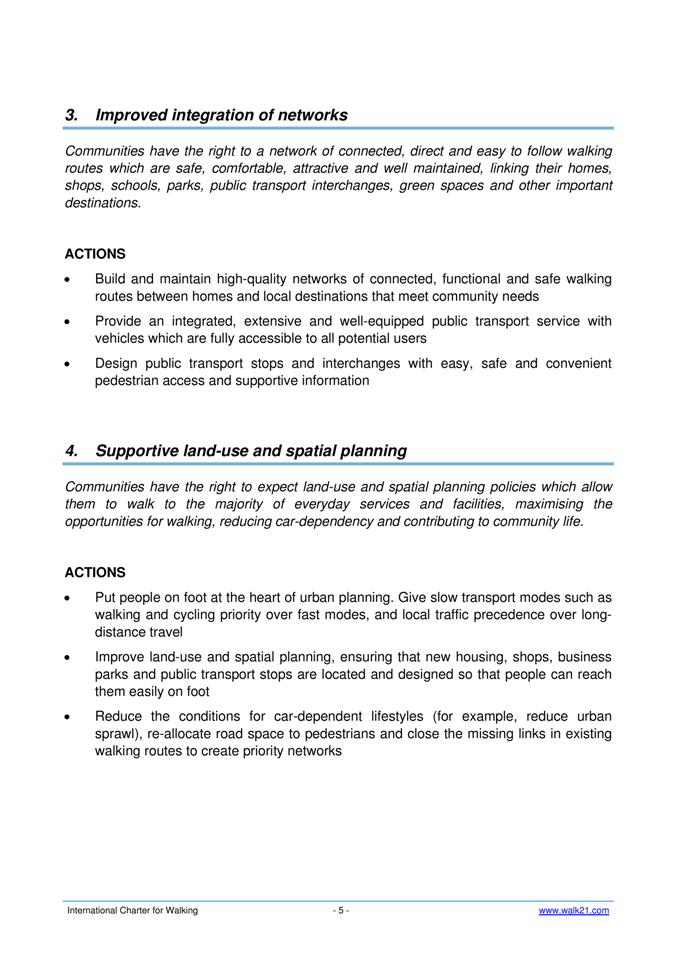
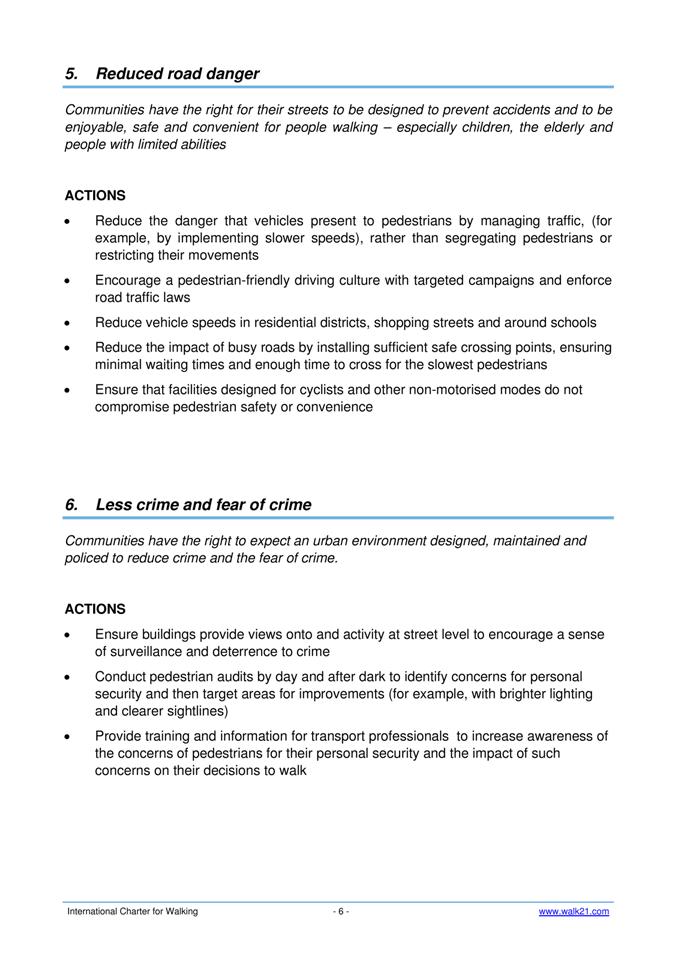
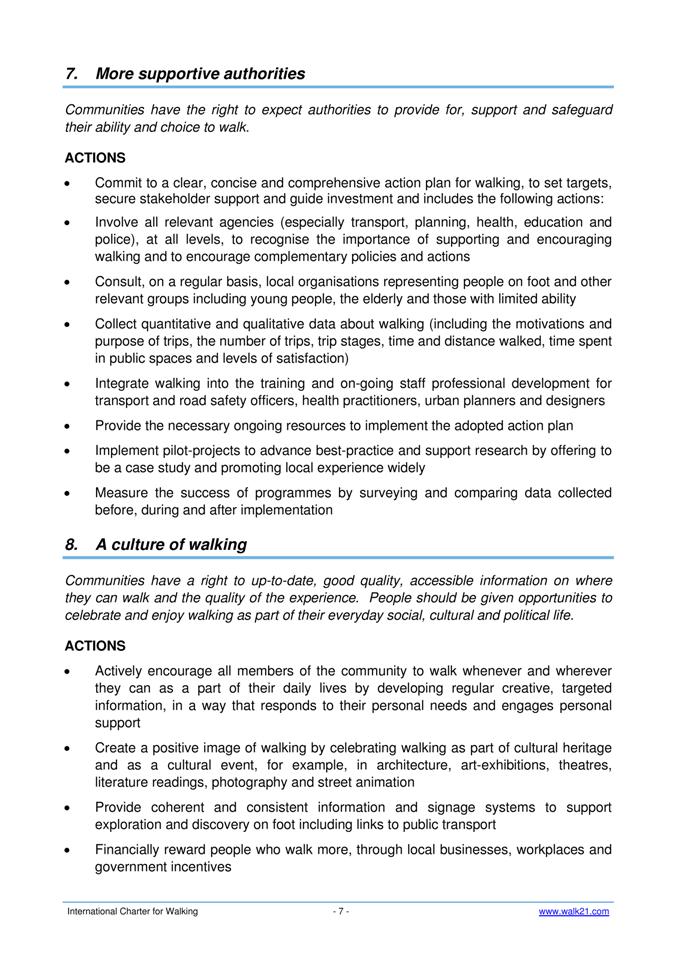
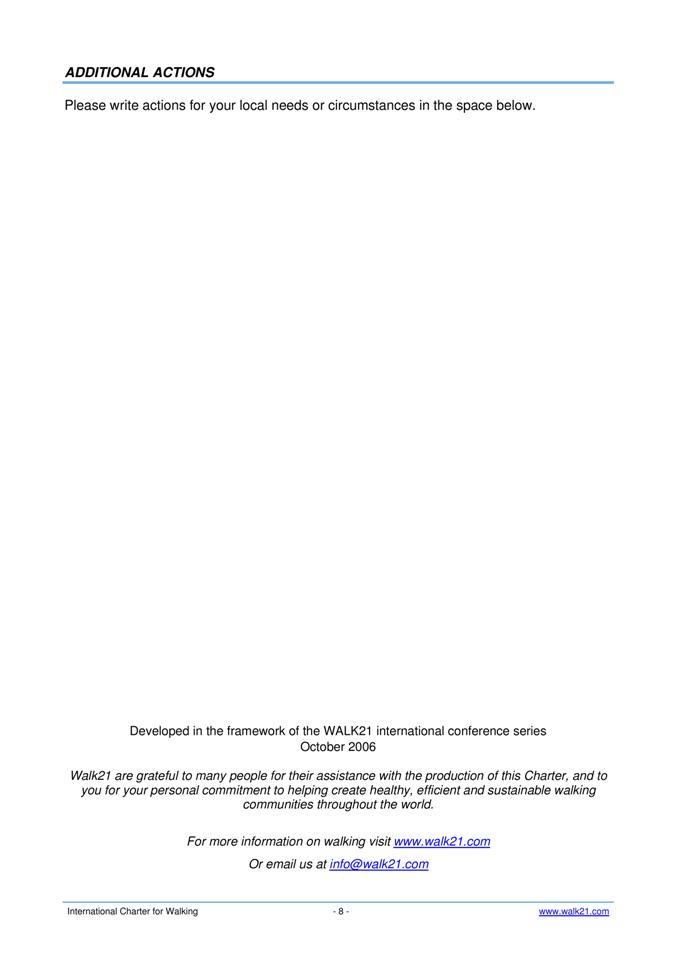
|
Attachment 2
|
Detailed Submission
|
DETAILED SUBMISSION
1. SUSTAINABILITY
1.1 Economic Implications
Research shows that transport is
second only to food as the largest item of household expenditure in Australia. The cost of running the family car is
continually increasing due to rising fuel costs, however a large proportion of
car trips are short. Comparatively
however, the cost of walking costs as little as a good pair of walking
shoes.
Replacing short car trips with walking helps local
businesses as goods and services are increasingly purchased locally rather than
driving further away. Pedestrian friendly neighbourhoods with less traffic
increase the number of passers-by which increases a sense of safety,
benefitting local businesses through encouraging additional visitors and
attracting new businesses and jobs. In addition, land currently reserved for
car parking could be reduced and utilised more productively.
Research shows that Staff who walk are generally
more punctual and take less sick days due to improved health. Therefore,
businesses that encourage staff to walk to work will benefit from increased
productivity as a result of improved employee fitness and mental health. The
benefits of walking will also reduce stress on health services and road
maintenance costs.
1.2 Social Implications
Walking is free and requires no special equipment,
making it an affordable and convenient means of transport. Research shows that
walkable communities are better connected as walking provides the opportunity for people to
interact with others in the community. More people walking also
creates a safer environment as streets are under natural surveillance resulting
in reduced crime levels.
Lack of regular physical
activity is not only unhealthy, it puts a great deal of strain on Australia's
health care system. Physical inactivity is second only to tobacco in terms of
contribution to ill-health in Australia. Regular walking provides a significant
number of health benefits, both physical and mental. It reduces air and noise
pollution produced by motor vehicles which can affect sleep, disturb mental
function, increase blood pressure and psychological stress. Walking is
essential in the prevention of:
· heart disease
· stroke
· type 2 diabetes
· falls / fractures / injuries (through improved
strength and coordination)
· colon cancer
· hypertension (high blood pressure)
· osteoporosis
· depression
· lower back pain.
It also also
improves:
· psychological well-being
· metabolism
· muscle strength and flexibility
· strength and endurance
· respiratory function
· concentration and memory.
· strengthening the immune system
· increasing energy levels
· managing weight.
In particular, children who walk to school can
benefit from regular exercise and improved concentration and memory. Outdoor
activity such as walking is important for children as it contributes to the
development of physical, practical, emotional and social skills.
1.3 Environmental Implications
Walking is a pollution-free mode of transport.
Motor vehicles contribute to a large proportion of our air pollution, with cars
being responsible many millions of tonnes of greenhouse gas emissions in
Australia. However, the majority of
vehicle emissions are released when engines are started (up to 40 per cent
more), in stop-start traffic and during short trips.
The majority of car trips to school and the local
shops are within walking distance of the majority of households. By walking
some of these short trips instead of driving we can help reduce air pollution,
congestion and associated costs through fewet cars on the road. More
pedestrians and less cars near schools will also creat a much safer environment
for our children to get to and from school.
Maintaining and improving the transport network
costs the Australian Government significantly each year. Up to 40 per cent of
urban areas in Australia are taken up with infrastructure for
vehicles, such as roads, car parks, service stations and auto manufacturers.
Within the community, the family car requires three times more space than the
family home because of the amount of space needed for cars at home, work, at
shopping centres and schools. Walking reduces the parking spaces
required by cars, providing opportunities for more recreational spaces to be
enjoyed by the community, as well as less impacts on our native animals and
ecological communities.
2. ORGANISATIONAL
IMPLICATIONS
2.1 Financial
The signing of the International
Charter for Walking will not directly impact upon the current management plan.
Any additional funding of capital works improvements or additional maintenance
works will be separately considered and approved by Council as part of the
annual management plan process.
2.2 Legal
Not Applicable
2.3 Human Resources
Not
Applicable
2.4 Information Technology
Not Applicable
2.5 Risk Management
The principles of the
International Charter for Walking encourage the development of safe
environments for the public which incorporates actions relating to the
provision of safe, clean and well maintained spaces and facilities. These
principles aim to develop a pro-active risk management program to increase the
safety of public domain areas and reduce Council’s liability for possible
compensation claims.
2.6 Policy
The International Charter for Walking is consistent with
Councils adopted policies and strategies, in particular it supports Parramatta
Twenty25. It is also consistent with the NSW Government State Plan and Sydney
Metropolitan Strategy, and will provide a basis for their implementation
through future strategic partnerships and alliances with key government
agencies, non government organisations and the private sector.
3. ALIGNMENT WITH CORPORATE
PRIORITIES
The International Charter for
Walking supports both Council’s Corporate Plan and Parramatta Twenty25. It will
provide guidelines which will assist Council in implementing many of the
priorities identified in these adopted strategies.
4. CONCLUSION
Walking is free, requires no special equipment and is a universal right
whatever our ability or motivation. However our increasing reliance on
motorised forms of transport has severely decreased our ability and desire to
walk due to an increasingly unattractive and unsafe environment for
pedestrians.
The International Charter for
Walking recognises the benefits of walking and identifies the needs of
pedestrians in providing a common framework to help authorities create an
environment and culture that encourages people to walk. It is consistent with
Council’s Corporate and Parramatta Twenty25 strategic plans as well as the NSW
Government’s State Plan and Sydney Metropolitan Strategy, and will assist in
their implementation.
|
Ordinary Council 26 May 2008
|
Item 12.2
|
ITEM NUMBER 12.2
SUBJECT Naming
of an Unnamed Public Reserve in Parramatta as Warrigal
Wetland
REFERENCE F2008/01223 - D00919683
REPORT OF Recreation Planner
|
PURPOSE:
This report proposes the name Warrigal Wetland
for the currently unnamed public reserve located at the end of
Broughton and Pemberton Streets in Parramatta.
|
|
RECOMMENDATION
(a) That
the proposal to name the unnamed public reserve at the end of Broughton and
Pemberton Streets in Parramatta as Warrigal Wetland be endorsed in
principle by Council and be referred
to the Geographical Names Board of NSW for formal assignment under the
Geographical Names Act 1966.
(b) That if
approval is granted by the Geographical Names Board, a park name sign be
erected at the reserve, to be funded from the parks maintenance budget.
(c) Further, that Mr
McGrath and the persons who lodged a submission in relation to
the naming proposal be advised of Council’s decision.
|
BACKGROUND
1. Mr N McGrath from the Pemberton
Street Bushcare Group has requested
Council to name the unnamed public reserve located at the end of
Broughton and Pemberton Streets in Parramatta, as
Warrigal Wetland. (Attachment 1)
2. The name recommended is “Warrigal
Wetland” in recognition of the substantial population of native Tetragonia tetragonioides (commonly
known as Warrigal Greens) in the reserve.
The word Warrigal comes from the name used by the local Aboriginal tribes to
describe native dogs or Dingos. Tetragonia tetragonioides is one of over
50 species of Tetragonia which are native to temperate and subtropical regions
of the Southern Hemisphere, including Australia and New Zealand.
3. The reserve proposed
to be renamed is approximately 1.5 ha in size and comprises of Lot 1 DP 1239,
Lot 5 DP 20765, Lots 1-2 DP 566807 and Lot 141 DP 537053. (Refer Attachment 2) It is located on the northern side of the Parramatta
River and contains both saltwater
and freshwater wetlands which provide an ideal environment for a variety of native
fauna and flora species.
4. Tetragonia tertragonioides is an annual plant with soft foliage and
stems which have a spread of approximately two metres. Its angular green leaves
are diamond shaped, with small greenish yellow flowers that appear throughout
most of the year. It was discovered by Captain Cook in New Zealand in 1769 who fed it to his crew as a fresh vegetable to prevent scurvy.
As they occur predominantly in coastal and inland saltmarsh areas in Australia,
‘Warrigal Greens’ helped supplement the meagre rations of the early settlers at
Sydney Cove, prior to the establishment of Rosehill (Parramatta).
ISSUES/OPTIONS/CONSEQUENCES
5. A number of parks and reserves
within the Parramatta Local Government Area have been named in connection with
the local native plant species found within them. In view of the size, location
and significance of this public reserve it is appropriate for it to have a
formal name.
6. The proposed Warrigal Wetland
name is supported in view of the significant number of this native species
within the reserve. It also complies with the NSW Geographical Names Board’s
‘Guidelines for Place Names’.
CONSULTATION & TIMING
7. Letters were forwarded to
residents in the nearby local area, inviting them to comment on the proposal.
As the name is of Aboriginal origin, the Deerubbin Local Aboriginal Land
Council was also invited to comment.
8. A memo was distributed to Elizabeth
Macarthur Ward Councillors also inviting their comments on the proposal.
9. One submission (Attachment 3) was received during the
consultation period from a neighbouring resident who supported Council’s
bushcare activities at the reserve but raised no objection to the name change.
10. As the name is of a botanical
nature, Council’s Open Space and Natural Resources staff were consulted
regarding the proposal. They verified the significant population of Warrigal
occurring in this reserve, and fully support the proposal.
Troy
Holbrook
Recreation
Planner
12
May 2008
Attachments:
|
1View
|
Warrigal Wetland Naming Request - N. McGrath
|
1 Page
|
|
|
2View
|
Map of Proposed Warrigal Wetland
|
1 Page
|
|
|
3View
|
Submission - J Kyle
|
1 Page
|
|
REFERENCE MATERIAL
|
Attachment 1
|
Warrigal Wetland Naming Request - N. McGrath
|
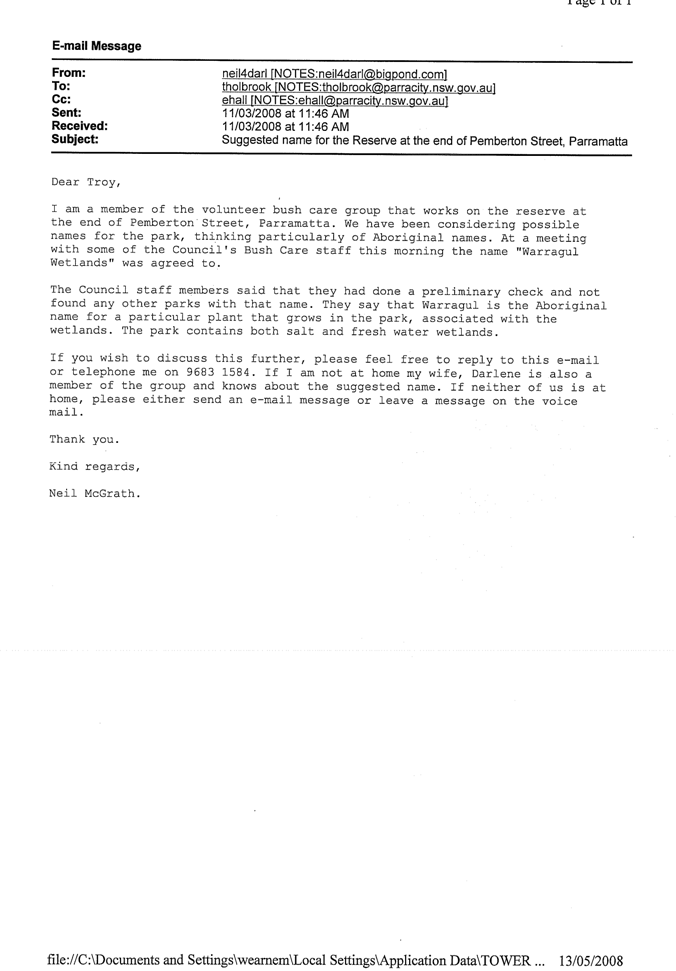
|
Attachment 2
|
Map of Proposed Warrigal Wetland
|
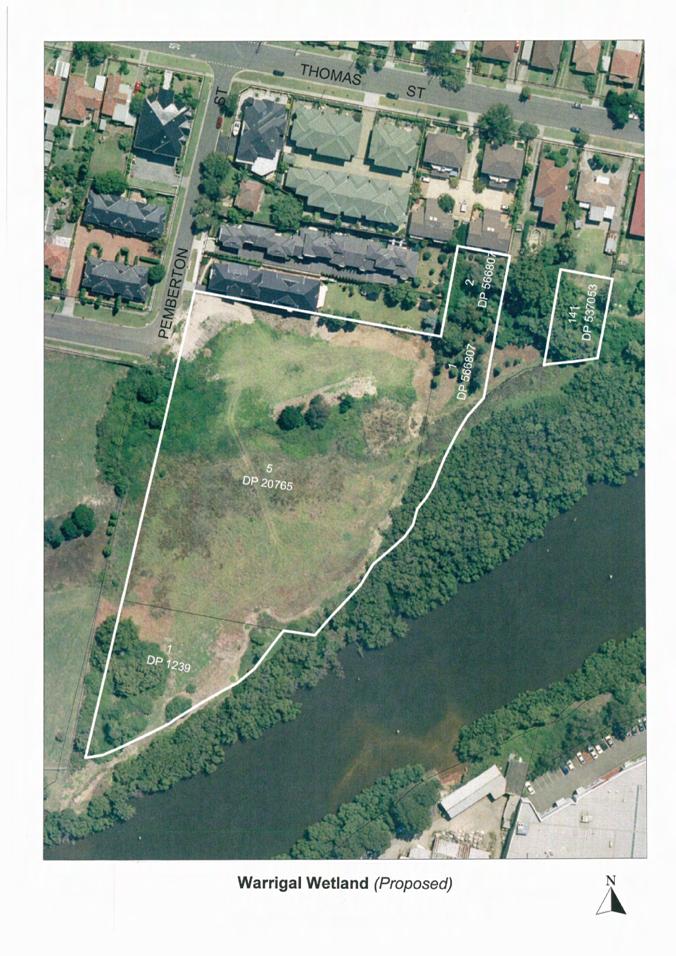
|
Attachment 3
|
Submission - J Kyle
|
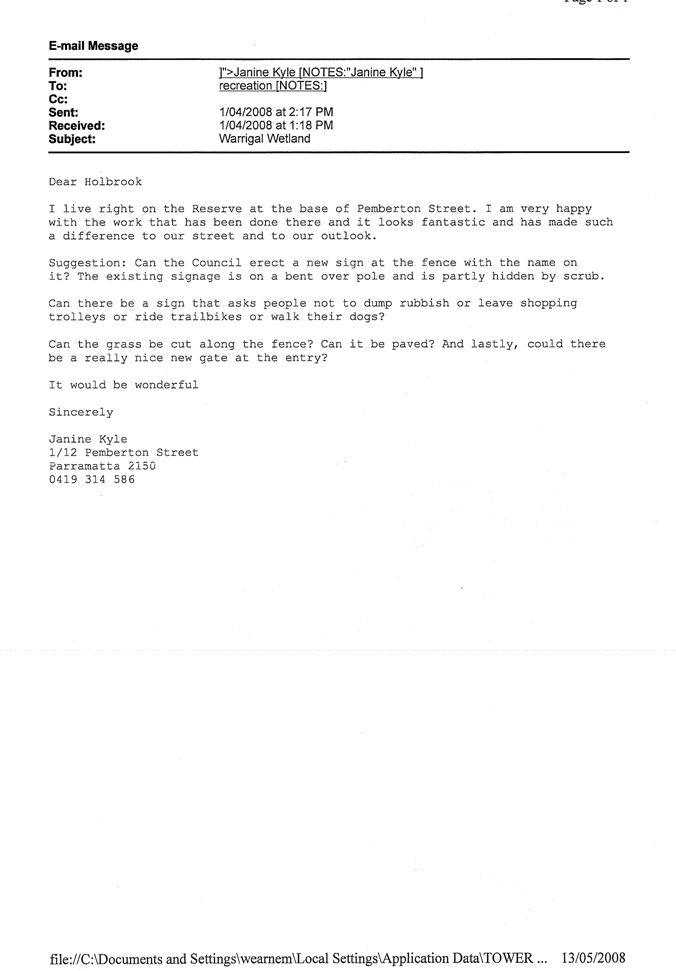
|
Ordinary Council 26 May 2008
|
Item 12.3
|
ITEM NUMBER 12.3
SUBJECT Naming
of an Unnamed Public Reserve in Guildford as Wadigora
Reserve
REFERENCE F2008/01238 - D00920417
REPORT OF Recreation Planner
|
PURPOSE:
This report proposes the name Wadigora Reserve
for the currently unnamed public reserve located on the Western side
of Campbell Hill Road
between Barbers Road and
the Sydney Water pipeline in Guildford.
|
|
RECOMMENDATION
(a) That
the proposal to name the unnamed public reserve on the western side of
Campbell Hill Road between Barbers Road and the Sydney Water pipeline in
Guildford as
Wadigora Reserve be endorsed in principle and be referred to the Geographical
Names Board of NSW for formal assignment under the Geographical Names Act
1966.
(b) That if approval is granted by the Geographical Names
Board, a park name sign be erected at the reserve, to be funded from the
parks maintenance budget.
(c) Further, that Ms
K Mealing and those persons who lodged a submission in relation to the naming
proposal be advised of Council’s decision.
|
BACKGROUND
1. Ms K Mealing from the Friends of
Duck River Bushcare group has requested Council to name the unnamed public
reserve located on the western side of Campbell
Hill Road between Woodville Golf Course
and the Sydney Water pipeline in Guildford, as
Wadigora Reserve. (Attachment 1)
2. The
proposed name ‘Wadigora Reserve’ is in recognition of the Duck
River (Wadigora) tribe who
inhabited the local area in the early 1800s following European settlement. Wadigora (also translated as Wadiora and Wategoro) means ‘woods place’ indicating that the clan was a ‘woods
tribe’. The Wadigora people were
probably descendants of the Burramattagal
who were forced to move as Parramatta
expanded.
This amalgamation resulted from the various clans being forced to join together
to provide mutual protection and to maintain viable social and economic units
due to the expanding European settlement.
3. The
reserve proposed to be renamed is approximately 14ha in size and comprises Lot
1 DP 217862, Lot A DP 161455, Lot 1 DP 503680, Lot A DP 405819, Lot 1 DP
219633, Lot 3 DP 3428, Lot 2 DP 217862, Lots B-C DP 409399, Lot 1 DP 986622,
Lot 4 DP 3428, Lot 1 DP 226836, Lot 2 DP 219633, Lot 2 DP 503680. (Refer Attachment 2) It is zoned
Environmental Protection as it contains remnant Shale Plains Woodland, a
sub-group of Cumberland Plain Woodland, which is identified as an Endangered
Ecological Community under the NSW Threatened Species Act 1995.
ISSUES/OPTIONS/CONSEQUENCES
4. A number of parks and reserves
within the Parramatta Local Government Area have been named in recognition of
their connection to the former Aboriginal custodians of the area. In view of
the size, location and significance of this public reserve it is appropriate
for it to have a formal name.
5. The proposed Wadigora Reserve
name is supported in view of the important connection that the original
Aboriginal custodians had with this reserve and the local area. The name
complies with the NSW Geographical Names Board’s ‘Guidelines for Place Names’,
as it prefers the use of Aboriginal place names.
CONSULTATION & TIMING
6. Letters were forwarded to
residents in the nearby local area, inviting them to comment on the proposal.
As the name is of Aboriginal origin, the Gandangara Local Aboriginal Land
Council (LALC) was also invited to comment.
7. A number of submissions were
received during the consultation period, from local residents supportive of the
proposed name, and no suggestions were received for alternative reserve names. (Attachment 3)
8. As the name is of Aboriginal
origin, Council’s Aboriginal Heritage Natural Resources Officer Stefan Jaeggi
was consulted regarding the proposal, and also supports the proposed name.
9. One of the submissions received
requested Council to conduct a traditional smoking ceremony to pay respects to
the spirits that once lived on the land in the reserve. Council’s Aboriginal
Heritage Natural Resources Officer, and Aboriginal and Torres Strait Islander
Capacity Building Officer will liaise with Gandangara LALC regarding this
request.
Troy
Holbrook
Recreation
Planner
12
May 2008
Attachments:
|
1View
|
Wadigora Reserve Naming Request - K Mealing
|
1 Page
|
|
|
2View
|
Map of Proposed Wadigora Reserve
|
1 Page
|
|
|
3View
|
Submissions
|
3 Pages
|
|
REFERENCE MATERIAL
|
Attachment 1
|
Wadigora Reserve Naming Request - K Mealing
|
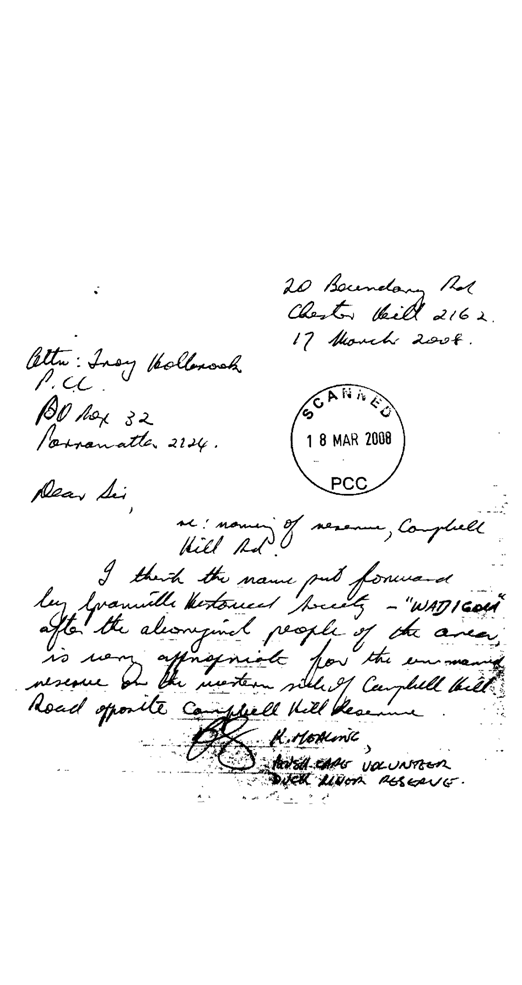
|
Attachment 2
|
Map of Proposed Wadigora Reserve
|
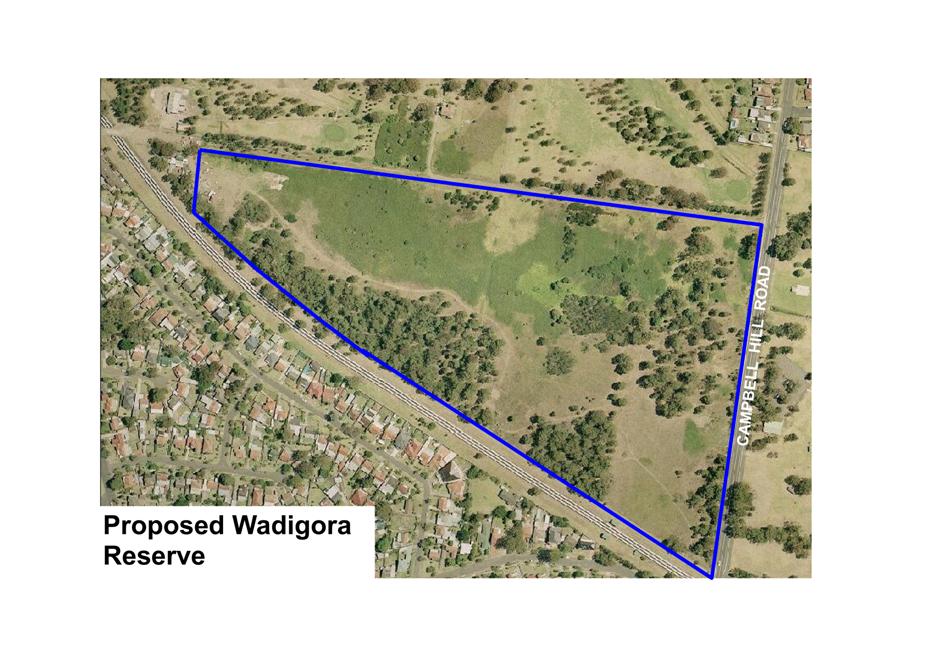
|
Ordinary Council 26 May 2008
|
Item 13.1
|
ITEM NUMBER 13.1
SUBJECT Parramatta Liquor Accord
REFERENCE F2007/01888 - D00919356
REPORT OF Service
Manager Community Capacity Building
|
PURPOSE:
This report is
provided in response to a request from Council for urgent information
pertaining to the Parramatta Liquor Accord. The Report outlines the
operations of the Parramatta Liquor Accord, and those actions undertaken by
the City of Sydney
Liquor Accord. It also outlines the nexus between the newly adopted City Centre
Crime Prevention Plan on the Parramatta Liquor Accord.
|
|
RECOMMENDATION
That
Council receive and note the contents of the report.
|
BACKGROUND
Report
1. At
it’s regulatory meeting on 21
April 2008, Council requested an urgent report
containing information in regard to the Parramatta Liquor Accord. The request also asked for information
regarding the City of Sydney Liquor Accord and
its operation.
Liquor
Accords
2. According to the Office of Liquor, Gaming and Racing (OLGR), “A
liquor accord is an agreement to take certain actions in local communities
which aim to improve safety in entertainment areas and reduce alcohol related
anti-social behaviour, offences and violence”.
Liquor Accords are aimed at taking a proactive and preventative approach
to issues that may be related to licensed premises.
3. It is important to note
that Liquor Accords are voluntary in nature and are usually established by
Council and/or the Police Local Area Command and/or an interested licensee.
PARRAMATTA LIQUOR ACCORD
4. The Parramatta Liquor Accord
was established on 31 October 2002.
5. The
principles of the Parramatta Liquor Accord are as follows:
· Responsible Service of
Alcohol
· Improving Safety and
Security
· Commitment to Being Good
Neighbours
· Co-operating with the
Police and Community to Improve Local Outcomes
6. In 2008 the
Parramatta Accord comprises 57 licensed venues as well as the Police Local Area
Command, NSW Health, Council and the Office of Liquor, Gaming and Racing. The licensee membership includes hotels, clubs,
restaurants and bottle shops across the Parramatta Police Local Area Command.
7. The Parramatta Accord
is administered by an Executive Group that meets bimonthly to discuss issues
impacting members and the community and to also plan events and initiatives to
be supported by the Accord.
8. The
Executive Group is Chaired and resourced by the Parramatta Leagues Club. It
consists of representatives from Parramatta Police Local Area Command,
Parramatta City Council (Service Manager, Community Capacity Building,
Legal Services Support Officer and Road Safety Officer), representatives from
hotels, clubs and bottle shops as well as other Government Departments.
9. The
Executive Group is active in encouraging membership of the Accord from all
licensed premises throughout the Parramatta Local Government Area. One way in which Council contributes to the
promotion of the Parramatta Accord is via the provision of information about
the Parramatta Accord to all applicants and re-applicants for ‘Place Of Public
Entertainment’ (POPE) licenses.
10. All
new member venues are provided with an ‘Accord Kit’ that provides details of
the Accord policies and principles, signage and information brochures for
patrons and staff.
11. Unlike
many other Accords, and to encourage participation in the Accord, there is no
fee charged for membership. Operational expenses for the Accord are met by
Executive Group members through sponsorship, subsidy or in-kind support. The Parramatta Leagues Club contributes
significantly to the operational expenses of the Parramatta Accord.
12. Initiatives
undertaken by the Parramatta Accord include information sessions for members
and non-members, network breakfasts, meetings with representatives of late
night venues to establish communication channels, distribution of advertising
materials promoting local Drug and Alcohol Help Lines, and regular email dispatches
to members including regular updates from the Office of Liquor, Gaming and
Racing.
13. During 2005, 2006 and 2007 the Accord’s
network breakfasts have included themes such as; “Compliance
+ Community + Co-operation”, with information sessions focusing on topics
such as ‘Compliance’, ‘Drink Spiking’ and ‘Smoke-Free Environment’.
14. Further, the Parramatta
Leagues Club and the Parramatta Accord have been the venue/hosts for several Office of Liquor, Gaming and Racing Regional Accord Conferences and Forums. The
next Regional Conference will be held at Parramatta Leagues Club on Wednesday 11 June 2008. The event will
be funded and hosted by Parramatta Accord and the Parramatta Leagues Club.
15. Items for discussion on the
Agenda of Parramatta Accord meetings usually include updates from the Licensing
Police regarding current trends and initiatives, feedback on cooperative
initiatives between the Police and licensed venues, information sharing between
venues in regard to security arrangements and incident and patron management as
well as issues arising from changes to policy or legislation by the Department
of Liquor, Gaming and Racing or other relevant agencies.
16. Parramatta
Accord members were invited to participate in the development of the City Centre
Crime Prevention Plan. This opportunity was offered via one of the Accord’s
Networking Breakfasts. In addition, the Parramatta Accord Executive Group
provided particular input into the plan.
17. The
Executive Group has also provided input and support to Council’s Shuttle Bus
Project. Members have expressed a strong interest in exploring the potential to
expand such a service to operate after hours with a view to enhancing the
safety of people moving through the CBD after dark. This would obviously include
a number of patrons of Parramatta Accord members. This concept is in accord
with recommendations contained within Council’s City Centre Crime Prevention
Plan (see below).
CITY CENTRE CRIME PREVENTION PLAN
18. As
mentioned previously in this report, Parramatta Accord members were invited to
participate in consultations regarding the development of Council’s recently
adopted City Centre Crime Prevention Plan. GHD Consulting attended a Liquor
Accord Management Group Meeting and also held a specific consultation with
Liquor Accord members.
19. The
actions of the City Centre Crime Prevention Plan consider the need to review
the existing Liquor Accord arrangements. Further the plan recommends that the
Liquor Accord members will need to be engaged in the development and delivery
of safer late night transport within the CBD, particularly in regard to
licensed premises.
20. This
and the other actions from the City Centre Crime Prevention Plan will form the
priority actions and work plan for the Crime Prevention Coordinator once
appointed.
CITY OF SYDNEY LIQUOR ACCORDS
21. A
literature review of the City of Sydney Licensing Accord agreements, promotional materials and minutes of the Accord meetings
has yielded the following information.
22. Due
to its geography and large number of licensed premises, the City Of Sydney participates in a
number of Liquor Accords (referred to as Licensing Accords) across the Sydney City area. Active
Accords in the City of Sydney are: CBD, South Sydney, Surry Hills and Sydney City North. Accords in the process of being
established are: Newtown and Glebe.
23. These
Accords meet on a semi-regular basis, generally every two months.
24. Although
worded slightly differently, the principles of the Accords in the City of Sydney are on par with
those of the Parramatta Accord. For example, the principles of the Sydney CBD
Liquor Accord has the following aims:
· To reduce alcohol
related crime in and around licensed premises
· To improve the
perception of the safety and appeal of the Sydney CBD area
· To build relationships
between licensees, the Police and other Stakeholders
25. The
Licensing Accords in the City of Sydney appear to have
much the same focus as Parramatta’s including providing information seminars to members, promoting safe
use and responsible service of alcohol and coordination between venues, Council
and the Police.
26. The
Licensing Accords in the City of Sydney also provide promotion of the City’s
‘Safe City Education Campaign’ by distributing information to patrons on issues
such as theft of personal items and drink spiking.
Lisa Giacomelli
Service Manager – Community Capacity Building Team
Attachments:
There are no
attachments for this report.
REFERENCE MATERIAL
|
Ordinary Council 26 May 2008
|
Item 13.2
|
ITEM NUMBER 13.2
SUBJECT Aboriginal
and Torres Strait Islander Advisory Committee
REFERENCE F2005/01941 - D00931863
REPORT OF Community Capacity Building Officer
|
PURPOSE:
The Aboriginal and
Torres Strait Islander Committee met on 1st April 2008. This report provides a précis of the key
discussion points of that meeting for Council’s consideration.
|
|
RECOMMENDATION
(a) That the minutes of the Aboriginal and Torres Strait Islander
Committee held on 1st April 2008 (Attachment 1) be received and noted.
(b) That Council endorses the Committee’s
resolution to write to the Honourable Ms Julie Owens, expressing their
disappointment and concerns regarding aspects of the Northern Territory
Intervention.
(c) That
Council endorses the Committee’s resolution that all advertising and promotion
of the Burramatta NAIDOC Family Day and Flag Raising be managed by Council’s
Events Team.
(d) Further,
that Council note there are no requests for additional expenditure in this
report.
|
BACKGROUND
1. Parramatta
City Council’s Aboriginal and
Torres Strait Islander Committee meets monthly. The Committee currently
comprises fifteen members representing a variety of interests.
2. Council’s Aboriginal and Torres Strait
Islander Committee met on 1st April 2008. This report provides a summary of the key
discussion points of that meeting for Council’s consideration.
MAIN DISCUSSION POINTS
The
main issues discussed at the meeting were as follows:
The Northern
Territory Intervention:
(a) Members discussed aspects of the Northern Territory Intervention. In particular the Committee noted their
concerns regarding the suspension of the Commonwealth Racial Discrimination Act
and the impact of the intervention on the human rights of Indigenous
communities.
(b) The Committee resolved to recommend to Council that the
Committee write to the Honourable Ms Julie Owens, expressing their
disappointment and concerns regarding aspects of the Northern Territory
Intervention.
Meeting Practice:
(a) Members discussed the importance of following accepted meeting practice
and of abiding by Council’s Code of Conduct to ensure that all Committee
members were able to fully participate and thus encouraging all members to
attend meetings.
(b) The Committee identified a number of strategies to assist it to
operate in an effective manner including reviewing relevant aspects of the
Committee’s Terms of Reference and Council’s Code of Conduct at the beginning
of each meeting and identifying and adopting strategies to manage difficult
discussions and agenda items.
ATSI
Community Project Officer:
Committee members were advised that the ATSI
Community Project Officer had been appointed and would be commencing with the
Community Capacity Building Team on 14 April 2008.
NAIDOC:
(a) The Committee continued to plan the
Burramatta NAIDOC Flag Raising event and Family Day. The Committee focussed
some discussion on the provision of entertainment which they agreed would
include entertainers of interest to different age groups.
(b) Council’s Events Co-ordinator Tanya
Bigeni, presented the marketing and promotional plan to the Committee. The plan
includes paid advertisements in local print media and the Koori Mail newspaper;
free media including community newsletters and distribution of flyers and
posters through Members networks.
(c) The Committee discussed promoting Stalls
at the Burramatta NAIDOC Family Day and agreed that whilst not for profit and
community groups would have access to free stalls, government and business
stall holders would be charged $100.
(d) In order to ensure that Council’s
communication protocols were adhered to, the Committee resolved that all advertising
and promotion of the Burramatta NAIDOC Family Day and Flag Raising be managed
by Council’s Events Team.
Attachments:
|
1View
|
Agenda Aboriginal and Torres Strait Islander
Advisory Committee 1st April 2008
|
2 Pages
|
|
|
2View
|
Minutes Aboriginal and Torres Strait Islander
Advisory Committee 1st April 2008
|
5 Pages
|
|
Maggie Kyle
Community Capacity
Building Officer
|
Attachment 1
|
Agenda Aboriginal and Torres Strait Islander Advisory
Committee 1st April 2008
|
|
EXECUTIVE
Committee Members
|
Committee Members
|
|
|
|
|
|
Bruce Gale - Chairperson
Gilson Saunders
Linda McDonald - Secretary
Doug Desjardines
John Robertson – Deputy
Chair
June Magrath
|
Phillip Bradley
Marcia Donovan
Annie Nielsen
Phil Russo
Anne Castles
Alan Merriman
|
David Williams
Murray Castles
Lyn Leerson
Edna
Watson
Kerrie
Kenton
|
ABORIGINAL & TORRES STRAIT ISLANDER ORGANISATIONS IN PARRAMATTA & THE TRIBAL DHARUG
AREA
Dharug Custodian
Aboriginal Corporation
Darug Tribal Aboriginal
Corporation
Gandangara
Local
Aboriginal
Land
Council
Deerubbin
Local
Aboriginal
Land
Council
Metropolitan
Local
Aboriginal
Land
Council
NSW
Aboriginal
Land
Council
AIM & OBJECTIVES
1 To represent the views and interests of
Aboriginal and Torres Strait Islander people in Parramatta, and provide
advice, input and feedback in the development of Parramatta City Council’s
(PCC) social policy and strategic plans.
2 To ensure Council directions and policies
conform to Aboriginal and Torres Strait Islander communities’ needs and
requirements, within the parameters of PCC authority and responsibilities.
3 To provide a vital link between the
Aboriginal and Torres Strait Islander communities’ of Parramatta, and
Parramatta City Council, and to encourage and support their participation in
local activities.
ABORIGINAL
& TORRES STRAIT ISLANDER ADVISORY COMMITTEE (ATSI)
NOTICE OF MEETING
Tuesday 1st April 2008 – 6.30pm to
8.00pm
Level 12, Darcy Street
Parramatta
|
ABORIGINAL & TORRES STRAIT ISLANDER
ADVISORY COMMITTEE (ATSI)
NOTICE OF MEETING
Tuesday 1st April 2008 – 6.30pm to
8.00pm
Level 12, Darcy Street
Parramatta
|
|
AGENDA
TOPIC
|
ATTACHMENTS
|
|
1.
|
Acknowledgement of the Traditional Owners
- The Dharug People
|
|
|
2.
|
Welcome and Introductions
|
|
|
3.
|
Apologies
|
|
|
4.
|
Conflict of Interest Declarations
|
|
|
5.
|
Confirmation of Minutes 4th March 2008
|
Attachment 1a
|
|
6.
|
Business Arising
|
|
|
7.
|
NAIDOC 2008 Decisions and Actions
|
|
|
8.
|
General
Business & Information Sharing
|
|
|
9.
|
Close
|
|
|
Attachment 2
|
Minutes Aboriginal and Torres Strait Islander Advisory
Committee 1st April 2008
|
MINUTES OF THE ABORIGINAL AND TORRES STRAIT ISLANDER
ADVISORY COMMITTEE MEETING HELD IN ROOM 1, GROUND FLOOR, COUNCIL CHAMBERS,
PARRAMATTA ON TUESDAY,1st APRIL 2008 AT 6.20 PM.
__________________________________________________________________________
PRESENT
Mr Bruce Gale (in the Chair), Linda McDonald, June Magrath, Marcia Donovan,
Phil Russo, Anne Castles, Lyn Leerson, Kerrie Kenton, Phillip Bradley and Clr
Maureen Walsh.
IN
ATTENDANCE
Ms Maggie Kyle – Community Capacity Building
Officer; Tanya Bigeni – Events and Project Officer, Elise Mawhood – Minute
taker, Vikki King – Manager Social and Community Services.
MINUTES
1 ACKNOWLEDGEMENT OF TRADITIONAL
OWNERS THE DHARUG PEOPLE
Bruce Gale did an Acknowledgment of Country recognising that the land
upon which the meeting was being held is Dharug and paying respect to Elders
past and present.
2 WELCOME & INTRODUCTIONS
The committee
welcomed Anne Stonham and Greg Stonham to the meeting as observers.
3 APOLOGIES
Apologies were received and accepted for the absence of John Robertson,
Gilson Saunders, Doug Desjardine, Bettina King and Stephan Jaeggi.
4 CONFLICT OF INTERESTS
No conflicts of interest noted.
5 CONFIRMATION OF MINUTES
A copy of the minutes of the Aboriginal and Torres Strait Islander
Advisory Committee Meeting held on 4 March 2008 had previously been forwarded to each member.
Amendments to the Apology list were made to include Phil Russo.
RECOMMENDATION
The report of the
Aboriginal and Torres Strait Islander Advisory Committee Meeting held on 4 March 2008 be taken as a true record of the meeting.
6 BUSINESS ARISING
6.1 Lyn Leerson provided an update regarding
the Northern Territory Intervention: Lyn
Leerson and Annie Neilson had met with the Honourable Julie Owens, Member of
Parliament and discussed the Northern Territory Intervention. Lyn Leerson expressed her concerns about the
outcomes of that meeting and as a result the committee agreed to prepare a
letter to the Honourable Julie Owens Member of Parliament.
RECOMMENTATION
Lyn Leerson in
conjunction with Maggie Kyle, and on behalf of the ATSI Advisory Committee will
prepare a letter to Julie Owens, expressing the Committee’s disappointment and
serious concerns regarding aspects of the Northern Territory Intervention, in
particular the suspension of the Commonwealth Racial Discrimination Act and the
impact of the Intervention on the human rights of indigenous communities.
6.2 Bruce Gale advised the Committee that the
raising of the Aboriginal flag in conjunction with the Australian flag, at the
Greek Flag raising ceremony was a great success. Bruce Gale and June Magrath
had attended the event. It was suggested that Aboriginal dancers could form
part of the 2009’s Greek flag raising.
6.3 Vikki King, Manager Social and Community Services, brought to the attention of the Committee
the reported behaviours of some members at the last ATSI Advisory Committee
meeting. Vikki King advised that meetings of the Committee must follow accepted
meeting practice and abide by Council’s Code of Conduct. Members agreed that the behaviour displayed
at the previous meeting was not acceptable.
Further, members identified that behaviour by some members appeared to
be having a negative affect on attendance, particularly by Aboriginal
members. Vikki King suggested that the
Committee further discuss this issue and consider further investigating
inconsistent attendance of members.
Members identified a number of strategies to
support the Committee operate in a more effective manner including:
(a) Review relevant
aspects of the Committee’s Terms of Reference and Council’s Code of Conduct at
the beginning of each meeting
(b) Identify and agree to adopt strategies to
manage difficult discussions/ agenda items
(c)
Consider engaging an external Aboriginal facilitator to conduct meeting
facilitation training with the Committee or who could facilitate Committee
meetings
(d)
Undertake some cross cultural training
for all members of the ATSI Committee and those that resource it
6.4 Maggie Kyle advised that the Aboriginal Project Officer would be
commencing on 14 April 2008 and that a meeting
would be set up to introduce them to Bruce Gale, Chairperson of the Committee,
within the Officer’s first two weeks in the position.
7. NAIDOC 2008 DECISIONS AND ACTIONS
7.1 Maggie Kyle reviewed the decisions made
by the Committee in the Burramatta NAIDOC Planning Workshop held on 5 February 2008 and the Committee meeting held on 4 March 2008 including the agreed principles of Burramatta
NAIDOC activities:
(a) Events and activities will celebrate
Aboriginal people, culture and history and promote cultural pride.
(b) There will be a focus on family
with activities and events for children, young people and adults.
(c) Events would be free.
(d) Events would be
alcohol and drug free.
(e) A number of events
will be held. The main events are the Family Day and Flag Raising ceremony. There
will also be a number of smaller events including mall performances,
workshops for children and young people in the library, and an art exhibition.
(f) The NAIDOC budget would be used for Burramatta Family Day and the
NAIDOC Flag Raising ceremony. The
other lead up events would be funded from different program budgets.
7.2 Maggie Kyle informed the Committee that
the Historic Houses Trust are currently talking to Michelle Desailly and
Stephan Jaeggi about holding a NAIDOC activity at Elizabeth Farm. The Committee
would be provided with further information as this progressed.
7.3 Tanya Bigeni updated the committee on the entertainment for
Burramatta NAIDOC Family Day which will be based on the 2007 program. The Committee agreed on the following:
(a) The Committee is enthusiastic about the prospect of Sean Chooburra
being available to MC the event.
(b) The Committee agreed to engage more performers that young people
would enjoy including Hip Hop.
(c) An Aboriginal contractor will be engaged to film the event and record
people’s comments about the event. This footage could be utilised as part of
the evaluation of the event, supplementing the written evaluation forms.
Tanya Bigeni will provide a program of entertainers at the next meeting.
The Executive Committee will advise the Committee on whether any dance
troupe engaged needs to have each member identify as Aboriginal or Torres
Strait Islander.
7.4 Tanya Bigeni
provided an update on the marketing and promotion for Burramatta NAIDOC:
(a) Marketing will
start around the 9th June 2008 and strategies will include: a DL flyer for direct marketing; street banners
placed at the corners of Parramatta Pools, Riverside, Prince Alfred Park and on
city flag poles; posters placed around the city in as many venues as possible
including businesses, not for profits and community notice boards.
(b) Tanya will contact City Rail regarding displaying Burramatta NAIDOC
posters.
(c) The Committee discussed the strategic placement of posters/banners on
city entry points including the M4, Victoria Road and the Rose Hill Race
Course.
Tanya will contact the Roads and Traffic Authority regarding placing a
notice on the M2.
(d) As in previous years, press releases will be distributed to all local
newspapers and free communication outlets/ channels. Paid advertisements will
be placed in the Koori News, Parramatta Advertiser and Koori Radio.
Press releases will be sent to the Honourable Laurie Ferguson and the
Honourable Julie Owens, Members of Parliament, who will be asked to place these
in their community newsletters.
(e) Burramatta NAIDOC will also be promoted through websites including
ANTAR, National NAIDOC, South Western Sydney Koori interagency, Western Sydney
Koori interagency and Parramatta City Council. Michael Dagostino and Andrew
Overton will be asked to assist Tanya Bigeni to identify suitable arts and
cultural websites.
(f) It was agreed that an important marketing and promotion strategy is
to distribute notice of the event through community networks, groups and
inter-agencies. Committee members could play an important role in this. Tanya
Bigeni will prepare a pdf version of the flyer and posters so Committee members
can distribute through their networks.
Committee members wishing to promote or advertise the event through other
channels will contact Tanya Bigeni to ensure the material they supply is
accurate. Tanya Bigeni’s email address is: t.bigeni@parracity.nse.gov.au
RECOMMENDATION
Any advertising,
promotion of the Burramatta NAIDOC event will be managed by Tanya Bigeni,
Events Project Officer, to ensure consistent messaging and branding.
Clr Maureen Walsh noted that the promotion in 2007 was a significant
improvement on previous years and acknowledged Tanya Bigeni and the Committee’s
achievements.
7.5 The Committee
discussed the allocation of stalls including:
(a) Tanya Bigeni
explained that whilst not for profit and community groups will be
not be charged for stalls, commercial
and government stalls business will be charged $100.00.
(b) Stall holder application forms were distributed to members and Tanya
Bigeni will email a pdf version to members. It was agreed that completed
applications would be presented to the Committee at the June 2008 meeting for
members to determine stall allocation. It was noted that individual members
cannot approve stall applications.
(c) Members agreed that the Committee would have a stall to promote its
role to the community and attract potential members.
7.6 Tanya Bigeni
informed members that Westfields had been approached regarding sponsorship
however they have not yet responded. An update on sponsorship will be provided
at the April meeting. Members suggested that Streets Ice Cream and the NSW Police also be approached as potential
sponsors.
8. GENERAL BUSINESS
8.1 Clr Walsh described contact she had recently had
with the Mayor of Palm Island who is seeking assistance with the Island’s direction and
strategy.
8.2 June McGrath attended the opening of the
Attorney Generals Parramatta building and met the Assistant Project Officer of
the Norimbah Unit which is responsible for Aboriginal recruitment in NSW
Attorney General’s Department. Mark Wenburg would like information about the
ATSI Advisory Committee. Maggie Kyle will follow up with Mark and forward
information.
8.3 Maggie Kyle distributed information on an
exhibition at Campbelltown Regional Art Gallery: ‘My Father, My Brother Stories of Campbeltown’s Aboriginal Men’. The
opening is on Friday 11th
April 2008 at 2.30pm.
8.4
Lyn Leerson requested the exhibition of photos of famous Aboriginal people that
was collected for 2007 Burramatta NAIDOC, be changed to focus on local
Aboriginal people. The Executive Committee was asked to consider this proposal
and whether to develop it into a project. It was noted there would be a number
of issues to consider including applying for funding, storing the collection.
If the Executive Committee recommends this project should proceed, the
Committee would approach Michael Dagostino and Andrew Overton from Council’s
City Culture, Tourism and Recreation Team for advice and support.
8.5 Maggie Kyle advised members that as part
of 2008 Burramatta NAIDOC planning, she was discussing with the library
displaying the collection of photos and brief biographies of famous Aboriginal people collected in 2007.
8.5 Maggie
Kyle advised members that the Community Development and Support Expenditure
Grants were open until 11 April 2008 and requested members advise Aboriginal
programs and services.
8.6 A
flyer was tabled regarding a sports clinic for adults providing sports programs
with children/ young will be held in Matraville on 19 April 2008 between 10.00am – 3.00pm.
Next Meetings
ATSI Advisory Executive Meeting
22nd April 6:00 -7:00 pm
Council Chambers
ATSI Advisory Committee Meeting
Including Burramatta NAIDOC planning
29 April 2008
The Meeting concluded at 7: 55
|
Ordinary Council 26 May 2008
|
Item 13.3
|
ITEM NUMBER 13.3
SUBJECT Arts
Advisory Committee Meeting 8 April 2008
REFERENCE F2005/01943 - D00933548
REPORT OF Community Capacity Building Officer
|
PURPOSE:
The Arts Advisory
Committee met on 8th April 2008. This report provides a précis of the key
discussion points of that meeting for Council’s consideration.
|
|
RECOMMENDATION
(a) That Council note the Minutes of the
Arts Advisory Committee meeting held on 8th April 2008 (Attachment 1).
(b) That
Council’s Events Co-ordinator responsible for Riverbeats attend the next
meeting to provide further information on the event in particular the
identification and selection of artists engaged in the event.
(c) That
Council note the Committee’s
request that the Riverbeats event continue to engage local artists.
(d) That the Committee thanked the Service
Manager, Major Events for attending the meeting and providing an informative
presentation to the Committee.
(e) Further,
that Council note there are no
requests for additional expenditure in this report.
|
BACKGROUND
1. PCC’s
Arts Advisory Committee meets every second month. The Committee currently
comprises fifteen members representing a variety of interests.
2. The
Arts Advisory Committee met on 8th
April 2008. This report provides a précis of the
key discussion points of that meeting for Council’s consideration.
MAIN DISCUSSION POINTS
3. The
main issues discussed at the meeting were as follows:
4. Report
on the inaugural Arts Advisory Committee Workshop
(a) Members
discussed the inaugural Arts Advisory Committee Workshop presented by Gay
Hendrikson which focussed on the ‘Convict Women’ Exhibition. The Workshop was
held at the Artists Studios and members found the presentation interesting and
informative.
(b) Members
agreed that written records of the Workshops would be limited to a brief
paragraph prepared by the presenter and a record of any questions raised during
the Workshop. It was also agreed that any handouts provided in the Workshop
would be presented to the minute clerk who would then email them to all
committee members.
5. Presentation
by Service Manager, Major Events
(a) The
Service Manager, Major Events attended the meeting and delivered a presentation
which included information on the composition of the Events Team, how events
are programmed and the team’s aims and objectives.
(b) Information
on Council’s 2006 review of major events was provided including the alignment
of objectives of major events to Council’s Twenty25 plan.
(c) The
planning and evaluation processes used by the Events Team were outlined and it
was acknowledged that the Team was keen to utilise the expertise of committee
members in these processes.
(d) The
Riverbeats event was discussed. In
particular the committee asked about how Council identified and engaged artists
for the event. The committee recommended the following in regard to this
matter:
· that further information
on Riverbeats be provided to them by the relevant Events Officer, and
· that Council note their
request to continue to engage local artists in this event.
6. Information
Share
Members shared information on a number of
exhibitions and events they had attended or were aware of including the Arab
Film Festival and Fearless at the Armoury.
Maggie Kyle
Community Capacity Building Officer
14 May 2008
Attachments:
|
1View
|
Agenda Arts Advisory Committee 8
April 2008
|
2 Pages
|
|
|
2View
|
Minutes Arts Advisory Committee 8
April 2008
|
5 Pages
|
|
|
3View
|
Report of Workshop 11 March 2008
|
1 Page
|
|
REFERENCE MATERIAL
|
Attachment 1
|
Agenda Arts Advisory Committee 8 April 2008
|
Your
Reference:
Our Reference: F2005/01943
Contact: Maggie Kyle
Telephone: 9806 5082
Fax: 9806 5914
31 March 2008
ARTS ADVISORY COMMITTEE
NOTICE OF MEETING
Room C, Level 2
Council Chamber Building
Civic Place, Parramatta
Tuesday, 8 April 2008
6.05 pm
MEMBERS OF COMMITTEE
|
Kathy Baykitch
|
Toni Courtelis
|
Jane Ho
|
|
Zachary Lambert
|
Lynn Lollback
|
Lena Nahlous
|
|
Mathew Poll
|
Patricia Prociv
|
Dr Ahmad Qasem
|
|
Judith Rowling
|
Val Squires
|
Debornah Walker
|
|
Jacqui Douglas
|
Katherine Knight
|
Shalini Patel
|
|
Dianne Turner
|
|
|
AIMS & OBJECTIVES
1 To assist in the review of the
Cultural Plan for the City of Parramatta by helping to
identify the kinds of activities, developments and experiences that exist and
are needed.
2 To assist in the development of a
Social Well-Being climate in which to grow and be recognised.
3 To promote the development of networks
and communication channels between artists, arts organisations and all levels
of government in the Parramatta area.
4 To assist in the development of a
broad and responsive program of arts and cultural development projects, and
advising on opportunities for arts infrastructure (including workshop spaces,
galleries, performance and rehearsal
venues, artist run spaces and public art projects).
5 To provide advice on applications for
Council’s Annual Cultural Grants Program.
AGENDA
1. Welcome.
2.
Confirmation of the Minutes of the Meeting held on 12
February 2008.
(Copy appended as Item 1).
3. Apologies.
4. Conflict of Interest Declarations.
5. Business
Arising.
6. Report back on inaugural Arts Advisory Committee Workshop/
Presentation 11 March 2008.
7. Presentation: Karly Smith – Manager PCC Events Team
8. Pre
Election Information for Potential Candidates – 2008 Local Government Election
by Graeme Riddell – Service Manager Council Support.
9. Information Share
10. Chair
for Next Meeting.
|
Attachment 2
|
Minutes Arts Advisory Committee 8 April 2008
|
MINUTES OF THE ARTS ADVISORY
COMMITTEE MEETING HELD IN ROOM C, LEVEL 2, COUNCIL CHAMBER BUILDING, CIVIC
PLACE, PARRAMATTA ON TUESDAY, 8 APRIL 2008 AT 6.10 PM
PRESENT
Patricia Prociv
in the Chair, Katherine Knight, Judith Rowling, Val Squires, Dianne Turner and
Caitlin Vaughn.
IN ATTENDANCE
Maggie Kyle - Community Capacity Building Officer, Karly
Smith – Manager PCC Events Team and Grant Davies - Minute Clerk.
1. WELCOME
Patricia Provic welcomed members to the meeting.
2. CONFIRMATION OF MINUTES
A copy of the report of the meeting of the Arts Advisory Committee held
on 12 February 2008 had previously been forwarded to each member.
RECOMMENDATION (Rowling/Knight)
The report of the
meeting of the Arts Advisory Committee held on 12 February 2008 be taken as read and be confirmed as a true record
of the meeting.
3. APOLOGIES
An apology was
received and accepted for the absence of Toni Courtelis, Jacqui Douglas, Gay
Hendriksen (Curator, Heritage Centre), Jane Ho, Lyn Lollback, Lena Nahlous,
Graeme Riddell (Service Manager – Council Support) and Deborah Walker.
4. CONFLICT OF INTEREST DECLARATIONS
There were no
conflict of interest declarations at this meeting.
5. BUSINESS ARISING
There
was no Business Arising.
6. REPORT ON INAUGURAL ARTS ADVISORY COMMITTEE WORKSHOP/PRESENTATION HELD
ON 11 MARCH 2008.
A brief report on
the inaugural workshop is appended to these minutes- Attachment 1.
Maggie Kyle
advised that future workshop notes would include those present, a brief
paragraph prepared by the presenter and any questions raised at the meeting.
It was also
agreed that any handouts provided at the meeting would be provided by the
Workshop presenter to the minute clerk who would then scan the documents and
email them to members.
7. PRESENTATION BY KARLY SMITH – MANAGER
PCC EVENTS TEAM
7.1 Karly Smith
outlined the composition of the PCC Events Team; how events are programmed,
what the Team aims to achieve and the main objectives for the Team.
The Events Team
consists of Karly Smith as Manager, a Marketing Sponsorship Co-ordinator (to
carry out marketing and promotion), 3 Events Co ordinators (responsible for
different components of events) and an Administrative Assistant.
The Team is
responsible for all major events and festivals (such as Australia Day, New
Years Day, NAIDOC and Riverbeats), sponsorship, community events and decorating
the city.
The Team can
offer support and advice regarding community events particularly regarding
issues such as risk and traffic. Geoff Miller, Community Events Co-ordinator,
is responsible for this work. It was noted that community events are often run
by a Committee for example the Rosella Festival and Waratah Festival.
Council also supported certain events by
contributing funding such as the Arab Film Festival, Sydney Festival and Chess
Festival.
In addition,
certain one off events are also held such as the Dragon Boat Races, World Youth
Day activities and Ride to Work Day.
7.2 In 2006, a
major events review was undertaken with a view to refocussing events to ensure
they were in accordance with the Council’s 2025 plan. The review included
consultation with Councillors, relevant experts and representatives from other
councils.
As a result of
the review, the major events objectives were developed. These include:-
(a) Engage people to be active in
the life of the city (Engagement/Involvement)
(b) Demonstrate and deliver a
diversity of life understandings and perspectives (Celebrate Diversity)
(c) Celebrate and promote urban
form and the natural environment through innovative use of place and space
(Creative use of Place)
(d) Encourage local creative
enterprise (Local Creativity)
(e) Boost the local economy both through the day
and night. This is by events resulting in increased sales/ activities of local
businesses.
Karly Smith also
noted that Council’s Civic Events Team, which operates out of the Lord Mayor’s
Office, is currently undertaking a similar strategic review and will align
itself to similar objectives.
7.3 Karly Smith
then outlined the strategic programming undertaken for each event which
included the identification of areas of each event that were working well and
achieving the desired outcomes, and those parts that were not working as well.
Karly Smith acknowledged that this was certainly an area where the expertise of
members of the Arts Advisory Committee could be better utilised.
7.4 Karly Smith
advised that Council was currently in year 3 of the Riverbeats roll out but
added that it was her preference to talk to the Committee prior to an event
rather than only to seek their input at the evaluation phase.
7.5 Judith
Rowling sought advice on the best course of action should the community wish to
carry out a festival, perhaps in partnership with Council.
Karly Smith
outlined the differing time schedules dependant on the necessity of arranging a
development application, risk and/or traffic strategies.
Karly Smith
stressed that no sponsorship budget existed within the Events Team’s budget.
However it was also noted that certain requests for events may be handled through
Council’s Community Grants scheme which is Co-ordinated by the Community
Capacity Building Team, whilst more significant events may require a report to
Council seeking financial assistance.
It was also noted
that funding may also be available from external bodies such as the Australia
Council.
7.6 The Committee
proceeded to discuss concerns in relation to Riverbeats. It was noted that
Katherine Knight had previously forwarded correspondence to Council outlining
her concerns.
Patricia Prociv
and Dianne Turner were particularly concerned about the perceived lack of local
connection by Riverbeats and the lack of engagement of local artists. They
raised the possibility of utilising artists from the Parramatta area and
possibly artists with a connection to the Artists Studio.
Karly Smith
thanked the Committee for its feedback which was important and added that
professional evaluations were carried out on Council’s events. Council’s
feedback for Riverbeats had indicated that the event was highly rated and supported.
Judith Provic
suggested that Riverbeats follow a similar model regarding engaging artists as
the Riverside Theatres uses: an excellent mix of international, Sydney based and local
artists are engaged. This mix had resulted in a flow on effect of increasing
audiences to amateur performances.
Karly Smith
responded that Riverbeats does and would continue to include local artists,
however, Council considers Riverbeats to be Parramatta’s signature
event and accordingly, larger scale performers would continue to be utilised.
Karly Smith will
ask Geoff Miller, Community Events Co-ordinator responsible for
Riverbeats, to be invited to a future
meeting to talk further about the event.
Recommendation (Turner/Squires)
(a) That Geoff Miller be invited to attend the next
meeting of the Arts Advisory Committee to provide information on the current
position with Riverbeats, especially in relation to the identification and
selection of artists for participation in this event.
(b) That the Committee’s views on the need for
local artist participation in this and future Council events be noted.
(c) Further, that Karly Smith be thanked for her
informative presentation to the Committee.
8. 2008 LOCAL GOVERNMENT ELECTION – PRE
ELECTION INFORMATION FOR POTENTIAL CANDIDATES
Mr Graeme Riddell,
Service Manager – Council Support had intended to present to the Committee on
this subject. However, the anticipated advice from the Department of Local
Government had not been forthcoming, and accordingly, Graeme had apologised for
this meeting and had requested the opportunity to meet in the near future with
the Committee.
9. GENERAL BUSINESS
Workshop Presentation by Judith Rowling
Judith Rowling
advised that it had been her intention to present to the October Workshop
however, due to a prior commitment, she advised that the presentation would now
be made to the August Workshop.
State of Community
Maggie Kyle
outlined a project that the Community Capacity Building Team was undertaking:
The State of the Community would describe the current state of Parramatta communities. In
addition to demographic information, it would also include findings from
community consultations. The consultant,
Ms Pat Johnson, wished to meet different persons who live in and were
connected to Parramatta.
It had initially
been proposed that Ms Johnson would attend the next meeting of the Arts
Advisory Committee, however, due to the full agenda, members decided that this
was now not possible.
Maggie Kyle will
inform Ms Johnson of the Committee’s decision. A meeting with Ms Pat Johnson
may now be called with individual members.
Apology for Next 2 Meetings
Katherine Knight
advised members that she will be unable to attend the next two meetings
(despite her desire to hear Geoff Miller’s proposed presentation). Her non
attendance would make it difficult for Jacqui Douglas to also attend. Judith
Rowling offered a lift home for Jacqui Douglas should this assist in her
attendance.
10 INFORMATION SHARE
Memories from the Past
Val Squires
displayed past copies of ArtsWest and Arts in Action as prepared by members of
the Arts Advisory Committee’s from the early 1990’s.
Arab Film Festival
Caitlin Vaughn
advised that the Arab Film Festival opening night will be held on Thursday 10 April 2008. The event was fully booked.
Fearless at the Armoury
Dianne Turner
advised that she had recently viewed Fearless at the Armoury and that it was
absolutely brilliant.
NEXT MEETINGS
Workshop/Presentation Meeting
Parramatta Park Project - Patricia Prociv
Tuesday 13 May 2008
Artists
Studios, Parramatta
Arts Advisory Committee Meeting
Tuesday, 10 June 2008, 6:00 pm
Room C, Level 2 Council Chambers Building
Civic Place, Parramatta
CHAIRPERSON FOR NEXT MEETING: Val Squires.
The meeting concluded at 7.40 pm.
|
Attachment 3
|
Report of Workshop 11 March 2008
|
RECORD OF THE ARTS ADVISORY
COMMITTEE WORKSHOP HELD AT THE PARRAMATTA ARTISTS STUDIOS,
HUNTER STREET PARRAMATTA, ON TUESDAY, 11TH MARCH AT 6.05PM
PRESENT
Judith Rowling,
Deborah Walker, Toni Courtelis, Jacqui Douglas, Katherine Knight, Lynn
Lollback, Gay
Hendrickson
IN ATTENDANCE
Maggie Kyle – Community Capacity Building Officer and Erin
Lottey - Minute Clerk.
WORKSHOP
Women Transported – Gay Hendrikson
and Lynn Lollback
Female factories in Australia and Parramatta and the women who experienced them.
1. INTRODUCTION
TO ARTS WORKSHOPS
The Council
officer welcomed those in attendance to the first Arts Committee Workshop,
“Women Transported”. The Council officer
advised that no formalities were required for these workshops, and that formal
apologies and minutes could thus be dispensed with.
Those present
agreed that a record of those in attendance, the topic and the presented should
be maintained, and appended to the record of monthly meetings. A short summary of the presentation should be
distributed at the meeting prior to the workshop by the person who will be
presenting the workshop. Should
committee members want to discuss anything arising from these workshops, it
will be the responsibility of the member to raise the issue at the next formal
meeting.
The workshop commenced at 7.15 pm.
NEXT MEETING
Arts Advisory Committee
Meeting
Tuesday 8 April 2008 6:00-7:30pm
Room C, Level 2, Council Chambers Building
Civic Place, Parramatta
|
Ordinary Council 26 May 2008
|
Item 13.4
|
ITEM NUMBER 13.4
SUBJECT Youth
Advisory Committee 9th April 2008
REFERENCE F2005/01948 - D00933620
REPORT OF Community Capacity Building Officer
|
PURPOSE:
The Youth Advisory
Committee met on 9th April 2008. This report provides a précis of the key
discussion points of that meeting for Council’s consideration.
|
|
RECOMMENDATION
That
Council receive and note the contents of this report.
|
BACKGROUND
1. Parramatta City Council’s Youth Advisory Committee meets
monthly. The Committee currently comprises fifteen members representing a
variety of interests.
2. Council’s Youth Advisory Committee met on 9th April 2008.
This report provides a summary of the key discussion points of that meeting for
Council’s consideration.
MAIN
DISCUSSION POINTS
The main discussion points at the meeting were as
follows:
Report of the Youth Advisory Committee’s Working
Group
(a) Information
was provided by the Council Officer on the meeting of the Committee’s Working
Group which was held on 1st
April 2008. The Working Group had progressed
planning of the Committee’s Youth Week event: Vox Pop which would record
interviews with young people in Parramatta.
(b) The Working
Group had identified the aims of the project which included providing young
people in Parramatta with
an opportunity to express their ideas and views and raise issues of concern for
them and promote young people in the community in a positive way.
(c) The
Working Group also identified possible venues to interview and film young
people. The majority of these venues were in and around Westfield Shopping
Centre and the Council Officer agreed to contact Westfield Management regarding
the proposal and, pending their agreement, develop a written proposal to
interview and film young people in this venue. (Attachment 3).
(d) The kind of
information to be collected from young people was also identified by the
Working Group and a number of questions were developed that would elicit the
information sought.
(e) The Working
group also identified that Vox Pop had the potential to develop into a larger
project and therefore agreed that they did not need to complete the project
within Youth Week or the school holidays.
|
1View
|
Agenda Youth Advisory Committee 9th
April 2008
|
2 Pages
|
|
|
2View
|
Minutes Youth Advisory Committee 9th
April 2008
|
3 Pages
|
|
|
3View
|
Westfields Proposal Youth Advisory Committee
|
2 Page
|
|
Maggie
Kyle
Community Capacity Building
Officer
|
Attachment 1
|
Agenda Youth Advisory Committee 9th April 2008
|
YOUTH ADVISORY COMMITTEE
NOTICE
OF MEETING
Mars
Hill Cafe
331 Church Street, Parramatta
Wednesday, 9
April 2008
5.30 – 7:00pm
MEMBERS
OF COMMITTEE
|
Susan Shi
|
Ivy Chen
|
|
Anna Dai
|
Nathan Kassas
|
|
Jessica Taylor
|
Muhammad Najibullah
|
|
Seulki Kim
|
Robert Shi
|
|
Jessica Vidigal
|
Michael Yuen
|
|
Brahmi Kumarasamy
|
Lisa Kim
|
|
Aninda Das
|
Laura Wilde
|
|
Astha Rajvanshi
|
|
AIMS & OBJECTIVES
1 To represent the views and interests
of young people in Parramatta, and provide advice, input and feedback in the
development of Parramatta City Council’s (PCC) social policy and strategic
planning.
2 To ensure Council directions and
policies conform to community needs and requirements, within the parameters of
PCC authority and responsibilities.
3 To provide a vital link between the
youth of Parramatta, and Parramatta
City Council and to encourage and support their participation in local
activities.
|
Attachment 1
|
Agenda Youth Advisory Committee 9th April 2008
|
 AGENDA
AGENDA
1. Acknowledgment of the Traditional Owners- The
Dharug People
2. Welcome and Introductions
3. Apologies
4. Conflict of Interest Declarations
5. Confirmation of minutes
6. Business Arising from Previous Minutes
7.
Youth Week Update
8. Information share
9. Other Business
|
Attachment 2
|
Minutes Youth Advisory Committee 9th April 2008
|
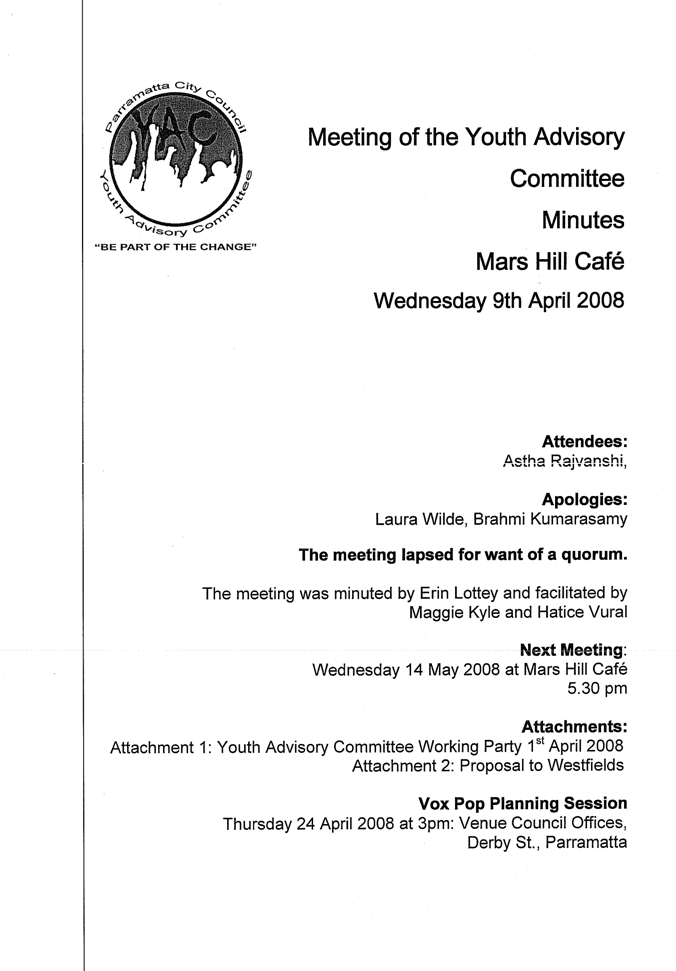
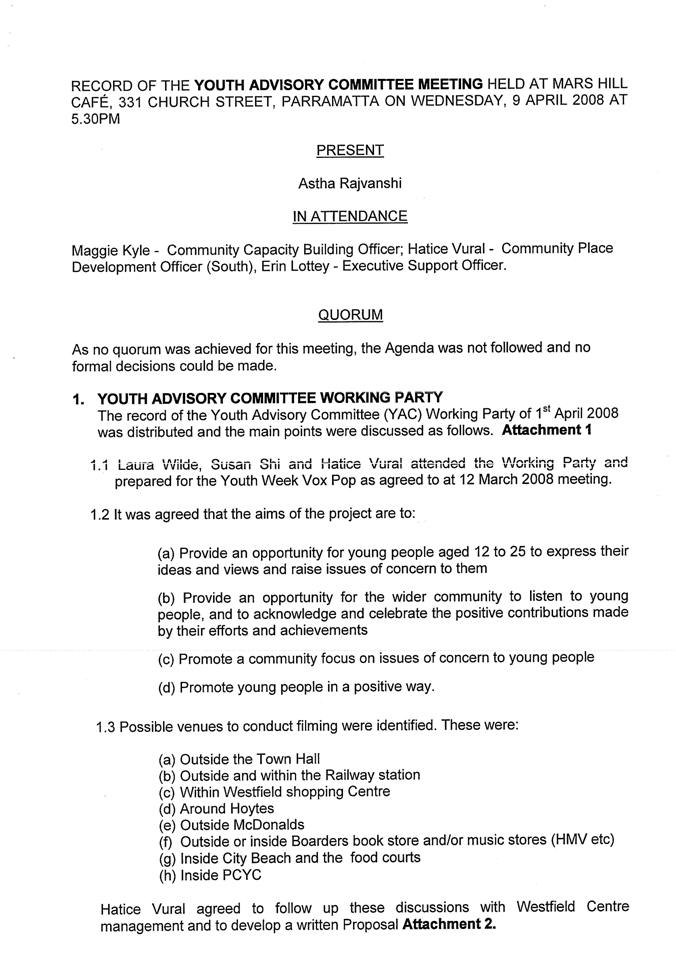
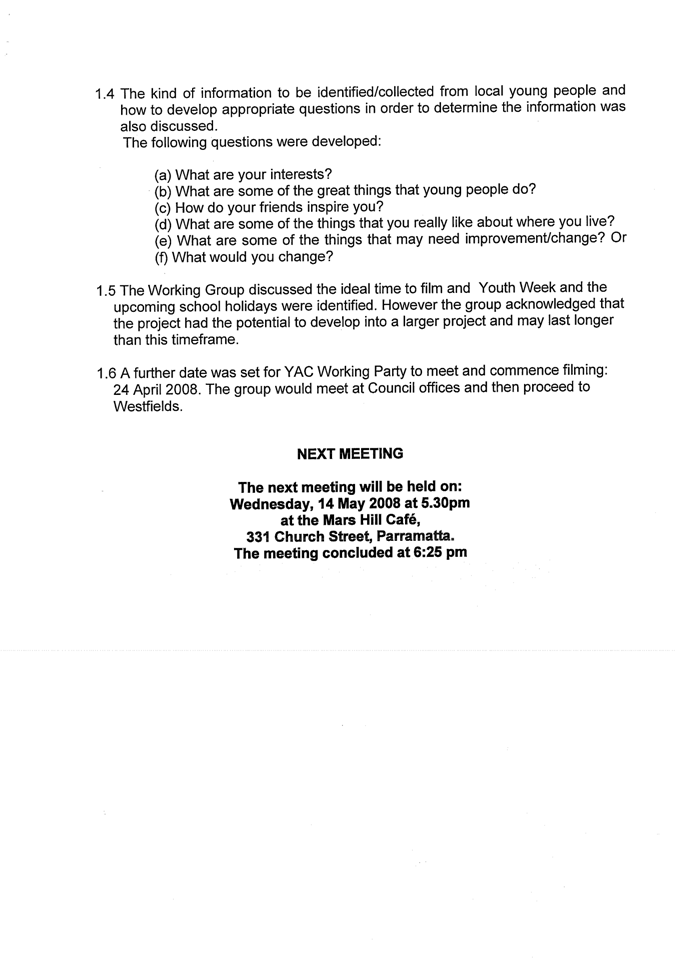
|
Attachment 3
|
Westfields Proposal Youth Advisory Committee
|
Proposal to Westfield
From Parramatta City Youth Advisory Committee
Project
A project developed
by young people who are members of the Parramatta City Youth Advisory Committee
in order to identify what is important to local young people aged 12 to 25
years. The information collected will be used to raise the profile of young
people while also highlighting their strengths, talents and ideas.
The Committee will be
filming interviews with young people in a Vox Pop style.
The Youth Advisory
Committee members will be supervised and assisted by two Parramatta City
Council Officers, Maggie Kyle and Hatice Vural on the day of filming.
The information will
be disseminated to community, Council and service providers and will inform
planning conducted by Council and services.
The aims of the
project are to
- Provide an
opportunity for young people aged 12 to 25 to express their ideas and views, raise issues of concern to them
- Provide an
opportunity for the wider community to listen to young people, and to
acknowledge and celebrate the positive contributions made by their efforts and
achievements
- Promote a community
focus on issues of concern to young people
- Promote young people
in a positive way.
Venues to conduct
filming
- Railway station
- Westfield
- Outside the movies
- Mc Donalds
- Boarders, music stores (HMV etc)
- City Beach, food courts
Questions/ Information to be gathered
The following
questions have been developed
- What are your interests?
- What are some of the great things that young people do?
- How do your friends inspire you?
- What are some of the things that you really like about where you live?
- What are some of the things that may need improvement/change?
When
- during school holidays (14 to 24 April) with the preferable day is
Thursday 24 April (after 3.30pm), with a view to accessing Westfield on two more
occasions in the future.
Risk Assessment
The group will be using no more than two hand held
DVD cameras, a couple of note pads and media release forms in order to comply
with relevant Privacy legislation.
|
Ordinary Council 26 May 2008
|
Item 13.5
|
ITEM NUMBER 13.5
SUBJECT Access
Advisory Committee
REFERENCE F2005/01942 - D00932023
REPORT OF Community Capacity Building Officer
|
PURPOSE:
The Access
Advisory Committee met on 1 April 2008. This report provides a précis of the key
discussion points of that meeting for Council’s consideration.
|
|
RECOMMENDATION
(a) That the Minutes of the Access
Advisory Committee meeting held on 1 April 2008 be received and noted.
(b) Further, that Council note that
there are no requests for additional expenditure in this report.
|
BACKGROUND
1. Parramatta
City Council’s Access Advisory Committee meets every second month. The
Committee currently comprises nine members representing a variety of interests.
2. Council’s
Access Advisory Committee met on 1
April 2008. This report provides a summary of the
key discussion points of that meeting for Council’s consideration.
ISSUES/OPTIONS/CONSEQUENCES
3. The main issues discussed at the meeting are as follows:
(a) Graeme Riddell, Service Manager Council Support, presented the
Committee with information regarding the upcoming Local Government Elections.
Graeme encouraged interested Committee members to attend Parramatta Council’s
‘Pre-Election Information Session’ on Wednesday 28 May 2008.
(b) The Committee was provided with a summary of
the Community Safety Advisory Committee’s ‘Positive Images of Parramatta’
project. Committee members then
discussed some of their positive and negative safety related experiences in Parramatta. These ranged
from a general feeling of safety in the LGA and CBD, to concerns for personal
security in the Church Street Mall and Council Chambers areas.
(c) The Committee advised that they would like
information about how they can be involved in access-related planning in
Granville. Donna Mosford agreed to follow up this request with Neile Robinson,
Place Manager for Granville, to request further information.
(d) The Committee requested that Donna Mosford
contact John Raymond one final time to confirm his request to terminate
membership on the Access Advisory Committee.
(e) The Committee was advised that nominations for
the National Disability Awards 2008 were open and members were encouraged to
nominate people they felt should be recognized.
(f) The Committee was advised that works to
rectify ramp accessibility issues at the Cumberland Highway and Wentworth Road
intersection were due to start as a matter of urgency. Further access issues at
another section of the Cumberland
Highway were raised by
Phillip Cornwall, who was advised to lodge a Customer Service Request
immediately.
Donna Mosford
Community Capacity Building Officer
8 May 2008
Attachments:
|
1View
|
Access Advisory Committee Minutes 1
April 2008
|
4 Pages
|
|
REFERENCE MATERIAL
|
Attachment 1
|
Access Advisory Committee Minutes 1 April 2008
|
MINUTES
OF THE ACCESS ADVISORY COMMITTEE
MEETING HELD IN MEETING ROOM 3, GROUND FLOOR, COUNCIL CHAMBER BUILDING, CIVIC PLACE, PARRAMATTA ON TUESDAY, 1 APRIL 2008, COMMENCING AT 5.35PM.
PRESENT
John Moxon in the Chair, Debbie Manuel, Jim
Grainda, Phillip Cornwall, Barbara Jones, Peter Simpson and Leone Clark.
IN ATTENDANCE
Graeme Riddell – Service Manager
Council Support, Donna Mosford – Community Capacity Building Officer and Michael Wearne – Administration Officer.
1.
WELCOME
The Chairperson,
John Moxon, welcomed everyone to the meeting and thanked them for attending.
John introduced Graeme Riddell – Service
Manager Council Support, who was in attendance to deliver community information
about the September 2008 Local Government Elections.
2.
APOLOGIES
An apology was received and accepted for the
absence of George
Mannix – Community Place Development Officer and Beth Collins – Team Leader,
Home Support and Community Care.
3.
CONFLICT OF INTEREST DECLARATION
There were no declarations made regarding conflict
of interest at this meeting.
4.
MINUTES
A copy of the Minutes of the Access Advisory
Committee held 5 February 2008 had previously been forwarded to each member.
RESOLUTION (Barbara
Jones/Debbie Manuel)
That the
Minutes of the meeting of the Access Advisory Committee held 5 February 2008 be taken as
read and confirmed as a true record of the meeting.
5.
LOCAL GOVERNMENT ELECTIONS – COMMUNITY INFORMATION
Graeme Riddell – Service Manager Council
Support, presented the committee with information regarding the upcoming Local
Government Elections. Graeme will present this information to each of Council’s
Advisory Committees over the next few weeks and has asked that Advisory
Committee members relay information to their organisations and communities with
a view to reaching as many interested people as possible.
Graeme advised the Committee regarding how
to become a Councillor, including how to become a candidate, information about
current Councillors and the amount of work Councillors must undertake. Graeme
provided all Committee members with a hand out from the Department of Local
Government titled ‘So you’re thinking of becoming a Local Government
Councillor’ for additional information.
Graeme also encouraged interested Committee
members to attend Parramatta Council’s “Pre-Election Information Session” to be
hosted by Gerry Holmes on Wednesday, 28 May
2008, and the NSW
Electoral Commission Briefing “Potential Candidates Information Session” on Wednesday, 11 June 2008.
Graeme thanked the Committee for their time and
asked members to contact him should they have further questions about the Local
Government Elections.
Graeme
Riddell retired from the meeting at 5.50pm
after discussion on this matter.
6. POSITIVE
IMAGES OF PARRAMATTA PROJECT
Donna Mosford provided the Committee with a
summary of the Community Safety Advisory Committee’s ‘Positive Images of
Parramatta’ media promotion. Donna advised the Committee that a representative
from Community Safety Advisory Committee will be attending all Advisory
Committee’s to discuss and gather information about community safety issues.
Donna supplied each Committee member with a
hand out regarding the project and asked the committee “What are the community
safety issues for the communities you represent?” The follow issues were raised
by the committee:-
· One member didn’t
feel completely safe during the day or night around the Church Street Mall and
the Council Chamber areas. This member has often been asked for money in these
areas.
· Two members come
into Parramatta CBD regularly and feel safe. The Bus and Rail Interchange is
often full of young people but most are respectful and Transit Officers are
often present. A police van is regularly located at the corner of Darcy and
Church Streets and the police presence in the Church St Mall helps this
Committee member to feel safe. One of these members commented that they are
more concerned about bag snatching or robbery in Westfield Shopping Centre than
becoming a victim of crime elsewhere in the CBD.
· Another member
feels safe in Parramatta, adding that in
their opinion, fears are more about perceptions than reality.
· One member advised
that they are concerned that a lot surveys taken about safety in the Parramatta area are
manipulated to sound negative.
· Another member
feels generally safe in Parramatta, however, better
lighting would increase their sense of safety. This member added that most
crimes in Parramatta are possibly
random attacks and that due to the Bail Court’s location in Parramatta, there is a
widespread perception that all crime happens in the Parramatta CBD or Local
Government Area.
Donna advised the Committee that these
comments will be given to the ‘Positive Images of Parramatta’ Working Party and
has asked for any Good Samaritan stories to be forwarded to her.
During discussions on this matter Committee
members raised an issue regarding the unreliability of Accessible Buses. In
some instances Committee members have had to book an Accessible Bus on their
particular route a week in advance.
The Committee agreed to include this matter
on the Agenda for the next meeting.
7.
ACCESS AUDIT – JOHN EVERNDEN ‘YOU’RE WELCOME’ PROJECT
Donna Mosford advised the Committee that the ‘Access Australia’ 2001 Access
Audit Report is the reference document for design works associated with various
works in Granville.
However, the Committee agreed that they
would still like John Evernden from the Independent Living Centre to look at
the previous Access Audit as part of his assessment of Granville to ensure
works comply with Australian Standards. The Committee also agreed that they
would like the results of John’s audit to come back to the Committee for
further discussion.
Donna advised the Committee that she would
liaise with Place Manager, Neile Robinson, to clarify which projects in
Granville the Access Audit Report will apply to and how the Access Committee
may be involved in access-related planning in place.
ACTION:
Donna to liaise with Neile Robinson to request information of works in Granville
that involve access-related issues, and to clarify which planning processes the
Access Committee will have an opportunity to feed into.
8.
COMMUNICATION WITH JOHN RAYMOND
Donna has telephoned John Raymond to confirm
his request to terminate his membership on the Committee. However, as there is
no voicemail service on his phone, Donna has been unable to leave a message. A
final letter regarding his membership will now be sent. If no response is
received, John’s membership will be terminated.
ACTION:
Donna to write to John Raymond requesting confirmation of John Raymond’s
request to terminate his membership on the Access Advisory Committee.
9.
NATIONAL DISABILITY AWARDS 2008
Nominations for the National Disability
Awards 2008 are now open and John Moxon encouraged Committee members to
nominate people they feel should be recognised.
ACTION:
Michael Wearne to send to out the nomination forms and the criteria for the
National Disability Awards to all Committee members with the Minutes.
10.
INTERNATIONAL DAY OF PEOPLE WITH A DISABILITY (IDPWD)
The IDPWD Sub-Committee is considering
applying for Community Development Support Expenditure (CDSE) funding for IDPWD
2008. George Mannix is liaising with the sub-committee to determine eligibility
and timeframes.
11. GENERAL BUSINESS
11.1 Railway
Stations Inspections
Peter Simpson is yet to complete the
inspections of various railway stations. Peter advised the Committee that he
will try and undertake these inspections before the next Access Advisory
Committee meeting.
Peter
Simpson retired from the meeting at 6.55pm
after discussion on this matter.
11.2 Ramp Accessibility Issues – Cumberland
Highway and Wentworth Road Intersection
Donna advised the Committee that works were
due to start as a matter of urgency at this intersection. The Committee agreed
that should works still be stalled by the next meeting, they would begin to
raise the issue with Councillors.
Phillip Cornwall advised that he is also
having access problems at another section of Cumberland Highway where the pathway
has been closed. This is forcing Philip to take his wheelchair onto the road.
Philip agreed to lodge an urgent Customer
Service Request regarding this matter with Council’s Customer Service
Department.
NEXT
MEETING
Access
Advisory Committee Meeting
Tuesday,
3 June 2008, 5:30pm
Ground
Floor Meeting Room 3
Council Chambers Building
Civic
Place, Parramatta
Meeting concluded at The
meeting concluded at 7:09pmMINUTES OF THE ACCESS
ADVISORY COMMITTEE MEETING HELD IN MEETING ROOM 3, GROUND FLOOR, COUNCIL
CHAMBER BUILDING, CIVIC PLACE, PARRAMATTA ON TUESDAY, 4 DECEMBER 2007,
COMMENCING AT 5.33 PM.
PRESENT
John Moxon in the Chair, Debbie Manuel, Jim
Grainda, Peter Simpson, and Phillip Cornwall (from 5:44pm)
IN ATTENDANCE
Donna
Mosford – Community Capacity Building Officer, George Mannix – Community Place Development Officer, Beth Collins –
Team Leader, Home Support and Community Services and Erin Lottey – Minutes Clerk.
1. WELCOME
The Chairperson, John Moxon, welcomed everyone to the
meeting and thanked them for attending.
2. APOLOGIES
An apology was received and accepted for the
absence of
Barbara Jones.
It was
noted that David Powell is on an extended leave of absence.
RECOMMENDATION (Debbie Manuel / Jim Grainda)
That the committee accept the apology put forward
by Barbara Jones
3. CONFLICT OF INTEREST DECLARATION
There were no declarations made regarding conflict
of interest at this meeting.
4. MINUTES
A copy of the report of the Minutes of the Access
Advisory Committee held 2 October 2007 had previously been forwarded to each
member.
RECOMMENDATION (Peter Simpson / Debbie Manuel)
That the Minutes of the meeting of the Access
Advisory Committee held 2 October 2007 be taken as
read and confirmed as a true record of the meeting.
5. ACCESS COMMITTEE REPRESENTATION AT PARRAMATTA
TRAFFIC COMMITTEE (PTC)
5.1 PTC Report
Donna Mosford advised that she had spoken to
Council’s Traffic and Transport Service Manager, Richard Searle, regarding the
report he is preparing. The report is
expected to be put to the next meeting of the Parramatta Traffic Committee in
February 2008. Information collected at
a meeting between Richard, John Moxon and George Mannix on 18 October 07 would
also be presented at that meeting.
5.2 Investigation into access provisions at
Railway Stations within the Parramatta Local Government Area
Donna advised that Richard Searle is undertaking an
investigation into provisions for accessible parking at railway stations within
the Parramatta Local Government Area.
Richard has agreed that feedback about railway stations with inadequate
access provisions would be considered for works. Feedback from committee members included:
The ramps at the north side of Granville railway
station
Kerb ramps at Westmead railway station
Accessible car parking spaces at Westmead railway
station do not conform, the roll top kerbing is located to the rear of the
space making it very difficult to get from the car to the footpath.
Epping station lacks accessible parking; the nearest
is located at Coles or at the library, and there is no accessible path of
travel from the station to these spaces
John Moxon suggested that a visit to the various
railway stations may assist the committee in providing more detailed feedback.
ACTION: Peter Simpson and John Moxon will conduct an
inspection of the various railway stations within the Parramatta Local
Government Area, and report their findings to Richard Searle
5.3 Accessible Bus stops
The committee discussed the speech given by Graeme
Innes, the Commissioner of the Human Rights and Equal Opportunity Commission,
at Parramatta Council’s International Day of People with a Disability
celebrations. The speech highlighted the
requirement that 25% of all bus stops within the local government area meet the
standards set in the Disability Discrimination Act 1992 (NSW) by the end of
2007. The committee agreed that an audit
of existing bus stops is required to determine the level of compliance within
the Parramatta Local Government Area
RECOMMENDATION: (Jim Grainda / Peter Simpson)
The Committee recommends that Council resolve to
direct Council to audit all bus stops in the Parramatta Local Government Area
to determine how many meet the requirements of the Accessible Transport
Standard within the Disability Discrimination Act 1992 (NSW)
6. PARKING INFRINGEMENT ISSUE
The committee was advised that Richard Searle had
indicated that the 3 accessible parking spaces in Civic Place (which are
currently designated ½ hour parking until 6pm and 4 hours parking thereafter)
are going to have the time limit removed. George Mannix indicated that to his
knowledge only the Civic Place accessible parking spaces would have the time
limit lifted. George also advised the committee that Council Rangers have
recently been conducting a ‘blitz’ on the misuse of accessible parking.
RECOMMENDATION: (Debbie Manuel / Jim Grainda)
The committee commends the Council for its
crackdown on the misuse of mobility parking authorities and the unlawful use of
designated accessible parking bays.
7. INTERNATIONAL DAY OF PEOPLE WITH A DISABILITY
(IDPWD)
John Moxon commended the staff involved in
organising the day, George Mannix, Donna Mosford, Maia Giordano and Zoe Spiteri
and thanked the members of the organising sub-committee, Barbara, Peter and
Debbie, for their hard work during the year.
The committee suggested ways of improving the day
for 2008, and identified specific issues which require addressing. The suggestions and issues included:
7.1 Art Competition and Engagement of Local
Schools
Issues
Inadequate number of entries in art competition at
the secondary school level
Getting engagement from secondary schools early
enough in the year.
Suggestions
Changing the art competition, possibly having a
poetry competition instead
Pinpointing the relevant staff at local schools
earlier in the year to ensure that there is a contact at the school
Providing more guidance as to what the day is
about, such as a one or two page outline to provide to schools
Preparation of a photo montage to include in any
outline
Forming the subcommittee earlier to identify
potential improvements and funding opportunities.
ACTION: A subcommittee be formed and the first
meeting be scheduled for late January or early February 2008.
7.2 Marketing of the Day
Marketing needs to be improved, more publicity
required in the lead up to the day.
A printed programme / flyer handout detailing the
activities and events could be prepared and handed out in the mall
External activities should be signposted
Use of a PA system to commentate sporting events,
Richie Benaud style spruiker etc.
7.3 The Function Itself
Issues
Acoustics in the town hall aren’t good
Getting the function started on time
Getting school attendance
Suggestions
Timing was better than last year
Graeme Innes was an excellent drawcard
Representatives from other Council departments be
invited to join the working party to ensure coordination of activities across
Council
Perhaps another school group doing street theatre
Scouts involvement
One hour is long enough for the function
Perhaps hold the formal proceedings outdoors, with
the town hall as a fall back should the weather require it
Get a Federal Minister to attend, for example Bill
Shorten
Have well known speakers to attract attendees
7.4 “The Good, the Bad and the Ugly DVD”
Commissioner of the Human Rights and Equal
Opportunity Commission, Graeme Innes, referred to a DVD titled “The Good, the
Bad and the Ugly” in his speech. The DVD relates to access considerations
within development. The Committee noted
that one local government area is giving a copy of this DVD to every DA. The committee further noted that this would
increase awareness around accessibility issues within the Development
Application team.
RECOMMENDATION: (Peter Simpson / Jim Grainda)
The committee recommends that the Council make a
determination that Parramatta City Council follows other Councils by
distributing a copy of the Human Rights and Equal Opportunity Commission’s DVD,
The Good, the Bad and the Ugly, to
all Development applicants.
8. GENERAL BUSINESS
8.1 Pedestrian Access & Mobility Plan (PAMP)
The committee was advised that the Traffic and
Transport Service Manager, Richard Searle, had asked for the locations of
crossings that are non compliant. John
Moxon suggested that some photographs of the crossings should be taken, and a
report provided stating which crossings do not comply. John suggested that this exercise could be
done at the same time as the railway station visits.
ACTION: Peter Simpson and John Moxon will visit
locations if time permits prior to the next Access Committee meeting.
8.2 Bus Stop Relocation
The committee was advised that Richard Searle had
indicated that the bus stop which is currently south of the Lennox Bridge will
be moved to either the north side of the bridge, or onto the bridge itself, to
improve the line of sight of bus drivers to the stop.
8.3 Ramp Accessibility Issues – Cumberland
Highway and Wentworth Road
Phillip Cornwall tabled a letter indicating
problems with the footpath ramps at the Cumberland Highway and Wentworth Road
intersection. The problems with the ramps have left Phillip dangerously stuck
on the road in front of approaching traffic.
ACTION: A service request will be raised with
Council about this safety concern and Donna Mosford will contact the relevant
Council Officer to reiterate the urgent nature of Philip’s request.
8.4 Courtesy Call to John Raymond
Debbie Manuel requested that a courtesy call be
made to John Raymond to check if he is alright, given that he has not attended
any committee meetings this year. It was
further suggested that a call be made to David Powell to enquire as to the
health of his wife.
ACTION: Donna Mosford will make a courtesy call
to John Raymond and David Powell.
8.5 Movement of the Intercom / Bell to obtain
access to the Council Chambers Building
The committee noted the ongoing issue of the height
and accessibility of the intercom and buzzer system used to facilitate access
to the Council Chambers Building after business hours.
RECOMMENDATION: (Peter Simpson / Debbie Manuel)
The committee recommends that Council resolve to
have the after-hours bell at the rear entrance to the Council Chambers building
relocated to meet the requirements of Australian Standard 1428. i.e. Between
900mm and 1100 mm from the ground and no closer than 500mm to an internal
corner.
8.6 Hearing Loops in the Town Hall
The committee noted the lack of provision within
the Town Hall for persons with hearing loss.
RECOMMENDATION: (Debbie Manuel / Jim Grainda)
The committee recommends that Council take action
to install hearing augmentation systems in the Town Hall in order to comply
with the Disability Discrimination Act 1992, so that people with hearing loss
can engage in functions held at the Town Hall.
NEXT
MEETINGS
International
Day of People with Disability 2008
Working
Party Sub Committee Meeting
To Be
Confirmed – Late January / Early February 2008
Access
Advisory Committee Meeting
Tuesday,
5 February 2008, 5:30pm
Ground
Floor Meeting Room 3
Council
Chambers Building
Civic
Place, Parramatta
The
meeting concluded at 6:58pm
ACCESS
ADVISORY COMMITTEE MEETING DATES FOR 2008
Tuesday, 5th February 2008
Tuesday, 1st April 2008
Tuesday, 3rd June 2008
Tuesday, 5th August 2008
Tuesday, 7th October 2008
|
Ordinary Council 26 May 2008
|
Item 14.1
|
CITY LEADERSHIP AND MANAGEMENT
ITEM NUMBER 14.1
SUBJECT Regulation
& Enforcement of Brothels and Massage Parlours
REFERENCE F2007/01985 - D00935148
REPORT OF Strategic Analyst, Crime and Corruption
Prevention
|
PURPOSE:
This report provides Council with an update on the work of
the Strategic Analyst, Crime and Corruption Prevention particularly in
relation to the regulation and enforcement of brothels and massage parlours.
|
|
RECOMMENDATION
(a) That Council receive and note this
report.
(b) Further, that Council refer both
this report and the latest Report of Investigation into Compliance Section to
ICAC for information and review.
|
BACKGROUND
1. The Independent Commission Against
Corruption (ICAC) commenced an investigation into the activities of the
Compliance Section of Council’s Development Services Unit in November 2006 on
the basis of information received. In
August 2007, ICAC published a report of its investigation finding that the
former Team Leader Compliance Services acted corruptly in accepting cash and
sexual favours in exchange for failing to undertake inspections and providing
prior warning of inspections.
2. A detailed report on improvements arising
out of the ICAC report was provided to Council on 29 October 2007 (SAR 34/2007
refers) and a further update appears elsewhere on this Agenda, deferred from
the Council meeting of 28 April 2008.
3. In September 2007, a temporary position of
Strategic Analyst, Crime and Corruption Prevention (CCPA) was created. The Workplace Reform Proposal includes the
following background comments:
Recent enquiries both within Council and by external agencies have
shown the need for a more strategic approach to information gathering and
dissemination in relation to crime and corruption trends in the Council
area. The long-term risks to the
development and growth of Parramatta posed by organized criminal activity needs to be addressed overtly and
effectively.
4. The key accountabilities for this new
position include:
(a) establish sustainable networks for intelligence sharing in
relation to crime prevention and regulatory services
(b) contribute to the reduction in the level of organized crime
within the Parramatta Local Government Area through collaborative
operations between Council, law enforcement agencies and Council’s legal
service providers
(c) development
of policies, procedures and training strategies that enable an holistic
risk-based approach to compliance related services as part of Council’s
corruption resistance strategy.
(See Position Description shown at
Attachment 1)
5. Council resolved on 14 April 2008 to receive a progress report on
the work carried out to date by the CCPA as detailed below:
(a) That a progress report be provided by the Strategic Analyst, Crime and Corruption Prevention Officer on the work
carried out to date since his appointment and further, that the officer’s view
be sought on what actions need to be undertaken in order to oversee the
regulatory and development functions of Council, so as to ensure appropriate
and responsible standards of approval practices covering brothels, massage
parlours, licensed premises, tattooists and piercing establishments.
(b) Further, that in order to better address the public
interest and future integrity of the City’s governance around such issues of
brothels, licensed premise, massage parlours, tattooists and piercing
establishments, that an independent report be brought forward from an
appropriate body as to how those issues mentioned could be addressed and
strengthen Council’s adopted Crime Prevention Policy.
WHY FOCUS ON
REGULATION OF BROTHELS AND
MASSAGE PARLOURS?
6. The corrupt conduct of the former
Team Leader Compliance Services contributed
in part to a proliferation of illegal brothels and massage parlours within the
Parramatta Local Government Area. These
corrupt activities also enabled some approved brothels and massage parlours
within the Parramatta Local Government Area to operate in breach of their consent
conditions. These breaches commonly included
operating in breach of operating hours, operating with more sex workers than
permitted, operating more service rooms than permitted and serious fire safety
defects.
7. Brothel owners and operators tend to be
somewhat transient in nature and are not always focused on complying with
conditions of any Development Approval that may be in place.
8. Illegal brothel operators have little or
no regard for planning and land use laws and tend to shift their operations
frequently to evade attention. The generation
of large sums of what is predominantly a cash business is a significant
motivator for illegal brothel operators to ply their trade.
IMPROVEMENTS
FOLLOWING ICAC INVESTIGATION
9. In August 2007, ICAC made a number of
recommendations relating to Council procedures, systems and staff
training. The changes and improvements
that have resulted include:
(a) modification
of the CRM system
(b) provision
training to Compliance Team members including brothel enforcement and
investigative training
(c) formulation
and implementation of corruption resistant Operating Procedures for compliance
activities involving legal and illegal brothels and massage parlours and
(d) risk
review conducted of Compliance activities.
Identification of OH&S issues.
Equipment issued and training provided to Compliance Team.
Council’s
response to the ICAC recommendations are detailed in the separate report on
this Agenda titled Report of Investigation into Compliance Section.
10. The Integrity Steering Committee has been
established to oversight Council’s brothel and massage parlour compliance
activities, in particular, providing advice on policy and procedural
matters. The Integrity Steering
Committee was formed in October 2007 and its membership includes General
Manager (Chair), Special Advisor (John Mant), Manager Service Audit and Review,
Strategic Analyst Crime and Corruption Prevention, Group Manager
Outcomes and Development, Manager Development Services and Group Manager
Corporate Services.
11. Early this year, new procedures
were introduced that enable the CCPA to review and provide comment on all
development applications relating to brothels, massage parlours, licensed premises, tattoo parlours and
piercing salons. The CCPA can provide
information and advice on the appropriateness of any intended land use with in
our LGA to supplement any information provided by external agencies such as the
NSW Police. Recently this has contributed to a number of applications for
brothels and massage parlours being refused.
12. The CCPA undertakes an
assessment of all brothels and massage parlours which includes reviewing
relevant Council records and intelligence data from external agencies such as
the NSW Police. Those premises which
are of particular interest to such external agencies, whether authorized or
operating illegally, are determined to be of special interest and the relevant
compliance activities are overseen by the CCPA in consultation with the
external agencies. This ensures that
Council’s activities do not compromise the investigations of other agencies nor
place its officers in undue risk.
13. The NSW Police lead
investigations into special interest premises and appoint a Team Leader to
liaise with other participating agencies, including Council. These investigations follow the standard
operating procedures of the NSW Police and Council’s CCPA and Compliance
Officers participate in order to collect evidence in relation to breaches of
development consents.
14. There are presently twelve
special investigations in progress which have resulted in entry to premises by
way of either inspections pursuant to the Environmental Planning and Assessment
Act or by virtue of search warrants executed by NSW Police or the Department of
Immigration and Citizenship.
15. Key matters investigated by
way of joint agency operations include brothel owners and operators engaging in
activities such as the employment of illegal immigrants as sex workers, sex
workers obtained and detained by way of sexual servitude and the use of
underage girls as sex workers. Of
concern is that these issues are predominant amongst the licensed brothels
within the Parramatta LGA.
16. Thirty-one Penalty
Infringement Notices have been issued by the CCPA to the owners and operators
of special interest premises, with a total fine value of approximately
$16,500. None of these fines have been
contested within the Courts.
17. Additionally, the NSW Fire
Brigade has issued two Section 10 Emergency Orders against licensed brothels
during these joint agency operations.
18. The
majority of brothels and massage parlours in Parramatta Local Government Area
are not determined to be of special interest to external agencies. Compliance activities relating to these
premises are managed by Council’s Development Control Team in accordance with
internal procedures. These procedures
have been developed to enhance corruption prevention in field activities and
cover matters such as management of evidence, use of utility orders and
occupational health and safety.
19. As outlined in the separate
Report of Investigation into Compliance Section, some fifty inspections of
brothels and massage parlours (both unauthorised and approved) have been
carried out by the Development Control Team since October 2007. These inspections have resulted in fifteen
Brothel Closure Orders being issued by Parramatta Council and four Utility
Orders being issued by Parramatta Local Court
over the last six months.
20. Staff from Council’s
Development Control and Environment and Health teams carry out similar
inspections of other types of premises including tattoo parlours and body
piercing establishments once development consent has been issued. Periodic inspections are conducted to ensure
compliance with consent conditions as well as in response to complaints which
may be received in relation to these land uses.
21. In
summary, significant improvements
have occurred in the regulation and enforcement of brothels and massage
parlours within the local government area.
The number of these premises has been reduced overall and all premises
identified by the ICAC Report have been closed and/or closed and prosecuted by PCC.
The number of illegal brothels and massage parlours establishing in the
area has also significantly decreased.
22. The
Special Advisor to the Integrity Steering Committee, John Mant, has reviewed
both this report on the recent status report on implementation of the ICAC
recommendations and provides the following comments:
There are three lessons from the Council’s regulation and enforcement of
brothels and massage parlours:
(a) The importance of an intelligence based
strategic approach, rather than merely responding to complaints.
(b) The virtue of detailed standard operating
procedures that is documented and learnt.
(c) The
usefulness of inter-agency partnerships that build trust.
The CCPA and the Development
Control Team are to be commended for their efforts. Council is leading the way
in this difficult area of enforcement.
As has been shown in cities such as New
York, a no-exceptions enforcement of rules can
be an important element in combating crime and improving security.
CONSULTATION AND
PARTNERSHIPS
23. Council works collaboratively on a variety
of crime and corruption prevention activities and receives regular community
input through the Community Safety Advisory Committee. In addition to the recently completed City
Centre Crime Prevention Plan, Council is currently working with the NSW Police
on the development of a Memorandum of Understanding to support the
implementation of this plan. Council
also regularly participates in other forums such as the Parramatta Crime
Prevention Partnership and the Parramatta Liquor Accord. A separate report elsewhere on this Agenda
outlines the current operations of the Parramatta Liquor Accord.
24. As
outlined above, Council has established networks with external agencies
including NSW Police and Department of Immigration and Citizenship in a whole
of government approach to the regulation and enforcement of brothels and
massage parlours. During preparation of
this report, Parramatta Local Area Command was invited to provide comment on
Council’s recent activities in the regulation and enforcement of brothels and
massage parlours including the role of the CCPA. The response confirms the significant
improvements that have been achieved as outlined in the confidential ATTACHMENT 2.
CONCLUSION
25. Overall,
PCC has either met or exceeded the
recommendations from the ICAC report following investigation of the Compliance
Section in 2007. PCC has set the benchmark in this particular
field of regulatory function and intends to continue on a path of continuous
improvement in this area. In addition
to Council pursuing the recommendations outlined in the ICAC report, Council’s
Manager Service Audit and Review has commenced development of a Corruption
Prevention Strategy that will help to strengthen corruption resistance across
the range of Council activities.
26. It is recommended that Council refer both
this report and the separate status report on the Investigation into Compliance
Section, to ICAC for information and review.
Nicholas Mamouzelos Sue
Colman
Crime & Corruption Analyst Acting
General Manager
Attachments:
|
1View
|
Position Description - Crime & Corruption Analyst
|
3 Pages
|
|
|
2View
|
Confidential Information from NSW Police - Parramatta LAC (Supplied
to Councillors ONLY)
|
1 Page
|
|
REFERENCE MATERIAL
|
Attachment 1
|
Position Description - Crime & Corruption
Analyst
|
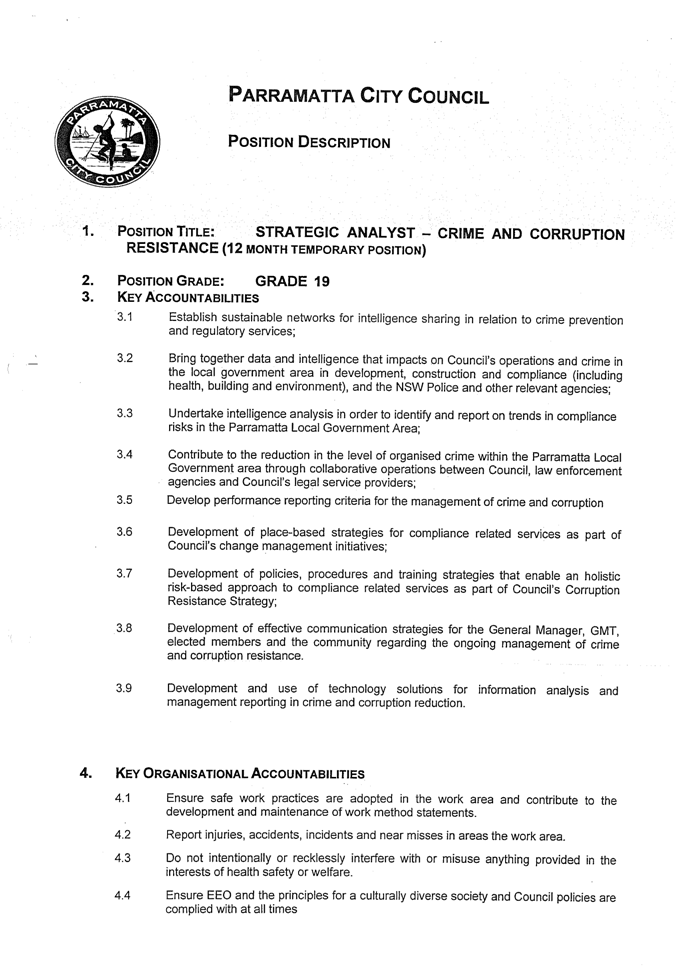
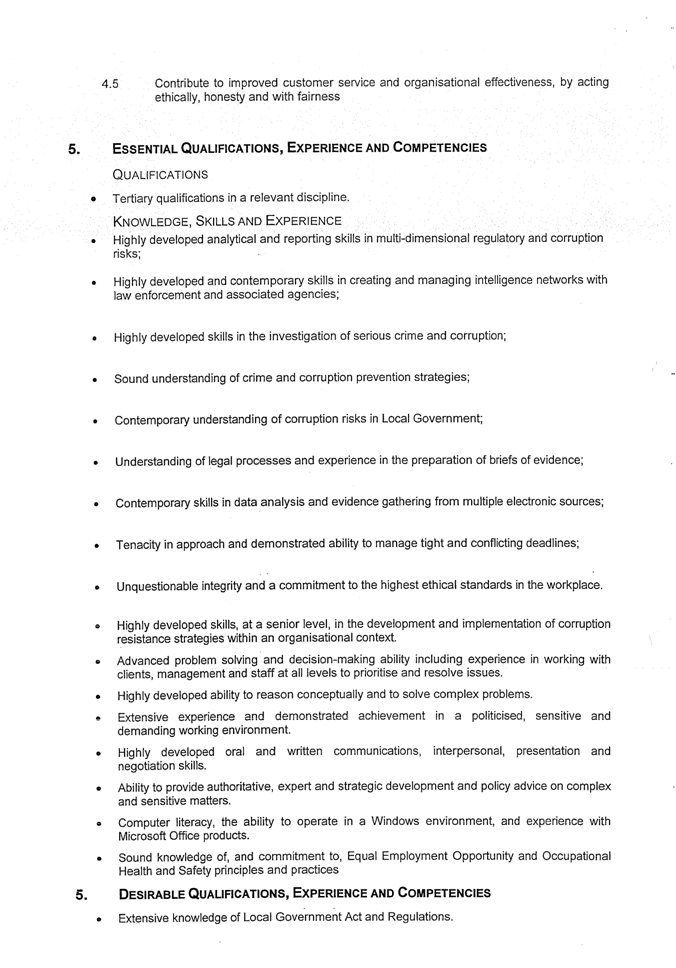
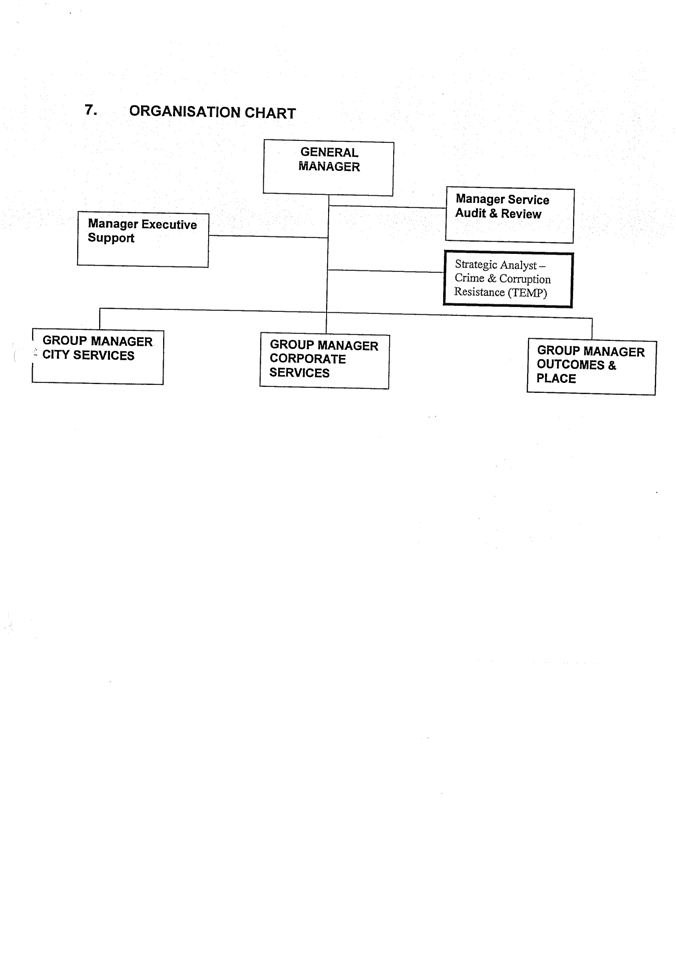
|
Attachment 2
|
Confidential Information from NSW Police - Parramatta LAC (Supplied to
Councillors ONLY)
|
Placeholder for Attachment
2
Regulation &
Enforcement of Brothels and Massage Parlours
Confidential Information
from NSW Police - Parramatta LAC (Supplied to
Councillors ONLY)
1 Pages
|
Ordinary Council 26 May 2008
|
Item 14.2
|
CITY LEADERSHIP AND MANAGEMENT
ITEM NUMBER 14.2
SUBJECT Report
of Investigation into Compliance Section
REFERENCE F2007/01985 - D00917795
REPORT OF Manager Service Audit and Review
|
PURPOSE:
To provide Council with the final response to the
recommendations of the Independent Commission Against Corruption (ICAC)
report into corrupt conduct associated with the regulation of brothels in Parramatta,
and to provide Council with an update on the enforcement action that has
taken place during the last 6 months relating to brothels and massage
parlours.
Council at its meeting on Monday, 28 April 2008 resolved:-
‘That consideration of this matter be deferred to enable its
consideration in conjunction with the forthcoming report on Crime and
Corruption prevention.’
The above mentioned report titled – ‘Regulation & Enforcement of Brothels and Massage Parlours’ has
been listed for consideration prior to this matter.
|
|
RECOMMENDATION
That
Council receive and note this status report.
|
BACKGROUND
1. The
ICAC commenced an investigation into the activities of the Compliance Section
of the Development Services Unit in November 2006 on the basis of information
received. In August 2007 the ICAC published a report of their investigation
finding that the former Team Leader Compliance Services acted corruptly in
accepting cash and sexual favours relation to inspections and complaints
handling in exchange for failing to undertake inspections and providing prior
warning of inspections.
2. A detailed report on
improvements arising out of the ICAC report was provided to Council on 29
October 2007 (SAR 34/2007 refers). At that meeting Council resolved to endorse
the closure of illegal brothels and associated activities as a top priority for
Regulatory and Compliance Services over the following four months.
REPORT
ICAC RECOMMENDATION –
IMPLEMENTATION PLAN
3. In
August 2007 Council provided the ICAC with a status report relating to the
fourteen recommendations contained in the ICAC report. A final implementation
plan relating to the ICAC
recommendations was provided to the ICAC in December 2007. The
Implementation Plan is posted on the ICAC website. Council is required to
provide the ICAC with updates on progress of the Implementation Plan on an
annual basis for the next 2 years.
4. The
current status of actions in relation to the ICAC report recommendations is
shown at Attachment 1.
ENFORCEMENT ACTION
OVER LAST 6 MONTHS
5. In
providing an emphasis on the control of illegal brothel activity since the
introduction of the Brothels Amendment Legislation in October 2007 and the
resolution of Council on 29 October 2007, some 50 inspections of brothels and
massage parlours (both unauthorised and approved) have been carried out by the
Development Control Team.
6. These
inspections have resulted in 15 Brothel Closure Orders being issued by
Parramatta Council and 4 Utility Orders being issued by Parramatta
Local Court over the last 6 months. Additionally, 7 Notices of Intentions to Serve
an Order have been issued to brothels which have development consent but are
not operating in accordance with the consent conditions.
7. It is
noted that Parramatta Council was the first Council in NSW to successfully obtain
Utility Orders under the new legislation. These results are pleasing and the
efforts of the Development Control Team in carrying out this challenging work
and obtaining these positive results should be recognised.
8. Despite
priority being given to the closure and inspection of brothels and massage
parlours since October 2007 the Development Control Team have also been
required to manage the other land use and regulatory complaints received by
Council. During this period the team participated in an in-house brothel
enforcement training day, and the managers have attended a Crime Prevention
Practitioners Seminar and a Corruption Prevention for Managers workshop run by
the ICAC.
9. The
total number of Service Requests (CRMs) currently allocated to the Development
Control Team for investigations is currently 283. Of these, approximately 15%
relate to brothels/massage parlours.
10. Despite
the success of the brothel closure actions over the last 6 months, the costs in
prioritising enforcement action relating to brothels above other compliance
matters have included a significant increase to the time taken to finalise the
other 85% of service requests allocated to the Development Control Team, this
being between 3 and 6 months. Some of the other service requests that the team
is responsible in carrying out enforcement work include: buildings not being
constructed in accordance with development consents; buildings being
constructed with no approval; overland drainage issues and building pollution
issues and nuisance issues.
11. To
enhance the management of all Service Requests allocated to the Development
Control Team the team has commenced an ongoing monitoring program for approved
brothels with the aim of ensuring compliance with consent conditions. This
program is paralleled by an ongoing program of investigating other breaches of
development consent, including illegal brothel activity.
ISSUES, OPTIONS,
CONSEQUENCES
12. At
its meeting of 14 April 2008 Council sought further information relating to progress
by Council’s Strategic Analyst Crime & Corruption Prevention and an
independent report into Council’s options to improved city governance in
relation to brothels, licenced premises, massage parlours, tattooists and
piercing establishments. These reports which will be available in due course
will consider the improvements to date as discussed in this report.
Michael Quirk Louise
Connolly
Manager
Service Audit & Review Manager
Development Services
17 April 2008 17 April
2008
Attachments:
|
1View
|
Status of ICAC Recommendations
|
5 Pages
|
|
REFERENCE MATERIAL
Nil.
|
Attachment 1
|
Status of ICAC Recommendations
|
OPERATION PELION
RECOMMENDATIONS
|
RECOMMENDATION
|
RESPONSE
|
ESTIMATED
TIMEFRAME
|
RESPONSIBILITY
|
|
RECOMMENDATION 1
|
|
|
|
|
It
is recommended that the Minister for Planning and the Attorney General commission
a review of the corruption risks attached to the regulation of brothels by
local councils, and develop an appropriate strategy to deal with those risks.
|
Action
with Minister for Planning; Reminder letter sent to Minister.
|
|
Minister
for Planning
|
|
|
|
|
|
|
RECOMMENDATION 2
|
|
|
|
|
It
is recommended that the Minister for Planning and the Attorney General give
consideration to adopting a system to prevent unsuitable persons operating
brothels.
|
Action
with Minister for Planning; Reminder letter sent to Minister.
|
|
Minister
for Planning
|
|
|
|
|
|
|
RECOMMENDATION 3
|
|
|
|
|
It
is recommended that the Minister for Planning and the Attorney General
introduce legislation to require sex industry advertisements to show the
relevant development approval number. If the business does not require
consent, the advertisement should be required to show an exemption number
issued by the local council.
|
Action
with Minister for Planning; Reminder letter sent to Minister.
|
|
Minister
for Planning
|
|
|
|
|
|
|
RECOMMENDATION 4
|
|
|
|
|
It
is recommended that Parramatta City
Council implements a system of active staff and performance management in the
compliance area.
|
Service
Manager and Team Leader have been recruited and have implemented a more
formal approach to management control over inspection activities.
Team
meetings are recorded and include input from the Legal Support Team and the
Strategic Analyst.
The
weekly review of brothel advertisements is provided to the Strategic Analyst
for further analysis and possible action.
Standard
operating procedures enhanced and implemented covering:
Legislative
and regulatory enforcement;
Management
of evidence;
Corruption
prevention in field activities;
Court
proceedings and use of utilities orders; and
Occupation
health & safety.
Performance
standards established for non-compliance timeframes.
Independent
Integrity Steering Committee oversight of brothel compliance matters.
Active
networks and liaison established with external enforcement agencies including
Police and ATO.
Completed
with further improvements being developed as part of structural changes to
Group.
|
Implemented
|
Manager
Development Services Unit (DSU)
|
|
|
|
|
|
|
RECOMMENDATION 5
|
|
|
|
|
It
is recommended that designated senior staff of Parramatta City Council
regularly review closed matters and the information made available to them by
the review and audit program recommended in Recommendation 12, and take
action if this information suggests the possibility of corrupt conduct.
Protocols regarding responsibilities and appropriate actions need to be developed.
|
A
monthly review of closed items is conducted by the Manager DSU.
An
inter-council peer review and audit process is currently being negotiated
with officers from Bankstown
and Sydney
Councils. Expected to be operational by April 2008.
|
Implemented
April
2008
|
Manager
DSU
|
|
|
|
|
|
|
RECOMMENDATION 6
|
|
|
|
|
It
is recommended that the duties of the strategic analyst, crime and corruption
prevention at Parramatta City
Council include ascertaining the training needs of team members, service
managers and senior managers; and procuring and/or developing relevant
training programs.
|
Strategic
Analyst currently working with Manager DSU in identifying and conducting
further training for Compliance & Construction teams to address immediate
and medium-term requirements.
Training
needs analysis is currently being developed as part of formal Corruption
Prevention Plan with input from Strategic Analyst, Internal Audit & Human
Resources.
|
Implemented
May
2008
|
General
Manager
|
|
|
|
|
|
|
RECOMMENDATION 7
|
|
|
|
|
It
is recommended that Parramatta City
Council provide initial and ongoing training tailored to the needs of team
members and managers, targeted at recognising and reducing corruption risks.
|
See
recommendation 6 above.
Strategic
Analyst has provided training to compliance officers in
· powers and inspection
processes arising from the introduction of the Brothels Legislation Amendment
Act 2007;
· responsibilities under
the ICAC Act 1988;
· updated procedures
relating to gathering and management of evidence, court procedures, and
specific corruption resistance strategies in field activities.
Team
Members have undertaken Compliance Training in Brothel Enforcement with Team
Leaders and Managers attending Crime Prevention Practitioners Seminar in
October 2007 and the ICAC Corruption Prevetnion for managers Workshop in
March 2008.
|
May
2008
Implemented
|
Manager
SAR / Manager HR
|
|
|
|
|
|
|
RECOMMENDATION 8
|
|
|
|
|
It
is recommended that senior managers at Parramatta City
Council undertake specialised training in risk management and methods for
early detection of corrupt conduct.
|
Training
needs analysis currently being developed as part of formal Corruption
Prevention Plan with input from Strategic Analyst, Internal Audit & Human
Resources. Research currently assessing providers of integrity systems
training providers.
Specific
management modules will be developed in co-operation with external
authorities in relation to corruption detection.
|
Plan
adopted by May 2008
|
Manager
HR/Manager SAR
|
|
|
|
|
|
|
RECOMMENDATION 9
|
|
|
|
|
It
is recommended that Parramatta City
Council institute a program of rotation of the position of Team Leader,
Compliance Services.
|
The
Team Leader Compliance position was re-graded and qualification requirements
enhanced to enable a greater capacity for rotation in the Development Unit.
The current Team Leader Compliance was a former development assessment team
member. Rotation during periods of leave has being implemented. Rotation will
be further considered as part of structural integration project.
|
Implemented
|
Manager
DSU
|
|
|
|
|
|
|
RECOMMENDATION 10
|
|
|
|
|
It
is recommended that the service matter owner of CRMs concerning brothels
should be the Service Manager, Compliance Services, rather than the Team
Leader. It is also recommended that the Customer Relationship Management
system be upgraded so that this does not remove from the Team Leader the
ability to allocate tasks to inspectors in the team.
|
Current
business process covered by procedure allocates all relevant Service Requests
to the Service Manager as owner who allocates tasks to Team Leader. Service
Manager is responsible for reviewing action taken and closing Service
Request.
Modifications
to CRM module in Councils Online currently being investigated with syndicate
members and managed service provider. Resolution to await determination
relating to core system upgrade
|
Implemented
May
2008
|
Manager
DSU/Manager SAR
|
|
|
|
|
|
|
RECOMMENDATION 11
|
|
|
|
|
It
is recommended that the Customer Relationship Management system be upgraded
to support the protocol that if an officer undertakes an inspection, he or
she cannot close a CRM.
|
Currently
covered by business rule and procedure.
Modifications
to CRM module in Councils Online currently being investigated. Resolution to
await determination relating to core system upgrade
|
Implemented
May2008
|
Manager
DSU/Manager SAR
|
|
|
|
|
|
|
RECOMMENDATION 12
|
|
|
|
|
It
is recommended that Parramatta City
Council develops a rigorous review and audit system for the compliance
function and that a high-level manager oversees that process.
|
A
monthly review of closed items is conducted by the Manager DSU.
An
inter-council peer review and audit process is currently being negotiated
with officers from Bankstown
and Sydney.
Expected to be operational by April 2008.
|
Implemented
May
2008
|
Manager
DSU
|
|
|
|
|
|
|
RECOMMENDATION 13
|
|
|
|
|
It
is recommended that Parramatta City
Council introduces a system of fact checking of statements entered into the
Customer Relationship Management system by the Compliance Team.
|
Fact
checking is currently undertaken on sample basis by Service Manager prior to
closing Service Request.
Independent
process of fact-checking on sample basis to be incorporated into peer review
discussed in Recommendation 12 above.
|
Implemented
April
2008
|
Manager
DSU
|
|
Ordinary Council 26 May 2008
|
Item 14.30.0
|
CITY LEADERSHIP AND MANAGEMENT
ITEM NUMBER 14.30.0
SUBJECT Proposed
Suburb alignment between Winston Hills and Northmead
REFERENCE F2004/08135 - D00923251
REPORT OF Service Manager - GIS/LIS
PREVIOUS ITEMS 10.10 - Proposed
Suburb alignment between Winston Hills and Northmead -
Ordinary Council - 25 February 2008
|
PURPOSE:
To present the
results of the public exhibition undertaken by the Geographical Names Board
of NSW (GNB) regarding a proposed change to the suburb boundary between Winston Hills and Northmead.
|
|
RECOMMENDATION
(a) That based on the feedback received
during the exhibition of the proposed suburb boundary change, Council
recommends to the GNB not to proceed with the change.
(b) Further
That affected property owners be
advised of Council’s decision.
|
BACKGROUND
1. Council
resolved on 25
February 2008 to request the GNB to conduct a public
exhibition of the proposed change of the suburb alignment based upon a petition
received from Council.
2. The
exhibition was conducted between March and April 2008. Council assisted with
the consultation by notifying affected owners and occupiers of the public
exhibition.
ISSUES/OPTIONS/CONSEQUENCES
3. Formal suburb boundaries were gazetted for
the Parramatta Local Government Area on 16th June 2006; residents have adjusted personal contacts
if necessary to the new legal suburb address.
It will be time consuming and some may experience financial impacts
(example changing small business stationary) for residents to adjust personal
contacts.
4. Winston Hills and
Northmead exist within different mail delivery centres. Council has been
advised by residents that the confusion between the two suburbs is causing
delay for mail delivery from Australia Post.
The proposed change would align the suburb boundary to the different
mail delivery centres.
CONSULTATION & TIMING
5. The
GNB conducted the public exhibition between March and April 2008 requesting
feedback from residents. Advertisements
were placed in the Parramatta Sun,
and Parramatta Advertiser on 19th march 2008. Letters were written to
232 of households advising of the proposed suburb boundary change and inviting
comment.
6. The
GNB received 32 submissions objecting to the proposed boundary changes
including seven petitions with 160 signatures objecting to the proposal. Sixteen submissions were received which
supported the proposed changes.
Kim Menzel
Service Manager – GIS/LIS
Attachments:
|
1
|
Letter of response from Geographical Names
Board regarding exhibition of Winston Hills/Northmead Suburb Proposal
|
1 Page
|
|
|
Letter of response from Geographical Names
Board regarding exhibition of Winston Hills/Northmead Suburb Proposal
|
1 Page
|
|
|
Letter of response from Geographical Names
Board regarding exhibition of Winston Hills/Northmead Suburb Proposal
|
1 Page
|
|
1View
|
Letter of response from Geographical Names Board
regarding exhibition of Winston Hills/Northmead Suburb Proposal
|
1 Page
|
|
REFERENCE MATERIAL
|
Attachment 1
|
Letter of response from Geographical Names Board
regarding exhibition of Winston Hills/Northmead Suburb Proposal
|
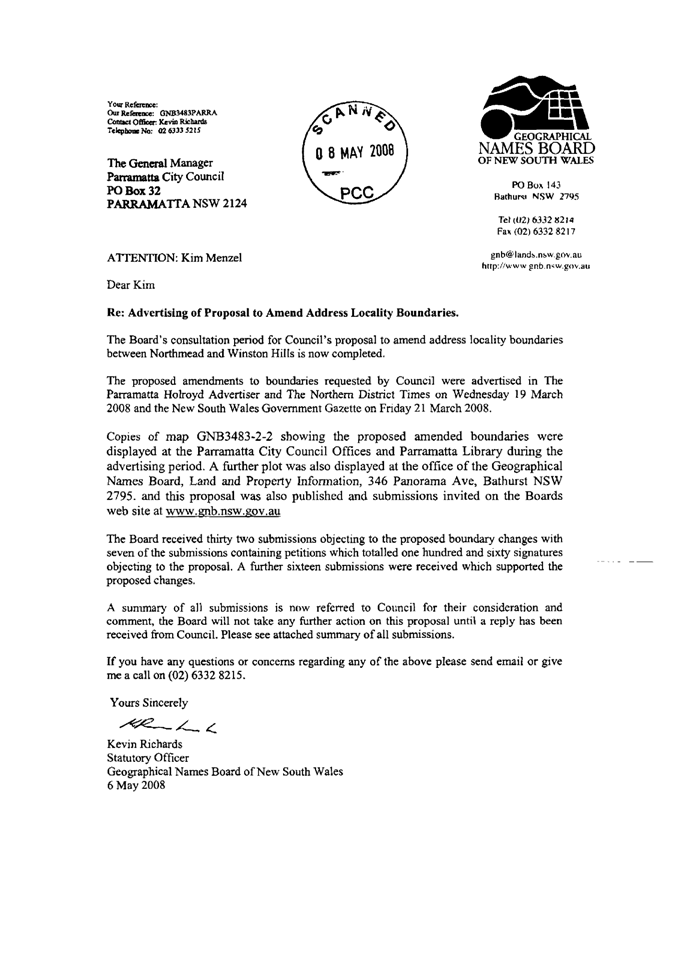
|
Ordinary Council 26 May 2008
|
Item 14.4
|
CITY LEADERSHIP AND MANAGEMENT
ITEM NUMBER 14.4
SUBJECT Suburb
Boundary Alignment for 19 Pioneer Street
Wentworthville/Pendle Hill
REFERENCE F2004/08135 - D00936327
REPORT OF Service Manager - GIS/LIS
|
PURPOSE:
To obtain Council approval for a submission to the
Geographical Names Board of NSW (GNB) requesting the newly created property
as result of subdivision, 19 Pioneer
Street to exist within the suburb of Wentworthville.
|
|
RECOMMENDATION
That
Council formally requests the GNB amend the suburb boundary to include 19
Pioneer Street in the suburb of
Wentworthville.
|
BACKGROUND
1. A
recent subdivision of 15 Binalong Road
Pendle Hill has created one property to remain on Binalong
Road, and one new property that has street
frontage to Pioneer Street. The
subdivision plans were registered with the NSW Lands Department on 10 April 2008.
2. The
existing legal suburb boundary between Pendle Hill and Wentworthville is
divided at the location of the subdivision. This subdivision has resulted in 19
Pioneer Street existing in Pendle Hill with the
remainder of the Pioneer Street
being located within Wentworthville.
ISSUES/OPTIONS/CONSEQUENCES
3. This anomaly must be addressed because of
the confusion that would be created with this single property location being
located in a different suburb compared to the remainder of the street.
CONSULTATION & TIMING
4. The
affected resident was advised in writing of the new address allocation as a
result of subdivision and they raised no objection to proposal.
Kim Menzel
Service Manager – GIS/LIS
Attachments:
|
1View
|
Map showing suburb boundary of 19 Pioneer
Street.
|
|
|
REFERENCE MATERIAL
|
Attachment 1
|
Map showing suburb boundary of 19 Pioneer Street.
|
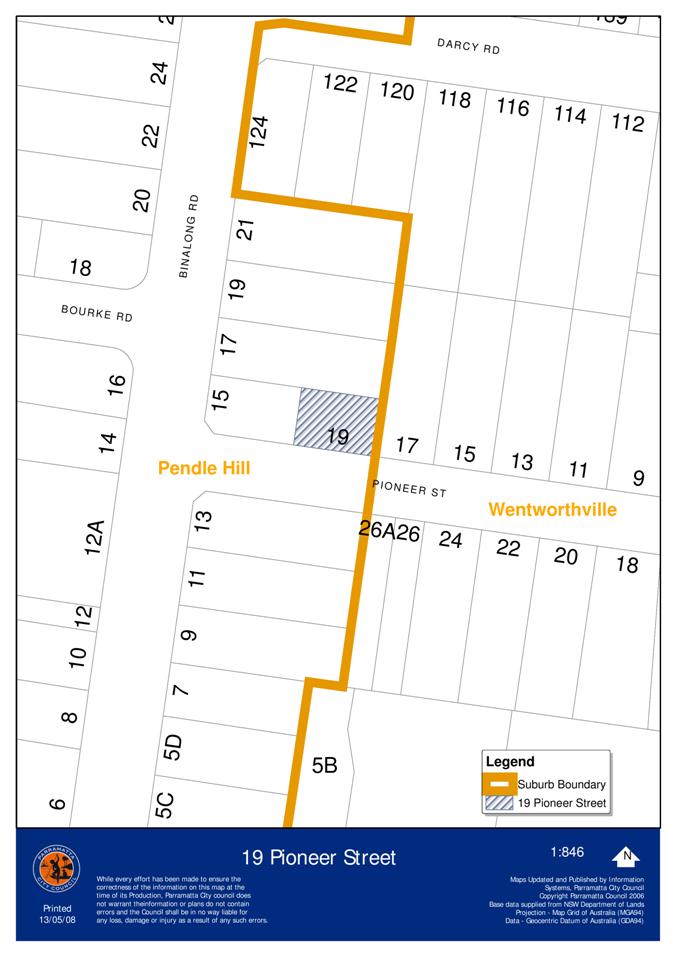
|
Ordinary Council 26 May 2008
|
Item 14.5
|
CITY LEADERSHIP AND MANAGEMENT
ITEM NUMBER 14.5
SUBJECT Prioritisation
of Councillor Workshops - July to September 2008
REFERENCE F2006/01127 - D00935705
REPORT OF Service Manager - Council Support
|
PURPOSE:
To seek Council prioritisation
of the dates for the holding of workshops for July to September 2008.
|
|
RECOMMENDATION
That
the list of proposed workshops to be held for the period July to September
2008 as appended as Attachment 1 to Service Manager – Council Support Report
be adopted.
|
BACKGROUND
1 Council at its meeting held on 8 May
2006
resolved that workshops and information nights be held on an as needs basis on
Monday and Wednesday nights. This request did not remove the existing
delegation of the Lord Mayor to approve workshops/information nights.
2 In addition, Council on 28 August 2006 adopted an updated Code of
Meeting Practice for exhibition which included, as Annexure H, the procedure
for the Calling of Workshops.
3 Annexure H of this Code included a number of general
requirements including:-
* 6 nights available for the holding of Council Workshops
(the 6 nights being Monday and Wednesday each week of the 4 weekly council
cycle minus the 2 Council Meeting nights).
* All workshops are to be presented to Council on a
quarterly basis for adoption and/or prioritisation. Council Support will
prepare a report to Council in this regard but will seek input firstly from
Managers, then GMT as to its preferred priorities.
* 8 Councillors are to constitute a quorum for a workshop.
Council Support will carry out a ring around prior to the workshop to ensure it
proceeds (subsequently changed to 6 Councillors Minute No 8788).
* The Lord Mayor retains his right to approve an urgent
workshop.
* Minutes of workshops are to be taken and distributed via
the Councillors Information Booklet.
ISSUES/OPTIONS/CONSEQUENCES
4 Due to the Local Government Elections on Saturday, 13
September 2008, the Lord Mayor has requested that workshops only take place on
those Monday nights that are available for the months of August and September
2008.
5 In accordance with the procedure for calling workshops,
requests were forwarded to Managers and appropriate staff seeking “bids” for
workshops that may be required for the third quarter of 2008.
6 GMT have now met and considered the requests received for
the holding of workshops for July to September 2008 and a chronological list as
approved by GMT is appended to this report as Attachment 1 for consideration by
Council.
CONCLUSION
7 The list of proposed workshops for the third quarter of
2008 as suggested by GMT is placed before Council for its consideration and/or
adoption.
Graeme Riddell
Service Manager –
Council Support
15 May 2008
Attachments:
|
1View
|
Councillor Workshops List - July to September 2008
|
1 Page
|
|
REFERENCE MATERIAL
|
Attachment 1
|
Councillor Workshops List - July to September
2008
|
Councillor Workshops – July to September 2008
Monday 7
July 2008 Councillor Workshop – Community Input
Mechanisms
Wednesday 9 July 2008 Councillor Workshop – State of the
Community Report (Initial Findings)
Monday 14
July 2008 Council Meeting (Regulatory)
Wednesday 16 July 2008 Citizenship Ceremony
Monday 21 July 2008 Program
Panels
Wednesday 23
July 2008 Councillor
Workshop – Riverside Theatres
Review
Monday 28
July 2008 Council
Meeting (other Program Panels)
Wednesday
30 July 2008 Councillor
Workshop – Vacant
----------------------------------------------------------------------------------------------------------------
Monday 4
August 2008 Councillor
Workshop – Vacant
Monday 11
August 2008 Council Meeting (Regulatory)
Wednesday 13
August 2008 Citizenship
Ceremony
Monday 18
August 2008 Program Panels
Monday 25
August 2008 Council Meeting (other Program Panels)
----------------------------------------------------------------------------------------------------------------
Monday 1
Sept 2008 Councillor
Workshop – Vacant
Monday 8
Sept 2008 Council
Meeting (Regulatory)
Wednesday 10 Sept 2008 Citizenship
Ceremony
Monday 15
Sept 2008 Program Panels
Saturday 13 Sept 2008 Local Government Elections
Friday 19 Sept 2008 Special
Council Meeting – Election of Lord
Mayor
Saturday 20 Sept 2008 Councillor Workshop – Councillor Induction
Workshop
Monday 22
Sept 2008 Council
Meeting (other Program Panels)
Monday 29
Sept 2008 Councillor Workshop – Vacant
NOTE: Workshops
scheduled for Monday’s Only during August and September 2008.
|
Ordinary Council 26 May 2008
|
Item 14.6
|
CITY LEADERSHIP AND MANAGEMENT
ITEM NUMBER 14.6
SUBJECT Program
Panels
REFERENCE F2004/06950 - D00937010
REPORT OF Manager Strategic Partnerships and Programs
|
PURPOSE:
This report brings forward the
notes from seven Program Panels held 21 April
2008. Copies of the notes from seven Program
Panel meetings held are attached. This is in accordance with the resolution
of Council of 15 March 2007. There were no formal recommendations to
Council made in any Program Panel in March.
|
|
RECOMMENDATION
That, the notes from the seven Program Panel meetings
held on 21
April 2008 are noted.
|
BACKGROUND
1. Three Joint
Program Panels met and a meeting was held for the City Leadership and
Management Program Panel on the 21 April 2008. Notes from these meetings are attached to
this report (Attachment 1).
2. The Program Panels have been meeting on a
monthly basis as part of Council’s formal meeting cycle since June 2004.
ISSUES/OPTIONS/CONSEQUENCES
3. At the March meetings the common agenda
item for the Program Panels was the 2008/2009 Management Plan.
4. Program Panels are working towards
achieving a good understanding of each service delivered as part of each
program.
5. As a result of the review of the Panels
undertaken last year, each Panel is being encouraged to achieve a broader
understanding of issues contained in their program area.
Consultation and Timing
6. Program Panels are provided as a forum for
Councillors and staff to discuss issues relating to each program area.
Coordinators are keen to receive feedback on ways in which the Panels can work
at an optimum level.
Susan Gibbeson
Senior Project Officer
Strategic
Partnerships & Programs
Attachments:
|
1View
|
April 2008 Program Panel Meeting Notes
|
28 Pages
|
|
REFERENCE MATERIAL
None.
|
Attachment 1
|
April 2008 Program Panel Meeting Notes
|
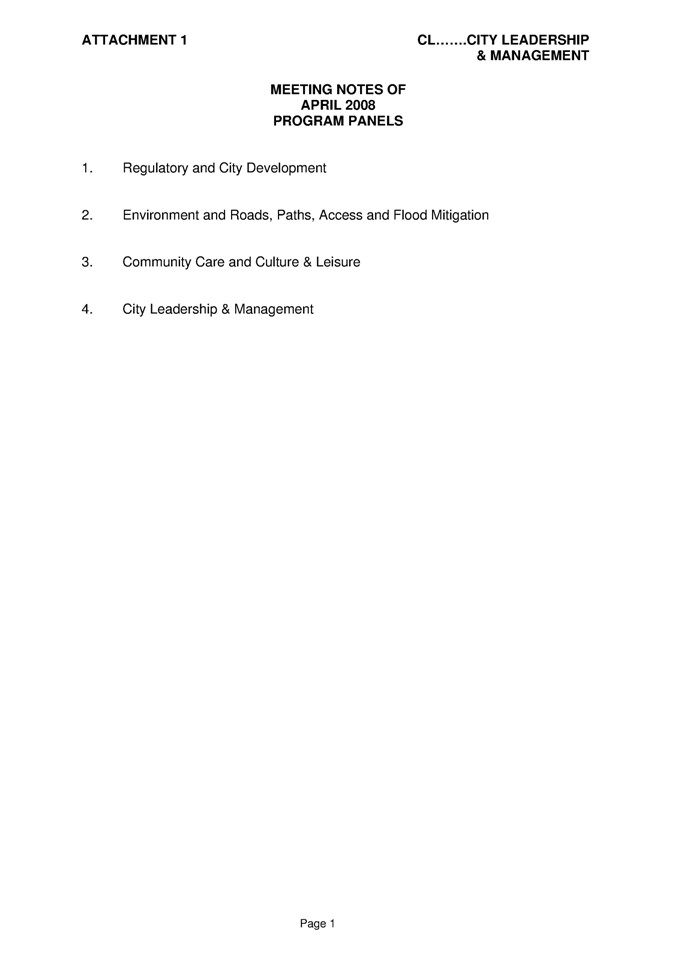
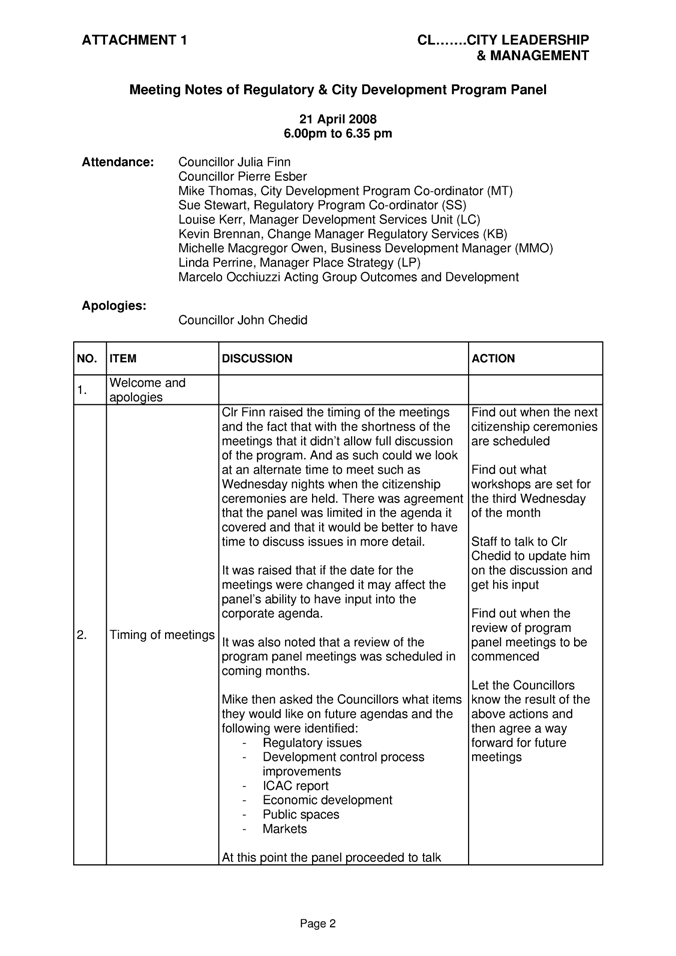
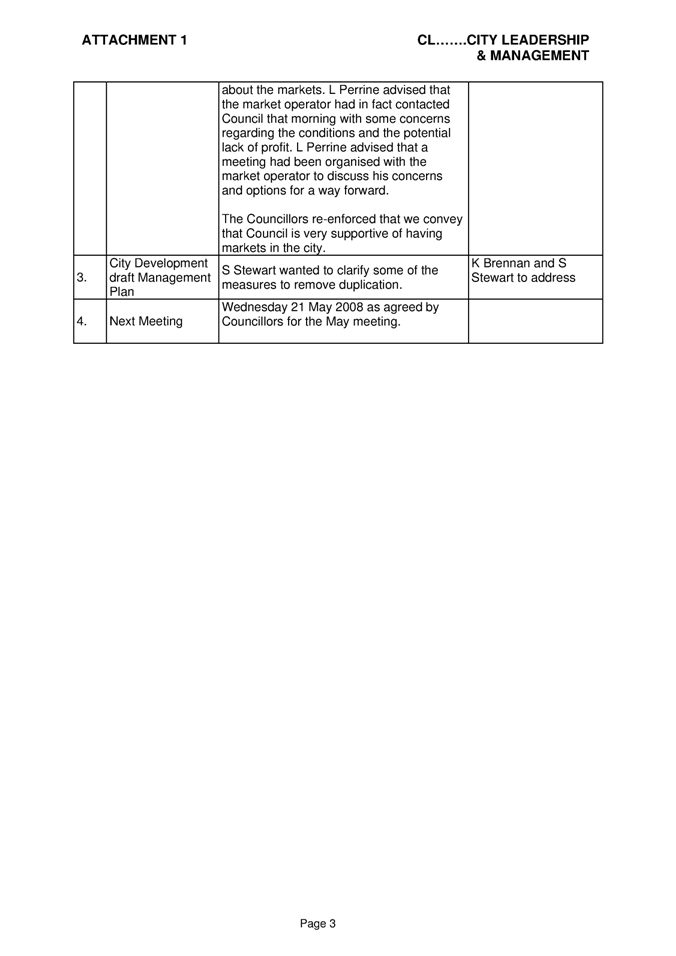
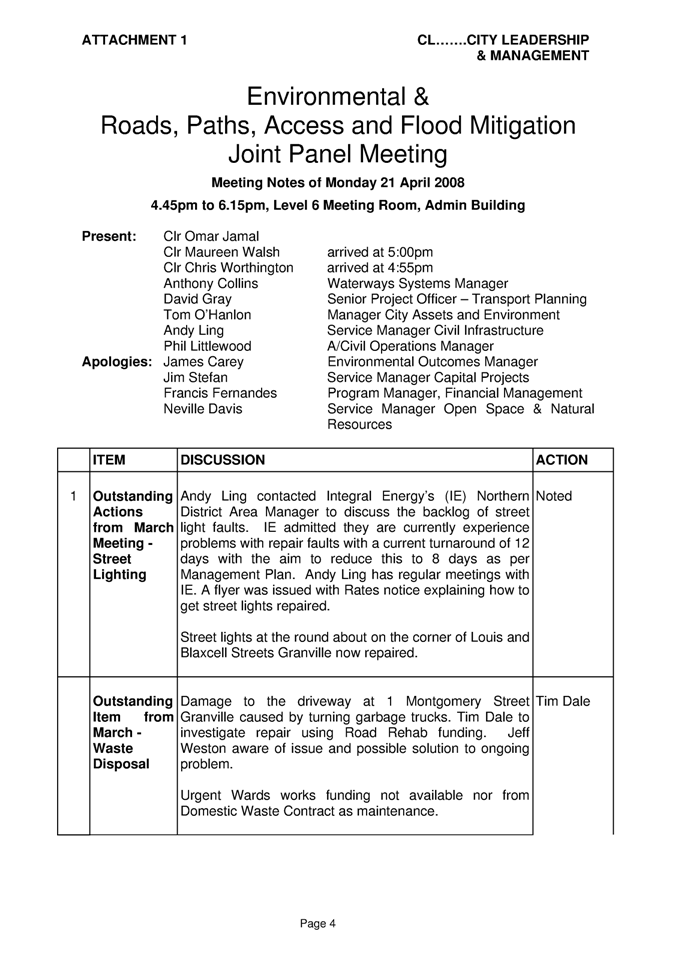
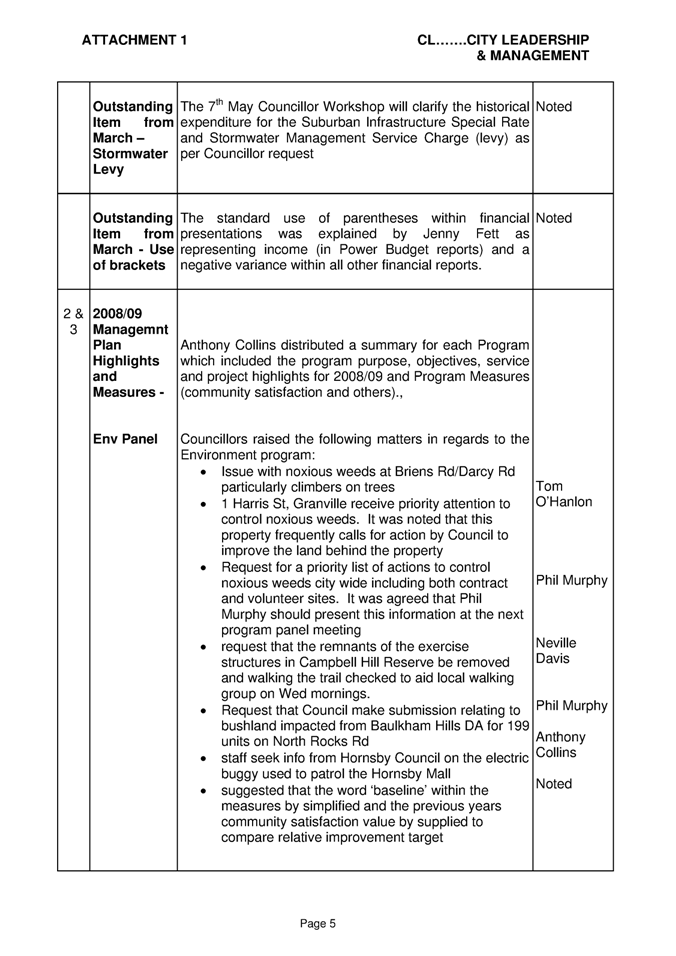
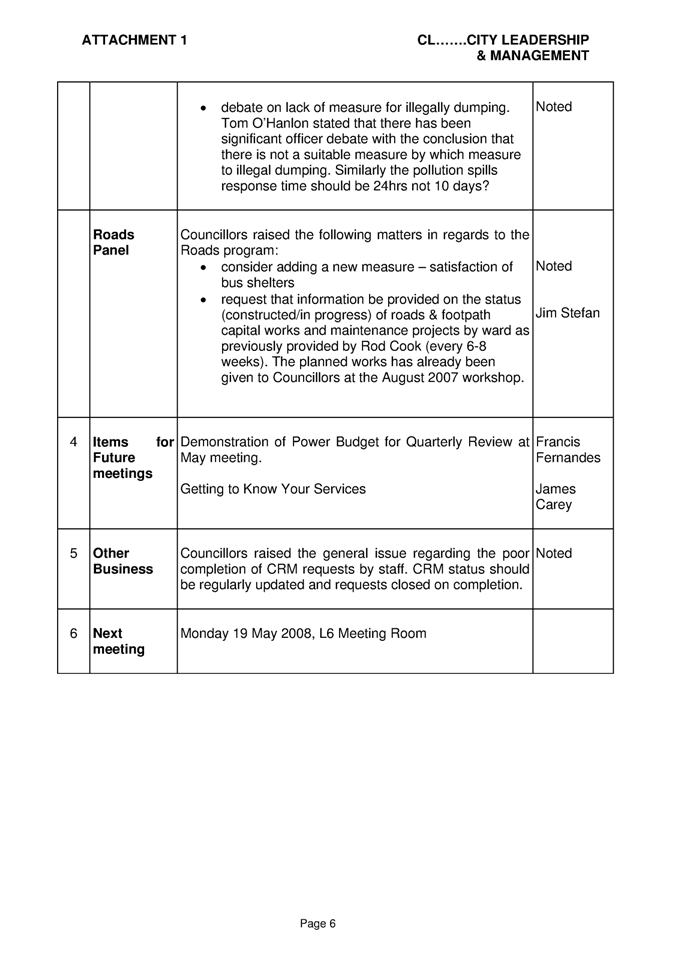
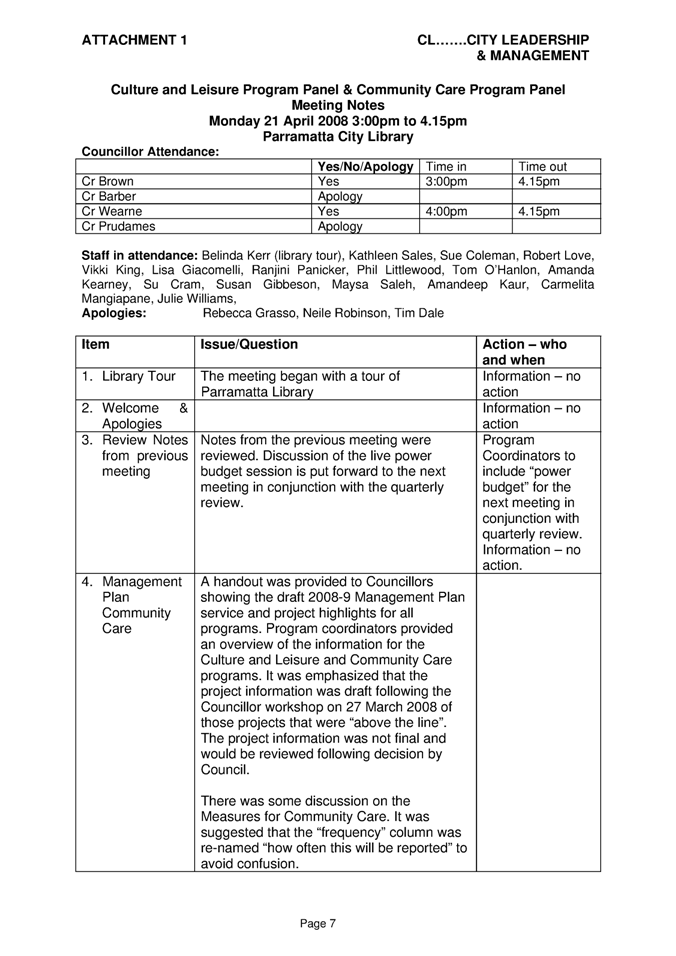
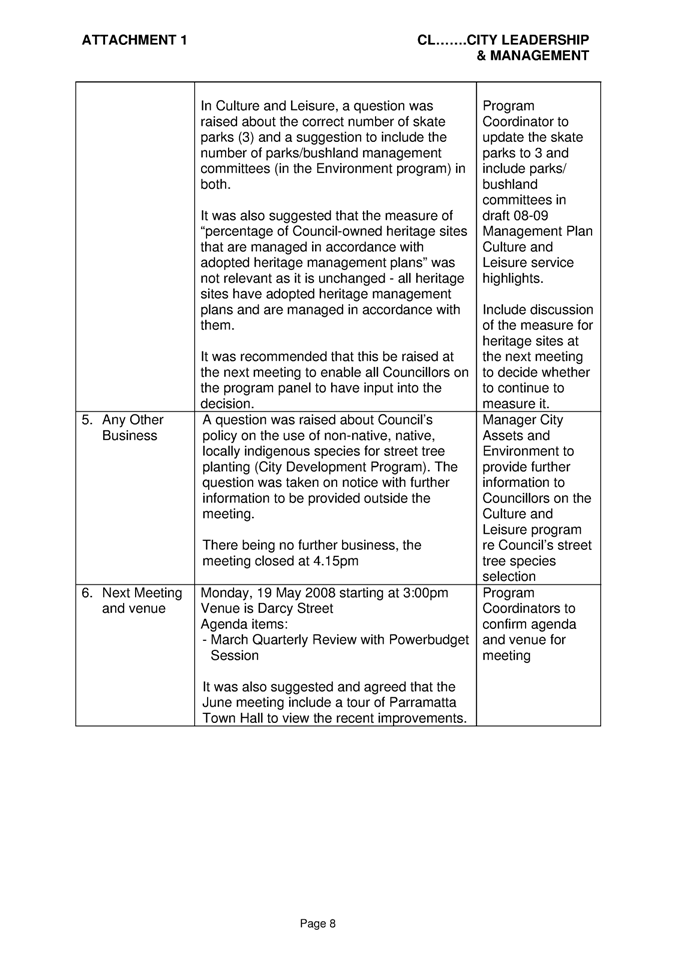
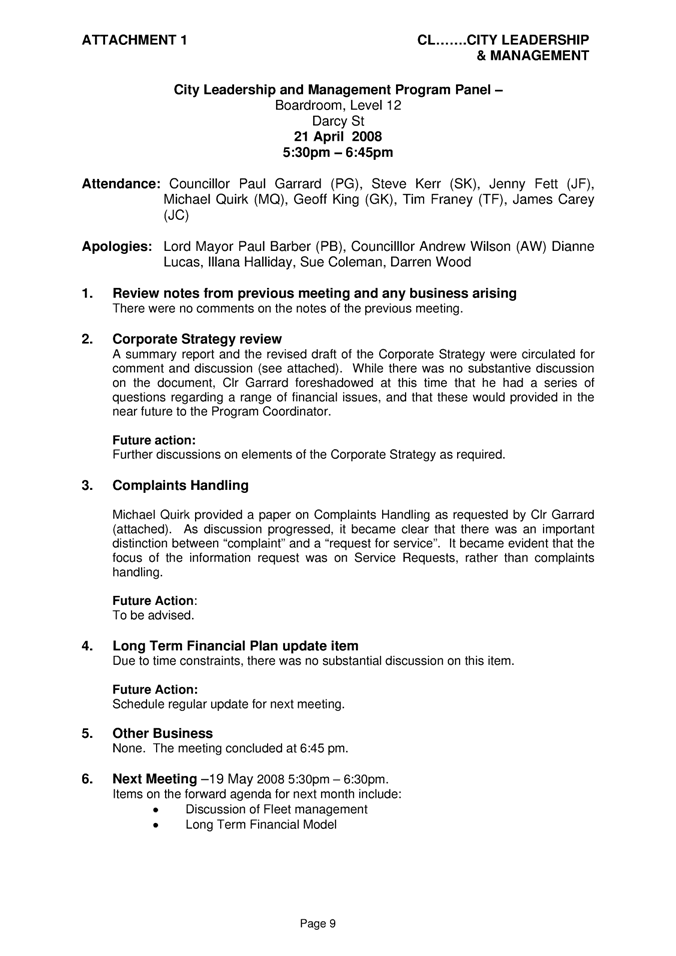
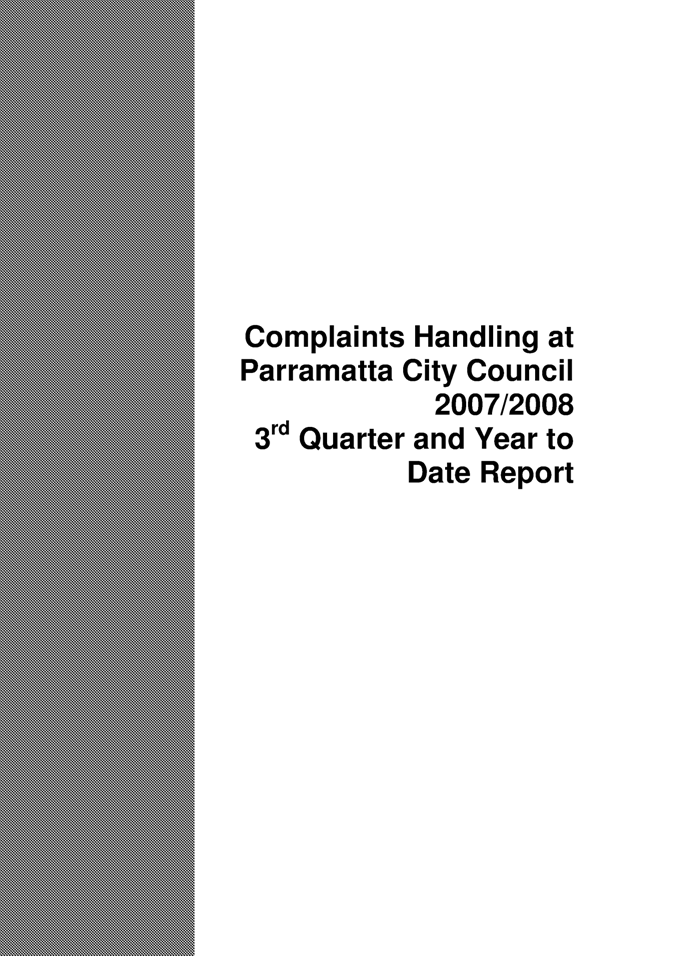
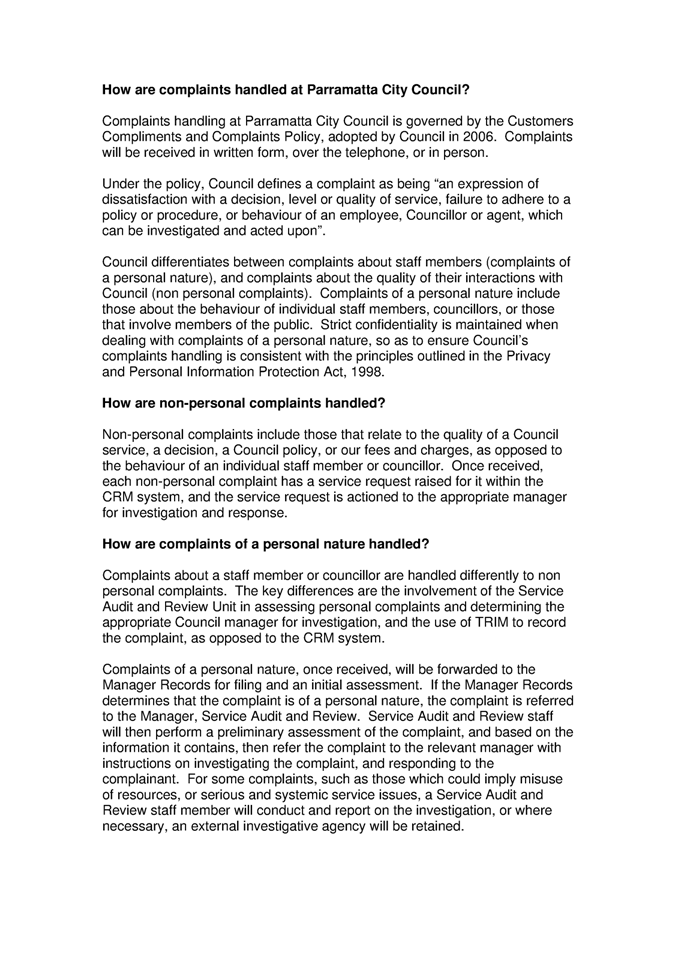
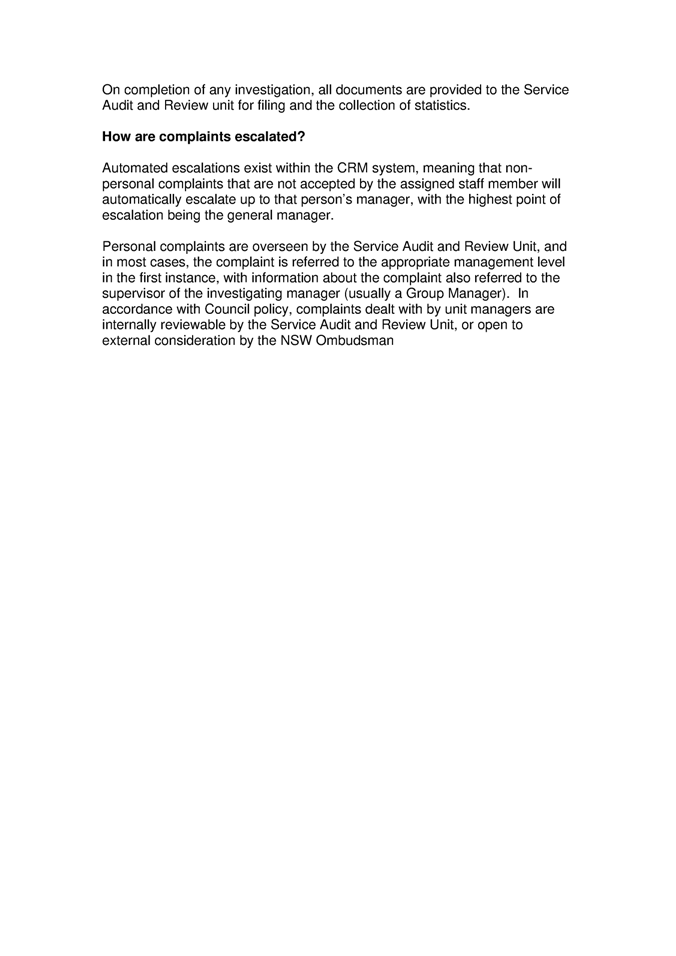

|
Attachment 1
|
April 2008 Program Panel Meeting Notes
|
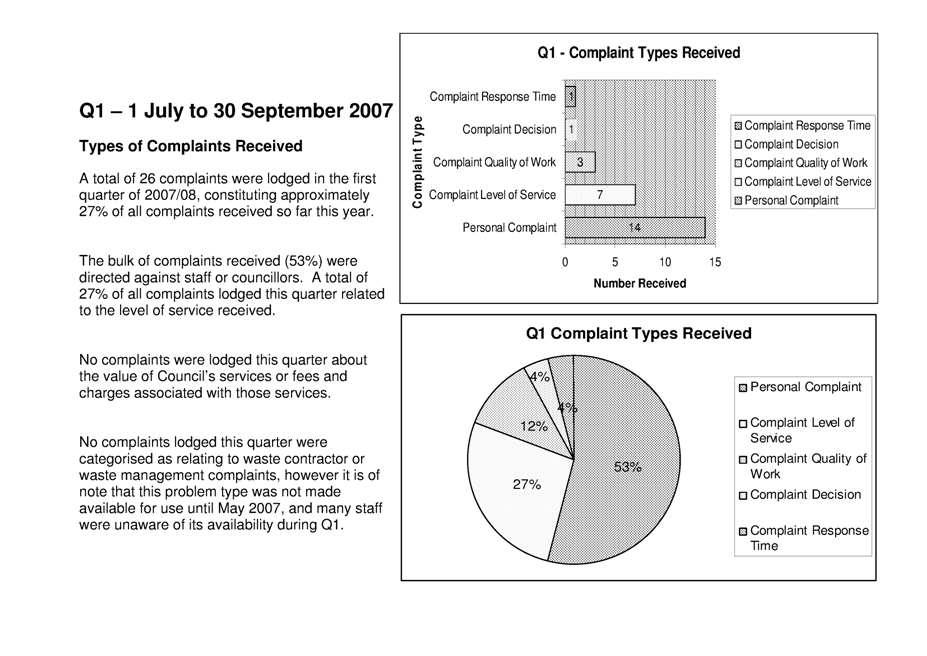
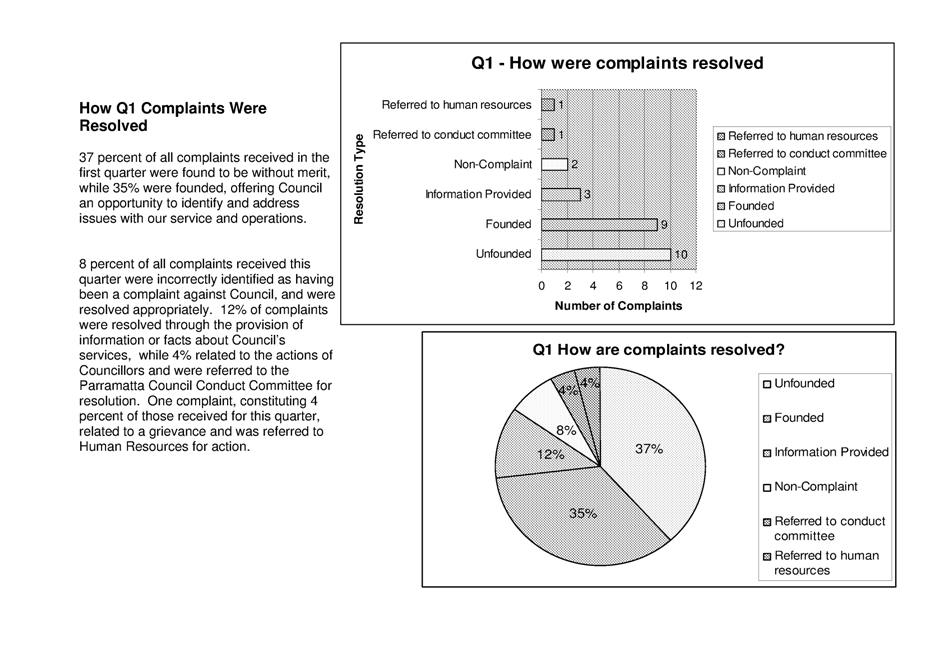
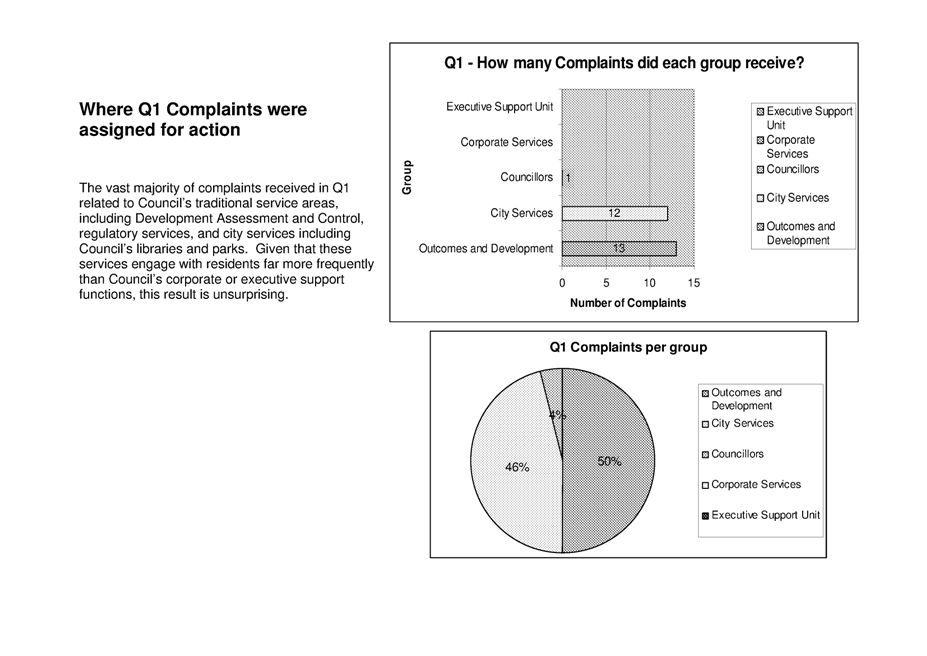
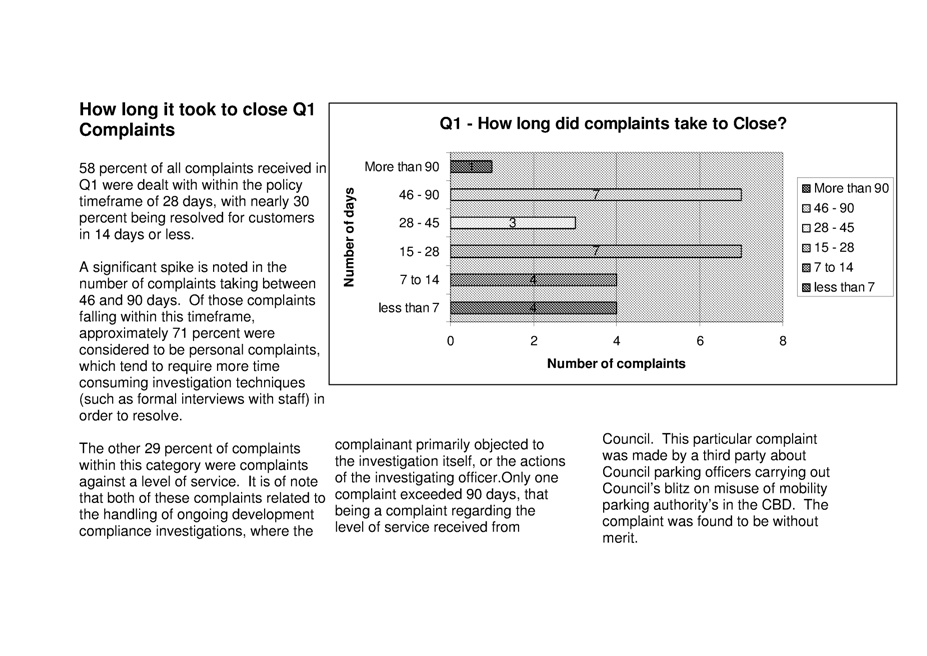
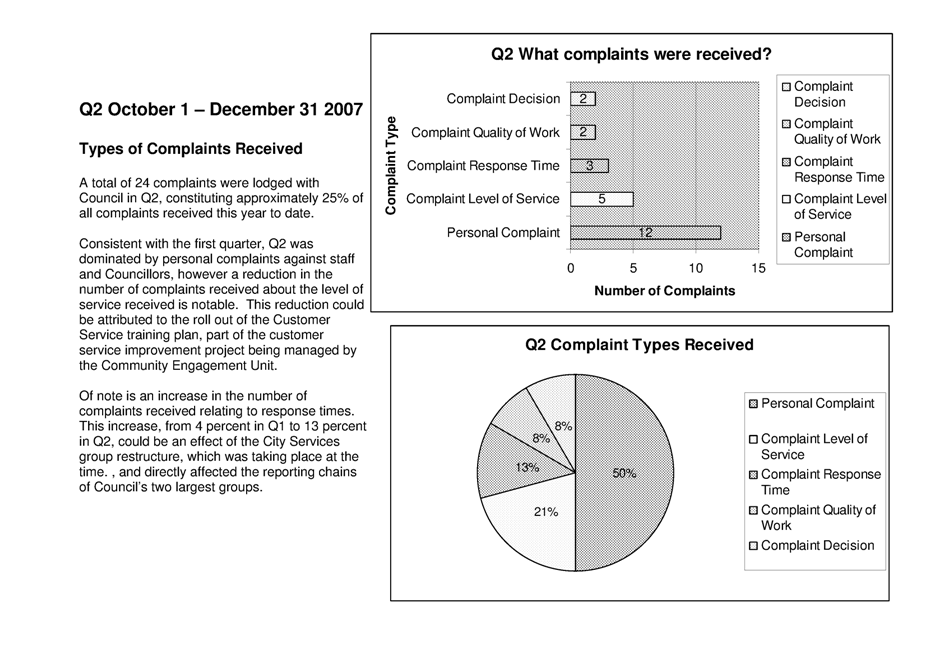
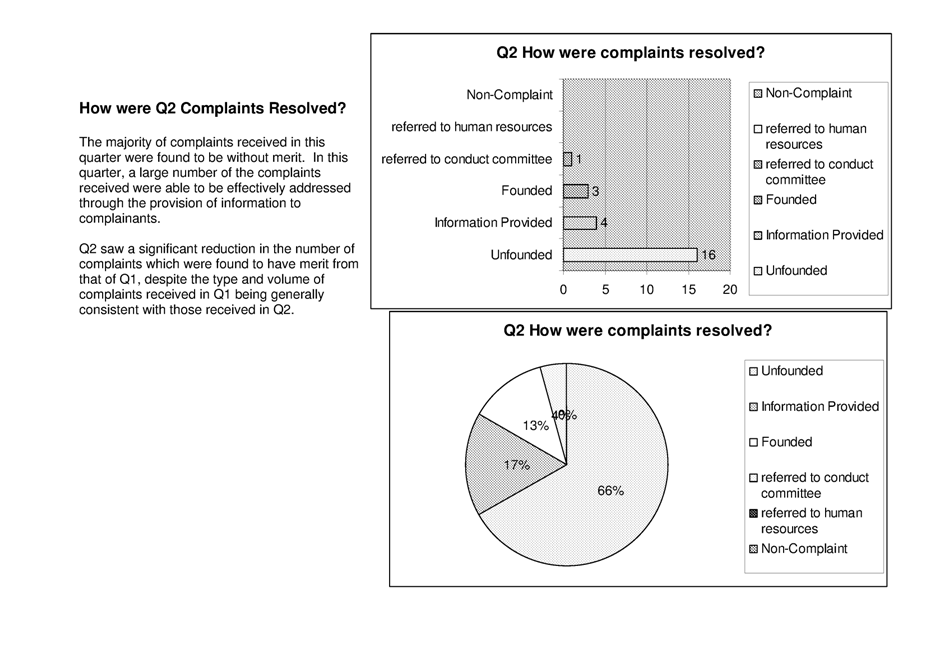
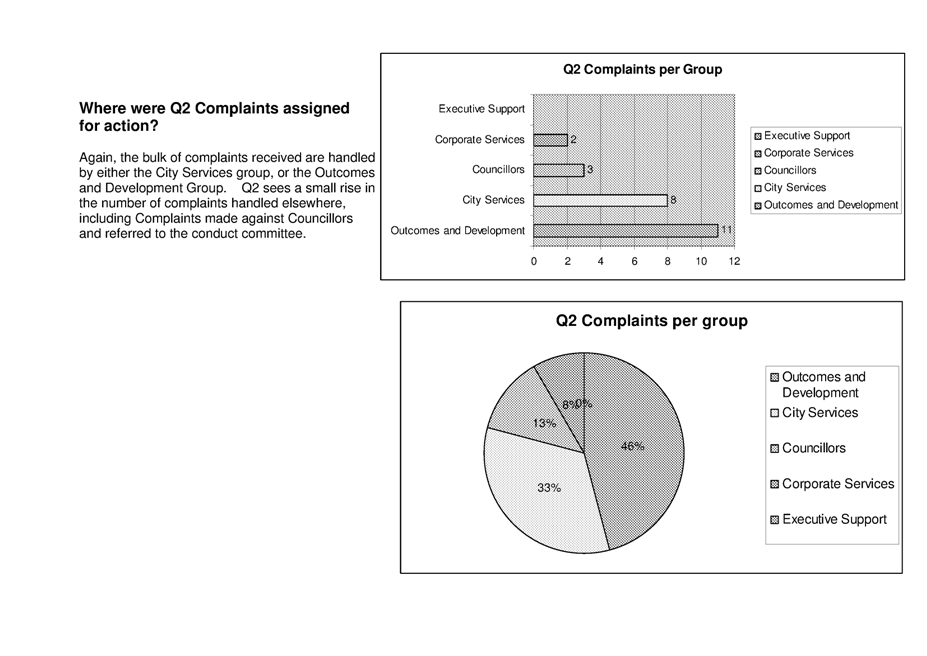
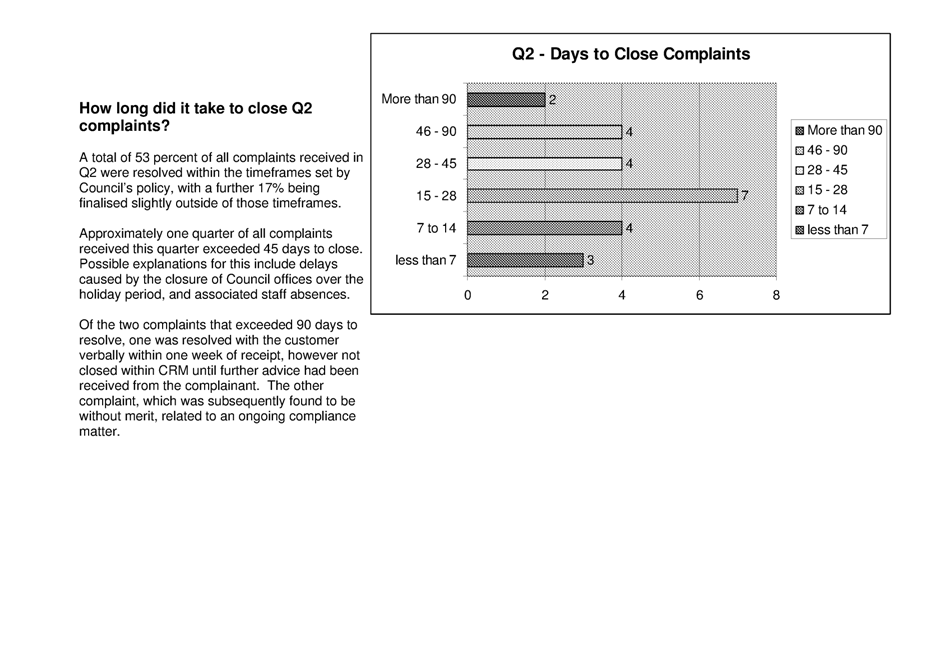
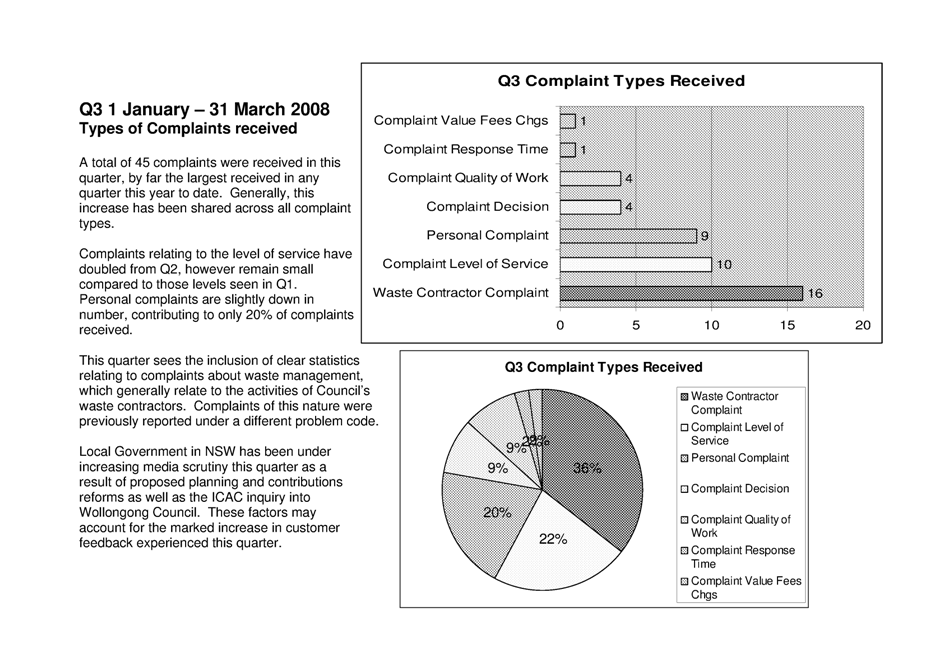
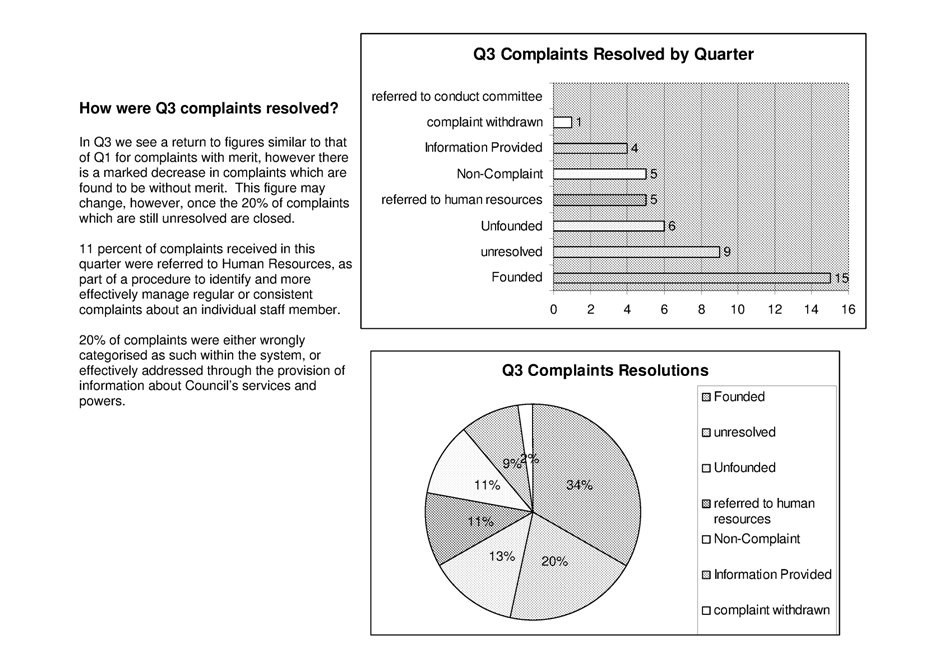
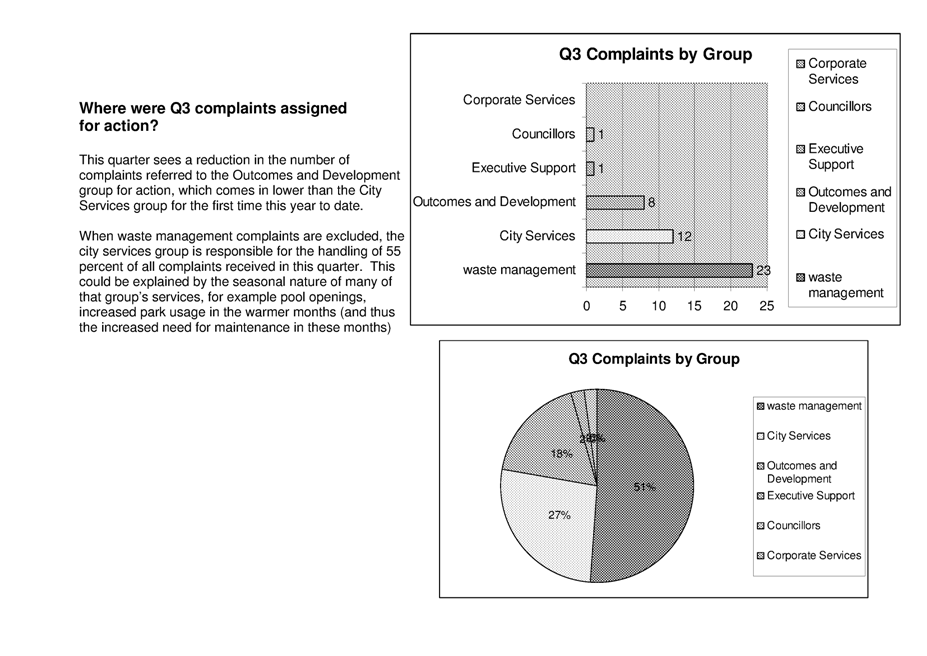
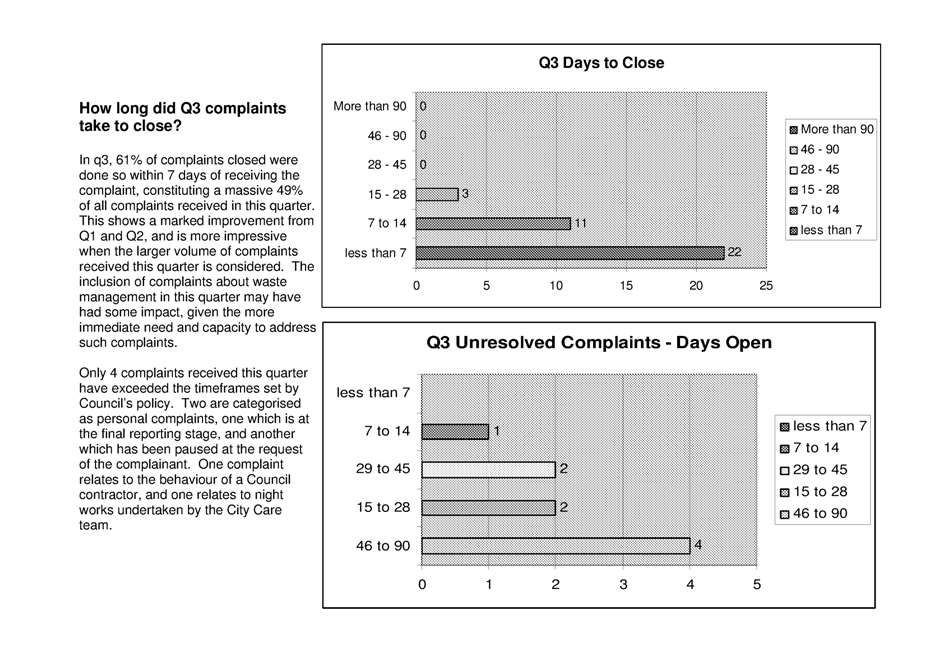
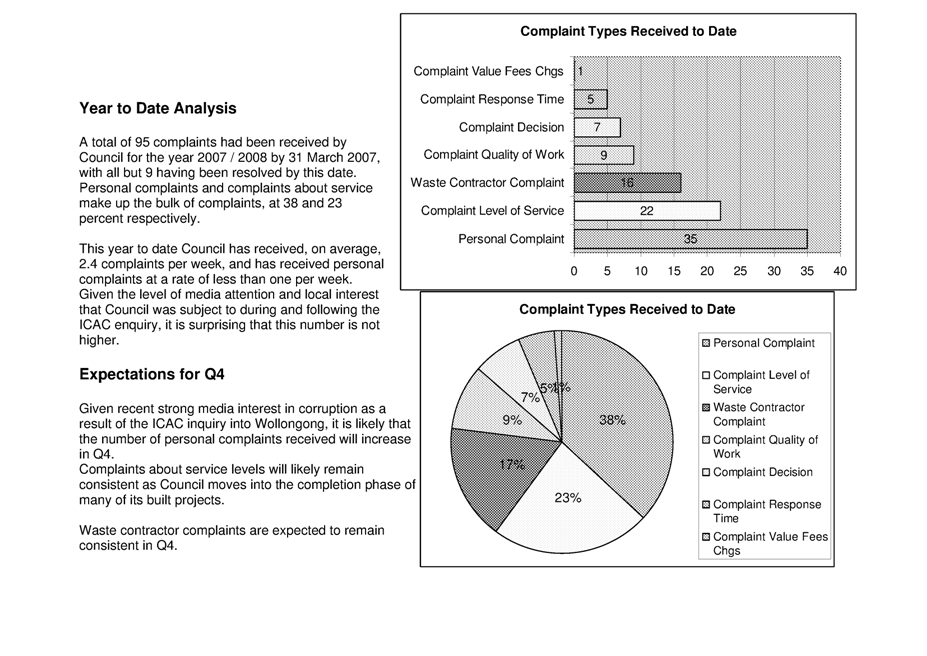
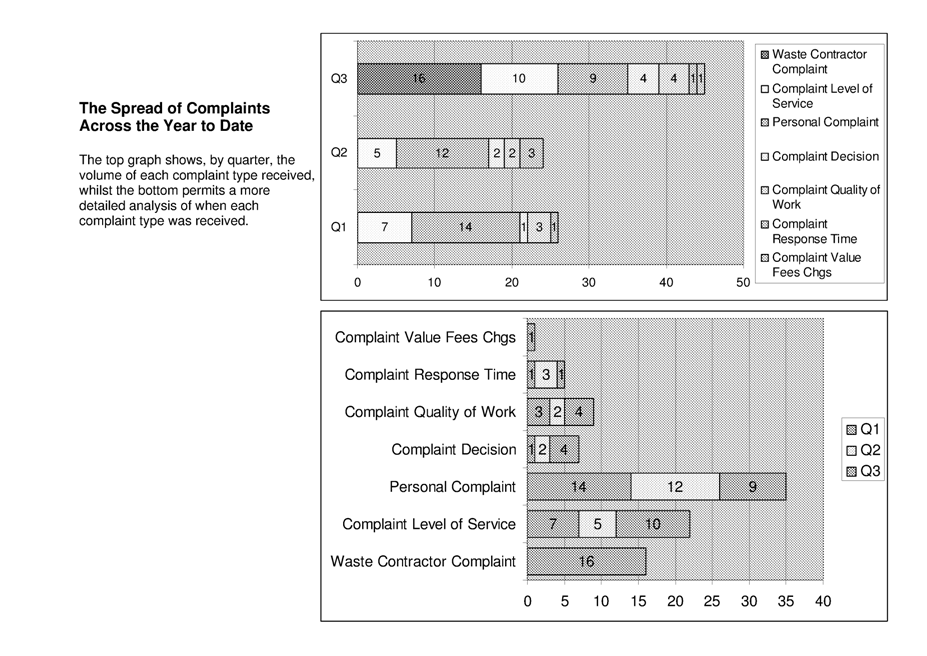
|
Attachment 1
|
April 2008 Program Panel Meeting Notes
|
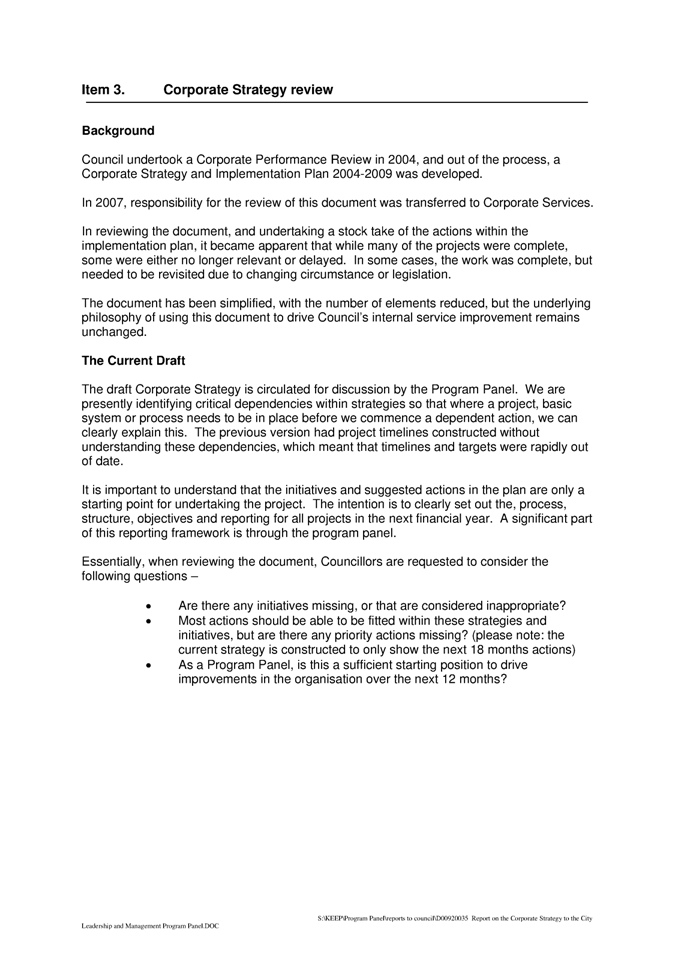
|
Ordinary Council 26 May 2008
|
Item 14.7
|
CITY LEADERSHIP AND MANAGEMENT
ITEM NUMBER 14.7
SUBJECT Investments
Report for March 2008
REFERENCE F2004/06960 - D00920918
REPORT OF Manager - Finance
|
PURPOSE:
To inform Council
of the investment portfolio performance for the month of March 2008.
|
|
That Council
receives and notes the investments report for March 2008.
|
BACKGROUND
1. In accordance with clause 212 of the Local Government
(General) Regulation 2005, a report setting out details of all money invested
must be presented to Council on a monthly basis.
2. The report must include a certificate as to whether or not
the investments have been made in accordance with the Act, the Regulations and
the investment policy of Council.
ISSUES/OPTIONS/CONSEQUENCES
3. The Council’s investment portfolio stood at $90.8 Million as
at 31st March 2008. (Previous month $87.0 Million) The weighted average portfolio held for
March 2008 was $91.0 Million (Refer attachment 1).
4. Council invests directly with Local Government Financial
Services (LGFS), various term deposit providers and with funds managers
utilising the services of Grove Financial Services. There are also investments
with the Commonwealth Bank for loan offset funds.
5. The average interest rate on Council’s investments for the
month compared to the Bank Bill Index is as follows:
Monthly Annualised
Total Portfolio 0.16% 2.42%
Funds Managers 0.11% 1.89%
Bank Bill Index 0.67% 8.13%
NB: Annualised rates are calculated on a compounding basis assuming that
the interest returns are added to the initial investment amount and reinvested.
6. After allowing for Council’s loan offsets and at call funds,
Council achieved an average annualised interest rate of 2.42% in the month for
its total investment portfolio. The rate achieved by Council was below the Bank
Bill Index of 8.13%. Fund managers achieved an annualised rate of 1.89% for the
month of March.
7. The amount of funds invested at the end
of March increased from the
previous month by 3.8 Million. This
increase was as a result of the Third Rates Instalment due at the end of
February 2008.
8. Credit markets once again performed poorly in March 2008.
Credit conditions have tightened by well above official rate rises, the RBA has
hinted that rates may now be on hold at least until the first quarter inflation
figure is scheduled to be released in late-April.
9. Council continued to realign its
portfolio in an effort to find a balanced consistent rate of return and placed
a $7M 90 day term deposit at 8.16% with IMB.
10. Equity Linked protected note investments held with Longreach
and Westpac are shown at actual mark to market value for March 08. These
investments show devaluation in current market value totalling approximately
$300k, however it is important to note that these are 5 year long term
investments and are capital guaranteed
at maturity.
11. The following details are provided on the attachments for
information:
Graph – Comparison of average funds invested with
loans balance
Graph – Average interest rate comparison to Bank
Bill Index
Graphs – Investments and loans interest compared
to budget
Summary of investment portfolio
12. The Certificate of Investments for March 2008 is provided
below:
Certificate of Investments
I hereby certify
that the investments for the month of March 2008 have been made in accordance
with the Act, the Regulations and Council’s Investment Policy.
13. There
is no standard report attachment - detailed submission - attached to this
report.
Jenny Fett
Manager
Finance
6
May 2008
Attachments:
|
1View
|
Investments & Loans - Performance
|
1 Page
|
|
|
2View
|
Summary of Investments Portfolio
|
2 Pages
|
|
REFERENCE MATERIAL
|
Attachment 1
|
Investments & Loans - Performance
|
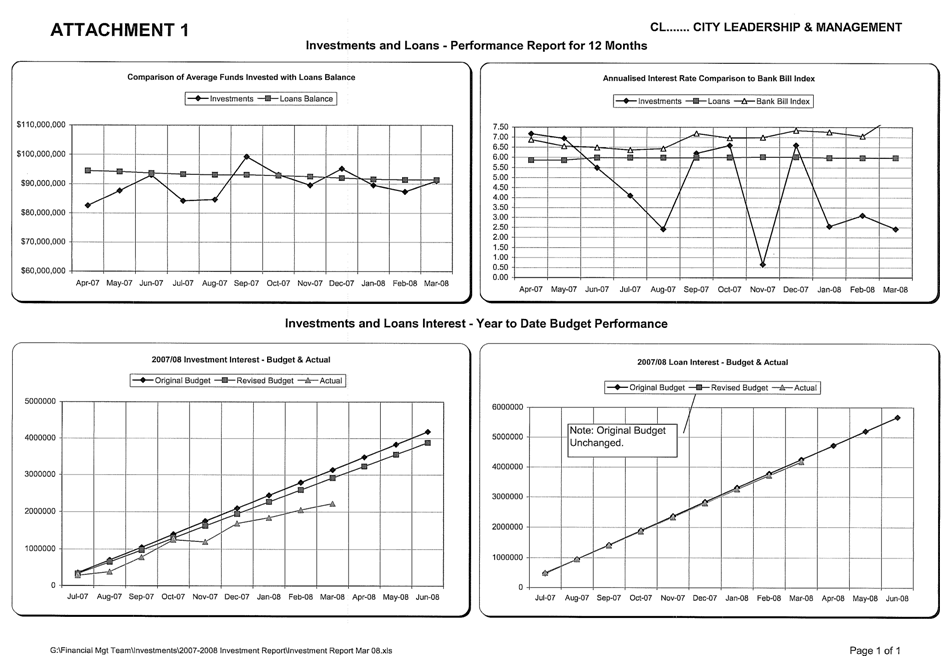
|
Attachment 2
|
Summary of Investments Portfolio
|
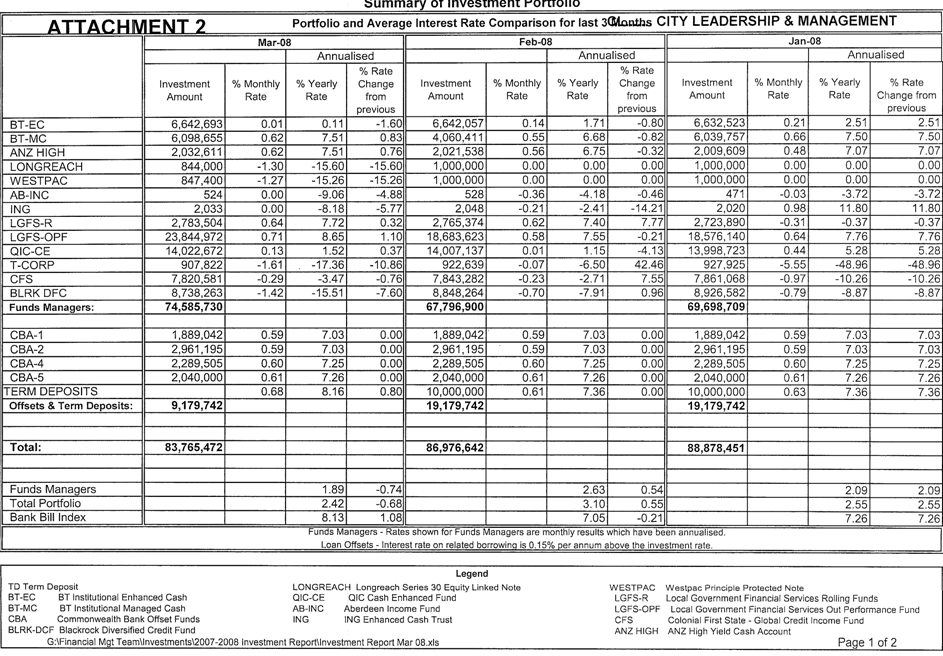
|
Attachment 2
|
Summary of Investments Portfolio
|
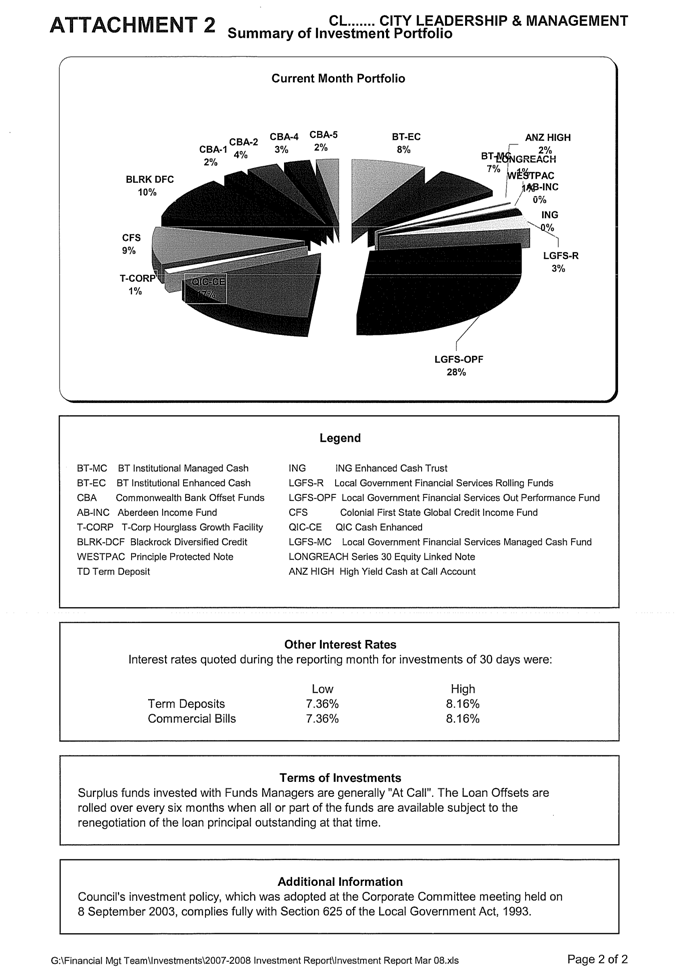
|
Ordinary Council 26 May 2008
|
Item 14.8
|
CITY LEADERSHIP AND MANAGEMENT
ITEM NUMBER 14.8
SUBJECT 2007/08
Management Plan - March 2008 Quarterly Review
REFERENCE F2004/05853 - D00934647
REPORT OF Manager - Finance
|
PURPOSE:
1. Section 407 of the Local
Government Act 1993 requires the General Manager to report to the Council
within 2 months after the end of each quarter as to the extent to which the
performance targets set by the Council’s Management Plan have been achieved
during that quarter.
2. Clause
203 of the Local Government (General Regulation) 2005 requires that the
Responsible Accounting Officer (Manager Finance) prepare and submit to the
Council, not later than 2 months after the end of each quarter, a budget
review statement that shows, by reference to the estimate of income and
expenditure set out in the Management Plan, a revised estimate of the income
and expenditure for that year. The Responsible Accounting Officer is also
required to include with the budget review statement, a report as to whether
or not the Responsible Accounting Officer believes that the statement
indicates that the financial position of the Council is satisfactory, having
regard to the original estimate of income and expenditure, and if that
position is unsatisfactory, recommendations for remedial action.
|
|
RECOMMENDATION
(a) That Council
adopt the General Manager’s March 2008 Quarterly Review of the 2007/08
Management Plan and Budget. (Attachment 1).
(b) That Council
approve the actual results and forecast variations to the previously approved
budget estimates for the 2007/08 financial year as reflected in Attachment
1.
(c) Further,
that Council adopt the Responsible Accounting Officer’s report on the
financial position of the Council.
|
BACKGROUND
1. The attached March 2008
Quarterly Review contains the Acting General Manager’s report, on a Program
basis, detailing the extent to which the performance targets set by the
Council’s 2007/08 Management Plan have been achieved.
2. The Review also contains
details at pages 6 and 80 of the actual income, expenditure and proposed
funding adjustments for 2007/08 with comparisons to the budget previously
adopted by Council.
3. The March 2008 Quarterly
Review was submitted to Council’s Program Panels’ meetings on 19 May 2008. Any changes from the Program Panels’ meeting will be incorporated as
an addendum to this document to be considered at the Council meeting.
ISSUES/OPTIONS/CONSEQUENCES
Report of the Responsible Accounting Officer
As noted earlier in this report the
Responsible Accounting Officer is required, as part of the Quarterly Management
Plan Review, to report on the financial position of the Council.
Operating Statement forecast result 2007/08
Council is required
to produce a financial statement in accordance with statutory accounting
standards and generally accepted accounting principles. This Operating
Statement does not allow for funds transfers to and from reserves and includes
depreciation and the profit/loss on disposals of assets.
Council’s original
budget was to deliver a balanced operating result. At the September Quarterly
review the forecast deficit was $2.3M due mainly to the re-voting of
expenditure for un-completed operating projects from 2006/07 into 2007/08.
At the December
review the operating deficit was reduced to $0.3M. This has been reduced further for the March
Quarterly Review which now forecasts a year end Operating Statement deficit of
$0.174M. (See page 81).
This has been a
challenging quarterly review with a significant reduction in revenue forecasts
of $1.711M detailed below. The
necessary offsetting reductions in expenditure forecasts of $1.871M have
resulted from detailed budget scrutiny, including a review of depreciation and
reductions foreshadowed for the 2008/09 Budget being implemented this year to
match the reduced revenue forecasts.
Investment Income
The impact of the downturn in international and
domestic money markets continues to have a significant effect on Council’s
financial position, despite Council having no collateralized debt obligations
(CDO’s). While credit markets appear to
be stabilising previous shortfalls in returns have meant forecast investment
income has been reduced by a further $1.22M.
Some of this reduction in returns can be expected to be realized in
future periods when returns on these long term investments improve.
User Charges & Fees
The slowdown in the
development and construction industry is also being felt by Council and
development and building related fees are also under budget. Income in this
area has been reviewed downwards by $0.357M.
Parking Stations
gross income has also been reduced by $0.800M due to as the expected increase
in revenue from the fee increases did not eventuate as patronage declined for a
period. Patronage levels have since
increased. This impact has been offset
to a large extent by a reduction in the operating expenses. The net result is a
reduction in income of $0.230M.
Employee Costs
Employee costs have
been adjusted downwards mainly due to the distribution of internal Project
overheads to this expenditure category as well as the materials and contracts
categories. A reduction in permanent salary costs of $0.550M has been offset by
increases in recruitment costs ($0.119M) and Agency Costs ($0.122M). Other significant variations in employee
costs were reductions in Redundancy Provisions ($0.200M) and Superannuation
Costs ($0.127M).
Materials and Contracts
Parking stations operating costs have been carefully
scrutinized and savings measures initiated to offset the revenue reduction,
with savings of $0.571M forecast. Other major reductions include contract costs
for on-street parking management, with forecast savings of $0.210M. These savings had already been factored into
the draft 2008/09 budget.
Depreciation
Council is required to revalue its assets
progressively, commencing with land, buildings, plant and equipment at June
2008. This revaluation exercise is complex and has not yet been completed. The
original 2007/08 forecast provided for broad estimates based on the best
information that was currently available and assumed that a likely increase in
depreciation expense would commence from January 1, to correspond with the
recognition of new values. Following the release of the Department of Local
Government accounting code, this recognition will not take place now until June
30 and a reduction in forecast depreciation has been made of $0.697M.
With the completion of the valuations, the accurate
calculation of depreciation will be possible and this may result in changes to
the total expense. This has ramifications for the operating result and will be
incorporated in the June 2008 Budget Review.
Funds based forecast
financial result 2007/08
As part of the 2007/08 Management Plan,
Council adopted a balanced funds result. Council subsequently approved the
carryover into 2007/08 of various projects which were not completed in the
previous financial year. These projects were fully funded. At the
December 2007 Budget Review a funds based surplus of $0.086M was forecast.
Following
the March 2008 Budget Review a balanced, funds based financial result is
forecast for year end which is in line with the Management Plan target. This has been achieved by transferring
$0.112M from working funds to maintain planned projects, and recommended
changes to Section 94 funding for projects.
Section 94 – Use of reserve funds
Changes to Council’s Section 94 framework have given
Council greater options in the way these funds can be used. This Review proposes
funding $0.513M of project expenditure from Section 94 in lieu of using revenue
funds. This amount has been used to maintain expenditure on other Projects,
when revenue funding for projects was impacted by the reduction in investment
income.
Details of
other significant variations to the adopted budget are included in the attached
March Quarterly Review document within the Acting General Manager’s report ,
the various Program reports and as follows.
Following a review of the attached
March 2008 Quarterly Review, it is considered that the financial position of
the Council is satisfactory, and Council will endeavour to deliver a balanced
Operating Result at year end.
Jenny Fett
Manager Finance – Responsible Accounting Officer
Attachments:
|
1View
|
Quarterly Review March 2008
|
82 Pages
|
|
REFERENCE MATERIAL
|
Attachment 1
|
Quarterly Review March 2008
|
Placeholder for Attachment
1
2007/08 Management Plan -
March 2008 Quarterly Review
Quarterly Review March 2008
82 Pages
Please Note:
This attachment
has been provided to Councillors and Senior Staff Only. If you require a copy
of this document, please contact Michael
Wearne on 9806 5325.
|
Ordinary Council 26 May 2008
|
Item 14.9
|
CITY LEADERSHIP AND MANAGEMENT
ITEM NUMBER 14.9
SUBJECT Adoption
of the Draft Management Plan 2008/09 - 20011/12 for Public Exhibition
REFERENCE F2007/00392 - D00938692
REPORT OF Manager - Finance
|
PURPOSE:
To provide options to fund the 100% Greenpower project in the
2008/09-2011/12 Draft Management Plan and seek Council’s approval to place
the Draft Plan on Public Exhibition.
|
|
RECOMMENDATION
(a) That Council adopt, for the purpose
of public exhibition, the Draft Management Plan 2008/09 – 2011/12, subject to
the following amendments:
1. Budget line item adjustments for the 2008/09 financial year
as follows:
(a) Increase the combined expenditure
budget for electricity and street lighting by $500,000 to incorporate the purchase of 100% green power.
(b) Reduce the expenditure
budget for the Lord Mayor’s Christmas Party by $22,000;
(c) As recommended by the
Resources Advisory Committee, reduce:
· Catering (excluding Council Meetings) for
staff by $10,000;
· Postage by $93,000; and
· Stationery by $45,000;
(d) Based on the most recent
advice received from the Department of Local Government, reduce expenditure
on Council Elections by $30,000;
and
(e) Reduce the services budget by a further $300,000, thereby increasing the efficiency savings target from $750,000 to $1,050,000.
2. Funding of the following projects from Section 94
contributions in lieu of revenue funding by the amounts shown for each of the
following projects respectively:
|
Project
|
000
|
|
Library
Materials RFID (Radio Frequency Identification) system
|
$500
|
|
Pavilion Improvement Program
|
$85
|
|
Sportsground
Program
|
$95
|
|
Playground
Replacement Program
|
$20
|
|
Parks Program
|
$42
|
|
Local Bike Facilities
|
$163
|
|
Total
|
$905
|
3. Proposed
borrowings reduced by the amount of $905,000
noted above from $2,927,000 to $2,022,000.
(b) Further that Council approve the
placing on public exhibition for 28 days of the Draft Management Plan 2008/09
– 2011/12, Proposed Schedule of Fees and Charges 2008/09 and Pricing Policy
2008/09, as attached to this report and amended by this resolution.
|
BACKGROUND
1. The current 2008/09 budget has been developed following a
series of 5 workshops (during the period November 2007 to March 2008) with
Councillors to consider expenditure on various Council services, prioritisation
of expenditure on projects and revenue parameters for income items. During this process Councillors were asked to
review the list of rolling projects and other issues for possible savings.
2. At its meeting on 12 May 2008 Council considered the attached report on
the Draft Management Plan, then presented to it, and resolved as follows –
(a) That consideration of this matter be deferred for 2 weeks
to receive a response back from staff regarding how Council’s previous
resolution of purchasing Greenpower next year can be implemented.
(b) Further, that areas of possible saving to be considered
include: -
(i) Planning Policy and Performance Management area (pg 61);
(ii) Reduction in the Civic Events Budget by $22,000 by halving the
cost of the Lord Mayor’s Christmas Party and holding such function at the
Riverside Theatres; and
(iii) Residents Panel reductions.
ISSUES/OPTIONS/CONSEQUENCES
Greenpower
3. At its meeting on 24 September 2007 Council resolved, among other things, to
purchase 100% Green Power from the commencement of the 2008/2009 financial
year.
4. In response to the resolution, a project proposal for the
purchase of 100% green power was prepared for consideration in the preparation
of the 2008/2009 budget. The project was
included in the prioritised project list where it ranked number 28 out of 36
operating projects. The project scored
well below the cut-off for revenue funding available for operating
projects.
5. Modelling of Council’s electricity consumption shows the
following additional costs to increase the use of Greenpower to 50%, 75% and
100% of total consumption:
|
Description
|
Additional
Costs ($,000)
|
|
50%
|
75%
|
100%
|
|
Street Lighting (currently 10%)
|
93
|
175
|
210
|
|
Other Electricity (currently 25%)
|
97
|
195
|
290
|
|
Total
|
190
|
370
|
500
|
6. As
shown above, increasing the use of Greenpower for 100% of Council’s
electricity consumption would require additional funding of $500,000.
Savings suggested by Council
7. The following information is provided in relation to the
areas of possible savings as resolved at the Council meeting on 12 May
2008.
(a) Planning
Policy and Performance Management.
The Planning Policy and Performance Management Service
shown in the Management Plan encompasses all services expenditure in the
organisation concerned with the activities of ‘providing strategic
information’, ‘managing performance’ and ‘developing policy’.
The proposed budget for the Planning Policy and
Performance Management Service is $4.6 million. Approximately $3.5 million of this is
employee costs, comprising 33 positions, the majority of which are management
and/or supervisory positions and were therefore deemed to be concerned with
providing strategic information, managing performance and/or developing
policy. These positions are responsible
for providing Council services including: Strategic Asset Management, City
Strategy, Project Management, City Assets and Environment Administration,
Strategic Partnerships & Programs, Social Outcomes, Environmental Outcomes,
Land Use and Transport Planning, Strategic Business Improvement, Economic
Development, Domestic Waste Management, Service Contracts Administration, Civil
Infrastructure Administration, Capital Projects Administration and Civil
Design.
(b) Lord Mayor’s Christmas Party
Council suggested that the budget for the
Lord Mayor’s Christmas Party could be halved to $22,000 by holding the event at
the Riverside Theatre.
(c) Residents
Panel
The Residents Panel costs the Council
approximately $380,000 pa to operate. It
requires 2 full time staff and the use of casual labour. The Panel provides consulting and research
services for Council in lieu of contracting this research to consultants. On a comparative basis, the Residents Panel
is cost effective. Prior to the creation
of the Residents Panel the Council was spending equivalent amounts of money
hiring consultants to undertake consultations and research.
What makes the Residents Panel unique is the
Panel itself, a representative sample comprising in excess of 2,000 residents
of the Parramatta LGA. In addition to
providing the platform for cost effective consultation and research, the Panel
are valuable ambassadors for the Council and their commitment to community
engagement.
The maintenance of the Panel so that it
continues to provide a representative sample of the population of the
Parramatta LGA requires considerable effort.
Once established, however, the Panel provides a cost effective means of
consulting on proposed plans and policies and undertaking research into user
satisfaction with Council’s services. In
response to the Council’s resolution to examine expenditure reductions, for
example, it was found that an expenditure reduction of 18.4% would reduce
output by approximately 62%.
Other potential savings
8. The following information is provided in relation to other
potential savings.
(a) General Efficiency Savings and the Resources Advisory
Committee
The current draft 2008/09 budget was prepared in a very
challenging climate and already incorporates expenditure savings targets. These include materials and contracts capital
expenses budgeted to increase by only 0.5% (significantly lower than CPI), and
a general efficiency target of $750,000 in the services budget.
Strong management discipline will be needed
to achieve these projected savings. To
assist in this process an internal Resource Advisory Committee (RAC) was
established earlier in the year with a brief to review all areas of Council’s
revenue and expenditure. Given employee
costs represent approximately 40% of Council’s expenditure and employee costs
have been rising steeply, the Committee is paying particular attention to this
area in consultation with the Council’s Workplace Reform Sub-Committee.
The Draft Management Plan already
incorporates savings identified by the RAC, for example in consultancies and
printing. Further savings have since
been identified in the following areas;
· Catering
(excluding Council Meetings) for staff by $10,000;
· Postage by $93,000; and
· Stationery by $45,000.
(b) Council Election Costs
Based on the most recent advice received,
expenditure on Council Elections is expected to be lower by $30,000 in the 2008/09 financial year,
being revised from $650,000 to $620,000.
Changes to Section 94
9. The report to Council on 12 May 2007 outlined the recent changes to the Section
94 Plan and proposed that, of the $9.4 million of general revenue that was previously
proposed to fund Projects in the 2008/09 budget, $905,000 could instead be
funded from Section 94 Reserves. Using Section 94 funds to fund the following
project expenditure would free up General Revenue funds totalling $905,000:
|
Project
|
000
|
|
Library Materials RFID (Radio Frequency Identification) system
|
$500
|
|
Pavilion Improvement
Program
|
$85
|
|
Sportsground Program
|
$95
|
|
Playground Replacement Program
|
$20
|
|
Parks Program
|
$42
|
|
Local Bike Facilities
|
$163
|
|
Total
|
$905
|
10. It is recommended that these General Revenue funds be used to
fund Projects previously funded from loans in order to reduce borrowings in
2008/09 by $905,000 and thus reduce future debt servicing costs.
Summary and
conclusion
11. Savings totalling $200,000 have been
identified in this report leaving a balance of $300,000 in order to fund green
power for 100% of Council’s electricity requirements. To fund the $300,000 balance it is
recommended that it be added to the existing general efficiency target in the
services budget. This will ensure that
the savings measures are fully considered in consultation with those who will
be affected and have the best possible chance of being realised. Progress on the savings target should be
monitored at each quarterly review.
CONSULTATION & TIMING
12. Once Council determines the amendments required to the draft
Management Plan, [PCC1] it will be placed on public exhibition for a
period of 28 days from 28 May to 25 June 2008. The exhibition period will be advertised
and comments on the draft Plan invited from the community. Copies of the draft
Plan will be available at Council’s libraries and the Customer Contact Centre.
A copy will also be placed on Council’s website.
13. Following the exhibition period it is proposed to bring the
Plan back to Council at a Special Meeting on 30 June to consider any
submissions from the community and to formally adopt the Management Plan for
2008/09 to 2011/12. Council is required under the Local Government Act to adopt
by 30 June, it’s Management Plan for the following year commencing 1 July.
Jenny Fett
Manager
Finance
20 May 2008
Attachments:
|
1View
|
Report to Council meeting of 12
May 2008
|
4 Pages
|
|
|
2View
|
Draft Management Plan 2008/09 – 2011/12
|
110 Pages
|
|
|
3View
|
Draft Schedule of Fees and Charges 2008/09
|
107 Pages
|
|
|
4
|
Project Proposal form for 100% green power
|
3 Pages
|
|
REFERENCE MATERIAL
|
Attachment 1
|
Report to Council meeting of 12 May 2008
|
CITY LEADERSHIP AND MANAGEMENT
ITEM NUMBER 8.1
SUBJECT Adoption
of the Draft Management Plan 2008/09 - 2011/12 for Public Exhibition
REFERENCE F2007/00392 - D00926151
REPORT OF Group Manager Corporate Services
|
PURPOSE:
Adoption of the Draft Management Plan 2008/09 – 2011/12 for Public
Exhibition
|
|
RECOMMENDATION
(a) That Council approve the placing of the Draft
Management Plan 2008/09 – 2011/12, Proposed Schedule of Fees and Charges
2008/09 and Pricing Policy 2008/09, as attached to this report, on public
exhibition for 28 days subject to the Draft Management Plan being amended to
provide for funding the following Projects from Section 94 contributions in
lieu of revenue funding by the amounts shown for each of the following
projects respectively:
|
Project
|
000
|
|
Library Materials RFID (Radio Frequency
Identification) system
|
$500
|
|
Pavillion Improvement Program
|
$85
|
|
Sportsground Program
|
$95
|
|
Playground Replacement Program
|
$20
|
|
Parks Program
|
$42
|
|
Local Bike Facilities
|
$163
|
|
Total
|
$905
|
(b) That the amount of $905,000 noted in the above
recommendation be used to reduce borrowings proposed in 2008/09 from
$2,927,000 to $2,022,000 and the Draft Management Plan be amended accordingly,
prior to exhibition.
|
|
Attachment 1
|
Report to Council meeting of 12 May 2008
|
BACKGROUND
Pursuant to section 402 of the Local Government Act 1993, Council is
required to prepare a Draft Management Plan each year. The Local Government Act
and Regulations set out the matters that must be included within the draft
Plan.
Over the past 5 months, the development process of the draft Management
Plan has included a series of workshops for Councillors to consider Council’s
current and forecast financial position, to develop operational and budgetary
strategies and to review and determine priorities for future services and
projects expenditure. The seven Program Panels have also met to review the
purposes, objectives, proposed projects, performance measures and targets for
each Program.
The Draft Management Plan is now presented to Council for determination.
Once determined it will be placed on public exhibition for a period of 28 days
from 14 May to 11 June 2008. The exhibition period will be advertised
and comments on the draft Plan invited from the community. Copies of the draft
Plan will be available at Council’s libraries and the Customer Contact Centre.
A copy will also be placed on Council’s website. A public forum is also planned
for 20 May 2008
to discuss the draft Management Plan with members of the Residents’ Panel and
the general community.
Following the exhibition period it is proposed to bring the Plan back to
Council on 23 June to consider any submissions from the community and to
formally adopt the Management Plan for 2008/09 to 2011/12.
ISSUES/OPTIONS/CONSEQUENCES
Presentation format
The Draft Management Plan has been prepared in the same format as last
year based on Council’s seven Program areas. Each Program section includes
details of the Program’s purpose, objectives, service activities, project
highlights, proposed income and expenditure on services and projects and the
Program’s performance measures and targets. The second section of the Draft
Plan sets out details of the draft 2008/09 Budget, forward financial estimates
for 2009/10 to 2011/12, proposed rates and annual charges for 2008/09 and the
proposed income and expenditure from these proposed rates and charges. Other
required statutory information is also contained in this second section. The
schedule of proposed Fees and Charges and Pricing Policy for 2008/09 is
contained under separate cover.
Performance Measures and
Targets
As noted above, the Program Panels have reviewed performance measures
and targets previously, and some new measures are included as a result of this
process. We have also included for the
first time reporting frequencies for these measures.
2008/09 Budget and Forward
Estimates
The 2008/09 Budget has proposed a balanced budget in terms of the
operating result for 2008/09. Revenue from continuing operations will match
operating expenditure, including interest on loans and depreciation. General
rates income has been increased by 3.2% in line with the State Government’s
permissible maximum increase. The Domestic Waste Management Charge has been
increased by 4%. The Stormwater Management Service Charge has not been
increased.
Council is required to revalue its assets to fair value commencing with
land, buildings, plant and equipment at June 2008 and roads, bridges, footpaths
and drainage infrastructure assets as at June 2009. This revaluation exercise
has not yet been completed but will have ramifications for future depreciation
costs. Pending the completion of these
revaluations, an estimate of the impact, of about $1 million has been included
in the 2008/09 Budget for increased depreciation on buildings, plant and
equipment. The forward estimates 2009/10 to 2011/12 include this impact but do
not include any impact from a revaluation of roads, bridges, footpaths and
drainage assets. The increase in depreciation expense in those years takes into
consideration only the effect of new capital expenditure. The operating result
for the forward estimates period shows a deteriorating position primarily due
to the following factors:
· impact of increased depreciation
· employee costs increasing faster than income
· the reduction of special rates income in 2010/11 due to the
finalisation of the ten year special rate variation that was approved in
2000/01 and
· Some Civic Place commitments resulting from the Development Agreement.
These commitments are restricted to the three years of the forward estimates
and the costs are forecast to be recouped through project cash flows in future
years.
The Resources Advisory Committee has been formed to examine means by
which Council can address the unfavourable trend in the operating result and
achieve the objective of sustaining a balanced operating result in future
years.
Projects
The draft Management Plan proposed expenditure of $30.105 million on
Projects in 2008/09. A detailed list of the Projects is contained at page 77 to
82 of the Draft Management Plan. The Draft Management Plan shows Projects
expenditure to be funded by general revenue funding of $9.4 million from the
Services Budget and the balance from special rates, loans, reserves, grants and
section 94 contributions. These projects and associated funding sources were
advised to Councillors following the Projects Prioritisation Workshop on March
27.
Section 94 contributions
Recent changes to the Section 94 Plan have meant that Council has
greater flexibility in how it can expend Section 94 contributions. A review of
these changes and of proposed Projects shows that of the $9.4 million of
general revenue currently proposed to fund Projects in the 2008/09 budget, $905,000
could instead be funded from Section 94 Reserves. Using Section 94 funds to
fund the following project expenditure would free up General Revenue funds
totalling $905,000:
|
Project
|
000
|
|
Library Materials RFID (Radio Frequency Identification) system
|
$500
|
|
Pavillion Improvement
Program
|
$85
|
|
Sportsground Program
|
$95
|
|
Playground Replacement Program
|
$20
|
|
Parks Program
|
$42
|
|
Local Bike Facilities
|
$163
|
|
Total
|
$905
|
These general revenue funds could be used to fund Projects previously
funded from loans. Council could then reduce its borrowings in 2008/09 by
$905,000 and reduce future debt servicing costs. Such an action utilising the
additional funding from section 94 is recommended, with the relevant projects
identified in the recommendations of this report.
CONSULTATION & TIMING
The Draft Management Plan has been developed through collaboration
between Councillors and staff in a series of Workshops and Program Panel
meetings. Feedback obtained through the Residents’ Panel and general community
input has also been taken into consideration.
The exhibition of
the Draft Plan for 28 days together with the planned public forum will give the
community the opportunity to make their views known to Council prior to the
Plan being adopted by Council on 23 June.
Stephen Kerr
Group Manager – Corporate Services
1 May 2008
Attachments:
|
1
|
Draft Management Plan 2008/09 – 2011/12
|
110 Pages
|
|
|
2
|
Draft Schedule of Fees and Charges 2008/09
|
120 Pages
|
|
REFERENCE MATERIAL
|
Attachment 2
|
Draft Management Plan 2008/09 – 2011/12
|
Placeholder for Attachment
2
Adoption of the Draft
Management Plan 2008/09 - 20011/12 for Public Exhibition
Draft Management Plan
2008/09 – 2011/12
110 Pages
PLEASE NOTE:
The above mentioned attachment was
provided to all Councillors and Senior Staff at the Council Meeting on Monday,
12 May 2008.
It
would be appreciated if Councillors could bring along that attachment to the
Council Meeting of Monday, 26 May 2008.
Should you require a further copy of this attachment, please
do not hesitate to contact Grant Davies on 9806 5314 or Michael Wearne on 9806
5325 and a copy will be made available.
|
Attachment 3
|
Draft Schedule of Fees and Charges 2008/09
|
Placeholder for Attachment
3
Adoption of the Draft
Management Plan 2008/09 - 20011/12 for Public Exhibition
Draft Schedule of Fees and
Charges 2008/09
107 Pages
The above mentioned attachment was
provided to all Councillors and Senior Staff at the Council Meeting on Monday,
12 May 2008.
It
would be appreciated if Councillors could bring along that attachment to the
Council Meeting of Monday, 26 May 2008.
Should you require a further copy of this attachment, please
do not hesitate to contact Grant Davies on 9806 5314 or Michael Wearne on 9806
5325 and a copy will be made available.
|
Attachment 4
|
Project Proposal form for 100% green power
|
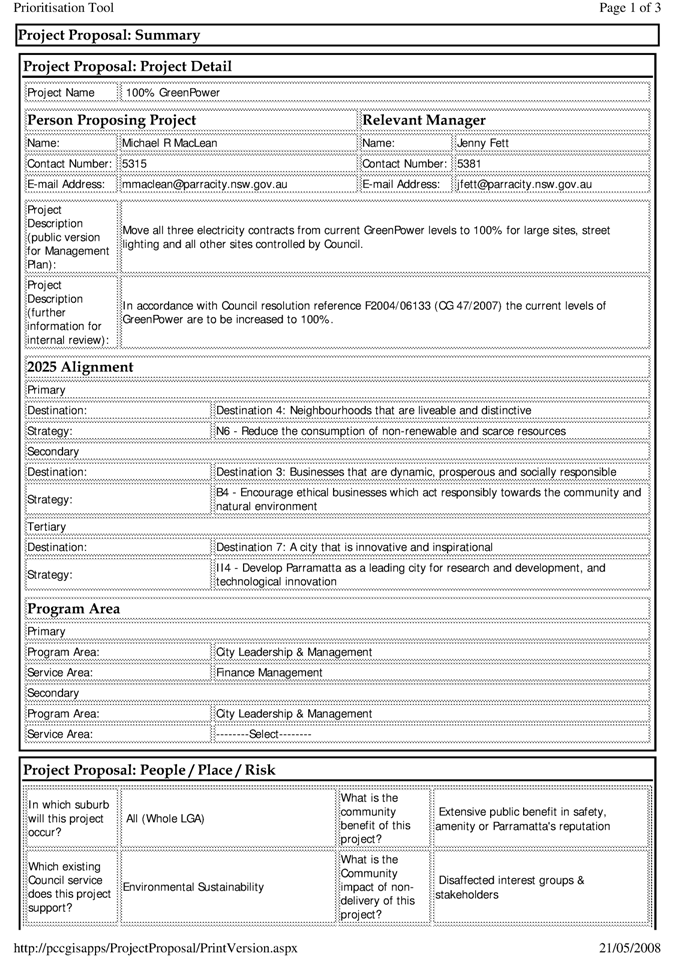
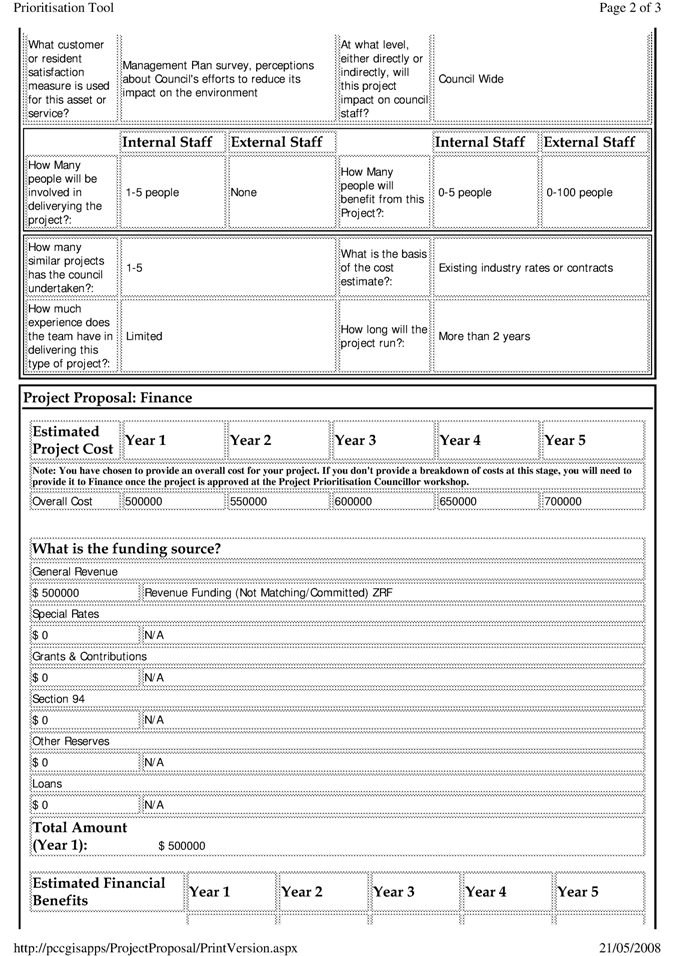
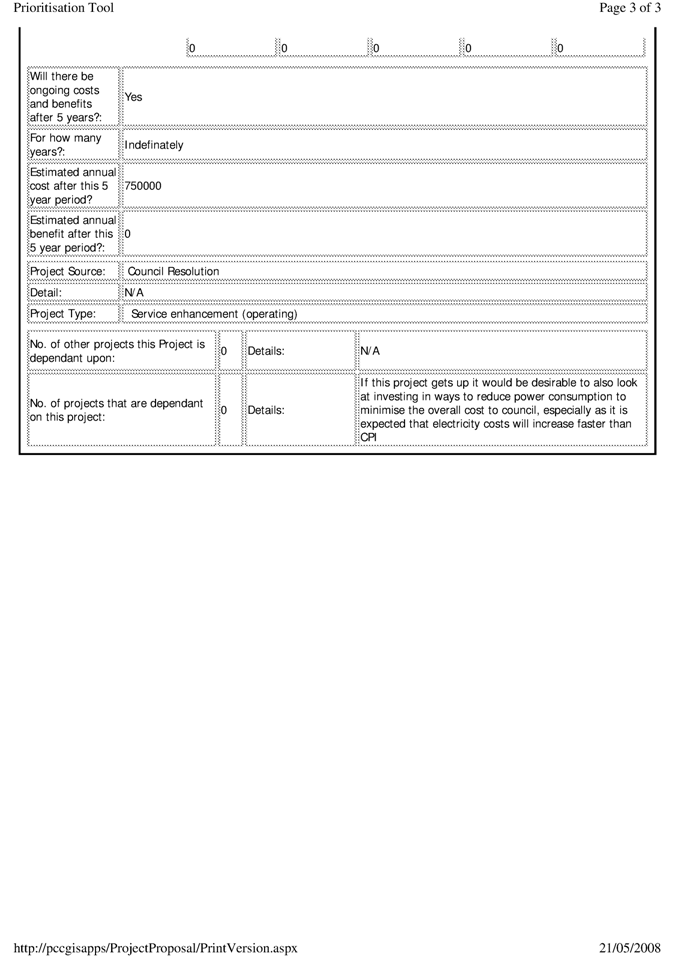
|
Ordinary Council 26 May 2008
|
Item 15.1
|
ITEM NUMBER 15.1
SUBJECT Food
and Beverage Purchased for Staff Functions and Meetings
REFERENCE F2007/02457 - D00923720
REPORT OF Councillor C E Worthington
|
Rationale: With
a very tight budget, I believe that it is time costs associated with the
above services be closely scrutinised in order to ascertain where practices
and processes can be reviewed in order to save money, without necessarily
cutting down on essential services.
|
|
RECOMMENDATION
To be
Moved by Councillor C E Worthington:-
That the Group Manager Corporate
Services bring forward a detailed report to the Ordinary Meeting of Council
to be held on 23rd June 2008, relating to the following matter:-
1 An itemised list of all food and
beverages purchased during the past two (2) years for staff functions and
meetings including all staff functions held away from Council.
2 A breakdown in the cost of each amount
of food and beverage purchased.
|
Attachments:
There are no
attachments for this report.
|
Ordinary Council 26 May 2008
|
Item 15.2
|
ITEM NUMBER 15.2
SUBJECT Outdoor
Machinery and Fleet Vehicles
REFERENCE F2004/09461 - D00923722
REPORT OF Councillor C E Worthington
|
Rationale: With
a very tight budget, I believe that it is time costs associated with the
above services be closely scrutinised in order to ascertain where practices
and processes can be reviewed in order to save money, without necessarily
cutting down on essential services.
|
|
RECOMMENDATION
To be
Moved by Councillor C E Worthington
That the Group Manager Corporate
Services bring forward a detailed report to the Ordinary Meeting of Council
to be held on 23rd June 2008, relating to the following matter:-
1 The number of items of outdoor
machinery and fleet vehicles currently owned by Council.
2 The age of each.
3 The turnover period for both.
4 The annual cost to Council of the
purchase of new machinery and fleet vehicles.
5 The number of vehicles which are
environmentally friendly.
6 Practices which could be introduced in
order to effect substantial savings in this area.
|
Attachments:
There are no
attachments for this report.































































































































































































